This annual report from the Ministry of Personnel, Public Grievances and Pensions, Government of India, details the key initiatives, achievements, and policies of the Department of Personnel and Training, Department of Administrative Reforms and Public Grievances, and Department of Pensions and Pensioners’ Welfare for the fiscal year 2019-20. It covers various aspects of government functioning, including personnel policies, cadre management, training programs, administrative reforms, public grievances redressal, e-governance initiatives, and financial management. The report highlights major activities such as the posting of IAS officers as Assistant Secretaries, the launch of the e-Profile list of IAS officers, the organization of conferences on cybercrime investigation and e-governance, and efforts to promote the progressive use of Hindi in official work. It also details the structure and functions of various divisions within the Ministry and the actions taken to improve public service delivery and governance.
SOURCE PDF LINK :
Click to access AR%202019-20%20English.pdf
Click to view full document content
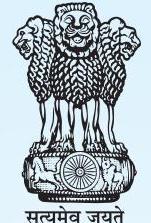
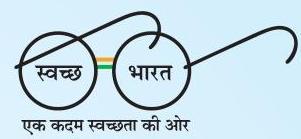
MINISTRY OF PERSONNEL, PUBLIC GRIEVANCES AND PENSIONS
GOVERNMENT OF INDIA
ANNUAL REPORT 2019-20
ANNUAL REPORT 2019-20
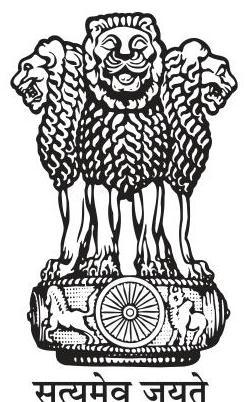
Ministry of Personnel, Public Grievances and Pensions
Government of India
.
CONTENTS
| List of Chapters | Page Nos. | |
|---|---|---|
| Vision and Mission | ||
| Executive Summary | ||
| DEPARTMENT OF PERSONNEL AND TRAINING | ||
| 1 | Overview | 1 |
| 2 | Major Initiatives/Achievements/Events during the year | 7 |
| 3 | Personnel Policies | 19 |
| 4 | Reservation in the Central Government Services | 34 |
| 5 | Cadre Management | 40 |
| a) Indian Administrative Service (IAS) | 40 | |
| b) Central Secretariat Service (CSS) | 45 | |
| c) Central Secretariat Stenographers’ Service (CSSS) | 49 | |
| d) Central Secretariat Clerical Service (CSCS) | 52 | |
| e) State Reorganization | 52 | |
| 6 | Senior Appointments under the Government of India | 56 |
| 7 | Training Policy and Programmes | 61 |
| 8 | Training Institutions | 71 |
| 9 | Administrative Vigilance Division | 91 |
| 10 | International Cooperation | 100 |
| 11 | Central Bureau of Investigation | 103 |
| 12 | Joint Consultative Machinery | 123 |
| 13 | Administrative Tribunals | 126 |
| 14 | Staff Welfare | 131 |
| 15 | Right to Information | 141 |
| 16 | Grievance Redressal Mechanism & Citizens’ Charter | 147 |
| 17 | Progressive Use of Hindi in Official Work | 149 |
| 18 | Financial Management | 154 |
| List of Chapters | Page Nos. | |
|---|---|---|
| 19 | DEPARTMENT OF ADMINISTRATIVE REFORMS AND PUBLIC GRIEVANCES | 159 |
| 20 | Administrative Reforms | 167 |
| 21 | Public Grievances | 172 |
| 22 | Organisation and Methods Division | 180 |
| 23 | e-Governance | 182 |
| 24 | International Exchange & Cooperation (IE&C) | 197 |
| 25 | Documentation and Dissemination Division (D&D) | 204 |
| 26 | Hindi Section | 210 |
| 27 | DEPARTMENT OF PENSIONS AND PENSIONERS’ WELFARE | 211 |
| ANNEXURES | ||
| 28 | Department of Personnel and Training | |
| Annexure-I – Incumbency Position of Group ‘A’ Officers in DoPT and PESB. | 227 | |
| Annexure-II – Disposed Disciplinary Proceedings matters and Sanction for Prosecution Cases | 232 | |
| 29 | Department of Administrative Reforms and Public Grievances | |
| Annexure-III – Organisational Chart of DARPG | 233 | |
| Annexure-IV – Incumbency position of Under Secretary and above level officers in DARPG | 234 | |
| Annexure-V – Prevention of Sexual Harassment of Women at Workplace | 235 | |
| Annexure-VI – Welfare of SC, ST, OBC and Person with Disability(PWD) | 236 | |
| Annexure-VII – The Shillong Declaration adopted during the 22nd Naitonal e-Governance Conference, 2019 | 237 | |
| Annexure-VIII – Mumbai Declaration during the 23rd National e-Governance Conference, 2020 | 240 | |
| 30 | Department of Pensions and Pensioners’ Welfare | |
| Annexure-IX – Organisation Chart | 243 | |
| Annexure-X – Incumbency Position of Officers in D/o PPW | 244 |
Ministry of Personnel, Public Grievances and Pensions Department of Personnel & Training
Vision
To create an enabling environment for the development and management of Human Resources of the Government for efficient, effective, accountable, responsive and transparent and ethical governance.
Mission
Development and management of government personnel by attracting the best talent, providing excellent career advancement opportunities, encouraging competence and innovation, adopting a dynamic framework of personnel policies and procedures, ensuring capacity building at all levels, inculcating and supporting a culture of transparency, accountability and zero tolerance of corruption in public affairs, and institutionalizing a system of continuous and constructive engagement with stakeholders to make the public services in India more efficient, effective, accountable and responsive.
.
EXECUTIVE SUMMARY
The Ministry of Personnel, Public Grievances and Pensions is the nodal Ministry responsible for personnel matters, especially in respect of issues concerning recruitment, training, career development, staff welfare, and the post-retirement dispensation. The Ministry also works towards the promotion of responsive, people-oriented, and modern administration.
The Ministry comprises three Departments:
(i) Department of Personnel and Training (DoP&T)
(ii) Department of Administrative Reforms and Public Grievances (DARPG)
(iii) Department of Pensions and Pensioners’ Welfare (DPPW)
DEPARTMENT OF PERSONNEL AND TRAINING (DOPT)
Various wings of DoP\&T are as under:
- Establishment Officer’s (EO) Wing
- Services \& Vigilance (S\&V) Wing
- Establishment (Estt.) Wing
- Training (Trg.) Wing
- Administration Wing
The Establishment Officer’s Wing deals with the matter relating to senior appointments under the Government of India requiring approval of the ACC.
The Services \& Vigilance Wing handles matters relating to Administration of Rules on all the service matters in respect of All India Services and acts as the nodal agency in the arena of vigilance and anti-corruption. This wing in addition to governing the implementation of the RTI Act also handles the administrative matters relating to the Administrative Tribunals and Central Information Commission. This wing also handles the work related to Cadre Restructuring in respect of the other Central Services.
The Establishment Wing is responsible for framing and revising rules and regulations regarding service conditions of the employees and personnel policies of the Central Government employees other than All India Service Officers. This wing handles the work related to Reservation Policy of the Government, Joint Consultative Machinery (JCM) and Civil Services Officers’ Institute (CSOI). This wing also looks after the work related to the allocation of State cadre employees consequent upon the reorganization of the States and Redeployment and Retraining of surplus Staff of various Central Government Organisations.
The Training Wing acts as the nodal agency for training of Government functionaries and is primarily responsible for formulating policies regarding training.
Administration Wing deals with the matters related to Cadre Management of the Central Secretariat Service, Central Secretariat Stenographers’ Service and the Central Secretariat Clerical Service. This wing also handles the administrative matters relating to the State Reorganization, Reservation Policy of the Government, and Welfare Activities for benefit of the employees of the Government except for CSOI.
The Department of Personnel and Training also handles the administrative work relating to the following Institutions: –
- Union Public Service Commission
- Central Vigilance Commission
- Lokpal
- Central Administrative Tribunals
- Central Information Commission
- Central Bureau of Investigation
- Staff Selection Commission
- Public Enterprises Selection Board
- Lal Bahadur Shastri National Academy of Administration
- Institute of Secretariat Training and Management
DEPARTMENT OF ADMINISTRATIVE REFORMS & PUBLIC GRIEVANCES
The Department of Administrative Reforms and Public Grievances is the nodal agency of the Government of India for administrative reforms as well as redressal of public grievances relating to the States in general and those pertaining to the Central Government agencies in particular. The Department endeavours to document and disseminate successful governance practices by way of audio-visual media and publications. The Department also undertakes activities in the field of international exchange and cooperation to promote public service reforms. There are 7 Divisions in the Department namely Administrative Reforms, Organization \& Methods, e-Governance, Documentation \& Dissemination, International Cooperation, Administration \& Coordination and Public Grievances.
DEPARTMENT OF PENSIONS AND PENSIONERS’ WELFARE
The Department of Pension \& Pensioners’Welfare was set up in 1985 as part of the Ministry of Personnel, Public Grievances and Pensions to formulate policy and coordination of matters relating to retirement benefits of Central Government employees (except Defence, Railway and Post \& Telecommunication).
OVERVIEW
1.0 The Ministry of Personnel, Public Grievances and Pensions acts as the formulator of policies pertaining to recruitment, regulation of service conditions, and deputation of personnel besides advising all organizations of the Central Government on issues pertaining to personnel management. The Organizational chart of the Department is on the next page.
Major Initiatives / Achievements / Events during the year (Chapter 2)
1.1 Major Initiatives/Achievements during the period of January 2019 – March 2020 have been brought out in Chapter 2.
Personnel Policies (Chapter 3)
1.2 The Department is responsible for framing rules and regulations governing service conditions including recruitment rules, promotions and seniority, Flexible Complementing Scheme, Leave Travel Concession, deputation and Child Care Leave of employees. Personnel are recruited for the Central Government by the Union Public Service Commission through competitive examinations conducted by them for appointments to higher civil services and through the Staff Selection Commission of non-gazetted staff in Group ‘B’ & ‘C’ categories.
Reservation (Chapter 4)
1.3 In order to achieve the objective of upliftment and welfare of the Scheduled Castes
and Scheduled Tribes, Other Backward Classes and Persons with Disabilities; the Department frames policies to provide reservation to these groups in various Central Government services and for monitoring its implementation.
Cadre Management (Chapter 5)
1.4 This Department is responsible for the management of the cadres of All India Services (AIS) (IAS, IPS, and IFS) and all three Secretariat Services namely Central Secretariat Services (CSS), Central Secretariat Stenographers’ Services (CSSS) and Central Secretariat Clerical Services (CSCS). In addition, this Department frames and also revises Rules and Regulations regarding conditions of the All India Services, such as Indian Police Service (IPS) and Indian Forest Service (IFS), in consultation with the Ministry of Home Affairs and Ministry of Environment, Forest and Climate Change respectively. This Department is also responsible for the cadre review of 62 Central Group ‘A’ Services periodically.
Senior Appointments under the Government of India (Chapter 6)
1.5 The Department deals with appointments at senior level and personnel policies of the Government of India. All proposals for senior appointments under the Government of India, which require the approval of the Appointments Committee of the Cabinet (ACC), are processed by the Department. These include boardlevel appointments to Central Public Sector
Undertakings and appointments under the Central Staffing Scheme for posts of Joint Secretary, Director, and Deputy Secretary in Ministries /
Departments. In addition, all appointments by promotion, which require the approval of the ACC, are also processed by the Department.
Organisation Chart for Department of Personnel & Training
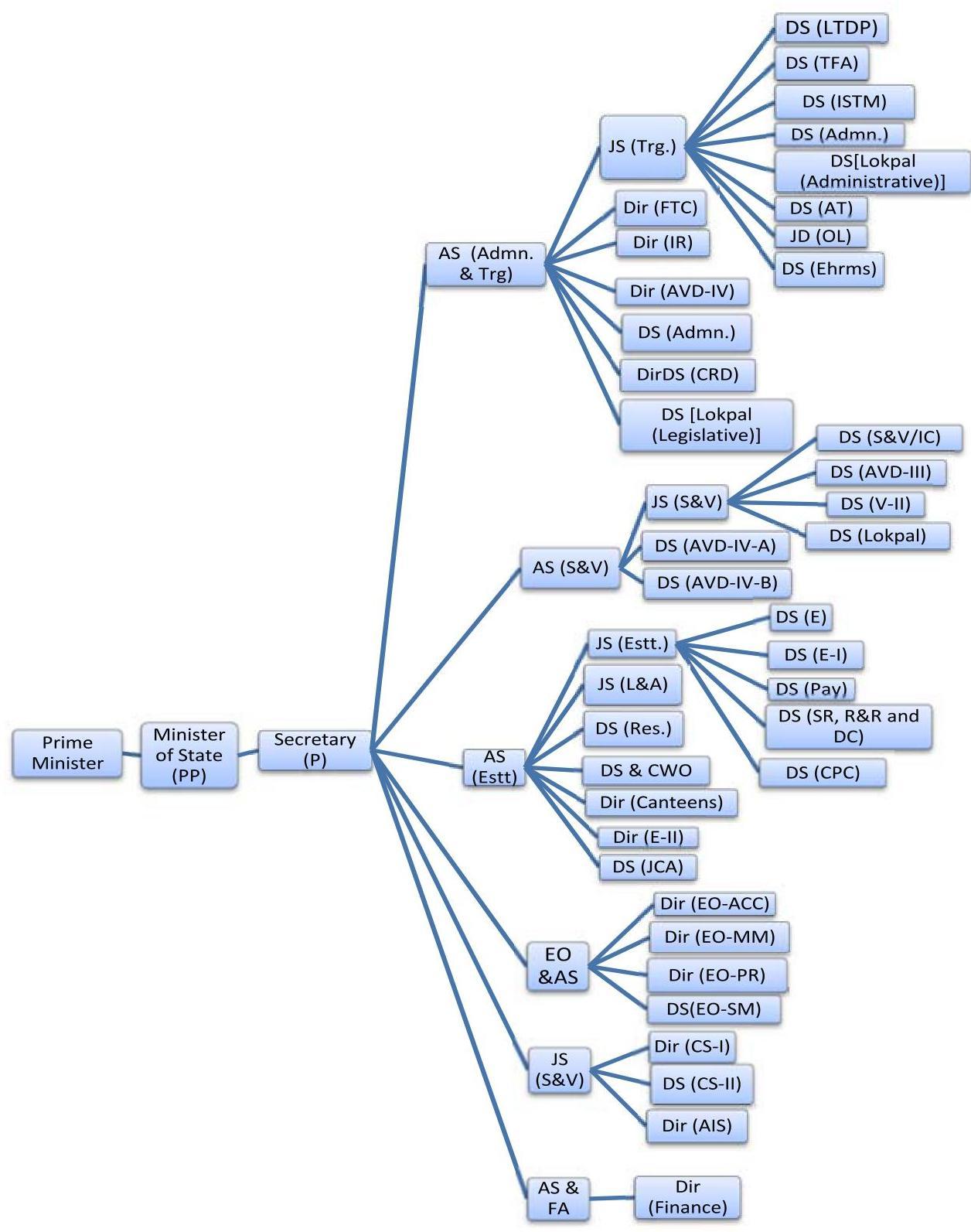
| Abbreviations Used in the Organization Chart | |
|---|---|
| ACC | Appointments Committee of Cabinet |
| AVD | Administrative Vigilance Division |
| ADMIN | Administration |
| AIS | All India Services |
| AS | Additional Secretary |
| B&C | Budget \& Coordination |
| CS | Central Secretariat |
| CPC | Central Pay Commission |
| CRD | Cadre Review Division |
| CWO | Chief Welfare Officer |
| DFFT | Domestic Funding of Foreign Training |
| DS | Deputy Secretary |
| DIR | Director |
| E | Establishment |
| EO | Establishment Officer |
| IR | Information Rights |
| JS | Joint Secretary |
| JCA | Joint Consultative Machinery and Arbitration |
| LTTP | Long Term Training Programme |
| L\&A | Leave Allowances |
| MOS | Minister of State |
| MM | Middle Management |
| PR | Personal Records |
| PIIA | Pathways for an Inclusive India Administration |
| PESB | Public Enterprises Selection Board |
| PP | Personnel \& Pension |
| RES | Reservation |
| RR\&DC | Redeployments \& Retraining \& Departmental Council |
| S\&V | Services \& Vigilance |
| S | Services |
| SM | Senior Management |
| SR | State Reorganization |
| TRG | Training |
| V | Vigilance |
Training Policy and Programmes (Chapter 7)
1.6 The Department is the nodal Department to impart training to the government functionaries. The Training Wing of the Department formulates policies and implements its training programmes by identifying areas of training, designing training programmes, development of trainers and training capabilities and administering policies in training. Major training activities undertaken during the year are (i) In-service training of AIS/CSS/CSSS officers (ii) Mid-Career training of IAS Officers (iii) Domestic Funding of Foreign Training (iv) Post Graduate Programmes in Public Policy/ Sustainable Development/Management (v) Training Support under State Category Training Programme (SCTP); Trainer Development Programme (TDP); Intensive Training Programme; Induction Training Programme; Comprehensive Online Modified Modules for Induction Training (COMMIT); Augmentation of the Capacity of Training Institutions (ACTI); Integrated Government Online Training Programme (i-GOT), (vi) Capacity Building for poverty reduction and (vii) e-Governance initiatives.
Training Institutions (Chapter 8)
1.7 Lal Bahadur Shastri National Academy of Administration (LBSNAA), Mussourie, Uttarakhand and Institute of Secretariat Training and Management (ISTM), Delhi are two premier training institutions, attached to this Department. These institutes cater to the needs of human resource development by imparting training to all officers of Central Government at frequent intervals for their career progression. The Department also supports the Indian Institute of Public Administration (IIPA) which is an autonomous organisation, in undertaking advance training programmes for
administrators as well as researchers on issues relating to public administration.
Administrative Vigilance Division (Chapter 9)
1.8 The Department is the nodal agency responsible for the formulation and implementation of vigilance and anti-corruption policies of the Government. Administrative Vigilance Wing in the Department oversees government programme for maintenance of discipline and eradication of corruption from public service. The Central Vigilance Commission (CVC) advises the Central Government on all vigilance matters. The jurisdiction of the Commission extends to all the organisations to which the executive powers of the Union of India extend.
International Cooperation (Chapter 10)
1.9 The Department of Personnel and Training is the nodal Department for anti-corruption. To deal with international cooperation on these aspects an International Cooperation Cell was created in this Department. The primary tasks of this Cell emanate from the follow up to the ratification of the United Nations Convention Against Corruption (UNCAC) and the other consequential international collaborative efforts, on global platforms. This Cell acts in conjunction with specialized agencies like the Central Bureau of Investigation, the Enforcement Directorate and the other line Ministries entrusted with the specific ancillary tasks within their respective administrative domain, viz. corporate governance, extradition matters, prevention of money laundering, mutual legal assistance treaties etc.
Central Bureau of Investigation (Chapter 11)
1.10 Central Bureau of Investigation (CBI) was set up by the Government of India by a Resolution
dated April 1, 1963, to not only investigate cases of bribery and corruption but also a violation of central fiscal laws, major frauds relating to Government of India Departments, Public Joint Stock Companies, passport frauds and serious crimes committed by organized gangs and professional criminals. CBI was further strengthened by the addition of Economic Offences Wing by the Government of India by Resolution dated February 2, 1964.
Joint Consultative Machinery (Chapter 12)
1.11 The Government provides for a Joint Consultative Machinery for joint consultation at three levels between the Central Government and its employees for promoting harmonious relations and securing the optimum level of cooperation between the Central Government and its employees in matters of common concern. The objective is to increase the efficiency of public services along with the well-being of the employees. The three tiers are:
a) National Council – at the apex level, functioning under the Department of Personnel and Training.
b) Department Councils – functioning at the level of the Ministries / Departments.
c) Office Councils – functioning at offices/ organisations under various Ministries / Departments.
1.12 The Scheme has proved to be an effective forum for amicable settlement of grievances of the Central Government employees relating to their service matters etc.
Administrative Tribunal (Chapter 13)
1.13 In order to provide speedy and inexpensive
justice delivery system to the employees who feel aggrieved by Government decisions, the Government set up the Central Administrative Tribunal (CAT) in 1985, which now deals with all cases relating to service matters. The CAT has 17 regular benches, 15 of which operate at the Principal seats of High Courts and the remaining two are at Jaipur and Lucknow.
Staff Welfare (Chapter 14)
1.14 The Central Government being the largest single employer in the country discharges its responsibility for looking after the welfare of employees through various welfare measures. The Department also extends support to various staff welfare measures. The DoPT is the nodal Department for four registered societies set up for the welfare of the Government employees and their families. In addition, the Department lays down policies for Departmental Canteens and supports the Resident Welfare Associations.
Right to Information (Chapter 15)
1.15 The Department has brought out a comprehensive law to ensure the right to information to the citizens of India in almost entire matters of governance at all levels from the Central Government to the local self-government. The Law (RTI Act, 2005) has provided a mechanism where the Central Information Commission, being the apex body at the Centre, facilitates its citizenry in accessing information in a time-bound, hasslefree and affordable manner.
Grievance Redressal Mechanism & Citizens’ Charter (Chapter 16)
1.16 The Department has identified some of the core services being offered by its various
divisions and their standards for the purpose in its first charter. This has been undertaken by a Task Force in consultation with the Stakeholders. While identifying the services the focus has been on measurable and verifiable services and their standards. The charter contains a Grievance Redress Mechanism related to the services mentioned in the Citizens’/Clients’ Charter. The Charter also provides links for other grievances which are not related to the Citizens’/Clients’ Charter. Timelines have been prescribed for final disposal of the complaint arising out of the Citizens’/Client’s Charter.
Progressive Use of Hindi (Chapter 17)
1.17 The Department is fully committed to promoting the use of Hindi as the official language, in official matters and motivate compliance of the provisions of the Official Language Act, 1963, the rules framed thereunder. The Department also ensures that the spirit of various orders and guidelines issued by the Department of
Official Language is appropriately enforced for implementation of the official language policy of the Union. The Department has an Official Language Division which monitors the implementation of the policy in the Department.
Financial Management (Chapter 18)
1.18 In order to promote the various programmes administered by the Ministry of Personnel, Public Grievances and Pensions, an allocation of ₹ 154.33 crore was made in the Central Sector Scheme Outlay for the year 2018-19 against the total allocation of ₹ 1547.00 crore at the Revised Estimate 2018-19 stage. The corresponding figures for 2019-20 are ₹ 194.27 crore as Central Sector Scheme Outlay against the total allocation of ₹ 1726.59 crore. The requirements and priorities of its attached and subordinate offices were kept in view while making a budgetary allocation to them by this Department. No PAC/ C&AG Para are pending in the Ministry.-
CHAPTER
MAJOR INITIATIVES/ACHIEVEMENTS/ EVENTS DURING THE YEAR
Posting of IAS Officers as Assistant Secretaries in Govt. of India:-
2.1 On completion of Phase-II training at Lal Bahadur Shastri National Academy of Administration, Mussoorie, this Department issued orders for posting of 169 IAS officers of 2017 Batch as Assistant Secretary in the Ministries/ Departments of Government of India for 3 months from 01.07.2019 to 01.10.2019 on Central Deputation. Exposure of Central Govt. functioning will provide insight into policy formulation at the Centre to these officers. During their field posting, the officers will benefit by having a macro picture of such policies which will help them in effective implementation of the schemes keeping citizens at the centre.
2.2 Inaugural Session of the Assistant Secretaries (IAS-2017 batch) held under the Chairmanship of Hon’ble Prime Minister at Parliament Annexe on $02^{\text {nd }}$ July 2019, in which the Assistant Secretaries got an opportunity to interact with Hon’ble Prime Minister.
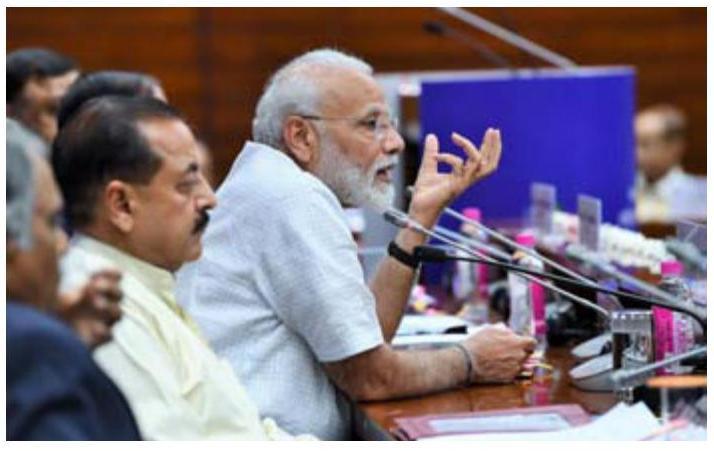
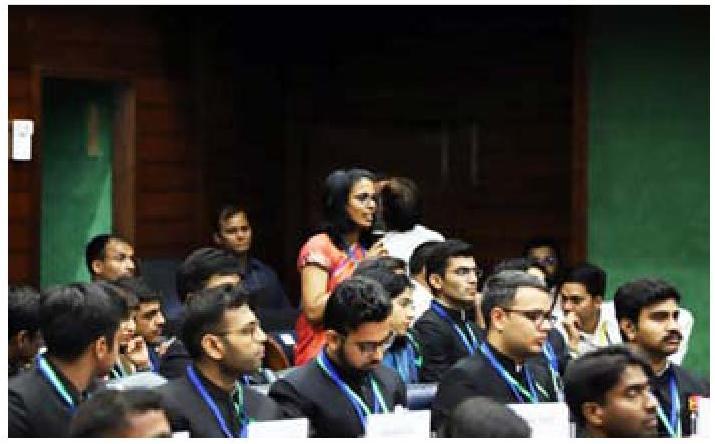
2.3 The Assistant Secretaries also got an opportunity to have an interactive session with Hon’ble President and Hon’ble Vice President.
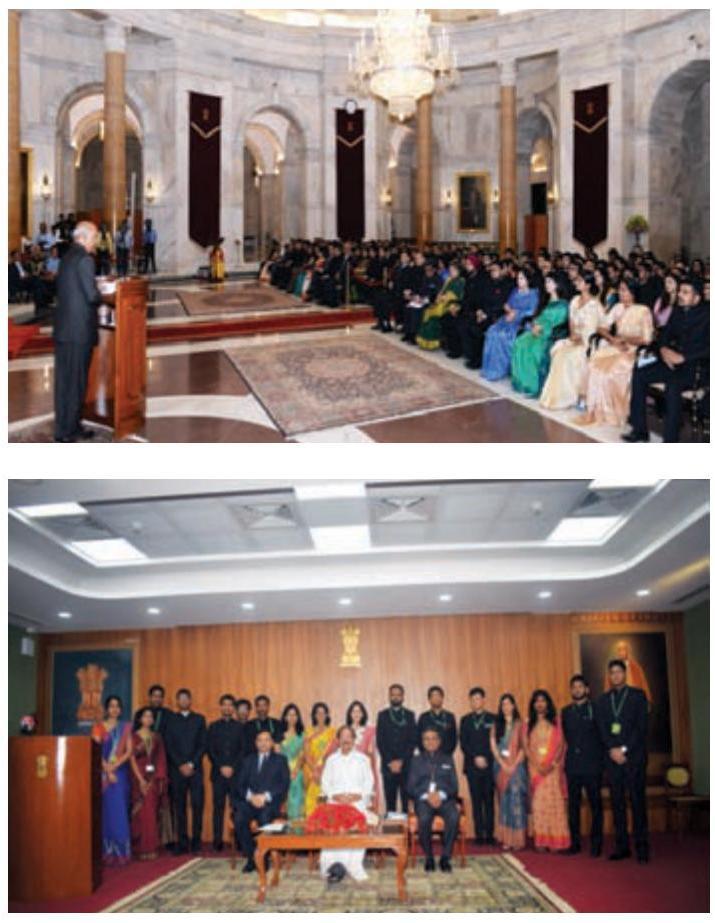
2.4 The IAS officers of 2017 Batch also benefitted from the interactive sessions organized by DoPT, in which a large number of dignitaries/ Heads of Departments/ Heads of Organizations/ Senior Officers participated.
2.5 Hon’ble Prime Minister addressed the Valedictory Session of the Assistant Secretaries (IAS-2017 batch) at DRDO Auditorium, New Delhi on $1^{\text {st }}$ October 2019. During the Valedictory session, eight (8) Assistant Secretaries made presentations before Hon’ble PM.
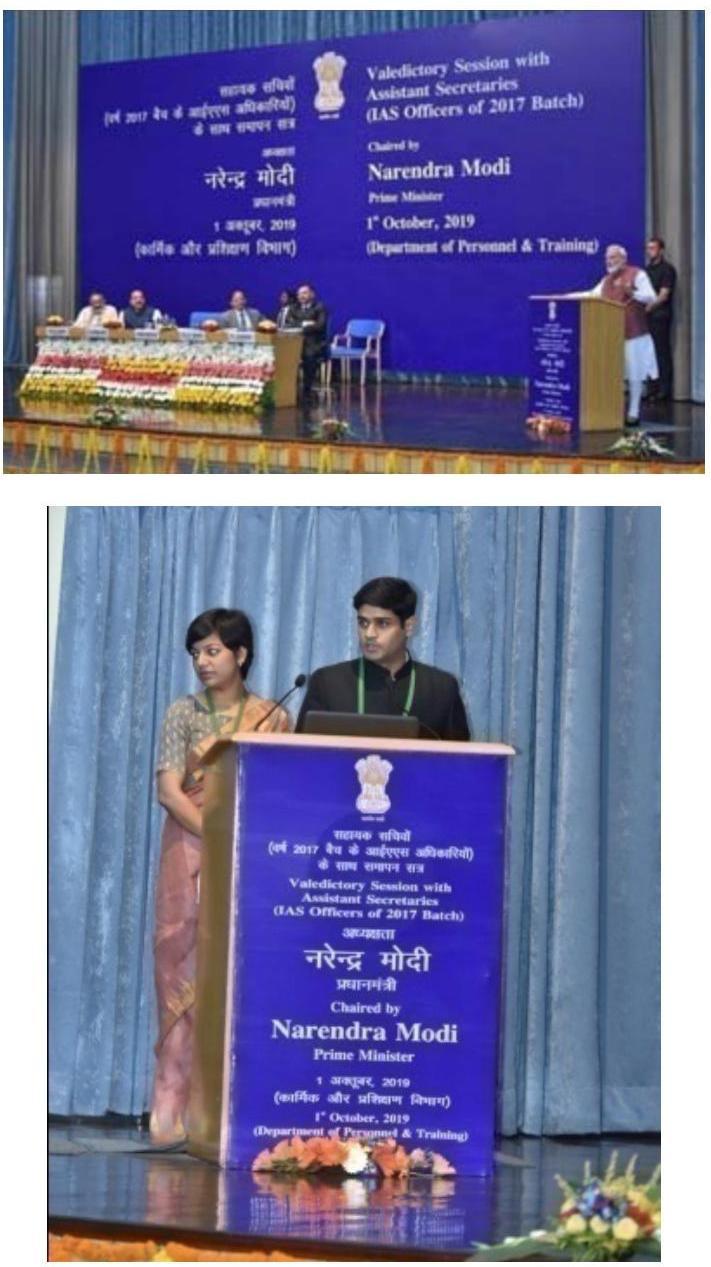
iGOT (Integrated Government Online Training Programme)
2.6 The vision of the Department of Personnel and Training includes revamping capacity building framework, make capacity building a lifelong learning process through digital delivery of training. The vision also includes fostering feeling of pride and mutual loyalty among all Civil Services through capacity building measures. In this connection, Department of Personnel and Training has launched a new Integrated Government Online Training Programme (i-GOT) to augment the existing training mechanism with online modulebased training coupled with certification. This will make training inputs available to Government officials on site and on flexi-time basis. During 2019-20, the following six online courses have been made available under the MITx Micro Masters Programme, through Abdul Latif Jameel Poverty Action Lab (J-PAL), South Asia with the approval of the competent authority in DoPT: (i) The Challenges of Global Poverty, (ii) Designing and Running Randomized Evaluations, (iii) Data Analysis for Social Scientists, (iv) Microeconomics, (v) Foundations of Development Policy, (vi) Political Economy and Economic Development. Three batches have already completed various courses. In addition, Online Certificate Course on ‘Relevance of Gandhi in the Contemporary World’ under iGOT was also launched on 30.01.2020 by DoPT in collaboration with IGNOU and Gandhi Smriti and Darshan Samiti, Rajghat.
It is proposed to add more and more courses on iGOT platform to make it more useful. In this regard, various Workshops and brain storming sessions have been held with the stake holders. It is proposed to further strengthen the iGOT Programme. The iGOT 2.0 will be rolled out in
2020-21 which specifically aims a need-based capacity building of Civil Servants and aims to create a shared learning architecture that will facilitate government training institutions to cross leverage courses, other learning resources and competency testing analysis. The iGOT 2.0 will be an evolving and scalable platform. The iGOT 2.0 comprises of 3 layers which come together to give the users and departments a seamless learning ecosystem.
2.7 A conference on Capacity Building Reforms and Integrated Government Online Training (iGOT) was also organized by the Department of Personnel & Training with Cadre Controlling Authorities (CCAs) and Central Training Institutes (CTIs) on $04^{\text {th }}$ February 2020 at Vigyan Bhawan, New Delhi. On this occasion, a Consultation Paper on ‘Approach to Strategy and Implementation of iGOT 2.0 ‘ was also released by Dr P. K. Mishra, Principal Secretary to Hon’ble Prime Minister.
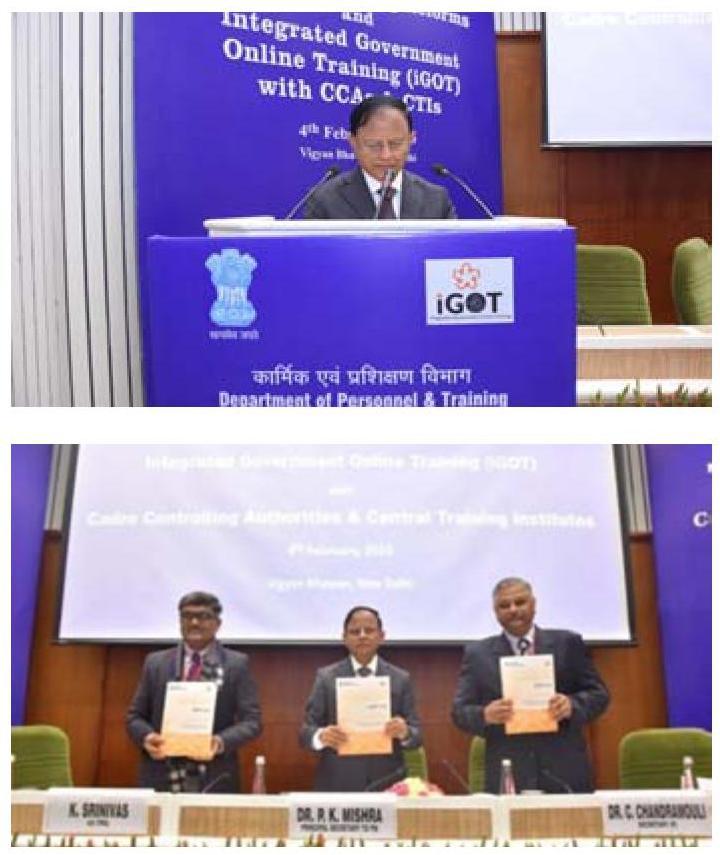
Common Foundation Course 2019
2.8 ‘AARAMBH’ 2019, the common foundation course for civil service probationers has been organized at the Statue of Unity at Kevadia, with 425 officer trainees. This was the first-ever of its kind common Foundation Course for civil service probationers. The theme was ‘How to achieve the goal of making India a 5 Trillion Dollar
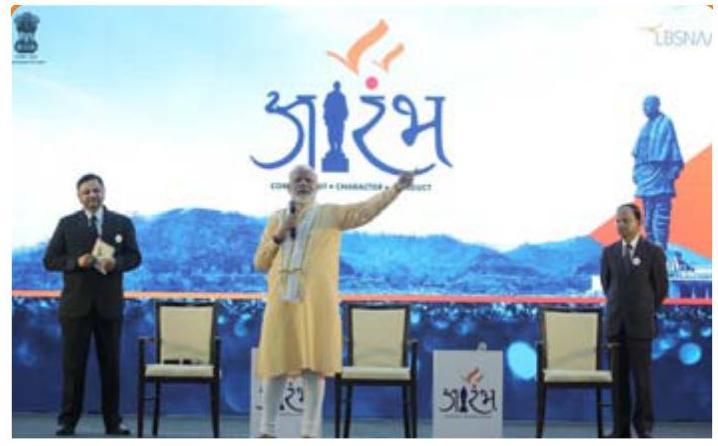
Economy’. The programme was inaugurated by World Bank president David Malpass on $28^{\text {th }}$ October 2019. He addressed the trainees at the event on the topic of ‘Capacity Building for Civil Servants’. ‘AARAMBH’ was concluded on October $31^{\text {st }} 2019$, being a fit tribute to the Iron Man of India on his birth anniversary, fondly celebrated as ‘Rashtriya Ekta Divas’. Prime Minister Narendra Modi addressed the probationers during the closing session on $31^{\text {st }}$ October. This program held in the lap of nature, under the stalwart statesman Sardar Patel’s statue is even more symbolic with the Civil Service Probationers imbibing the principles that Sardar Patel laid out for civil servants.
Electronic-Human Resource Management System (e-HRMS)
2.9 e-HRMS is the HR Management Project of Government of India developed and administered
by DoPT, aiming at end-to-end computerization of HR management in Government. e-HRMS contains applications related to service matters such as Leave, Service Records, LTC, etc. It has been developed as a unique initiative providing workflow-based solutions, harnessing the capabilities of ICT to improve the way HR processes are carried out. In the first phase, 30 Ministries were on-boarded and their employees have started using 6 Modules of the application for HR purposes. In the Second Phase of e-HRMS roll-out, 32,000 Employees in remaining administrative Ministries/Departments are being covered. In the long-term, it is planned to cater to all the employees of the Government of India across various offices throughout the country. The e-HRMS Project was nominated and short-listed for the National e-Governance Awards 2019-20.
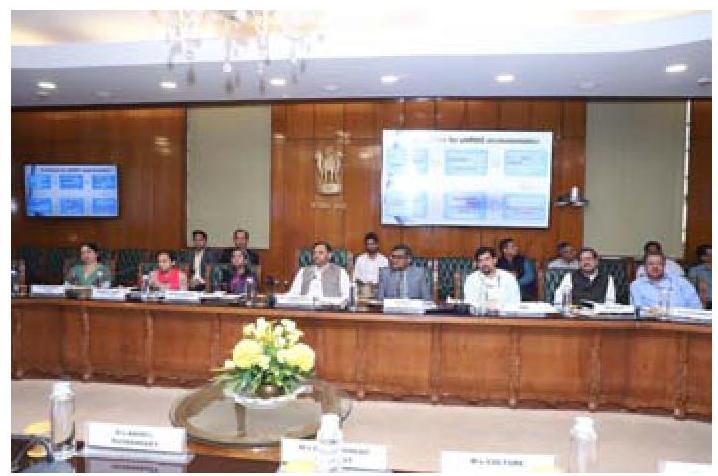
RTI Amendment Act, 2019
2.10 The RTI Act, 2005 was amended to provide enabling provisions of administrative nature for making rules regarding tenure and service conditions of the CIC, ICs and State CIC and State ICs. Consequently, the rules relating thereto were also notified on 24.10.2019 in the official gazette.
Infusing fresh talent at Policy-Making Levels
2.11 Appointments Committee of Cabinet recommended 08 officers for appointment on lateral entry basis, on $30^{\text {th }}$ August 2019. They have been appointed at Joint Secretary level in different Ministries. Lateral entry at DS / Director level is also at an advanced stage.
Launching of the e-Profile list of IAS officers
2.12 For the convenience of various stakeholders, the “e-Profile List” of IAS Officers was launched by Dr Jitendra Singh, Hon’ble MoS (PP) on 29.07.2019.
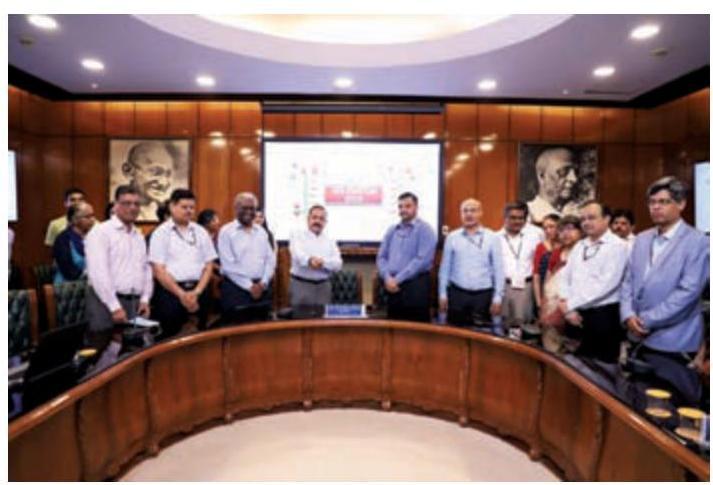
$1^{\text {st }}$ National Conference on Cybercrime Investigation and Forensics
2.13 1st National Conference on Cybercrime Investigation and Forensics organized by Central Bureau of Investigation on $4^{\text {th }}-5^{\text {th }}$ September 2019. Around 50 officers including DGPs, ADGPs, IPGs, DIGPs and SPs dealing with cybercrime in State & UT Police, Central Agencies, the Ministry of Home Affairs, Ministry of Electronics and Information Technology, other Ministries, experts from Law Enforcement
Agencies (LEAs) and academia participated in the Conference.
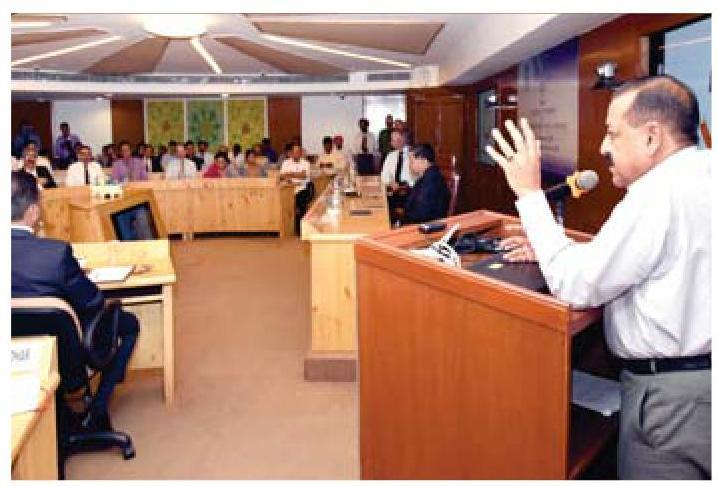
Annual Conference of Chief Secretaries / Principal Secretaries (Personnel/ GAD) of the State Governments / UT Governments:
2.14 Annual Conference of Chief Secretaries / Principal Secretaries (Personnel/GAD) of the State Governments / UT Governments was organized under the chairmanship of Dr Jitendra Singh, Hon’ble MoS (PP) on 18.09.2019 at Vigyan Bhawan, New Delhi. Senior officers of DoPT, DARPG and other Central Ministries / Departments were also present during the Conference.
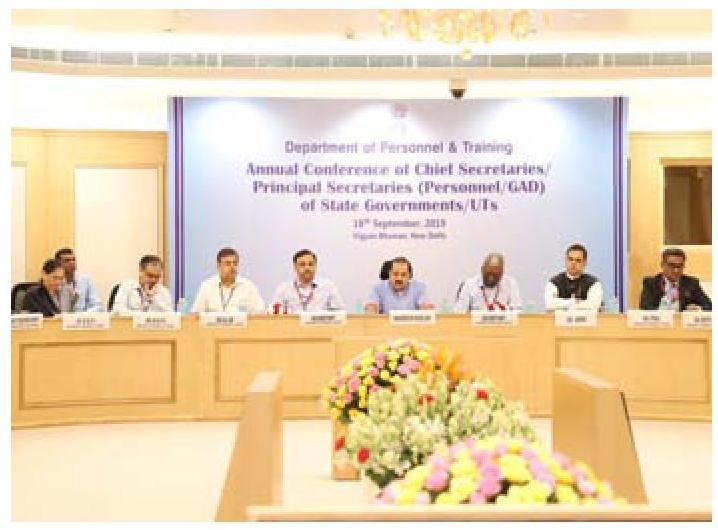
Smart Performance Appraisal Report Recording Window (SPARROW)
2.15 SPARROW is an online system based on the comprehensive performance appraisal dossier maintained for IAS officers. The system aims at bringing greater transparency in the recording of performance appraisals of the officers, eliminating loss of Performance Appraisal Reports (PARs) during the transition, ensuring better monitoring and timely completion of PARs, and providing easy and real-time access to the PARs by authorized stakeholders. This system is not only user friendly but can be accessed uninterruptedly through internet-enabled computer system from anywhere, anytime, which reduces the delays in the processing of PARs by officers concerned. The system was launched with effect from 01.04.2014 and was initially linked to the intra-IAS database enabling the PAR form to be pre-populated with the existing information. Subsequently, the responsibility to update the requisite details in respect of officers was passed on to the Employee Master Data (EMD) manager of the respective Ministry or Department / State Cadre. To make the system hassle-free and more user-friendly, the system has been enabled with eSign (electronic signature), an Aadhaar based authentication service.
The SPARROW system generates auto-alerts in respect of the officers whose PARs are yet to be recorded. The total number of electronically generated PARs of the IAS officers for the Assessment Year 2018-19 is 9187.
Immovable Property Returns (IPR) Module
2.16 As per Rule 16(2) of AIS (Conduct) Rules, 1968, IAS officers are required to submit IPRs
every year as on $1^{\text {st }}$ January and latest by $31^{\text {st }}$ January of the year, in respect of the preceding year. Since the year 2011, the IPRs of the officers are being uploaded on the Department’s website. Subsequently, an IPR Module has been introduced for filing the IPRs online by the officer’s w.e.f. 1.1.2017, the navigation tab of which has been provided in the menu on Home Page of SPARROW. The officers can access the Module by using the login ID and password, which are already provided to them for accessing the SPARROW and after filing the return; they are required to authenticate it by using either DSC or eSign.
Promotion in various grades after implementation of $3^{\text {rd }}$ Cadre Review exercise for CSSS
2.17 Promotion orders in various grades of CSSS viz (i) 129 Private Secretary to Principal Private Secretary (PPS) (ii) 274 Principal Private Secretary to Sr. Principal Private Secretary (Sr. PPS) and (iii) 1 Sr. Principal Private Secretary to Principal Staff Officer (PSO) were issued during the year.
PUBLIC GRIEVANCES
2.18 During the period from 2019-2020, seven intensive review meetings have been held for reviewing the status of pending public grievances in Ministries/Departments/organisations and expediting action on them. An Award Scheme for recognizing outstanding performance on CPGRAMS through the issue of Certificate of Appreciation is in place. The scheme started in the year 2015 and so far 30 Certificates of appreciations have been awarded to various Ministries/Departments/ Organizations during the period.
Good Governance Index
2.19 Department of Administrative Reform and Public Grievances (DARPG), GOI has developed the Good Governance Index (GGI) recommended by the Group of Secretaries (GoS) on Governance, after consultation with various stakeholders. The Good Governance Index (GGI) would not only present a comparative picture but also yield valuable state-wise insights about their strong and weak areas of service delivery, which would help them in generating performance improvement mechanism. Hon’ble MOS(PP) has launched the Good Governance Index on Good Governance Day i.e. $25^{\text {th }}$ December 2019.
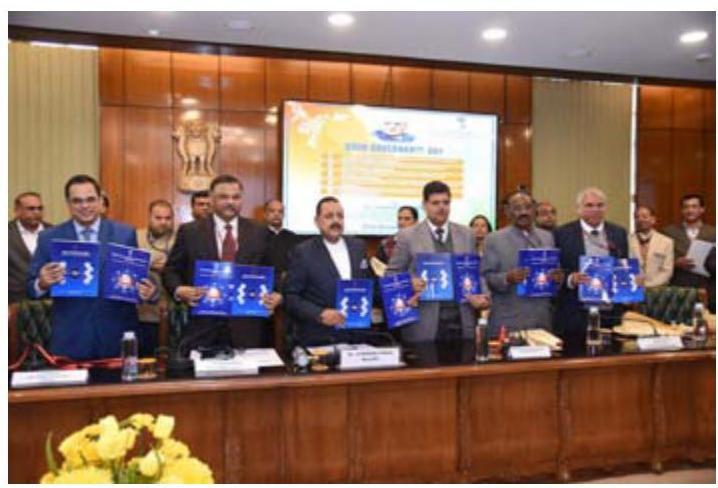
Centralised Pension Grievance Registration and Monitoring System (CPENGRAMS):
2.20 Pensioners’ grievance redressal system has been expanded with the objective to provide easy access to pensioners in registering their grievances even on a phone call. An Integrated Grievance Cell & Call Centre was inaugurated on $20^{\text {th }}$ June 2019 for pensioners facilitating pensioners to register their grievance by calling on toll-free number 1800-11-1960. This centre also coordinates with different Ministries/Departments to resolve the problems of the elderly pensioners
and keep the pensioners inform about the progress of their grievances.
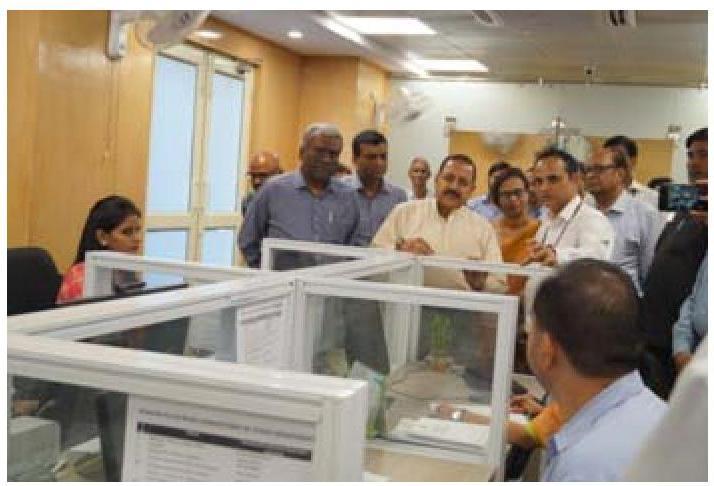
All India Pension Adalat – 2019
2.21 This Department had started the unique experiment of holding Pension by inviting all the stake-holders of a particular grievance on a single table viz. the concerned Department, the PAO, the concerned Bank and representative of the Pensioner and resolves the case across the table. Accordingly, the first Pension Adalat of the Department was held on September 20, 2017.
2.22 Accordingly, on August $23^{\text {rd }} 2019$ another All India Pension Adalat was organized by various Ministries and Departments all over the country. Hon’ble MoS (PP) Dr Jitendra Singh interacted with the nodal officers and pensioners present at these Pension Adalats through live video conferencing. More than 50 centres were connected through live video conferencing with the event being organized in Delhi. 4000 pending grievances relating to Central Govt. Ministries/ Departments/Organisations have been resolved in one single day. In continuation to hold pension Adalat as a nodal ministry, Department of Pension & Pensioners’ Welfare also organised $4^{\text {th }}$ pension Adalat in series and took up 42 grievances for
consideration Out of these, 29 cases were settled on-the-spot in the Adalat.
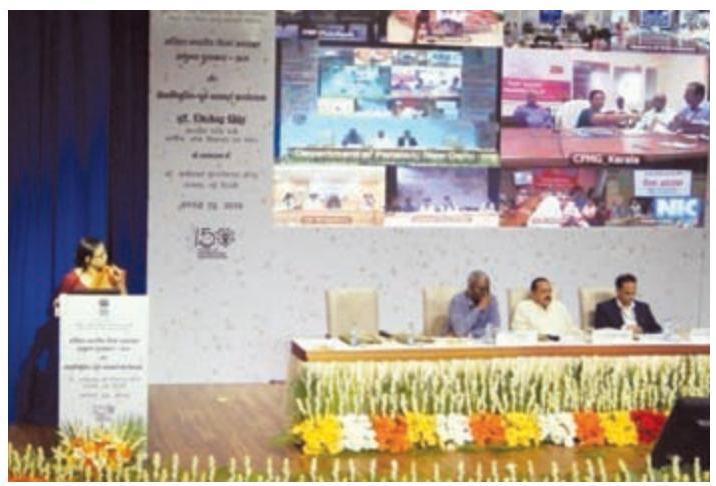
Know Your Retirement Benefit:
2.23 An informative booklet “Know Your Retirement Benefit” was published for employees so that they get information about their various retirement benefits including medical facility under CGHS and further take steps to sanction all their dues. All orders issued in 2019 -2020 are complied through compendium so that officials dealing with pension matters and Pensioners’ Associations may use it as ready reckoner.
ANUBHAV
2.24 On the directions of the Hon’ble Prime Minister of India, Department of Pension \& Pensioners’ Welfare had launched an online platform entitled ‘ANUBHAV’ for sharing experiences of retiring government employees while working with the Government to create a wealth of institutional memory with replicable ideas and suggestions.
2.25 During the Fourth Anubhav Award Ceremony, seven Awards were given by the Hon’ble Minister of State (PP) on August 23, 2019, to selected write-ups published from April 1, 2018,
to March 31, 2019, on Anubhav Portal.
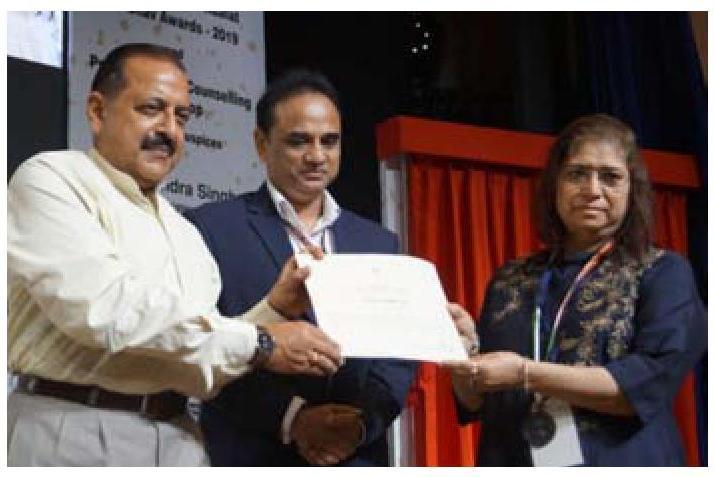
JEEVAN PRAMAAN:
2.26 Every year in November a pensioner is required to produce a life certificate for further continuation of his pension. Pensioners can submit life certificate by physically presenting themselves before pension disbursing authority i.e banks or can send a certificate issued by a gazetted officer or the other designated authorities. In November 2014 an Aadhar based scheme for online submission of digital life certificate Jeevan Pramaan was launched by the Hon’ble Prime Minister with the objective to
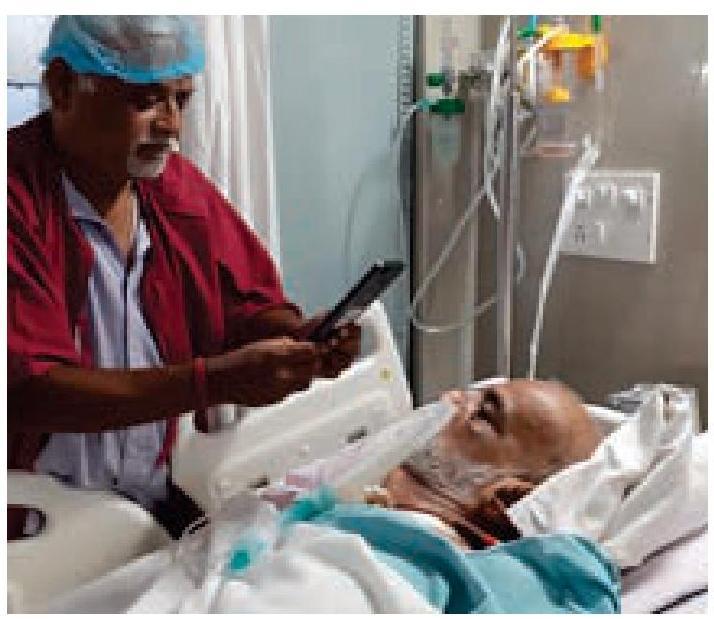
ensure transparency in the system and facilitate pensioners to submit life certificate at their comfort. Given infirmity or other ailing elements due to old age, D/o P&PW has been promoting Digital Life Certificate i.e. Jeevan Pramaan among Central Government Retirees. A documentary explaining the process of submitting DLC was made and awareness campaign through print \& electronic media was taken up to reach pensioners scattered across the country. A Pilot Programme DLC from the home campaign was started in 2018 by associating Pensioners’ group to reach out to aged (above 80 years) and infirm pensioners who are unable to visit bank branches. Around 2500 DLCs were successfully created by Pensioners’ Associations in 7 cities. In October-November 2019, this project was expanded to cover 24 cities i.e. Hyderabad, Ranchi, Bhuvneshwar, Jaipur, Thrissur, Kolkata, Cuttack, Chennai, Guwahati, Madurai, Balasore, Jalandhar, Ahmedabad, Prayagraj, Pune, Dehradun, Mumbai, Bengaluru, Vadodara, Trivandrum, Mysore, Chandigarh, Noida, Delhi till 30.11.2019, around 4100 DLCs have been collected from such pensioners by the above Pensioners Associations.
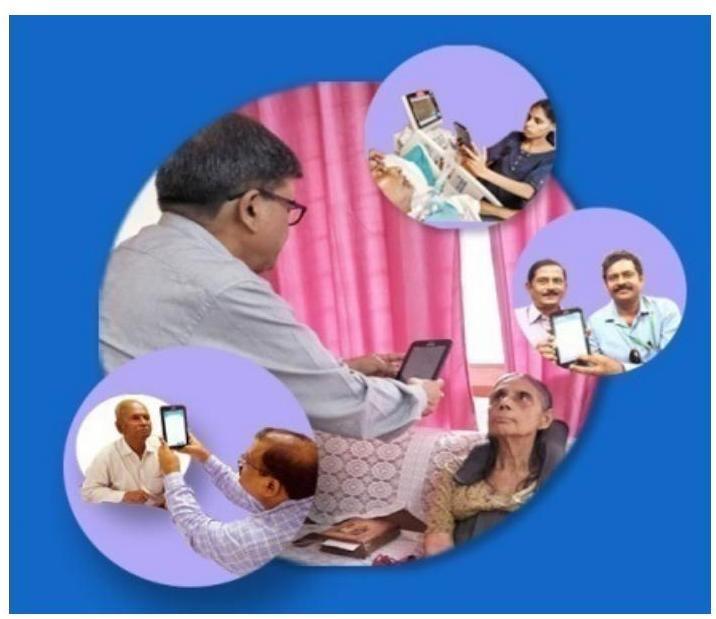
(Pensioners’ Association facilitating DLC of Aged/Sick/above 80 year’s pensioners from their home and Hospitals.)
Further to provide relief to 80 yrs and above aged pensioners for queuing up, a one-month additional time window has been given to them for submitting life certificate vide OM dated 18.7.2019. Now they can give their Life Certificate from October, 1 onwards every year instead of $1^{\text {st }}$ November which would be valid till $30^{\text {th }}$ November of the subsequent year.
Standing Committee of Voluntary Agencies (SCOVA):
2.27 A Standing Committee of Voluntary Agencies (SCOVA) has been set up under the
Chairmanship of MOS (PP) to provide feedback on the implementation of policies/programmes of D/o P&PW, besides mobilizing voluntary effort to supplement the Government action. The SCOVA consists of a Standing Group (5 members) and a Rotating Group (10 members). SCOVA was reconstituted in January 2018. The last SCOVA meeting was held under the Chairmanship of Dr Jitendra Singh, Hon’ble Minister of State (PP) on September 5, 2019, in New Delhi, which was attended by representatives of various Pensioners Associations and the Ministries/Department.
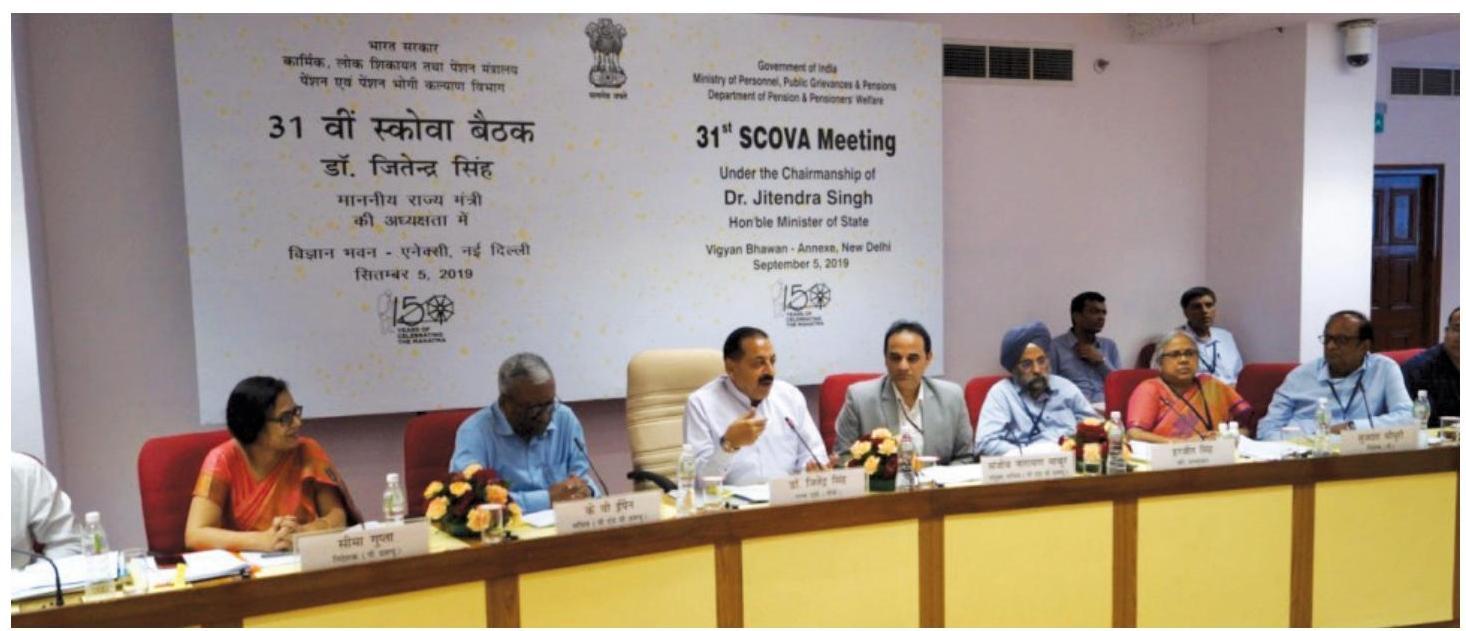
Ban on Single-Use Plastic:
2.28 Single-use Plastic was banned in all forms in the Department of Personnel \& Training.
Participation in Swachha Bharat Abhiyaan:
2.29 Apart from ensuring overall Swachhta in office premises, all three Departments participated in the “Swachhta Pakhwada” and “Swachhta hi Sewa” from $16^{\text {th }}$ May to $31^{\text {st }}$ May 2019 and $11^{\text {th }}$ September 2019 to $02^{\text {nd }}$ October 2019 respectively. Special cleanliness drives, competitions and workshops on various topics were held.
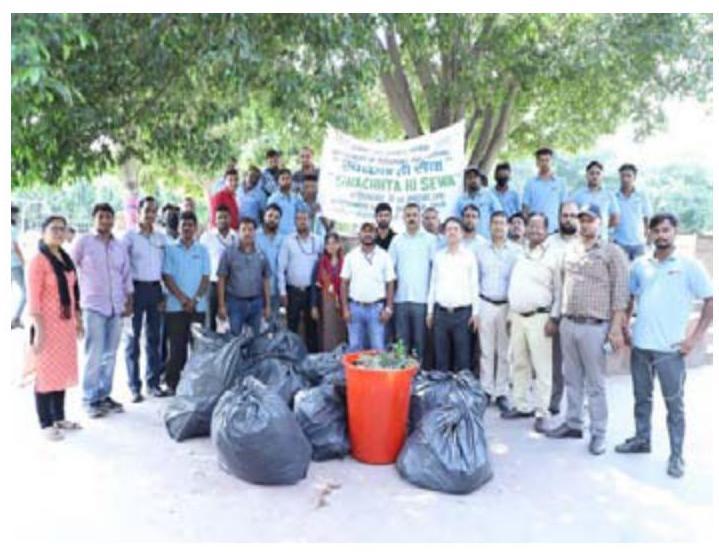
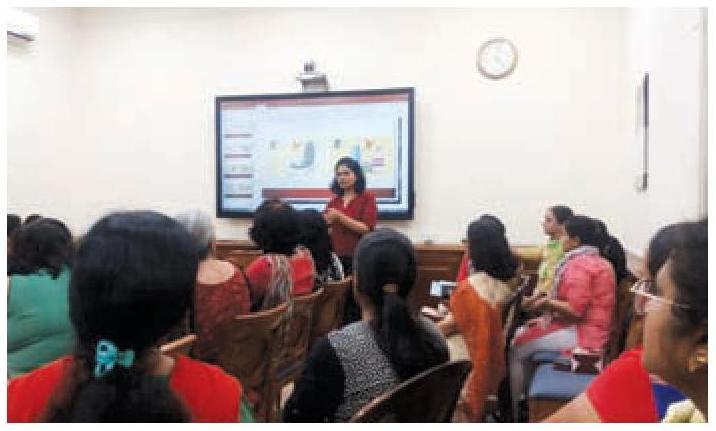
Digital exhibition on “History of Constitution of India”
2.30 To mark 70 years of Constitution of India, the Digital exhibition on “History of Constitution of India” was showcased on $09^{\text {th }}$ and $10^{\text {th }}$ December 2019, at North Block. Hon’ble MoS (PP) inaugurated the event. Employees of various Ministries working in North Block and adjoining premises, as well as the general public, visited the exhibition. Trainee officers of ISTM also visited the exhibition.
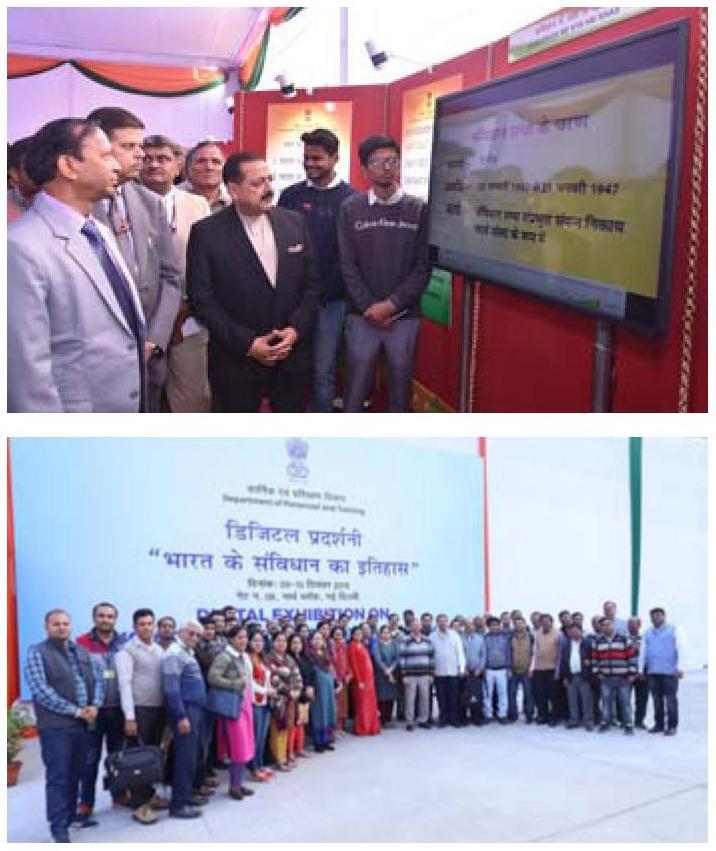
Blood Donation Camps
2.31 In order to inculcate participation in Citizen-Centric activities among employees of the Central Government, this Department has been organizing Blood Donation Camps in association with the Indian Red Cross Society, New Delhi on monthly basis since June 2015 in all major buildings where Government offices are situated. During the financial year 2019-20, nine Camps were organized at various locations and 641 units were collected. Blood Donation Camp was organised by DOP&T at North Block, New Delhi also on $03^{\text {rd }}$ July 2019 and 61 employees donated blood in this camp.
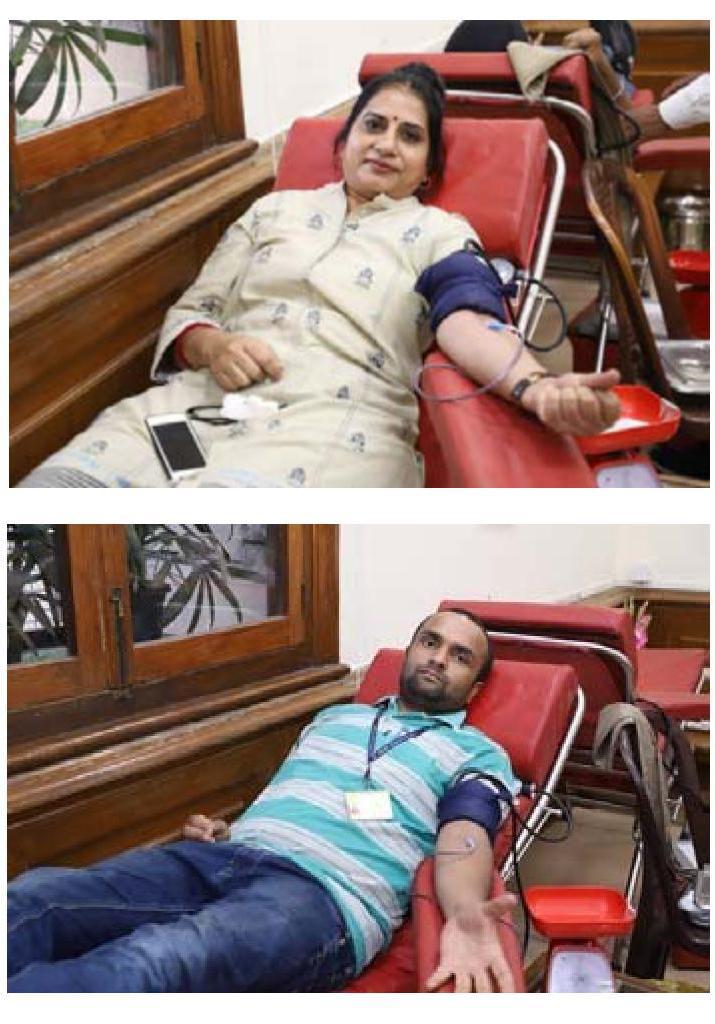
Preventive health check-up camp
2.32 Preventive health check-up camp was
organized for Canteen Staffs, Staff Car Drivers, and Despatch Riders on $02^{\text {nd }}$ May 2019 at North Block.
Introduction of Yoga Camps and celebration of Yoga Day:-
2.33 Yoga camps were organized for creating awareness about the benefits of Yoga among employees of the Department of Personnel & Training, Department of Administrative Reforms and Public Grievances, and Department of Pensions and Pensioners welfare. On $21^{\text {st }}$ June 2019, the fifth International Day of Yoga was celebrated, in which employees of this Department participated enthusiastically. Dr Jitendra Singh, Hon’ble MoS (PP) also graced the occasion by participating with the employees at North Block in the Yoga Day Celebration on $21^{\text {st }}$ June 2019.
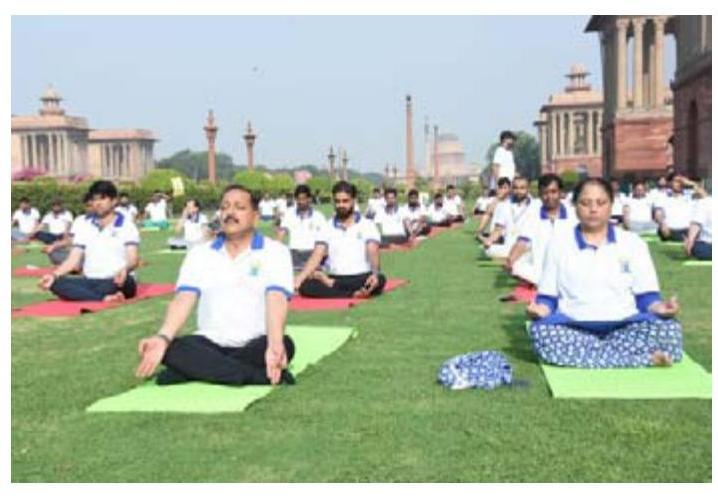

Celebration of International Women’s Day
2.34 International Women’s Day was celebrated by the Department on $6^{\text {th }}$ March 2020, where women employees of all the three Departments
of the Ministry participated. Hon’ble MOS (PP) also addressed the gathering on the occasion. Smt. Chhaya Sharma, DIG, NHRC was the chief guest of the event. Dr Jitendra Singh, Hon’ble MoS (PP) conferred awards on the achievers of various competitions held in the Ministry. Women employees of Department of Personnel \& Training, Department of Administrative Reforms, Public Grievances and Department of Pension and Pensioners’ Welfare participated in the event.
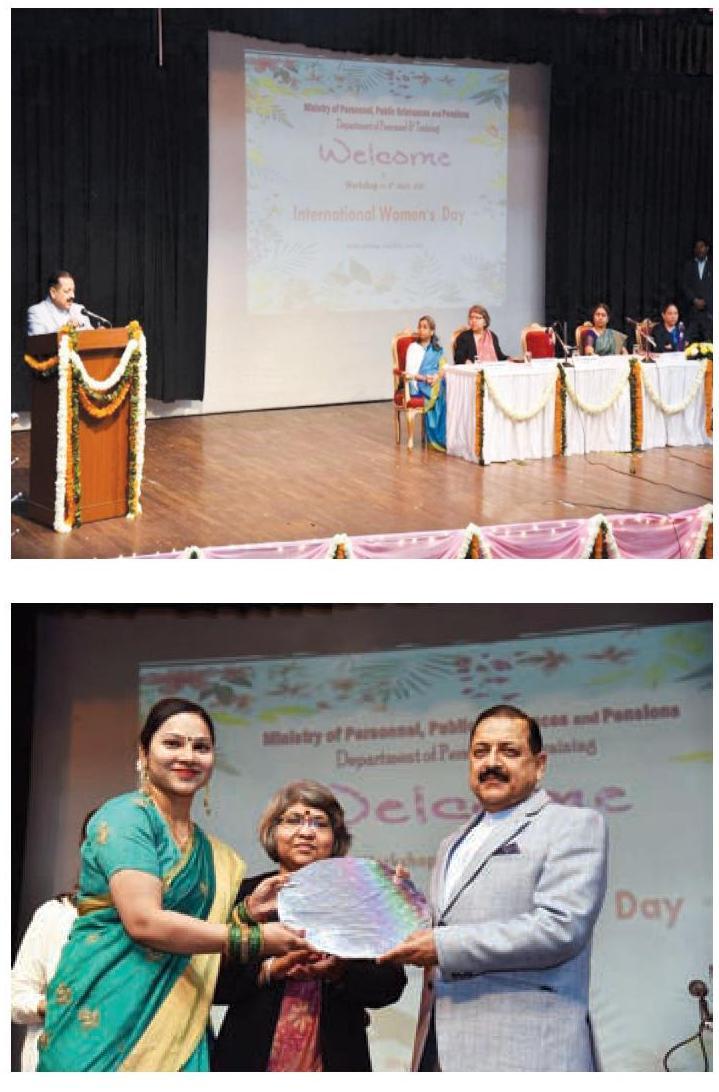
Prepaid Smart Card for Canteen of DOPT
2.35 Taking a step towards “Less Cash Economy”, Prepaid Smart Card was launched for use in Canteen of DoPT.
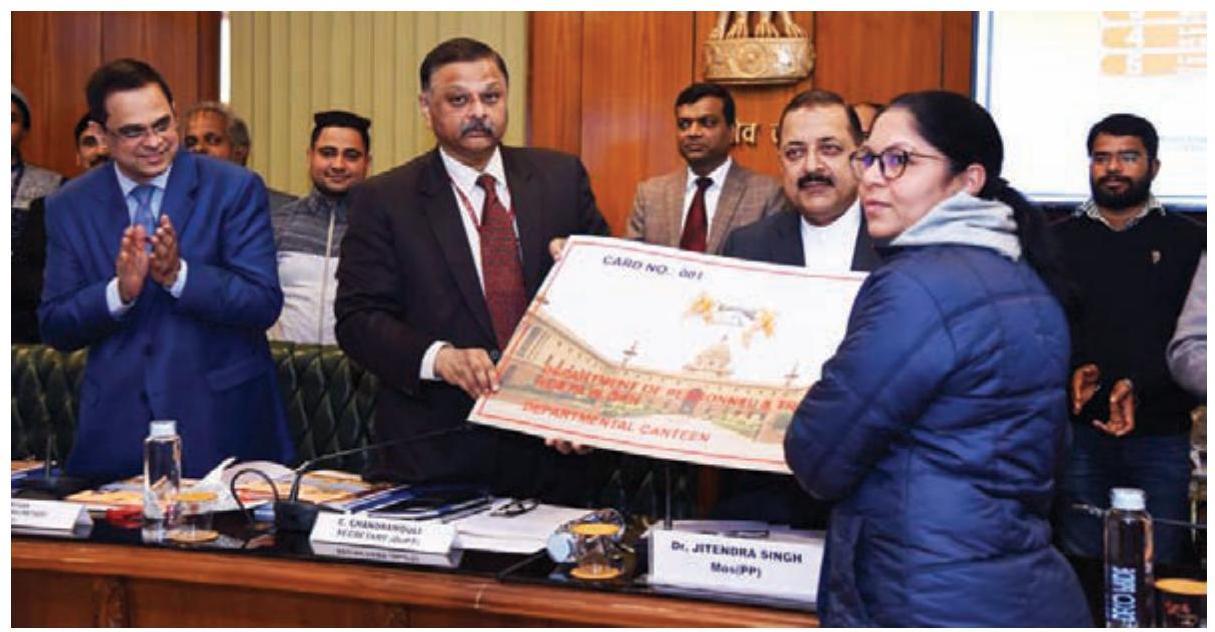
Award for payments in GeM
2.36 Award for best performance in the category of the compliant buyer in Payments in respect of Government e-Marketplace (GeM) was given by Sh. Piyush Goyal, Hon’ble Minister of Commerce and Industry on 05.12.2019.
Award for best performance in respect of Government e Marketplace (GeM) to DOP&T
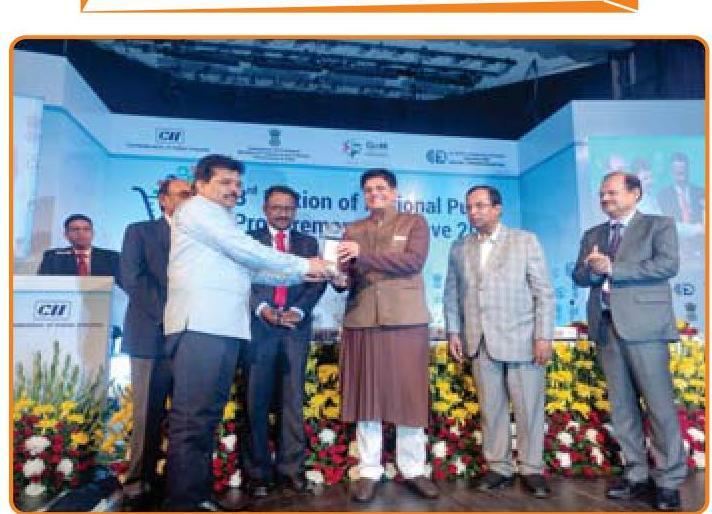
- DOP\&T received Award for best performance in the category of Compliant Buyer in Payments in respect of Government e Marketplace (GeM).
- The Award was given by Shri Piyush Goyal, Hon’ble Minister of Commerce and Industry on 05.12.2019 in the event-National Public Procurement Conclave, 2019 held at Stein Auditorium, India Habitat Centre, New Delhi.
- The Award was conferred for overall rating for timely bid closure, timely order placing, timely acceptance and timely payments.
First Sports Day of DOPT
2.37 On $25^{\text {th }}$ January 2020, DoPT celebrated its $1^{\text {st }}$ Sports Day. Employees of DoPT participated in various sports activities such as Cricket, Long Jump, and Race etc. Dr Jitendra Singh, Hon’ble MoS (PP) encouraged all participants and conferred medals on the achievers.
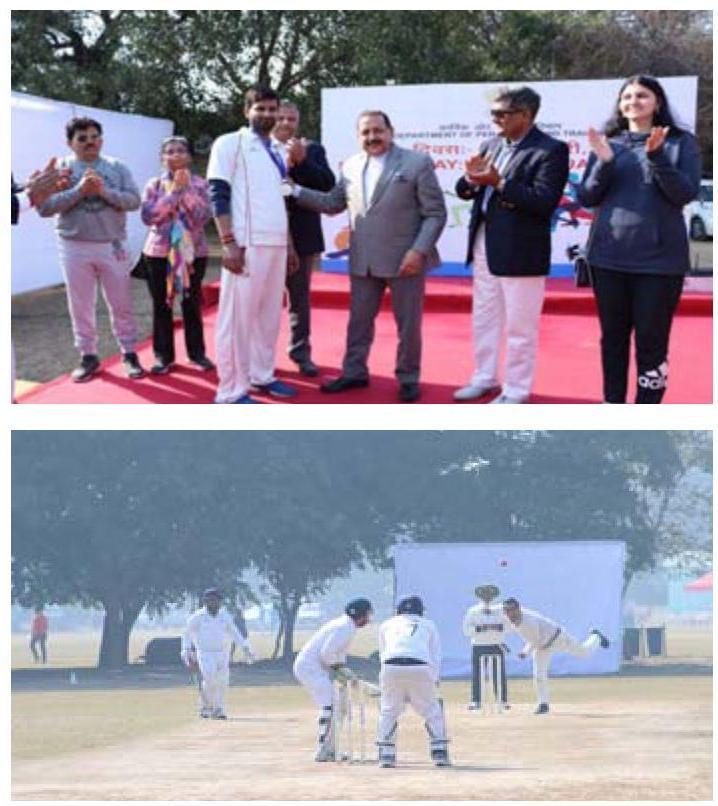
PERSONNEL POLICIES
- Matters relating to framing and amendment of recruitment rules/service rules for Group “A” and “B” posts
- Framing of policy relating to the procedure for Departmental Promotion Committee(s)
- Policy on seniority
- General policy matters relating to:-
(a) Flexible complementing scheme,
(b) Modified Assured Career Progression Scheme,
(c) Leave Travel Concession,
(d) Deputation,
(e) Child Care Leave,
(f) Pay & Allowances,
(g) Holiday policy,
(h) Age relaxation and
(i) Other matters concerning service conditions. - Administration of UPSC and SSC including exams except for the Civil Service Examination.
- Policy matters of PESB.
- Policy on Character verification before an appointment.
- Disagreement cases with UPSC from various Ministries except on appointment cases.
- UPSC (Exemption from Consultation) Regulations.
- Policy on APAR.
- Commercial employment after retirement.
- Policy on
(a) Retirement, extension, re-employment,
(b) Posting and transfers, Conduct and CCA Rules,
(c) Sealed Cover procedure,
(d) Status of Women in Central Government,
(e) Temporary Service Rules, Etc.
(f) Lien, Probation, Confirmation,
(g) Daily Wage Casual Labourers.
3.0 Regulation of Pay on imposition of penalty under CCS (CCA) Rules, 1965
In $7^{\text {th }}$ CPC, the concept of Pay Band and Grade pay was replaced with a new system of Pay Matrix as specified in the Central Civil Services (Revised pay) Rules, 2016. In this connection, detailed guidelines with illustrations were issued on the regulation of pay on imposition of penalties under Rule 11 of the Central Civil Services (Classification, Control, and Appeal) Rules, 1965.
[Reference DoPT’s O.M. No. 11012/15/2016-
Estt. A-III dated 18.06.2019]
3.1 Sanction for holding an elective office under Rule 15(1)(c) of the CCS (Conduct) Rules, 1964
The policy on fixing an upper limit of the number of years for which Government servants can hold elective office in any body in their entire career has been reviewed and it has been decided that
a Government servant may be allowed to hold elective office in any body, whether incorporated or not, for two terms or for 4 years, whichever is earlier, for which prior sanction would be required when a Government servant contests an election in such body, as per existing rules.
[Reference DoPT’s OM. No. 11013/1/2016-
Estt. A-III dated 5.08.2019]
3.2 Amendment in Central Civil Services (Conduct) Rules, 1964 regarding the acceptance of gifts by Government servants.
The provisions of Rule 13 of Central Civil Services (Conduct) Rules, 1964 prescribing ceiling for receiving gifts by Government servants, were amended vide G.S.R. No. 531 (E) dated 29.07.2019 to bring uniformity in provisions of CCS (Conduct) Rules, 1964, AIS (Conduct) Rules, 1968 and Foreign Contribution (Acceptance or Retention of Gifts or Presentation) Rules, 2012, which are as under:
| Before Amendment | After Amendment |
|---|---|
| Sub-rule (3) of Rule 13 | Sub-rule (3) of Rule 13 |
| In any other case, a Government servant shall not accept any gift without the sanction of the Government, if the value exceeds – | In any other case, a Government servant shall not accept any gift without the sanction of the Government, if the value exceeds – |
| (i) Rupees one thousand five hundred in the case of Government servants holding any Group ‘ $A$ ‘ or Group ‘ $B$ ‘ post; and | (i) Rupees five thousand in the case of Government servants holding any Group ‘ $A$ ‘ or Group ‘B’ post: and |
| (ii) Rupees five hundred in the case of Government servant holding any Group ‘C’ or Group ‘D’ posts. | (ii) Rupees two thousand in the case of Government servant holding any Group ‘C’ post. |
| Sub-rule (4) of Rule 13 | Sub-rule (4) of Rule 13 |
| Notwithstanding anything contained in sub-rule (2) and (3), a Government servant, being a member of India delegation or otherwise, may receive and retain gifts from foreign dignitaries, if the market | Notwithstanding anything contained in sub-rule (2) and (3), a Government servant, being a member of the Indian delegation or otherwise, may receive and retain gifts from foreign dignitaries in |
| Before Amendment | After Amendment |
|---|---|
| value of gifts received on one occasion does not exceed Rupees one thousand. In all other cases, the acceptance and retention of such gift shall be regulated by the instructions issued by the Government in this regard from time to time. |
accordance with the provisions of “The Foreign Contribution (Acceptance or Retention of Gifts or Presentation) Rules, 2012″, as amended from time to time. |
[Reference DoPT’s OM No. 11013/02/2019-Estt. A-III dated 6.08.2019]
3.3 Strengthening of administrationPeriodic review of Central Government Employees under Fundamental Rule (FR) 56(i)/(I) and Rule 48 of CCS (Pension) Rules, 1972.
Instructions on periodical review of Government employees under (FR) 56(i)/(I) and Rule 48 of CCS (Pension) Rules are already available in the public domain. These instructions were reiterated vide DoPT’s O.M. No. 25013/3/2019-Estt.A-IV dated 20.06.2019 and all Ministries/Departments were requested to undertake the periodic reviews in letter and spirit, including in public sector undertakings (PSUs)/ Banks and autonomous institutions under their administrative control.
[Reference DoPT’s O.M. No. 25013/3/2019Estt. A-IV dated 20.06.2019]
3.4 ‘Equal pay for Equal Work’ for
Casual workers: Compliance with earlier instructions and Hon’ble Court’s Judgements thereon:
With reference to this Department’s O.M.No.49014/2/86-Estt.(C) dated 07.06.1988 and Hon’ble Court’s judgements on the subject, it has been reiterated that:
- Where the nature of work entrusted to the casual workers and regular employees is the same, the casual workers may be paid at the rate of $1 / 30^{\text {th }}$ of the pay at the minimum of the
relevant pay scale plus dearness allowance for work of 8 hours a day. - In cases where the work is done by a casual worker is different from the work done by a regular employee, the casual worker may be paid only the minimum wages notified by the Ministry of Labour & Employment or the State Government/Union Territory Administration, whichever is higher, as per the Minimum Wages Act, 1948.
- Persons on daily wages (casual workers) should not be recruited for work of regular nature.
[Reference DoPT’s O.M. No. 49014/1/2017-Estt (C) pt. dated 04.09.2019]
Establishment (Leave \& Allowances) Section
3.5 An OM dated 20.6.2019 was issued under the CCS (Leave) Rules, 1972 stipulating that the officers who are appointed on contract in various posts under the Central Government will be allowed encashment of earned leave at their credit on the date of termination of the contract, subject to the condition that for each completed year of service put in by him in the post in such contract appointment, not more than 10 days benefit of earned leave encashment shall be permissible. While calculating the encashment of
leave in such a contract appointment, the number of days of leave for which encashment had been allowed in the previous appointment, if any, under the Government shall not be taken into account.
3.6 An OM dated 30.8.2019 was issued clarifying various amendments carried out as per $7^{\text {th }}$ CPC in CCS (Leave) Rules, 1972 as under:
(i) The amendment made in CCS (Leave) Rules, 1972 vide Notification dated 11.12.2018, have come into force from 14.12.2018 when the Notification was published in the official gazette.
(ii) Government servants serving in a Vacation Department have been allowed Earned Leave in place of Half Pay Leave by amending Rule 28 and Rule 29.
(iii) With the amendment of Rule 43-C relating to Child Care Leave (CCL), the following changes have been made:-
(a) CCL may be granted at 100% of the leave salary for the first 365 days and $80 \%$ of the leave salary for the next 365 days.
(b) CCL may be extended to single male parent including unmarried or widower or divorcee employee.
(c) For single female Government servants, the CCL may be granted for six spells in a calendar year. However, for other eligible Government servants, it will continue to be granted for a maximum of three spells in a calendar year.
3.7 “Special Disability Leave for injury intentionally inflicted” under Rule 44 has been
substituted by a new Leave named “Work-Related Illness and Injury Leave (WRIIL)” which may be granted to a Government servant (whether permanent or temporary), who suffers illness or injury that is attributable to or aggravated in the performance of her or his official duties or consequence of her or his official position. With the introduction of WRIIL, “Special Disability Leave for accidental injury” (under Rule 45) and Hospital Leave (under Rule 46) have been deleted. WRIIL has the following provisions:-
(a) Full pay and allowances will be granted to all employees during the entire period of hospitalization on account of WRIIL.
(b) Beyond hospitalization, WRIIL will be governed as follows:
(i) Government servants (other than military officers) will be paid full pay and allowances for the 6 months immediately following hospitalization and Half Pay only for 12 months beyond that period. The Half Pay period may be commuted to full pay with the corresponding number of days of HPL debited from the employee’s leave account.
(ii) For officers of the Central Armed Police Forces (CAPF), full pay and allowances will be paid for the 6 months immediately following hospitalization, and full pay only for the next 24 months.
(iii) Personnel below the rank of officers of CAPF will be paid full pay and allowances, with no limit regarding the period of leave.
(iv) In the case of persons to whom the Workmen’s Compensation Act, 1923
applies, the amount of leave salary payable under WRIIL shall be reduced by the amount of compensation payable under the Act.
(v) No EL or HPL will be credited during the period that employee is on WRIIL.
Establishment (Pay) Section
OM No. 2/11/2019-Estt.(Pay-II) dated 17.09.2019
- Regulation of conditions of service of officers who were holding a post on an ad-hoc basis in the parent cadre before their appointment on deputation basis in the Personal Staff of Union Ministers, during such deputation and subsequent repatriation to parent cadre-reg.
3.8 It has been decided that an officer who was holding a post on ad hoc basis prior to proceeding on deputation in the Personal Staff of the Union Ministers will proceed on such deputation on the basis of the regular post held by him in the parent cadre. It has been further decided that, during such deputation, the ad hoc promotion in the parent cadre and consequent pay which he would have been entitled to, had he continued on such ad hoc post in the parent cadre, will be notionally continued for fixation of his pay on repatriation from deputation. On repatriation, the officer will revert to the post which he would have held had he continued in the parent cadre without proceeding on such deputation. However, in case any situation arises of termination of his ad hoc appointment in the parent cadre during his deputation, his pay on deputation will be revised with reference to his pay on such reversion to regular post in the parent cadre, and in that case, after his repatriation from deputation, the officer will go back to the post held on a regular basis in the lower grade, and his pay
will be fixed accordingly.
Establishment (RR) Section
3.9 The portal on Recruitment Rules Formulation, Amendment and Monitoring System (RRFAMS) was launched in December 2016, to automate the process of consultation for framing and amendment of Recruitment Rules (RRs). The module for consultation with the Union Public Service Commission on the RRFAMS portal has been made fully operational w.e.f. 3.12.2018. All the Ministries/Departments have been requested to upload the additional data/information required by UPSC on the portal while sending the proposal to DoPT. Efforts are underway to achieve the target of $100 %$ automation of the process of framing/amendment of RRs by developing the Legislative Department module (LD module) and publication of RRs on e-gazette of Govt. of India Press, through RRFAMS portal.
3.10 Based on the recommendations made by Sectoral Group of Secretaries (SGoS) in its report submitted in February 2017, Government decided to undertake lateral recruitment of Joint Secretaries, on a contract basis, to achieve the twin objectives of bringing in fresh talent as well as augment the availability of manpower. In response to the advertisement, 6077 applications were received. The recruitment process was undertaken by the Union Public Service Commission (UPSC). UPSC recommended 9 candidates for appointment as Joint Secretaries in 9 Ministries/ Departments on 15/30.4.2019. With the approval of the competent authority and on acceptance of the terms and conditions of appointment, 8 recommended candidates have been appointed as Joint Secretaries in September 2019 in the Ministries/Departments of Civil Aviation,
Commerce, Economic Affairs, Environment, Forest and Climate Change, Financial Services, New and Renewable Energy, Road Transport and Highways and Shipping. One candidate has not accepted the offer of appointment.
Establishment D Section
CONSOLIDATED GUIDELINESREGARDING MODIFIED ASSURED CAREER PROGRESSION SCHEME (MACPS) FOR THE CENTRAL GOVERNMENT CIVILIAN EMPLOYEES
3.11 The Seventh Central Pay Commission in Para 5.1.44 of its report, recommended that the Modified Assured Career Progression Scheme (MACPS) will continue to be administered at 10, 20, and 30 years as before. The Government has considered the recommendations of the Seventh Central Pay Commission for the continuation of MACPS and accordingly, this Department vide OM No. 35034/3/2015-Estt. (D) dated 22.10.2019 has issued consolidated guidelines on MACP Scheme for the Central Government civilian employees. Under the Scheme, the employee will move to immediate next Pay Level in the new Pay Matrix. MACPS will continue to be applicable to all employees up to HAG level, except members of Organised Group `A’ Services.
RECRUITMENT AGENCIES
3.12 The Union Public Service Commission (UPSC) and the Staff Selection Commission (SSC) are the two designated recruitment agencies administered by the Department of Personnel and Training. While the UPSC is a Constitutional body set up under Article 315 of the Constitution, the Staff Selection Commission has been set up by Resolution of the Government and it has the
status of an attached office of the Department of Personnel and Training. Both these agencies enjoy the reputation for selecting candidates for the Government services in a fair, objective, and impartial manner. The candidates for the various examinations come from a variety of social environment and having studied in different disciplines.
3.13 UNION PUBLIC SERVICE COMMISSION
3.13.1 The Union Public Service Commission comprises a Chairman and ten Members. The UPSC makes recruitment for All India Service, Group ‘A’ Central Civil Services /posts, and Group ‘B’ Gazetted posts in Ministries/ Departments of the Central Government. The Commission also conducts the examination for recruitment of Commissioned officers in the Defence forces. Some Union Territories (UTs) also avail the services of the Union Public Service Commission for recruitment to the posts under the UT.
3.13.2 The functions of the Commission are as specified in Article 320 of the Constitution. By the exercise of powers conferred by the proviso to Article 320 (3) of the Constitution the President has made the UPSC (Exemption from Consultation) Regulations, 1958 as amended from time to time, as respects the All India Services and also as respects other services and posts in connection with the affairs of the Union specifying the matters in which it shall not be necessary for the UPSC to be consulted.
3.13.3 Examination
- During the year 2018-19, the Commission
conducted a total of 14 examinations under the method of Recruitment by Examinations. Of these, 10 examinations for selection to Civil Services/Posts and 04 for Defence Services were conducted. For these examinations, a total of 30, 35,783 applications were received and processed and 8,511 candidates interviewed for Civil Services/Posts. The interviews for Defence Services were conducted by the Services Selection Board (SSB) of the Ministry of Defence. A total of 3,889 [3,675 + 214 (Reserved List)] candidates (including 214 candidates through Reserve List) were recommended for appointment to various posts. A total of 2,643 candidates (including candidates through Reserve List) were recommended for Civil Services/Posts and 1,246 candidates for Defence Services/ Posts.
- Of the 1,131 posts reserved for SC, ST and OBC candidates to be filled up under method of Recruitment by Examinations, the Commission recommended 997 SC, ST and OBC candidates. In addition, 188 reserved category candidates were recommended at normal standard. The final status will be known after the allocation of service upon applying the Reserve List Rule.
- Under the method of Recruitment by Examination, the offer of appointment is made by the Ministry/Department concerned. A delay in the issues of offer of appointment was reported in 83 cases.
- 64 (sixty-four) cases of malpractices committed by the candidates were reported to the Commission relating to the suppression of
information, submission of false information/ fabricated documents, using unfair means and copying, etc. The Commission took serious note of such cases and after following due process, imposed penalties on the delinquent candidates, ranging from cancellation of their candidature to their debarment from the future Examination/ Selection, conducted by the Commission, for periods varying from ten years to permanent debarment. - The syllabus of Combined Medical Services Examination was changed for the Examination held during 2018.
3.13.4 Direct Recruitment by Selection
- The Commission received 188 requisitions for 1,190 posts from various Ministries/ Departments. After adding the cases carried forward from the previous year, a total of 337 requisitions for 2,000 posts were processed during the year. Of these, 47 requisitions for 192 posts were deemed as closed for want of clarifications from the Ministries/ Departments concerned or withdrawn at the pre-advertisement stage by them.
- A total of 1,003 posts against 141 requisitions were advertised during the year and 94,394 applications were received. The recruitment process was cancelled in respect of 08 requisitions for 32 posts, subsequent to the publications of advertisement.
- During the year, a total of 96,304 applications were finalized including applications received in the preceding year; 2,872 candidates were called for interview and 2,199 candidates appeared for the interview. 510 candidates
were recommended against 582 posts requisitioned in 132 cases. The applicant to Post Ratio was 165 and the Recommendation to Post Ratio was 0.88.
- Computer-Based Recruitment Tests/ Recruitment Tests (CBRTs/RTs) were conducted in 17 cases, where the number of applicants was disproportionately high vis-àvis the number of vacancies.
- The process of selection to 72 posts became infructuous due to non-availability of suitable candidates. Most of these posts required specialized medical or scientific qualifications.
- On request of the Department of Personnel and Training (DoP&T), the Union Public Service Commission undertook recruitment for Joint Secretary level posts on contract basis (Lateral Entry) for ten identified Ministries/Departments. Out of 6,077 applications received in response to DoP\&T advertisement, 3,688 candidates submitted Detailed Application Forms (DAFs) on time. A software was developed for online receipt and scrutiny of the DAFs. After scrutinizing the DAFs, the Commission shortlisted 65 candidates for the interview*.
- As against 275 reserved posts, a total of 234 candidates ( 75 SC, 28 ST and 131 OBC) were recommended. Thus 85.1 percent of the posts for the reserved category were filled up. Besides, 06 SC, 02 ST and 45 OBC candidates were recommended for selection against the unreserved post.
- The Commission recommended 15 candidates against 18 posts reserved for
Person with Disabilities.
- A delay was reported in 28 cases in the issue of offer letters of appointment, by the Ministry/ Department concerned, to the candidates recommended by the Commission. In certain cases, the Ministry/Department concerned did not provide information regarding the issuance of the offer letters of appointment to the recommended candidates.
- The process was completed in April 2019. Nine Candidates were finally selected and one post became infructuous due to the nonavailability of a suitable candidate.
3.13.5 Appointments
- The Commission made recommendations regarding the suitability of candidates/officials for promotion, deputation, absorption etc. in respect of 5,570 officers.
- The Commission considered the service records of 8,338 officers and recommended (a) 5,463 officers for promotion in Central Services and (b) 107 officers for appointment on Deputation (ISTC/ Absorption).
3.13.6 Recruitment Rules
- During the Financial Year 2018-19, RR proposals in respect of 607 posts were advised by the Commission. Besides, 04 Service Rules and 12 One Time Mode proposals were also advised upon by the Commission during the year.
- Recruitment Rules Formulation, Amendment \& Monitoring System (RRFAMS), an online portal, rolled out to process Framing/
Amendment of Recruitment Rules w.e.f. 03.12.2018.
3.13.7 Disciplinary Cases
During the year 2018-19, the Commission received 595 disciplinary cases for tendering advice. Including the 263 cases brought forward from the previous year i.e. 2017-18 which were pending with the Commission as on April 1, 2018, the total number of cases with the Commission during the year was 858 . Out of 858 cases, advice of the Commission was tendered in 493 cases, 63 cases were returned on account of procedural deficiencies.
3.13.8 In pursuant to the decision taken in the $20^{\text {th }}$ National Conference of Chairpersons of State Public Service Commissions held on January 1213, 2018, the Commission organized the following three Workshops:-
(a) Workshop on “RTI Matters”
One-day Workshop on “RTI matters for the Secretaries and Public Information Officers of State Public Service Commissions” was held on April 26, 2018, at Hotel Ashok, Chankyapuri. A total of 40 officers participated in the workshop.
(b) Workshop on “Accounting for Accounts Officers of State PSCs”
One-day Workshop on “Accounting for Accounts Officers of State PSCs” for the officers/staff of the State Public Service Commissions was held on May 18, 2018, at Hotel Ashok, Chankyapuri, New Delhi. A total of 39 Officers participated in the workshop.
(c) Workshop on Interview Techniques
Two-day Workshop on Interview Techniques for Hon’ble Chairpersons and Hon’ble Members of State PSCs was conducted by DIPR at Union Public Service Commission on August 28-29, 2018.
3.13.9 National Conference of Chairpersons of State Public Service Commissions
The $21^{\text {st }}$ National Conference of Chairpersons of State Public Service Commissions was held at Bhubaneshwar, Odisha on February 4-5, 2019.
3.13.10 Visits of Foreign Delegations
- A five-member delegation led by Mr Dasho Indraman Chhetri, Hon’ble Member, Royal Civil Services Commission, Bhutan visited UPSC on June 26, 2018.
- A delegation led by HE Dato Sri Zoal Azha Yusof, Deputy Chairman, Public Service Commission, Malaysia visited UPSC on September 20, 2018.
- A five-member delegation from Afghanistan led by Mr Ahmad Nader Nadery, Hon’ble Chairman of Independent Administrative Reform & Civil Service Commission visited UPSC on September 27, 2018.
- A five-member delegation from Mauritius led by Mr S. Gunessee, Hon’ble Chairman of Public Service Commission and Disciplined Forces Service Commission, Mauritius visited UPSC on November 16, 2018.
- A ten-member delegation led by Mr Lal Babu Pandit, Minister for Federal Affairs and
General Administration of Nepal visited UPSC on December 17, 2018.
- A six-member delegation from Zimbabwe led by Hon’ble Chairman of PSC of Zimbabwe, Dr Vincent Hungwe visited UPSC on March 12, 2019.
3.13.11 Progressive use of Hindi in official work
Union Public Service Commission continued to make sincere and concerted efforts to ensure compliance with the provisions of the Official Language Act/Rules and various Orders/ Instructions issued by the Department of the Official Language from time to time regarding the progressive use of Hindi for official purposes.
(i) Implementation of Government’s Language Policy and programme
The Union Public Service Commission has a Hindi Branch under the charge of a Director (Official Language) with two Deputy Directors (Official Language), four Assistant Directors (Official Language) and other supporting staff. Apart from guiding and monitoring the implementation of the Official language policy and programmes of the Government, this Branch also performs the work relating to the translation of documents, which are required to be issued in Hindi or bilingually.
(ii) Official Language Implementation Committee
During 2018-19, four meetings of the Official Language Implementation Committee under the chairmanship of Secretary UPSC were
held in the Commission and necessary follow-up action was taken to implement the decisions of the Committee.
3.13.12 Virtual Tour of UPSC Museum
The Commission has developed its Museum showcasing its history and development, which has been well appreciated by its visitors. As everyone can’t visit the Museum physically, the Commission decided to make available 360 degrees Virtual Tour of the UPSC Museum on its website. The Virtual Tour of UPSC Museum has been developed and hosted on the UPSC website. Further, the Archive Materials/ documents available in Museum have been digitized and linked to Virtual Tour. Now the UPSC Museum can be seen online.
3.14 THE STAFF SELECTION COMMISSION
A. INTRODUCTION
3.14.1 The Staff Selection Commission is one of the largest recruiting agencies in India in terms of the number of candidates who apply for various posts in the Central Government. The Staff Selection Commission is mandated to make recruitment to Group ‘B’ (Non-Gazetted) and Group ‘C’ (Non-Technical) Posts in the Government of India. The Commission has also been assigned the responsibility of recruitment to Group ‘B’ (Gazetted) Posts of Assistant Accounts Officer and Assistant Audit Officer for the Indian Audit and Accounts Department.
B. EXAMINATIONS CONDUCTED BY THE COMMISSION
3.14.2 The Commission is mandated to conduct the following examinations:
I. Combined Graduate Level Examination
II. Combined Higher Secondary (10+2) Level Examination
III. Junior Engineers (Civil, Mechanical, Electrical and Quantity Surveying & Contracts) Examination.
IV. Sub Inspectors in Delhi Police, CAPFs and Assistant Sub Inspectors in CISF Examination
V. Junior Hindi Translators, Senior Hindi Translator and Hindi Pradhyapak Examination.
VI. Junior Translators (CSOLS) Examination.
VII. Multi-Tasking (Non-Technical) Staff Examination.
VIII. Stenographer’s Grade ‘C’ \& ‘D’ Examination
3.14.3 Non-mandated Examinations: In addition to the above, the Commission also conducts non-mandated Examinations on the specific directions of the Government. Such Examinations are conducted on a Memorandum of Understanding basis.
3.14.4 Departmental Examinations: Besides, the Commission also conducts three Limited Departmental Competitive Examinations in a year for promotion from (i) Multi-Tasking Staff (MTS) to Lower Division Clerk (LDC) Grade, (ii) Lower Division Clerk (LDC) to Upper Division Clerk (UDC) Grade and (iii) Stenographer Grade ‘D’ to Stenographer Grade ‘C’.
3.14.5 Selection Posts: The Commission makes recruitment to isolated posts (not covered by the open competitive examinations) where the number of vacancies is small and the essential
qualification vary from Matriculation to Post Graduate degree, specific to the job requirement, for different Group B' (Non-gazetted) and GroupC’ (Non-Technical) posts in different Ministries/ Departments and Attached and Subordinate Offices of the Government of India.
3.14.6 As on 30.11.2019, a total of 87, 23,887 candidates had registered for appearing in various Competitive Examinations to be conducted by the Commission.
C. MEASURES ADOPTED IN THE EXAMINATION SYSTEM
3.14.7 Introduction of Computer Based Mode (CBM) of Examination for conduction of various examinations by the Staff Selection Commission.
In June 2016, the Commission adopted the Computer Based Mode for the conduct of its Objective Type Multiple Choice Examinations. Earlier these examinations were conducted in the conventional Optical Mark Reader (OMR) Based Mode. The Computer Based Mode of examination has the following strategic advantages:-
(i) The Computer Based Mode of Examination is more effective and with adequate safeguards in place, the said modality is more reliable, efficient and robust.
(ii) Human intervention is minimal which reduces the chances of the examination being compromised.
(iii) There are greater flexibility and higher confidentiality in the administration and management of Question Papers.
(iv) Complete automation leads to greater
accuracy and faster processing of results.
(v) There is better data management, analysis and report generation.
3.14.8 Recruitment to Selection Posts
As a sequel to the Government’s decision to dispense with interviews for all Group ‘B’ and ‘C’ posts with effect from 01.01.2016, the Staff Selection Commission has adopted the Computer Based Mode of Examinations for Selection Posts also. These examinations are conducted at three EQ Levels viz. the (i) Matriculation Level, (ii) Higher Secondary (10+2) Level and (iii) Graduate & above Level.
3.14.9 Measures for the benefit of Persons with Disabilities (Divyangjan)
The Commission has been extending the facility of Scribes for its written examinations/Computer Based Mode of examinations, and Passage Reader for Skill Test, along with the compensatory time of 20 minutes per hour, to Visually Handicapped (VH) candidates, candidates afflicted by cerebral palsy and candidates afflicted by locomotor disability ( $40 %$ or more) wherein the dominant writing extremity is affected to the extent of slowing the performance of the candidates.
With the passage of the rights of Persons with Disabilities Act 2016, the Commission now extends facilities to PwD (Divyangjan) candidates as per guidelines issued by Department of Empowerment of Persons with Disabilities. The Commission has taken the due precaution, to ensure that a separate set of questions are administered in quantitative aptitude and general intelligence to VH candidates, which do not have components of maps, graphs,
statistical data, diagrams and figures.
The Commission makes a concerted effort to provide disabled-friendly examination venues, for candidates afflicted with disabilities, during various examinations conducted by it. Instructions are issued to the Venue Supervisors for making necessary arrangements for Divyangjan, preferably on the ground floor, with easy, safe, and trouble-free accessibility to the venues concerned. In case, an adequate number of rooms or computer labs are not available on the ground floor, Divyangjan are accommodated in the venues which are easily accessible and where lift facilities are available. The Commission makes concerted efforts to ensure that the Divyangjan are not subjected to any undue inconvenience while taking their examinations.
3.14.10 Transparency in Governance
As a premier Recruiting Agency, the Commission maintains a high standard of integrity, discipline, and efficiency in the conduct of its examinations to ensure merit-based selection.
The Commission also maintains transparency in its processes. The Commission has put in place a robust grievance redressal mechanism wherein references received through CPGRAMS, RTI or any other mode of communication are addressed on priority with due weightage assigned to the quality of replies.
3.14.11 Candidates registering with the Commission
The total number of candidates registered for various Examinations of the Commission during 2019-20 as on 30.11.2019 is as under:
| SI. No. |
Name of Examination | Date of Examination |
Registered candidates |
|---|---|---|---|
| 1 | Multi Tasking (Non-Technical) Staff Examination 2019 |
02.08.2019 to 22.08.2019 |
$38,69,446$ |
| 2 | Selection Post 2019 (Phase VII) | 14.10.2019 to 16.10.2019 |
$5,90,953$ |
| 3 | Junior Hindi Translator, Junior Translator, Senior Hindi Translator and Hindi Pradhayapak Examination 2019 |
26.11.2019 | 89,849 |
| 4 | Junior Engineer (Civil, Mechanical, Electrical and Quantity Surveying & Contracts) Examination 2019 |
To be held | $8,06,514$ |
| 5 | Sub-Inspector in Delhi Police, CAPFs and Assistant Sub-Inspector in CISF Examination 2019 |
To be held (09.12.2019 to 13.12.2019) |
$6,73,593$ |
| 6 | Stenographer Grade ‘C’ and ‘D; Examination 2019 |
To be held | $5,13,721$ |
| 7 | Combined Graduate Level Examination 2019 | To be held | $21,79,811$ |
| Total | $\mathbf{8 7 , 2 3 , 8 8 7}$ |
Candidates selected by the Commission
3.14.12 During the Financial Year 2019-20 (up to 30.11.2019) the Commission has recommended 8,120 candidates to various User Ministries / Departments. Details in this regard are given in the table below:-
| S. No |
Name of Examination |
Date of Declaration of Result |
Candidates Selected |
|---|---|---|---|
| 1 | Combined Graduate Level Exam- ination 2017 |
15.11 .2019 | 8,120 |
| Total | $\mathbf{8 , 1 2 0}$ |
3.14.13 Progressive use of Hindi in Commission’s work
During the period under review, provisions of Section 3(3) of Official Language Act, 1963 and Official Language Rule, 1976 were duly complied with. All the notices of various examinations published during the period were issued bilingually and emphasis was laid on increasing the original correspondence in Hindi with three regions namely $A, B$ and $C$ as per target prescribed by the Department of Official Language.
Three Regional/ Sub Regional Offices of Staff Selection Commission namely Prayagraj (Region-A), Mumbai (Region-B) and Kolkata
(Region-C) were awarded the Rajbhasha Shield under the scheme of commendable work in Official Language Hindi for the year 2018-19. In the year 2018-19, two officers and five officials were awarded under the scheme of original work in Hindi. Research and Analysis Section of the SSC(HQs) was awarded Rajbhasha Running Shield for the year 2018-19.
In order to encourage the progressive use of Hindi in the Official work and to create interest among officers/officials for its usage Hindi Software supported by Unicode compliance is being used. All Regional/ Sub Regional Offices of the Commission along with Head-Quarter are using this Hindi Software / Fonts. The Hindi Fortnight event was organized from $14^{\text {th }}$ September 2019 to $28^{\text {th }}$ September 2019. During the fortnight various competitions like Hindi Typing, Hindi Story Writing, Noting and Drafting, General Knowledge, Hindi Essay and Debate competitions were organized. Certificates were distributed to the winners by Hon’ble chairman of the Staff Selection Commission on $30^{\text {th }}$ September 2019. A one day Hindi Workshop was also organized on $20^{\text {th }}$ September 2019 on Standard Hindi Spelling. Fourteen participants were trained in this workshop.
3.15 Public Enterprises Selection Board
3.15.1 The Public Enterprises Selection Board {PESB} is a high powered body constituted by Government of India Resolution dated 3.3.1987 which was subsequently amended from time-to-time. The latest amendment was made vide notification dated 10.06.2016 whereby candidates from State Public Sector Enterprises (SPSEs) and Private Sector have been made eligible to apply for Board Level posts of CPSEs. The PESB
has been set up with the objective of evolving a sound managerial policy for the Central Public Sector Enterprises (CPSE) and, in particular, to advise the Government on appointment to top management posts. The PESB is headed by a full-time Chairman with three Members.
3.15.2 The specific functions assigned to the PESB include the following:
(i) To be responsible for the selection and placement of personnel in the posts of Chairman, Managing Director or Chairman-cum-Managing Director (Level-I), and Functional Director (Level-II) in PSEs as well as in posts at any other level as may be specified by the Government;
(ii) To advise the Government on matters relating to appointments, confirmation or extension of tenure and termination of services of the personnel of the above-mentioned levels;
(iii) To advise the Government on the desired structure at the Board level, and, for senior management personnel, for each PSE or group of PSEs;
(iv) To advise the Government on a suitable performance appraisal system for both the PSEs and the managerial personnel in such enterprises;
(v) To build a data bank containing data relating to the performance of PSEs and its officers;
(vi) To advise the Government on formulation and enforcement of a code of conduct and ethics for managerial personnel in PSEs;
(vii) To advise the Government on evolving suitable training and development programs for management personnel in PSEs.
3.16 Action taken by PESB during the year 2019-20 (as on 26.11.2019)
The achievements made during the period under report are as follows:-
| Sr. No. | ||||
|---|---|---|---|---|
| 1. | Selection process | No of Advertisements issued: | No. of selection meetings held | No. of posts where recommendations were made by PESB |
| 119 | 123 | 107 | ||
| 2. | Joint Appraisal for non-extension/ non-confirmation of tenure. | 0 | ||
| 3. | Meeting for creation of posts | $2^{*}$ | ||
| 4. | Meetings for Categorization/ up-gradation of CPSEs. | $1^{* *}$ |
{” During July 2019, Director (Technical & Project), NTPC Limited \& during October 2019, Director (Technical), NHIDCL
** During October 2019, initial categorization of BGRL (Bharat Gas Resources Limited) along with the creation of 3 Board Level posts}
CHAPTER
RESERVATION IN THE CENTRAL GOVERNMENT SERVICES
MANDATE
Based on the policy decision taken by the concerned nodal Ministries/Departments, DoPT issues instructions on the matters regarding reservation in posts and services in Central Government for the following:-
- Scheduled Castes, Scheduled Tribes & Other Backward Classes;
- Economically Weaker Sections who are not covered under the scheme of reservation for SCs, STs and OBCs;
- Persons with Benchmark Disabilities;
- Ex-servicemen.
4.0 The Government has taken several steps for the upliftment and welfare of the Scheduled Castes (SC), the Scheduled Tribes (ST) and Other Backward Classes (OBC), one such welfare measure, as per Constitutional provisions, is to give them reservation in services under the State. Persons with Benchmark Disabilities (PwDs), Exservicemen and Economically Weaker Sections (EWS) who are not covered under the Scheme of reservation for SCs, STs and OBCs also get the benefit of reservation in services.
RESERVATION FOR SCs, STs AND OBCs:
4.1 Clause (4) of Article 16 of the Constitution of India enables the State to make provision for reservation of appointments or posts in favour of any backward class of citizens which, in the opinion of the State, is not adequately represented in the services under the State. Clause (4A) of the same Article enables the State to provide reservation for the members of the SC and ST in the matter
of promotion. Article 335 provides that the claims of the members of the SC and the ST shall be taken into consideration, consistently with the maintenance of efficiency of administration, in the making of appointments to services and posts in connection with the affairs of the Union or a State.
4.2 In consonance with the powers given by the Constitution, the Government has issued various instructions, from time to time, providing for reservation in services for the members of the SCs, the STs and the OBCs. Such members of OBC, as fall in the creamy layer, however, do not get the benefit of reservation. The income limit for determining the creamy layer status amongst the OBCs to exclude the socially advanced persons/ sections is presently ₹ 8.0 lakh per annum.
4.3 Reservation to SCs, STs and OBCs, in case of direct recruitment, is available in all groups of posts. When direct recruitment is made on all India basis by open competition, reservation
for SCs, STs and OBCs is $15 %, 7.5 \%$ and $27 \%$ respectively, and when direct recruitment is made on all India basis otherwise than by open competition, it is $16.66 \%, 7.5 \%$ and $25.84 \%$, respectively.
4.4 In case of direct recruitmentto Groups C and the erstwhile Group D posts, normally attracting candidates from a locality or a region, percentage of reservation for SCs and STs is generally fixed in proportion to the population of SCs and STs in the respective States/UTs. Reservation for OBCs, in such cases, is fixed keeping in view their proportion in the population of the State/ UT subject to the maximum at $27 \%$ Further it is subject to the condition that total reservation for SCs, STs and OBCs does not exceed the limit of 50\%, prescribed by the Nine Judges Constitutional Bench of the Hon’ble Supreme Court in the Indira Sawhney Judgment.
4.5 Relaxations and concessions are given to SC and ST candidates with a view to increasing their representation in services. They get relaxation in upper age limit, exemption from payment of fees and relaxation in standards of suitability. They also get an unlimited number of chances within the relaxed age limit prescribed for appearing in the competitive examinations.
4.6 Likewise, the OBC candidate get concession like relaxation in upper age limit up to three years, relaxation in the number of chances up to seven within the relaxed age limit for appearing in the Civil Services Examination etc. The SC/ST/ OBC candidates appointed on their ‘own merit’ are adjusted against unreserved vacancies.
4.6.1 In case of promotion, the reservation is provided for SCs and STs only which is $15 \%$ and
7.5\%. Further, SC and ST candidates appointed by promotion on their merit and seniority and not owing to reservation or relaxation of qualifications will be adjusted against unreserved points of reservation roster, irrespective of the fact whether the promotion is made by selection method or non-selection method. However, the office memorandum dated 13.8.1997 providing reservation in promotion and the office memorandum dated 10.8.2010 relating to the concept of ‘own merit’ in the promotion to SCs/STs are under challenge and presently subjudice in the Hon’ble Supreme Court.
4.7 Provision of reservation has, over the period, helped in increasing the representation of Scheduled Castes and Scheduled Tribes in services of the Central Government. As per available information, there were only 13.17\% Scheduled Castes and 2.25\% Scheduled Tribes in services as on $1^{\text {st }}$ January 1965, which has increased to $17.41 \%$ and $7.42 \%$, respectively, as on 01.01.2018, as per information received from 68 Ministries/ Departments. Representation of Scheduled Castes in Group A service has increased from $1.64 \%$ in 1965 to about $13.66 \%$ as on 01.01.2018. Likewise, the representation of Scheduled Tribes in Group ‘A’ services has increased from $0.27 \%$ in 1965 to about $6.03 \%$ as on 01.01.2018.
4.8 Representation of Other Backward Classes in services, as per information received, so far, from 68 Ministries/Departments, is $19.94 \%$ as on 01.01.2018. Reservation for the Other Backward Classes started in the year 1993. Moreover, there are employees of Other Backward Classes who were appointed before the introduction of reservation for them. It is expected that as a result of the introduction of reservation, their
representation in services would increase in due course of time. Information provided by 68 Ministries/ Departments about the representation
of Scheduled Castes, Scheduled Tribes and Other Backward Classes as on $1^{\text {st }}$ January 2018 as further updated is summarized below:-
| GROUP | Total Number of Employees |
SC | ST | OBC | |||
|---|---|---|---|---|---|---|---|
| Number | $%$ | Number | $\%$ | Number | $\%$ | ||
| A | 53252 | 7272 | 13.66 | 3212 | 6.03 | 8205 | 15.41 |
| B | 144288 | 24757 | 17.16 | 9823 | 6.81 | 21592 | 14.96 |
| C (excluding Safai Karamchari) |
1727278 | 293252 | 16.98 | 129674 | 7.51 | 356036 | 20.61 |
| C (Safai Karamchari) | 44329 | 17574 | 39.64 | 3459 | 7.80 | 6757 | 15.24 |
| Total | 1969147 | 342855 | 17.41 | 146168 | 7.42 | 392590 | 19.94 |
4.9 The details of the number of vacancies reserved in Indian Administrative Service, Indian
Foreign Service and Indian Police Service for the
year of Examination, 2018 and vacancies filled up are given in the following statement:
| Unreserved | Scheduled Castes | Scheduled Tribes | Other Backward Classes |
|||||
|---|---|---|---|---|---|---|---|---|
| Service (s) |
Vacancies earmarked unreserved |
Service allocated as unreserved |
Vacancies earmarked reserved for SCs |
Service allocated to SCs |
Vacancies earmarked/ reserved for STs |
Service allocated to STs |
Vacancies earmarked/ reserved for OBCs |
Service allocated to OBCs |
| I.A.S | 91 | 78 | 27 | $27+1^{*}$ | 14 | 14 | 48 | $48+12^{*}$ |
| I.F.S. | 15 | 15 | 5 | 5 | 1 | 1 | 9 | 9 |
| I.P.S. | 75 | 75 | 24 | 24 | 9 | 9 | 42 | 42 |
- Allocation against unreserved vacancies
4.10 Quantum of reservation for the SCs, STs and OBCs in any grade/cadre is determined based on the number of posts in the grade/cadre. However, in small cadres having less than 14 posts, where it is not possible to give reservation to all the three categories based on this principle, reservation is provided by rotation by way of L-Shaped 14-Point rosters prescribed by Department of Personnel and Training Office Memorandum No.36012/2/96-
Estt.(Res.), dated 2.7.1997 and subsequent Office Memorandum No. 36039/1/2019-Estt. (Res) dated 31.01.2019.
4.11 In each Ministry/Department, the Deputy Secretary in-charge of administration or any other officer at least of the rank of Deputy Secretary is appointed to act as Liaison Officer in respect of matters relating to the representation of SC &
ST, OBC, PwD in all establishments and services under the administrative control of the Ministry/ Department. In offices under the control of Head of Department also, a liaison officer is nominated for the work relating to the representation of SC & ST. The duties of Liaison Officers for offices under such Heads of Departments are similar to those of Liaison Officer of the Ministry/Department in respect of offices under their charge.
4.12 Instructions have been issued on $13^{\text {th }}$ February 2014 wherever a Selection Committee/ Board exists or has to be constituted for making recruitment to 10 or more vacancies in any level of posts or services, it is mandatory to have one member belonging to SC/ST, one member belonging to OBC and one member belonging to Minority Community in such Committees/Boards. One of the members of the Selection Committee/ Board, whether from the general category or the minority community or SC/ST/OBC, should be a lady failing which a ladymember should be co-opted on the Committee/Board. It is also to be ensured that where the number of vacancies against which selection is to be made is less than 10, no effort should be spared in finding a Scheduled Caste/ Scheduled Tribe/Other Backward Class Officer, a Minority Community officer and a lady officer for inclusion in such Committees/Boards.
4.13 Reservation for ex-servicemen and Persons with Benchmark Disabilities is termed as “horizontal” reservation and reservation for SCs, STs and OBCs is termed as “vertical” reservation. Guidelines have been issued vide Para No. 9 of OM No. 36035/2/2017-Estt. (Res) dated 15.01.2018 which are available on the website of this Department (at dopt.gov.in>>Notifications>>OMs \& Orders>>Estt. (Reservation)>>Persons with
Disabilities) explaining how the “horizontal” reservation is to be adjusted against the “vertical” reservation.
RESERVATION FOR PERSONS WITH BENCHMARK DISABILITIES:
4.14 With the enactment of ‘The Right of Persons with Disabilities Act, 2016’ and notification of ‘The Rights of Persons with Disabilities Rules, 2017’ issued by the Department of Empowerment of Persons with Disabilities, the Department of Personnel and Training issued instructions, vide OM No. 36035/2/2017-Estt. (Res), dated 15.01.2018, providing reservation to Persons with Benchmark Disabilities in the posts/services of the Central Government in direct recruitment as follows:-
In case of direct recruitment, four per cent of the total number of vacancies to be filled up by direct recruitment, in the cadre strength in each group of posts i.e. Groups A, B and C shall be reserved for persons with benchmark disabilities.
Against the posts identified for each disability, of which, one per cent each shall be reserved for persons with benchmark disabilities under clauses (a), (b) and (c) and one per cent, under clauses (d) and (e), namely:-
(a) blindness and low vision;
(b) deaf and hard of hearing;
(c) locomotor disability including cerebral palsy, leprosy cured, dwarfism, acid attack victims and muscular dystrophy;
(d) autism, intellectual disability, specific learning disability and mental illness;
(e) multiple disabilities from amongst persons under clauses (a) to (d) including deafblindness.
4.15 As per, data received, so far, from 68
Ministries/Departments, updated information on the representation of Persons with Benchmark Disabilities in the Central Government services as on 01.01.2018 is as under:-
| GROUP | Number of Persons with Benchmark Disabilities | |||
|---|---|---|---|---|
| Blindness or low vision |
Hearing impairment |
Locomotor disability or cerebral palsy |
Total | |
| A | 42 | 59 | 395 | 496 |
| B | 187 | 244 | 1629 | 2060 |
| C (Excluding Safai Karmchari) | 2401 | 3113 | 12794 | 18308 |
| C (Safai Karmchari) | 323 | 299 | 925 | 1547 |
| Total | 2953 | 3715 | 15743 | 22411 |
4.16 As per OM dated 08.10.2018, a Government employee who is a care-giver of dependent daughter/son/ parents/spouse/brother/ sister with Specified Disability, as certified by the certifying authority as a Persons with Benchmark Disability, as defined under Section 2(r) of the Rights of Persons with Disabilities Act, 2016 may be exempted from the routine exercise of transfer/ rotational transfer subject to the administrative constraints.
4.17 DoP&T has issued an Office Memorandum dated 23.8.2019 that the Persons with Benchmark Disabilities shall continue to be exempted from payment of application fee and examination fee prescribed in respect of competitive examinations held by the Staff Selection Commission, the Union Public Service Commission, etc., for recruitment to various posts. This Office Memorandum is available at dopt.gov.in-Notifications-OMs \& Orders-Estt (Reservation)-Persons with Disabilities.
RESERVATION FOR ECONOMICALLY WEAKER SECTIONS (EWSs) WHO ARE NOT COVERED IN THE SCHEME OF RESERVATION FOR SCs, STs, AND OBCs.
4.18 In pursuance of insertion of clauses 15(6) and 16(6) in the Constitution by One Hundred and Third Amendment Act, 2019 and to enable the Economically Weaker Sections (EWSs) who are not covered under the scheme of reservation for SCs, STs and OBCs, Office Memorandum, dated 19.01.2019 and 31.01.2019, have been issued for providing $10 %$ reservation to them in direct recruitment in civil posts and services in the Government of India.
RESERVATION FOR EX-SERVICEMEN:
4.19 Reservation for Ex-Servicemen is available in terms of the Ex-Servicemen (Re-employment in Central Civil Services and Posts) Rules, 1979, as amended from time to time. As per these Rules,
ten percent of the vacancies in the posts up to the level of Assistant Commandant in all para-military forces, ten percent of the vacancies in Group ‘ $C$ ‘ posts, and twenty per cent of the vacancies in Group ‘D’ posts are reserved for ex-servicemen to be filled by direct recruitment in any year. The DG (Resettlement), Ministry of Defence monitors the implementation of guidelines for resettlement of ex-servicemen.
4.20 As per Office Memorandum dated 14.08.2014, if an Ex-Serviceman applies for various vacancies before joining any civil employment, he/she can avail of the benefit of reservation as an Ex-Serviceman for any subsequent employment, which are filled through direct recruitment and wherever reservation is
applicable to the Ex-Servicemen. However, to avail of this benefit, an Ex-Serviceman, as soon as (s)he joins any civil employment, should give self-declaration/undertaking to the concerned employer about date-wise details of application for various vacancies for which (s)he had applied for before joining the initial civil employment. These Orders took effect from the date of the Office Memorandum i.e. $14^{\text {th }}$ August 2014.
4.21 Definition of Ex-Servicemen has been amended, vide, Notification dated 13.02.2020, to cover the Short Service Commissioned Officers released from service after completing initial terms of engagement otherwise than by way of dismissal or discharge on account of misconduct or inefficiency and have been given gratuity.
CHAPTER
CADRE MANAGEMENT
MANDATE
The Services Division is responsible for Cadre Management of All India Services (IAS, IPS and IFoS) which includes framing and revising rules and regulations regarding service conditions of the employees, in consultation with the Ministry of Home Affairs and Ministry of Environment and Forests. Matters relating to framing and amendment of recruitment rules, clarification related to rules etc., are examined and processed in this Division.
Some of the important issues/initiatives taken during the year include:
5.0 Amendments in AIS Rules
(i) Amendment in All India Services (Performance Appraisal Report) Rules, 2007 have been notified, vide Gazette Notification No. G.S.R.519(E), on 23.07.2019, providing inter-alia, uniform timelines for various stages of the recording of PAR (i.e. submission of Self Appraisal, Reporting, Reviewing and Accepting), disclosure of PAR, representation against PAR and disposal thereof in respect of all levels of AIS officers.
(ii) Amendments in Rule 16(1) of the All India
Services (Death-cum-Retirement-benefits) Rules, 1958 have been notified, vide Gazette Notification No. G.S.R 412(E), on 07.06.2019 relating to ‘Extension in service for a further period, not exceeding three months, beyond the period of four years to the Cabinet Secretary.
Cadre strength of IAS
5.1 The Total Authorized Cadre Strength of the IAS as on 01.01.2019 was 6699 and the numbers of officers in position were 5205. The corresponding figures are 6715 and 5205 as on 01.01.2020 respectively. The authorized cadre strength and the number of officers in position in different years since 1951 is as given below:
| Year | Authorized cadre strength |
Number of officers in position (As on 1st January) |
|---|---|---|
| 1951 (At the time of the initial constitution of the service) |
1232 | 957 (Including 336 officers of the Indian Civil Service) |
| 1961 | 1862 | 1722 (Including 215 officers of the Indian Civil Service) |
| Year | Authorized cadre strength | Number of officers in position (As on $1^{\text {st }}$ January) |
|---|---|---|
| 1971 | 3203 | 2754 (Including 88 officers of the Indian Civil Service) |
| 1981 | 4599 | 3883 |
| 1991 | 5334 | 4881 |
| 2001 | 5159 | 5118 |
| 2002 | 5159 | 5051 |
| 2003 | 5159 | 4871 |
| 2004 | 5159 | 4791 |
| 2005 | 5261 | 4788 |
| 2006 | 5337 | 4790 |
| 2007 | 5422 | 4731 |
| 2008 | 5460 | 4761 |
| 2009 | 5671 | 4572 |
| 2010 | 5689 | 4534 |
| 2011 | 6077 | 4456 |
| 2012 | 6154 | 4377 |
| 2013 | 6217 | 4737 |
| 2014 | 6270 | 4619 |
| 2015 | 6375 | 4802 |
| 2016 | 6396 | 4926 |
| 2017 | 6500 | 5004 |
| 2018 | 6553 | 5104 |
| 2019 | 6699 | 5205 |
| 2020 | 6715 | 5205 |
5.2 There is a provision for quinquennial cadre review in respect of every cadre of the three All India Services under the relevant Cadre Rules.
5.3 In the year 2019, notifications have been issued revising the strength and composition of the following cadres participating in the All India Services:
| Indian Administrative Service | |
|---|---|
| 1. | Punjab |
| 2. | Himachal Pradesh |
| Indian Forest Service | |
|---|---|
| 1. | Karnataka |
Commercial Employment
5.4 As per Rule 26 of the All India Services (Death-cum-Retirement Benefits) Rules, 1958, a pensioner shall not accept any commercial employment before the expiry of one year from the date of his retirement, except with the previous sanction of the Central Government by submitting an application in Schedule ‘L’. During the year 2019, the permission of the Central Government was granted to 2 (two) retired IAS officers for accepting post-retirement commercial employment under this rule by the Competent Authority, (i.e. Prime Minister).
Resignation of AIS Officers
5.5 The issue of resignation of AIS officers is governed by Rule 5 of AIS (DCRB) Rules, 1958. Rule 5(1) of AIS (DCRB) Rules, 1958, interalia, provides that no retirement benefits may be granted to a person who has been dismissed or removed from the service or who has resigned from service. During the year 2019, 4(four) officers have tendered their resignation and out of which two (2) applications have been approved till December 2019 by the Competent Authority, i.e. MoS (PP).
5.6 The Union Public Service Commission conducted the Civil Services Examination 2018 for recruitment to the following 24 services out of which 19 are Group ‘A’ Services and the remaining
5 are Group ‘B’ Services.
i) Indian Administrative Service.
ii) Indian Foreign Service.
iii) Indian Police Service.
iv) Indian P&T Accounts and Finance Services. Group ‘A’
v) Indian Audit and Accounts Service, Group ‘A’
vi) Indian Revenue Service (Customs \& Central Excise) Gr. ‘A’
vii) Indian Defence Accounts Service, Group ‘A’
viii) Indian Revenue Service, (I.T) Group ‘A’
ix) Indian Ordnance Factories Service, Group ‘A’ (Asstt. Works Manager-Nontechnical).
x) Indian Postal service, Group ‘A’
xi) Indian Civil Accounts Service, Group ‘A’
xii) Indian Railway Traffic Service, Group ‘A’
xiii) Indian Railway Accounts Service, Group ‘A’
xiv) Indian Railway Personnel Service, Group ‘A’
xv) Post of Assistant Security Officer, Group ‘A’ in Railway Protection Force.
xvi) Indian Defence Estates Service, Group ‘A’
xvii) Indian Information Service, Junior Grade Group ‘A’
xviii) Indian Trade Service, Group ‘A’ (Gr.III)
xix) Indian Corporate Law Service, Group ‘A’.
xx) Armed Forces Headquarters Civil Service, Group ‘B’ (Section Officer’s Grade).
xxi) Delhi, Andaman and Nicobar Islands, Lakshadweep, Daman \& Diu and Dadra \& Nagar Haveli Civil Service, Group ‘B’
xxii) Delhi, Andaman and Nicobar Islands,
Lakshadweep, Daman & Diu and Dadra \& Nagar Haveli Police Service, Group ‘B’
xxiii) Pondicherry Civil Service, Group ‘B’
xxiv) Pondicherry Police Service, Group ‘B’
Data regarding service allocation on the basis of CSE 2018.
5.7 During the period May 2019 to February 2020, service allocation to 712 candidates out of 812 candidates recommended by UPSC on the basis of Civil Service Examination-2018 was done.
Appointment by Promotion/ Selection:-
5.8 Filling up of the posts in IAS through appointment by Promotion/ Selection is important to achieve the objective of bridging up the shortage of officers in the service. During 2018, this Department made some concerted efforts to make an appointment from the SCS/Non-SCS category to the IAS. As a first step towards that, all the proposals regarding the determination of vacancies received from cadres/segments were finalized. As regards, appointment from SCS/ NonSCS to IAS during the period from 01.04.2018 till date, 202 officers have been appointed in various cadres.
IAS Regulation of Seniority:-
5.9 Seniority / Year of Allotment is determined in accordance with the provisions contained in IAS (Regulation of Seniority) Rules, 1987 as amended from time to time. From 01.01.2019 to 31.12.2019, seniority/year of allotment pertaining to 30 cadres/ States including 219 officers under SCS and NonSCS category have been determined, and orders have been issued accordingly.
Inter-cadre deputation / transfer during 2019
(A) Inter-Cadre deputation: –
5.10 Inter-cadre deputation will be available to the officers only after completion of nine years of service in his/her cadre and before reaching pay at Level 14 of the Pay Matrix in his/her home cadre. Such deputations have normally been processed only in cases where individual officers have sought a deputation because of personal difficulties. The total allowable period of inter-cadre deputation in the entire career of the officer shall be five years. However, inter-cadre deputation at time normally cannot exceed three years.
Inter-cadre deputation in respect of NorthEast Cadres:
(a) From other cadres to North-East cadres:
5.11 All India Service Officers borne on a Cadre other than North East Cadre, after completion of 7 (Seven) years of service in his/ her Cadre may be allowed to go on Inter-Cadre deputation to any North East Cadre, for a maximum period of 5 (Five) years in case of deputation to his/ her Home State and 9 (Nine) years in case of deputation to other than his/ her Home State at any time in his/ her entire career to be availed in two or more spells. Every spell should not exceed 5 years at a time.
(b) Inter-cadre deputation from North-East Cadres to Other Cadres:
(i) Relaxation for Lady Officers:
5.12 All India Service lady officers borne on a North-East Cadre may be allowed to go on interCadre deputation including her Home State after completion of 6 (Six) years of actual service in
the North East. Such lady officers would also be eligible for deputation for a maximum of 9 (Nine) years with the flexibility to utilize the maximum allowable period of inter-cadre deputation in two or more spells in her entire career. Every spell should not exceed 5 (Five) years at a time.
(ii) Provision for Male Officers:
5.13 Male Officers borne on a North-East Cadre may be allowed to go on Inter-Cadre deputation to other cadres including his Home State after completion of 9 (Nine) years of actual service in the North East and not being in SAG scale (to be seen only at the time of being sent on deputation) for a maximum period of 5 (Five) years in his entire career.
(B) Inter cadre transfer:-
5.14 Marriage: Inter cadre transfer shall continue to be permitted for members of All India Service Officers on marriage to another member of an All India Services, where the officer or officers concerned have sought a change.
5.15 Extreme hardship: ‘Extreme hardship’ for purposes of inter-cadre transfer, should be defined to include (a) threat to the life of the officer or his immediate family and (b) severe health problems to the officer or his immediate family due to the climate or environment of the State to which he is allotted.
5.16 Inter cadre transfer shall not be permitted to the home State of the officer.
Inter cadre transfer in respect of North East Cadres:-
5.17 All India Service officers belonging to North-
East State and borne on any Cadre including North East Cadres may be allowed change of cadre to one of the cadres in North East except their Home State subject to availability of deficit in the insider quota. However, no officer shall be allowed change of cadre to any joint cadre in case he/she belongs to one segment of such joint cadre.
5.18 In case of marriage between an All India Service lady officer borne on the North East Cadre and an officer of another Cadre, the lady officer would be mandatorily accommodated in the cadre of her spouse if she so opts.
5.19 During the period from January 2019 to 31.12.2019, ACC approval has been obtained on Inter cadre transfer, Inter cadre deputation, Regularization of overstay and Extension on inter cadre deputation, in the following number of cases:-
| TYPES OF CASES | NUMBER |
|---|---|
| Inter cadre transfer | 25 |
| Inter cadre deputation | 23 |
| Extension on inter cadre deputation | 13 |
| Premature repatriation | 3 |
CENTRAL SECRETARIAT SERVICE (CSS)
MANDATE
5.20 CS-I Division is responsible for the cadre management of the Central Secretariat Service (CSS) comprising the grades, starting from the entry grade of Assistant Section Officer, Section Officer, Grade-I (Under Secretary), Selection Grade (Deputy Secretary) and Senior Selection Grade (Director). The responsibility involves, inter-alia, policy making, framing CSS Rules and Regulations, encadrement of posts in CSS & CSSS and managing the human resources of the service viz. recruitment, promotion, posting, transfer etc.
5.21 The details of the grades comprising CSS are as under:-
| Grade and Classification | Pay Scale and Grade Pay | Sanctioned Strength as on 30.12.2019 |
|---|---|---|
| Senior Selection Grade (Director); Group ‘A’ (Gazetted) | Level 13 – ₹ 118500-214100; | $768^{*}$ |
| Selection Grade (Deputy Secretary); Group ‘A’ Gazetted) | Level 12- ₹ 78800-209200; | |
| Grade-I (Under Secretary); Group ‘A’ (Gazetted) |
Level 11- ₹ 67700-208700; | 1846 |
| Section Officers’ Grade Group ‘B’ (Gazetted) | Level 8 – ₹ 47600-151100; Level 10- ₹ 56100-177500 (after 4 years of approved service) |
3599 |
| Assistants Section Officers’ Grade Group ‘B’ (Non-Gazetted) | Level 7 – ₹ 44900-142400. | 6685 |
5.22 Cadre management of the grades of Under Secretary and above of CSS is centrally administered in the CS-I Division and that of the grades of Assistant Section Officer and Section Officer is partly centralized. Functions such as the conduct of DPC for promotions, cadre clearance for deputations, acceptance of resignation, voluntary retirement, disciplinary powers, etc. are carried out by the respective Ministries/Departments (also known as cadre units) in so far as the grades of Assistant Section Officer and Section Officer are concerned. However, the issue of the zone of consideration for promotions, calculation of vacancies, and maintenance of reservation roster for these grades is done centrally by the CS. I Division.
Major developments during the year
5.23 Promotions/appointments
5.23.1 Deputy Secretary: 10 CSS officers were promoted as Deputy Secretary (DS) on ad-hoc basis.
5.23.2 Under Secretary: 189 CSS Officers were promoted as Under Secretary on ad-hoc basis.
5.23.3 Section Officer: 1135 CSS Officers were promoted as Section Officer on ad-hoc basis.
5.23.4 Assistant Section Officer’s Grade: 75% Vacancies in this grade are filled by Direct recruitment through Combined Graduate Level Examination (CGLE) conducted by the Staff Selection Commission (SSC) and 25\% Vacancies filled by Seniority Quota in ASO grade. Result of CGLE 2017 declared by SSC.Out of 371 candidates nominated by SSC for the post of ASO in CSS, offer of appointment were issued to 352
candidates who had expressed their willingness & completed the pre appointment formalities.
5.24 Annual Performance Appraisal Report of CSS officers:
CS. I Division is the custodian of APARs of Under Secretary and above level officers of Central Secretariat Service (CSS). For effective management and bringing transparency, a system has been developed through Web Based Cadre Management by uploading of APARs by the respective Cadre Units. From 2015-16 on line recording of APARs on SPARROW system was introduced for Deputy Secretary and above level officers in CSS. From 2016-17 SPARROW has been introduced up to Under Secretary level officers in CSS. From 2018-19, SPARROW has been extended to all grades of CSS/CSSS/CSCS. As on date, a total number of 8226 APARs were generated online.
5.25 Web-based cadre management of CSS
A web-based cadre management system has been developed for effective and efficient cadre management of CSS to facilitate a timely and better quality of decision making for activities such as postings, training, promotions, etc. The System is continuously being improved. A Vigilance Information System (VIS) has been introduced this year with the following:-
(i) Vigilance status digitally uploaded.
(ii) Periodic updation of vigilance status on Quarterly basis.
5.26 Cadre Training Plan for CSS
A comprehensive Cadre Training Plan (CTP) is in
place for CSS officers. The training programmes under CSS (CTP) are mandatory and promotion linked.
5.27 ISTM is the nodal agency for training of CSS officers, including foundational training for
Direct Recruit Assistant Section Officers. During the year 2018-19, ISTM has so far conducted 38 training programmes under the CSS-CTP. The table below gives the level-wise details:
| SI. No |
Training Programme |
Eligible officers | Duration | Number of training courses held |
Officers nominated during the year |
|---|---|---|---|---|---|
| 1 | Assistant DR | Direct Recruit Assistants on joining | 11 weeks | 01 | 329 |
| 2 | Level A | UDCs with eight years of approved service |
4 weeks | 04 | 204 |
| 3 | Level B | Assistants with six years of approved service |
5 weeks | 09 | 677 |
| 4 | Level D | Section Officers with six years of approved service |
12 weeks | 08 | 399 |
| 5 | Level E | Under Secretaries with four years of approved service |
6 weeks | 07 | 273 |
| 6 | Level F | Deputy Secretaries with four years of approved service |
3 weeks | Nil | Nil |
5.28 Rotational Transfer Policy:
(1) 250 Under Secretaries were transferred under Rational Transfer Policy (RTP).
(2) 211 Section Officers were transferred under Rotational Transfer Policy (RTP).
5.28.1 Rotatioinal Transfer of Under Secretary of CSS for various outstation posting:
8 vacancies of Under Secretaries were circulated out of which 7 vacancies have been filled up.
5.29 Review of Officers under FR56 (j):
The performance of 70 Under Secretary and 28 Deputy Secretary/Director level officers are under review under FR 56(J).
5.30 Encadrement of posts in CSS:
Newly created posts in the Ministries/ Departments are enclosed in relevent grades of CSS as per laid down policy, thus raising the strength of each grade in CSS. On the basis of proposal received from the Ministries/ Departments 74 posts have been encadred in CSS/CSSS/CSCS.
5.31 MANDATE OF CS-II DIVISION
(i) Matters pertaining to Central Secretariat Stenographers’ Service (CSSS) including:
(a) General policy and framing and interpretation of CSSS Rules.
(b) Open competitive/departmental examinations, recruitment, and allocation of candidates to different grades of CSSS.
(c) Advice to Cadre Authorities on individual cases of promotion, confirmation, seniority and other related service matters.
(d) Preparation of panels of Senior Principal Private Secretary (Sr. PPS) and Principal Private Secretary (PPS) of CSSS.
(e) Cadre clearance in respect of PPS and Sr. PPS / Principal Staff Officer (PSO) of CSSS.
(f) Fixation of Zones of promotions for various grades in CSSS.
(g) Allocation and transfers of CSSS personnel to other Ministries / Departments.
(h) Policy regarding training courses for officers of CSSS cadre on various subjects including mandatory training programmes.
(i) Direct Recruitment of candidates to Stenographers Grade ‘D’ through competitive examination conducted by the Staff Selection Commission (SSC).
(j) Matters relating to the compassionate appointment in the grade of Steno Grade ‘D’ of CSSS.
(ii) All matters pertaining to Central Secretariat Clerical’ Service (CSCS) including:
(a) General policy and framing and interpretation of CSCS Rules.
(b) Open competitive and/ or departmental examinations, recruitment and allocation of candidates to different grades of CSCS.
(c) Advice to Cadre Authorities on individual cases of promotion, confirmation, seniority and other related service matters.
(d) Fixation of Zones of promotions for various grades in CSCS/ CSS (SSA/ASO).
(e) Allocation and transfers of personnel to other cadres under the zoning schemes and inter-cadre transfers.
(f) Policy regarding training courses for the members of CSCS Cadre.
(g) Matters relating to the appointment of eligible employees in the SSA Grade of CSCS.
(iii) Matters relating to the personal staff of the members of the Union Council of Ministers.
Central Secretariat Stenographers’ Service (CSSS):
5.32 The Central Secretariat Stenographer’s Service (CSSS) is one of the three services in the Central Secretariat. CS-II Division is the cadre controlling authority in respect of the CSSS:-
| Grade | Classification | Level in Pay Matrix | Sanctioned strength as on 31.12.2019 |
|---|---|---|---|
| Principal Staff Officer (PSO) |
Group ‘A’ (Gazetted) | Level-13, ₹ 118500-214100 | |
| Senior Principal Private Secretary (Sr. PPS) |
Group ‘A’ (Gazetted) | Level-12, ₹ 78800-209200 | 399* |
| Principal Private Secretary (PPS) |
Group ‘A’ (Gazetted) | Level-11, ₹ 67700-208700 | 1330* |
| Private Secretary (PS) (after 4 years service) |
Group ‘B’ (Gazetted) | Level-10, ₹ 56100-177500 | |
| Private Secretary (PS) (entry grade for 4 years) |
Level-8, ₹ 47600-151100 | 2116* | |
| Personal Assistant (PA) | Group ‘B’ (Non-Gazetted) | Level-7, ₹ 44900-142400 | 1634* |
| Stenographer Grade ‘D’ | Group ‘C’ (Non-Gazetted) | Level-4, ₹ 25500-81100 | 1530** |
- Since the $3^{\text {rd }}$ cadre review of CSSS cadre has addressed the problems arising out of stagnation in various grades of CSSS, sanctioned strength after cadre review is subject to the condition that vacancies arising out of retirement, death or VRS of incumbents promoted to the newly created additional posts in the grade of Sr. PPS/PSO, PPS would be downgraded to Steno Grade D. Further, encadrement/ decadrement is a continuous process. Therefore, these are dynamic figures.
** The posts to be downgraded over the next few years will increase the sanctioned strength of Stenographer ‘D’ level over that period.
5.33 The grades of PSO, Sr.PPS, and PPS are centrally administered by the Department of Personnel & Training, and all matters relating to cadre management to these grades are directly dealt with by CS-II Division of the Department.
5.34 The other three grades viz. PS, PA \& Steno Grade D are decentralized into 53 cadre units. This Division coordinates the process of filling up the vacancies in these grades. Accordingly, as provided in CSSS Rules, 2010 and CSSS Regulations, 2010, the CS-II Division prescribes the zone of
promotion in respect of vacancies to be filled up through seniority quota on the basis of seniority-cum-fitness. In respect of vacancies to be filled up through direct recruitment in Stenographers Grade “D” as well as Limited Departmental Competitive examinations in the grade of PA, the vacancies are reported by this Division to the recruiting agency, namely, Staff Selection Commission(SSC). For PS Grade, Limited Departmental Competitive Examination, the vacancies are reported to the Union Public Service Commission (UPSC) which conducts the examination.
Major developments during the year Promotions/Appointments
Work done by CS-II Division during the year 2019-20
5.35 In respect of Stenographer Grade D, SSC recommended 34 candidates for appointment as Stenographer Grade D of CSSS on the basis of Stenographer Grade C & D Examination, 2017. Out of 34, 28 joined the nominated cadre units of CSSS. Besides the above, the following promotion orders in CSSS cadre were issued:-
i. Appointment of 1 Sr . PPS to the grade of Principal Staff Officer (PSO) in CSSS in the level-13 for the Select List Year-2019;
ii. Appointment of 274 PPS to the grade of Sr. PPS in CSSS in the level-12 for the Select List Year-2017;
iii. Promotion of 129 PSs to the grade of PPS on ad-hoc basis;
iv. Promotion of 233 PAs to the grade of PS for the SLY-2015 under Seniority Quota;
v. Continuation of ad hoc promotion in the grade of Senior PPS, PPS \& PS.
Cadre Training Plan
5.36 To ensure that the officials are suitably trained before they are promoted to the next higher grade, officials have been regularly nominated to the various training programmes under CTP as per the calendar of ISTM. Level-II training for PAs, which was earlier non-mandatory, has been made mandatory vide O.M. dated 31.07.2014. The revised training policy for CSSS was published vide OM No.T-25017/1/2015-Trg (ISTM Section) dated 04.07.2016. Induction Training has been made mandatory for Steno Grade D before they join the allotted cadre unit. During the year 201920, training programmes conducted by ISTM under CSSS/ CTP are as under:-
5.37 The table below gives the level-wise details:
| SI. No |
Training Programme |
Eligible officers | Duration | Number of training courses in 2019-20 up to $\mathbf{3 1 . 0 3 . 2 0 2 0}$ |
Officers nominated in 2019-20 up to $\mathbf{3 1 . 0 3 . 2 0 2 0}$ |
|---|---|---|---|---|---|
| 1 | Foundation training of Stenographer Grade D |
Induction training course for Stenographer Grade D |
8 weeks | 1 | 34 |
| 2 | Level I | Stenographer Grade D with seven years of regular service |
3 weeks | 6 | 210 |
| 3 | Level II | Personal Assistants with three years of regular service |
2 weeks | 11 | 403 |
| 4 | Level III | PS with four years of regular service |
3 weeks | 10 | 361 |
| SI. No |
Training Programme |
Eligible officers | Duration | Number of training courses in 2019-20 up to $\mathbf{3 1 . 0 3 . 2 0 2 0}$ |
Officers nominated in 2019-20 up to $\mathbf{3 1 . 0 3 . 2 0 2 0}$ |
|---|---|---|---|---|---|
| 5 | Level IV | PPS with four years of regular service |
4 weeks with a 1-week foreign component |
5 | 184 |
| 6 | Level V | Sr.PPS with four years of service |
3 weeks | 1 | 35 |
Annual Performance Appraisal Report of CSSS officers:
5.38 CS.II Division is the custodian of APARs of all Group-A officers in the grades of PSO, Sr.PPS and PPS of Central Secretariat Stenographer Service (CSSS). For effective management, curbing delays and bringing transparency, a system has been developed through Web Based Cadre Management by uploading of APARs by the respective Cadre Units. From 2015-16 online recording of APARs on SPARROW system was introduced for Sr.PPS/PSO, which was then extended to cover all Group ‘A’ officers from 2016-17.
SPARROW has now been introduced for the remaining grades belonging to Group ‘B’ and Group ‘ $C$ ‘ of CSSS and CSCS officials in respect of the reporting year 2018-19 w.e.f. 01.04.2019.
Web-based cadre management of CSSS:
5.39 A web-based cadre management system has been developed for effective and efficient cadre management of CSSS to facilitate a timely and better quality of decision making for activities such as postings, training, promotions, etc. The System is continuously being improved. As a part of the PMO and Niti Aayog’s initiatives, a
SUPREMO Dashboard for the CSSS Officials has also been operationalized. The system has been operational for the past two years and many cadre management activities are being done through the system.
Rotational Transfer Policy:
5.40 In terms of the revised Rotational Transfer Policy (RTP) on promotion 579 PPS (ad hoc) and some Sr. PPS have been transferred.
Further, Deemed relieving order i.r.o. PPS who were not relieved by their present cadre to join the nominated cadre was issued vide this Department’s Order dated 31.10.2019.
Review of Officers under FR56 (j):
5.41 During 2019-20, 71 PPS have been reviewed under FR 56(J). Further action has also been taken for review of other eligible officers of CSSS.
Probity Portal:
5.42 Details of officers reviewed and also retired under FR 56(J) or rule 48 of CCS pension rule 1972 is regularly uploaded on probity portal by CS-I Division.
CENTRAL SECRETARIAT CLERICAL SERVICE (CSCS):
5.43 The Central Secretariat Clerical Service (CSCS) is one of the three services in the Central Secretariat. CS-II Division is the cadre controlling authority in respect of the service.
CSCS comprises the following grades:-
| Grade | Classification | Level in Pay Matrix |
|---|---|---|
| Senior Secretariat Assistant (SSA) |
Group ‘C’ (Non- Gazetted) |
Level-4, ₹ 25500- 81100 |
| Junior Secretariat Assistant (JSA) |
Group ‘C’ (Non- Gazetted) |
Level-2, ₹ 19900- 63200 |
5.44 The Central Secretariat Clerical Service (CSCS) is decentralized into 41 cadre units. This Division coordinates the process of filling up the vacancies in the grade of Senior Secretariat Assistant as reported by the cadre units. Accordingly, as provided in CSCS Rules and extant instructions, the CS-II Division prescribes the zone of promotion in respect of vacancies to be filled up in Senior Secretariat Assistant grade through seniority quota on the basis of seniority-cum-fitness. In respect of vacancies to be filled up through Limited Departmental Competitive Examination, the vacancies are reported, after compiling the inputs received from participating Ministries / Departments, to the recruiting agency namely, Staff Selection Commission (SSC). In addition, CS-II Division prescribes the range of seniority for promotion under Seniority Quota to the Assistant Section Officer of CSS.
5.45 CS-II Division also coordinates the filling up of vacancies in the Junior Secretariat Assistant/ Senior Secretariat Assistant grades respectively of CSCS through Limited Departmental Examination for eligible Group C staff (Level-1, ₹ 18000-56900 and Level-2, ₹ 19900 to 63200).
5.46 During the year, no promotion order has been issued due to various pending court cases.
STATE REORGANISATION DIVISION
The State Reorganisation (SR) Division in the Department of Personnel & Training is entrusted with the task of allocation of the State Governments’ employees (other than All India Services) between the successor States.
5.47 Andhra Pradesh/Telangana
(i) The final allocation of State cadre employees has been completed between the two States except for a few categories where the matter is sub-judice.
(ii) Aggrieved by the final allocation, employees of some State cadres have filed cases in the Hon’ble High Court for Telangana and Hon’ble High Court for Andhra Pradesh for revision of the final allocation. Details of the number of court cases pending in various Courts / Supreme Court are as under:-
| No. of court cases pending in APAT/ High Court/Supreme Court as on 01.04.2019 |
210 |
|---|---|
| Cases filed during the year | 13 |
| Cases disposed of during the year | 11 |
| Total No. of court cases pending in APAT/High court/Supreme Court |
212 |
5.48 Uttar Pradesh / Uttarakhand
A large number of Court cases were filed by the employees who had been allocated to a successor State against their option/domicile. However, as on date, only 89 cases remain pending before the concerned High Court(s) / Supreme Court.
Details of Court cases pending in the Courts are as under:-
| No. of pending court cases in the High Courts / Supreme Court as on 01.04 .2019 |
85 |
|---|---|
| Court cases filed during the year | 9 |
| Court cases disposed of during the year | 2 |
| Total No. of court cases pending in the High Courts/Supreme Court |
92 |
5.49 Madhya Pradesh / Chhattisgarh
The final allocation of State cadre employees has been completed in these States. The Advisory Committee was wound up on 01.04.2019. Representations of employees aggrieved by the allocation, if any, are being decided on a case to case basis in compliance of directions of the Hon’ble Courts.
Status regarding court cases filed by the aggrieved employees against their final allocation is given below:-
| No. of Court cases pending in various High Courts/Supreme Court as on 01.04 .2019 |
116 |
|---|---|
| Cases disposed of during the year | 27 |
| Cases filed during the year | 7 |
| Total No. of pending Court cases in various High Courts/Supreme Court |
96 |
5.50 Bihar / Jharkhand
The final allocation of State cadre employees has been completed in these States. The Advisory Committee was wound up on 01.04.2019. Representations of employees aggrieved by the allocation, if any, are being decided on a case to case basis in compliance of directions of the Hon’ble Courts.
The number of pending court cases filed by the aggrieved employees against final allocation is given below:-
| No. of pending Court cases in various High Courts/Supreme Court as on 01.04 .2019 |
14 |
|---|---|
| Cases disposed of during the year | 4 |
| Cases filed during the year | 1 |
| Total No. of pending Court cases in various High Courts/Supreme Court |
11 |
5.51 Implementation of the J&K Reorganisation Act, 2019
Comments of this Department on the adoption of various State / Central Acts and Rules in relation to the implementation of the Jammu and Kashmir Reorganisation Act, 2019, which came into force on 31.10.2019, were forwarded to the Ministry of Home Affairs in October 2019.
REDEPLOYMENT OF SURPLUS STAFF
5.52 The Central Government employees rendered surplus along with their posts as a result of (1) administrative and financial reforms including inter-alia, restructuring of an organization, zerobase budgeting, transfer of an activity to a State Government, Public Sector Undertaking or other
autonomous organization, discontinuation of an on-going activity, and introduction of changes in technology; or (2) Studies of work measurement undertaken by the Staff Inspection Unit of the Ministry of Finance or any other body set up by the Central Government or the Ministry/ Department concerned; or (3) Abolition or winding up either in whole or in part of an organization of the Central Government, are taken on surplus rolls and redeployed in suitable vacancies by this Department under extant rules. The scheme for the redeployment of personnel declared surplus has been in operation since 1966 and has undergone various modifications and improvements. Salient Provisions of the Revised Scheme for Redeployment- 1989 are:-
- Surplus employees enjoy priority for absorption against the vacancies meant for direct recruitment;
- The need for interview etc. in appointments to the posts requiring recommendations of UPSC are decided by them. However, normally, appointments to other posts including Group-C posts are not subject to any test, interview, fresh medical examination or age limit.
- Prescribed educational qualifications may also be relaxed by DoPT, if necessary for redeployment;
- The provisions of relevant recruitment rules would be deemed to have been amended to the extent required for redeployment;
- A redeployed surplus employee enjoys the protection of pay;
- Past service, however, does not count for seniority and promotion;
- There is no time limit for redeployment and a surplus employee can remain on the surplus roll until he is redeployed or retired.
5.53 In order to make the Scheme of redeployment of surplus staff more effective, proactive measures have been adopted to ensure that the prior claim of surplus staff is considered before any action for fresh recruitment is initiated by the Ministries/Departments/Offices of the Government of India covered under the scheme.
5.54 Details of activities from 01.04.2019 to 31.03.2020 in respect of surplus employees are listed below:-
| SI. No. |
Details of Activities | No. of Surplus Employee(s) |
|---|---|---|
| 1. | Surplus employees available for redeployment as on 01.04 .2019 | 194 |
| 2. | Surplus employees taken on the surplus roll | Nil |
| 3. | Surplus employees nominated for redeployment | 14 |
| 4. | Surplus employees retired on SVRS/ superannuation | 54 |
| 5. | Surplus employees available for redeployment as on date | 126 |
| 6. | Number of NOCs issued during the period | 1204 |
Departmental Council
5.55 Functioning of the Departmental Council which is a vital part of Joint Consultative Machinery formed with the very important purpose of promotion of harmonious relations and ensuring cooperation between Government and its employees.
5.56 This division is concerned with the recognition of Service Associations formed by employees of different services working in Central Secretariat. At present, the following two Associations are recognised under the CCS (Recognition of Service Associations) Rules, 1993: –
(i) Central Government Staff Car Drivers’ Association; and
(ii) Central Secretariat MTS Association.
SENIOR APPOINTMENTS UNDER THE GOVERNMENT OF INDIA
6.0 The Department of Personnel & Training (DoPT) is not only responsible for the personnel policy of the Government of India but also looks after appointments at senior levels in the Government. For this purpose, the Establishment Officer in the Department is the Secretary to the Appointments Committee of the Cabinet (ACC). All proposals for senior appointments under the Government of India requiring approval of the ACC, as per the Government of India (Transaction of Business Rules) 1961 are processed through the Establishment Officer. These include Board level appointments in Public Sector Undertakings and appointment to posts at the level of Joint Secretary. In addition, all appointments by promotion, which require the approval of the ACC, are also processed through the Establishment Officer.
6.1 The Establishment Officer is the Member Secretary of the Civil Services Board (CSB) chaired by the Cabinet Secretary. The Establishment Officer also assists the Screening Committee chaired by the Cabinet Secretary for considering cases of Foreign Assignments for All India Service (AIS) officers under Rule 6 (2)(ii) of the AIS (Cadre) Rules 1954 and para 2.1 of the Consolidated Deputation Guidelines (CDG) for members of the organized Group A and Group B Services of the Central Government (Officers of JS level \& above).
THE CENTRAL STAFFING SCHEME
6.2 The Central Staffing Scheme provides
a systematic arrangement for the selection and appointment of officers to senior administrative posts at the Centre, excluding posts which are specifically encadred for the organized Group ‘A’ services or filled by recruitment through the Union Public Service Commission, by borrowing from the All India Services and participating Group ‘A’ services. The raison d’être of such a scheme is the Centre’s need for fresh inputs at senior levels in policy formulation and programme implementation from diverse sources viz. the All-India Services and the participating organized Group ‘A’ Services. The officers serve for specified periods on deputation and return to their respective cadres at the end of their tenure. This two-way movement is of mutual benefit to the service cadres and the Government of India.
PLACEMENT AT MIDDLE \& SENIOR MANAGEMENT LEVELS
6.3348 Officers have been appointed under the Central Staffing Scheme during the year 201920 (for the period from 01.04.2019 to 31.12.2019), 63 officers at Secretary/Equivalent level, 61 officers at Additional Secretary/Equivalent level, 57 officers at Joint Secretary/Equivalent level and 167 officers at Director and below levels. Out of these, 197 officers belong to the IAS and 151 officers are from the other Group ‘A’ Services. These appointments include 65 women officers.
6.443 meetings of various Experts Panels have been held during the year 2019-20 (up to 14.02.2020) for assessment of officers belonging
to 71 different batches of participating services for empanelment for holding the posts of Joint Secretary/equivalent at the Centre. The cases
of 927 officers of various services have been considered (up to 14.02.2020).
NUMBER OF APPOINTMENTS MADE UNDER CENTRAL STAFFING SCHEME DURING THE LAST FIVE YEARS
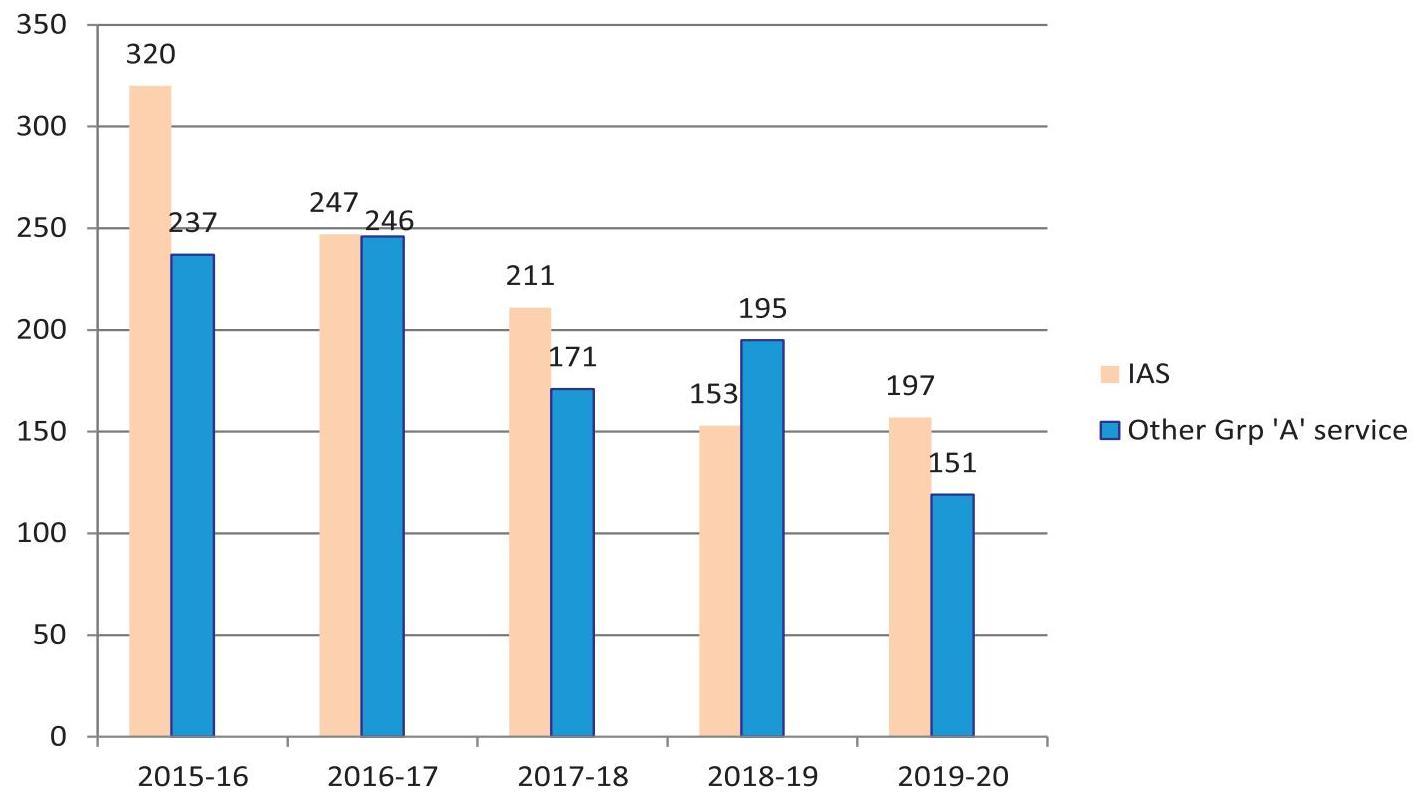
Figures for 2015-16 are up to 31/12/2015, for 2016-17 are up to 31/12/2016, for 2017-18 are up to 30/11/2018, 2018-19 are up to 31/3/2019 and 2019-20 are up to 31/12/2019.
CENTRAL DEPUTATION RESERVE
6.5 The Establishment Officer (EO) Division in the Department of Personnel & Training maintains an electronic database of the IAS officers \& of Group ‘A’ service officers working at the Centre under the Central Staffing Scheme. These records are maintained on the basis of orders/ letters/notifications issued by the DOPT, various Central Ministries/Departments and the State Governments. The maintenance/updation of this database is significant, as it helps in providing
readily available digitized information in respect of all officers and also the processing of cases for foreign appointments/assignments and training etc.
6.6 The Central Deputation Reserve statement in respect of Indian Administrative Service summarizes the state-wise number of officers that are on central deputation vis-a-vis senior duty posts. It also indicates the number of officers presently on central deputation from each cadre.
CENTRAL DEPUTATION RESERVE FIGURES AS ON 01/01/2020
| Sr. | Cadre | Total Authorized Strength | Central Deputation Reserve | No. of Officers at Centre | Col. 5 as Percentage of Col. 4 |
|---|---|---|---|---|---|
| (1) | (2) | (3) | (4) | (5) | (6) |
| 1. | A G M U T | 403 | 87 | 35 | 40 |
| 2. | Andhra Pradesh | 239 | 52 | 12 | 23 |
| 3. | Assam Meghalaya | 263 | 57 | 28 | 49 |
| 4. | Bihar | 342 | 74 | 30 | 40 |
| 5. | Chhattisgarh | 193 | 42 | 8 | 19 |
| 6. | Gujarat | 313 | 68 | 22 | 32 |
| 7. | Haryana | 215 | 46 | 14 | 30 |
| 8. | Himachal Pradesh | 147 | 32 | 18 | 56 |
| 9. | Jammu & Kashmir | 137 | 30 | 11 | 36 |
| 10. | Jharkhand | 215 | 46 | 11 | 23 |
| 11. | Karnataka | 314 | 68 | 19 | 27 |
| 12. | Kerala | 231 | 50 | 19 | 38 |
| 13. | Madhya Pradesh | 439 | 95 | 26 | 27 |
| 14. | Maharashtra | 415 | 90 | 19 | 21 |
| 15. | Manipur | 115 | 25 | 12 | 48 |
| 16. | Nagaland | 94 | 20 | 8 | 40 |
| 17. | Odisha | 237 | 51 | 24 | 47 |
| 18. | Punjab | 231 | 50 | 13 | 26 |
| 19. | Rajasthan | 313 | 68 | 9 | 13 |
| 20. | Sikkim | 48 | 10 | 5 | 50 |
| 21. | Tamil Nadu | 376 | 81 | 25 | 30 |
| 22. | Telangana | 208 | 45 | 11 | 24 |
| 23. | Tripura | 102 | 22 | 9 | 40 |
| 24. | Uttar Pradesh | 621 | 134 | 33 | 24 |
| 25. | Uttarakhand | 120 | 26 | 7 | 26 |
| 26. | West Bengal | 378 | 82 | 9 | 10 |
| Total | 6709 | 1451 | 437 | 30 |
6.7 In addition to the appointments under the Central Staffing Scheme, 253 appointments as Chairman/ CMDs/MDs/Deputy Governor/ Chairman/Vice Chairman/Members/Executive Directors/Officers Employee Directors/Workmen Employee Directors/ Functional Directors/NonOfficial Directors were made on the Boards of Public Sector Undertakings and Banks/Financial Institutions during the period 01.04.2019 to 31.12.2019. During the same period, 273 appointments were made at the level of Chairman/ Financial Commissioner/General Managers equivalent/ Members/Additional Members/ Director-General in the Railway Board/Zonal
Railways/RCT and Promotion/empanelment was carried out for appointments to Higher Administrative Grade of ₹ 67,000-79,000/- and ₹ 75,500-80,000/- in various Group ‘A’ Services under the Ministry of Railways. Besides, 321 Officers were also approved during the above period for additional charge/current charge/ extension of tenure/non-extension of tenure/adhoc/rejection/termination of service of GM/DG/ VC/CMDs/MDs, Functional Directors, Non-Official Directors in PSUs/Banks/Financial Institutions, and the Ministry of Railways. Out of these 847 appointments/Additional charge, 55 are women officers.
NUMBER OF APPOINTMENTS TO THE POST OF CHAIRMAN-CUM-MANAGING DIRECTOR/MANAGING DIRECTOR ETC IN PSUs/BANKs
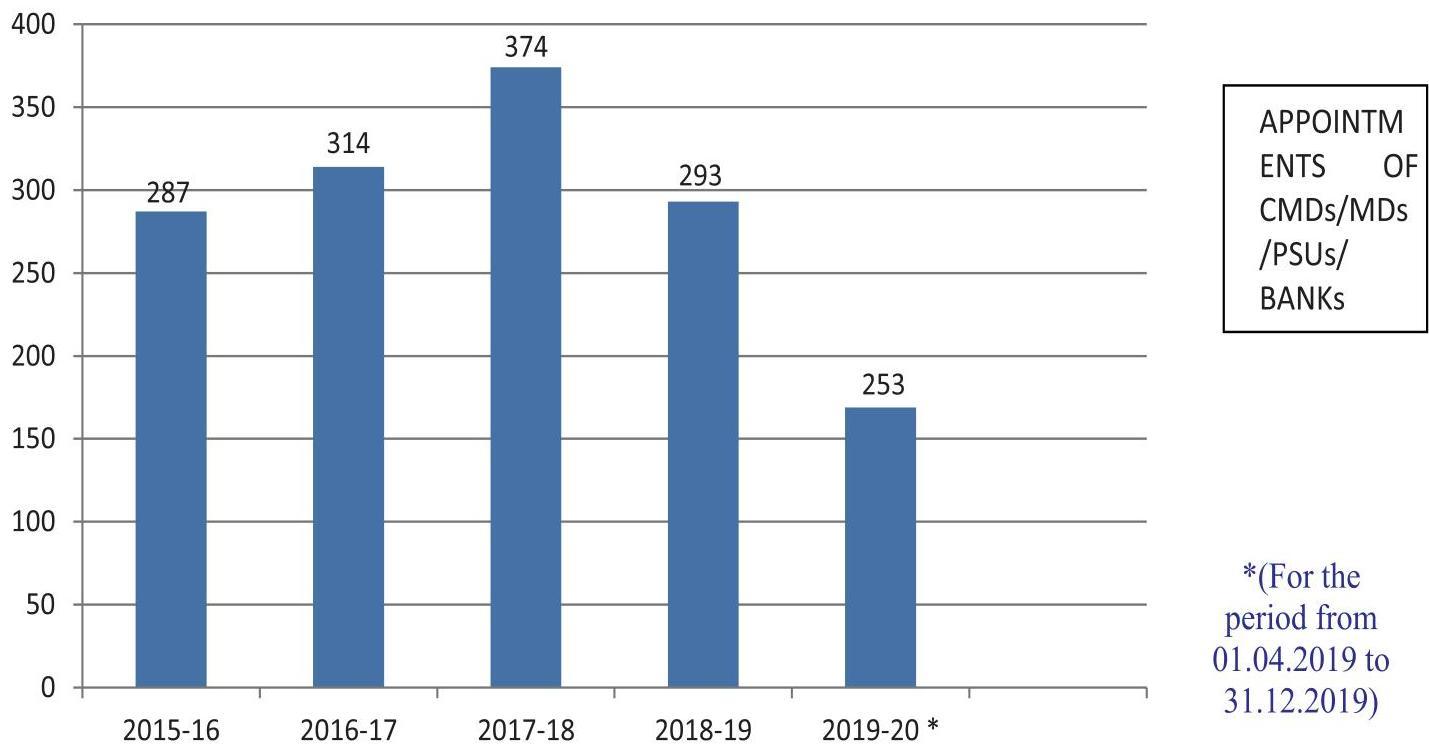
6.8 During this period 2019-20 (01.04.2019
APPOINTM
ENTS OF CMDs/MDs /PSUs/ BANKs to 31.12.2019) 110 Member/Chairman/Chief Executive Officer/ Advisor were approved for appointment in various Autonomous Bodies,
Administrative Tribunals, Labour Courts and Regulatory Bodies. Out of these, 09 are women officers.
6.9 A total of 2070 officers were approved for empanelment for promotion to posts of and above the level of Joint Secretary in various organized Central Services which are not included in the Central Staffing Scheme. Out of these 281 are women officers.
6.10 The Election Commission of India has provided the names of 313 (first half of the calendar year 2019) and 279 (second half of the calendar year 2019) IAS officers in the rank of Additional Secretaries and senior Joint Secretaries, drawn from the Central Ministries/ Department for appointment as Observer for General Election to the State Legislature.
Chief Vigilance Officer
6.11 During the year 2019-20 (up to 31.12.2019), 22 officers have been appointed as Chief Vigilance Officers (CVOs) in various organizations and 13 officers have been given additional charges of the vacant post of CVOs in various organizations. During the same period, 09 CVOs have been granted an extension of tenure after completion of initial tenure.
REPRESENTATION OF WOMEN
6.12 While taking up empanelment of officers to Joint Secretary rank, it is ensured that women get adequate representation.
6.13 A total of 65 women were appointed under the Central Staffing Scheme during the period from 1/4/2019 to 31/12/2019 including 45 women at Secretary/Addl. Secy. / Joint Secy. levels.
6.14 The appointments/ additional charge/ Extension of tenure /service as CMDs/MDs, Executive Directors, Functional Directors, Nonofficial Directors in PSUs/Banks, Financial Institutions, Railway Claims Tribunal (Indian Railways) include 55 pertaining to women during the above period.
6.15 A total of 281 women were approved for appointment to posts of Joint Secretary level and above in various organized Central Services excluding appointments under the Central Staffing Scheme.
6.16 9 women were approved for appointment as Member/Chairperson/CEO etc. in various Autonomous Bodies, Administrative Tribunals, Labor Courts, Regulatory Bodies etc.
TRAINING POLICY AND PROGRAMMES
MANDATE
7.0 The Training Division of the Department of Personnel and Training is the nodal agency for training of government functionaries and is primarily responsible for formulating policies concerning training. It also implements certain components of training directly. In the implementation of its mandate, the Division has set the following objectives:
- Administering Policy matters in training
- Identification of functional areas of training
- Designing and implementing training programs for officers involved in the priority development sectors
- Development of trainers and training capability
7.1 The ultimate goal of the Training Division is to attain “Training for All” which means that training would be imparted to all rungs of Civil Services starting from the lowest and cutting-edge to the highest in policy making.
Major Activities
1) Post Graduate Programmes in Public Policy/ Sustainable Development/Management
2) Mid Career Training of IAS Officers
3) Training Support (Training For All)
4) Intensive Training Programme
5) Comprehensive Online Modified Modules for Induction Training (COMMIT)
6) Augmentation of the Capacity of training institutions
7) Integrated Government Online Training (i-GOT)
8) Domestic Funding of Foreign Training (Overseas Training Programmes)
9) In-service Training of IAS Officers
10) Advanced Professional Programme in Public Administration (APPPA)
11) Posting of Probationary IAS Officers as Assistant Secretary in Government of India
Long-Term Domestic Post Graduate programmes in Public Policy and Management
7.2 Training Division, DoP&T are conducting the following 4 Long Term Domestic Training Programmes (LTDP) in Public Policy/Management/ Sustainable Development-
(i) Post Graduate Programme in Public Policy and Management (PG-PPM) at the Centre for Public Policy, Indian Institute of Management, Bangalore
(ii) One year Diploma Programme in Public Policy and Sustainable Development (PP & SD) or Two year M.A. (Public Policy and Sustainable Development) Degree Programme at the TERI School of Advanced Studies, New Delhi
(iii) Post Graduate Diploma Programme in Public Policy and Management (PGD-PPM) at Management Development Institute, Gurugram
(iv) One year Advanced Management Programme in Public Policy (MPPP) at Indian School of Business, Hyderabad/ Mohali
These programmes were envisaged to enhance the competence of Mid-Career Civil Servants in Public Policy and Management by –
(i) Broadening awareness of the latest trends in policy approaches,
(ii) Developing technical, analytical and leadership skills for public policy,
(iii) Providing opportunity in specialization and
(iv) Exposing them to alternative systems of public management in other countries.
During 2019-2020, 18 th Batch of Post Graduation Programme in Public Policy and Management (PGPPM) was conducted at Indian Institute of Management- Bangalore, which was attended by 19 participants. $4^{\text {th }}$ Batch of One-year Advanced
Management Programme in Public Policy (AMPPP) was conducted at Indian School of Business- Hyderabad/ Mohali, which was attended by 26 participants. $13^{\text {th }}$ Batch of Post Graduation Diploma Programme in Public Policy and Management was conducted at Management Development Institute- Gurugram, which was attended by 15 participants. $11^{\text {th }}$ Batch of Programme in Public Policy \& Sustainable Development (PP \& SD) was conducted at TERI University- New Delhi, which was attended by 14 participants.
Mid-Career Interaction between Armed Forces and Civil Services Officers
7.3 Mid-Career interactions between Armed Forces and Civil Services Officers are being organized at the Central Training Institutes/State Administrative Training Institutes and Defence Institutions in various parts of the country with the objective to benefit both the Armed Forces and Civil Services Officers by way of mutual learning from each other’s strength and also by imbibing the best points of each other’s work culture, ethos and customs. This, in the long run, is expected to help the participating officers to combat future challenges to national security in a better manner.
During the current financial year 2019-2020, 3 programmes have been conducted at Assam Administrative Staff College- Guwahati (DoP\&T), Maritime Warfare Centre- Visakhapatnam (NAVY) and College of Air Warfare- Secunderabad (AirForce) on the themes ‘Aid to Civil Authority’, ‘Coastal Security Organisation and Implementation’ and ‘Civil-Defence during Peace and War: The Challenges. The total number of participants in three programmes was 91.
Capacity Building Programmes for State Civil/Secretariat Service Officers of North Eastern Region
7.4 DoP&T has conducted one Capacity Building Training Programme of two weeks’ duration for the State Secretariat Service Officers of North Eastern Region States at Institute of Secretariat Training and Management (ISTM)New Delhi during the FY 2019-20, which was attended by 25 participants. The objective of this programme was capacity building, personality development and sensitization to national and developmental issues. The programme also covered inputs on Good Governance, Public Service Delivery, Project Appraisal \& Management and Public Private Partnership
Training Support under Central Sector Scheme “Training For All (TFA)”
7.5 The Central Sector Scheme of Training for All (TFA) sponsored by the Department of Personnel \& Training has been in operation since 1992. The objective of the Scheme is the capacity building of all government officials at National and State levels through training interventions to fulfil the mandate of the National Training Policy to provide training for all. Under the Scheme, various training programmes under the following components are undertaken:
State Category Training Programme
7.6 Under this programme, support is provided to State Administrative Training Institutes (ATIs) by way of sponsoring training programmes in the areas accorded priority by the Central Government. The programmes are designed to develop management skills and knowledge in different areas for senior and middle-level officers
of State Governments / State Public Sector Undertakings and State Autonomous Bodies, and also to sensitize the officers about new and important issues facing our society. The courses cover a large variety of subjects under broad thematic groups such as Ethics in Administration, Disaster Management, Right to Information, Gender Issues, Decentralized Planning, Role \& Responsibilities of DDOs, Financial Management, Environment \& Climate Change, e-Governance, Cyber Security, Leadership \& Team Building, Disaster Management \& Climate Change, Legal Literacy for Government Servants, Training in Administrative Vigilance, Public-Private Partnership, Revenue Resource Mobilization through VAT/GST/IT etc.
During the year 2019-20, this Department has sponsored 742 SCTP courses, with an expenditure of ₹ $8,35,67,500 /-$, to various State ATIs on several thematic subjects. As on $31^{\text {st }}$ March, 2020, the ATIs have conducted 537 programmes, covering around 17,000 employees.
Trainers Development Programme
7.7 Recognizing the importance of trainers in the training function, the Trainer Development Programme (TDP) was started in the early 1990s. Initially, faculty members of various training institutions were developed as Master Trainers and Recognized Trainers of various “Training of Trainers (ToT)” packages in collaboration with the Thames Valley University of U.K. Over a period of time, indigenous mechanisms were evolved for developing a cadre of professional trainers and resource persons in the country to create a cascading and multiplier effect. The programme has gone a long way in embedding the Systematic Approach to Training (SAT) into the process of
designing and imparting effective training to government officials.
Under the Trainers Development Programme, financial assistance is provided to State ATIs to develop a cadre of professional trainers and resource persons in various Training of Trainers (ToT) packages in the area of training techniques to create cascading and multiplier effect.
7.8 The following ToT programmes are sponsored under the Trainer Development Programme at various training institutions across the country:
Training Needs Analysis (TNA)
Design of Training (DOT)
Direct Trainer Skills (DTS)
Evaluation of Training (EoT)
Management of Training (MoT)
Experiential Learning Tools (ELT)
Mentoring Skills
Facilitation Skills
Introduction to SAT courses
The Department has so far developed a pool of 65 Master Trainers and 349 Recognized Trainers in different packages under this Scheme, who are called upon to conduct TDP courses organized by various ATIs. During the year 2019-20, this Department has sponsored 133 TDP courses and as on $31^{\text {st }}$ March, 2020, around 89 courses have been conducted and around 1,600 employees have been trained under this programme.
Intensive Training Programme
7.9 Intensive training programme for frontline
functionaries of State Governments was initiated during the year 2008-09 on the advice of the erstwhile Planning Commission to replicate the robust models of training of frontline functionaries developed through externally aided projects during the $X$ Plan period. The focus of this programme is on demand-driven training of frontline personnel and is conducted in close coordination with line Departments by the ATIs. The Programme is undertaken to provide saturation training of frontline personnel manning the public service delivery chain, in sectors identified by States, in a specific geographical area of a State. This programme aims to impact upon functional knowledge, skills and attitudinal orientation of the frontline functionaries through appropriately designed training interventions to make public service delivery effective.
The intensive training programme is being implemented in most parts of the country and as on $31^{\text {st }}$ March, 2020 approximately 1,10,000 officials have been trained since its inception. Some of the sectors covered under the Programme include – Water and Sanitation, Public Health, Public Distribution System, Revenue, Integrated Child Development Services, School Education, Dairy Development, Registration, Social Welfare, Tribal Welfare, Police, Citizen Centric Delivery and Right to Public Services Act etc.
Induction Training Programme
7.10 National Training Policy (NTP) stipulates inter-alia that all civil servants, especially the front-line staff, will be provided with training, including training on soft skills, to equip them with the competencies for their current or future jobs at the time of their entry into service and appropriate intervals in the course of their careers,
so as to improve customer orientation as well as the quality of service delivery to the citizens. As per the mandate, the 12-Days Induction Training Programme (ITP) was launched for the newly recruited Group-B (non-gazetted) & Group-C cutting edge level State Government functionaries during the Financial Year 2014-15 by this Department with a view to develop generic and domain-specific competencies in cutting edge level functionaries for strengthening capabilities to improve the public service delivery mechanism.
The programme is implemented in the districts selected by the State ATIs according to their preference, where the newly recruited State Government frontline functionaries are available in large numbers. The programme covers those sectors/departments which have the maximum citizen interaction and are directly involved in the public delivery system. The Induction Training Programme includes training in 5-Days generic modules, 2-Days NGO \& field visit and Blood Donation Camp and 5-Days domain-specific modules.
As on $31^{\text {st }}$ March, 2020, the Programme has been implemented in 390 districts across all the States and UTs of Jammu and Kashmir, except Arunachal Pradesh, Bihar and other UTs.
Comprehensive Online Modified Modules For Induction Training (COMMIT)
7.11 A Blended Training Programme called Comprehensive Online Modified Module on Induction Training (COMMIT) has been conceptualized in the backdrop of the mandate of the National Training Policy, which stipulates that all civil servants from lowest level functionaries to the highest level will be provided training at the
time of their entry into civil service and mandates that priority will be given to the training of frontline staff, including training on soft skills, so as to improve customer orientation as well as quality service delivery to the citizen. This programme will supplement the existing 12-Day Induction Training Programme (ITP), launched in 2014-15 for newly recruited frontline state government functionaries to develop in them Generic \& Domain-specific competencies. The coverage of this new blended programme has the potential to cover as many as 3.37 lakh officials every year. With this programme, there would be a huge jump in the coverage of the participants in comparison to the existing 12- Day ITP under which only 10,000 officials are covered every year.
The programme is of 28 hours duration which includes e-Modules for 20 hours and face-toface classroom training for 8 hours. The 20 hours e-training would be imparted through specifically developed 12 Generic and 3 Domain-specific e-Modules. The modules on soft skills would be delivered as e-Modules and through face-to-face training, whereas the domain modules would be covered through e-Modules only. The programme is implemented through the State Administrative Training Institutes (ATIs).
The blended course allows officers and faculty to take advantage of the flexibility and convenience of an online course while retaining the benefits of the face-to-face classroom experience. The COMMIT is strategically aligned with the mission and goals of the 12-Days ITP to develop skills and attitude towards improving service delivery keeping the citizen at the core. The advantage of such a blended programme is the requirement of limited classroom space; to infuse new opportunities to
officers who have had limited or no training to build the requisite skills, knowledge and attitude; and offer the convenience of online learning combined with the social and instructional interaction that may not lend themselves to online delivery (e.g. motivational talk, understanding of the vision and proctoring assessments).
As on $31^{\text {st }}$ March, 2020, COMMIT programme has been implemented in 15 States covering around 1.85 Lakh employees of these State Governments.
Augmentation of Capacity of Training Institutions (ACTI)
7.12 Under this programme, support to the State ATIs is provided for augmenting infrastructure in the form of hardware, software and courseware, networking of training institutions and consolidating the training ware. The Training Institutes are also supported and encouraged for developing case studies, e-learning packages, training films, organizing workshops, special programmes, seminars etc. The funds are released to those ATIs who seek financial assistance for up-gradation of their training capacity.
As on $31^{\text {st }}$ March, 2020, under this Scheme, assistance to the tune of around ₹ 11.00 cr . has been provided to several State Administrative Training Institutes (ATIs) since the FY 2014-15.
Integrated Government Online Training (i-GOT) Programme
7.13 The vision of the Department of Personnel and Training includes revamping capacity-building framework, make capacity-building a lifelong learning process through digital delivery of training. The vision also includes fostering the feeling of pride and mutual loyalty among all Civil Services
through capacity-building measures.
In this connection, the Department of Personnel and Training has launched a new Integrated Government Online Training Programme (i-GOT) to augment the existing training mechanism with online module-based training coupled with certification. This will make training inputs available to Government officials on-site and on flexitime basis.
During 2019-20, the following six online courses have been made available under the MITx Micro Masters Programme, through Abdul Latif Jameel Poverty Action Lab (J-PAL), South Asia with the approval of the competent authority in DoPT: 1) The Challenges of Global Poverty, 2) Designing and Running Randomized Evaluations, 3) Data Analysis for Social Scientists, 4) Principles of Microeconomics, 5) Foundations of Development Policy and 6) Political Economy and Economic Development.
Three batches have already completed various courses. In addition, Online Certificate Course on ‘Relevance of Gandhi in the Contemporary World” under iGOT was also launched on 30.01.2020 by DoPT in collaboration with IGNOU and Gandhi Smriti and Darshan Samiti, Rajghat.
It is proposed to add more and more courses on iGOT platform to make it more useful. In this regard, various Workshops and brain storming sessions have been held with the stake holders. It is proposed to further strengthen the iGOT Programme. The iGOT 2.0 specifically aims a need-based capacity building of Civil Servants and aims to create a shared learning architecture that will facilitate government training institutions
to cross leverage courses, other learning resources and competency testing analysis. The iGOT 2.0 will be an evolving and scalable platform. The iGOT 2.0 comprises of 3 layers which come together to give the users and departments a seamless learning ecosystem.
Overseas Training Programmes
7.14 Department of Personnel and Training has been nominating officers for training programs abroad. In the past, these programs were funded by bilateral or multilateral assistance. However, over the years, this assistance had come down. Keeping in view the importance and benefits of providing international exposure to the officers, a scheme of Domestic Funding of Foreign Training (DFFT) was started in 2001. This covers both long term and short-term training in various universities/institutes in several countries. A scheme of “Partial Funding of Foreign Study” was also started in 2002-03 as another component of the scheme of DFFT. Under this scheme, the Government of India provides limited financial assistance to such officers who secure admission on their own in reputed universities and programs relevant to their present or future job context.
During the financial year 2019-20, as on $31^{\text {st }}$ March, 2020, 45 officers were nominated for long term foreign training programs and 247 officers were nominated under short term foreign training programs under the DFFT Scheme. Further, 13 officers have also been granted partial funding assistance under the DFFT Scheme. 07 officers have been nominated for various Knowledge Co-Creation Programs of Japan International Cooperation Agency (JICA) held in Japan under the Technical Cooperation Program of the Government of Japan and 02 officers have been
nominated for one year Masters Degree Course in School of Government under Young Leaders’ Program (YLP) at the National Graduate Institute for Policy Studies, (GRIPS) Tokyo, Japan from October 2019 – September 2020.
Scheme of scholarship by Private Foundation Trust
7.15 A scheme for the scholarship offered by private foundation/trust in top 10 ranked universities as per the world university ranking for officers of all the three All India Services has been approved by the Government. Funding under this scheme is available for pursuing programs in Master in Public Policy/Public Administration/ International Development and Master in Business Administration, subject to the eligibility conditions.
Under this scheme, ‘Desai Sethi Family Foundation’ has offered ‘Desai Sethi Family Foundation Fellowship’. On this, two fellowships/ scholarships are available for officers belonging to Indian Administrative Service, Indian Foreign Service, Indian Police Service and Indian Forest Service for pursuing a 2 year Masters program in Public Policy/Public Administration/International Development at Harvard Kennedy School, Harvard University. The funding is US$ 50,000 per officer per year. The guideline on the fellowship is available on the website of this Department.
One-week In-Service Training (IST) Programme for Officers of All India Services, those working under the Central Staffing Scheme and Officers of Central Secretariat Service (CSS) and Central Secretariat Stenographers Service (CSSS).
7.16 The Training Division sponsors ‘In-Service Training Programme’ of ‘one-week duration’ in
various ATIs/CTIs/ Premier Training Institutes in the country by inviting proposals from them on relevant themes. During the year (2019-20), 12 programmes conducted at 11 training institutions. These programmes provide middle and senior management level officers with an opportunity to update their skills in areas of their choice-in sectors, they are currently working in, or in an area, they are expected to work in near future, or in areas they feel they want to specialize in. These programs also provide a valuable platform for horizontal and vertical knowledge sharing.
7.17 The primary objective of the IST program is to sensitize the participants to national concerns and the values enshrined in the Constitution; to provide for the exchange of experience and adequate discussion on issues of values, ethics and attitudes; to make the participants more confident to face problems in their work areas and attempt solutions, and to train the participants to look at problems in an integrated manner and develop a systematic approach.
7.18 In the past, these programs have been offered in diverse and broad thematic areas: such as Administrative Law, Agricultural & Rural Development, Climate Change (preparedness), Competition Law (policy formulation), Corruption (eradication strategy), Education (reforms \& challenges), E-governance (opportunities \& challenges), Environment \& Natural Resource (management), Environmental Impact Assessment (development projects), Ethics (Public Governance and Administration), Financial Markets (regulation), Fiscal Policy (Macroeconomic Management), Governance (IT management and improving through accountability), Infrastructure (Finance), Innovations (public service), Land Acquisition
(rehabilitation \& resettlement), Leadership, Participatory Management (Community Mobilization), PPP (negotiating strategies and urban development), Procurement (procedure \& contracting), Project Analysis/Appraisal (risk analysis/management), Public Policy (management/governance), Quantitative Methods (management), Service Delivery (management), Social Policy (Governance), Social Sector (financing/marketing), Urban Development, WTO (basic/advance course), Citizen Centric, Cyber Crime, Stress Management, etc.
Advanced Professional Programme in Public Administration (APPPA) At Indian Institute of Public Administration, New Delhi
7.19 The Training Division has been sponsoring a ten-month Advanced Professional Programme in Public Administration (APPPA) at the Indian Institute of Public Administration (IIPA), New Delhi every year since 1975-76.
7.20 The objectives of this programme are to prepare the participants to make a greater contribution to better governance, develop attitudes that focus on citizen services and also to strengthen leadership qualities in the civil service. It provides an opportunity to the participants to analyze major contemporary issues in Governance, learn about recent developments in the social sciences and their application in administration; review their experiences by making a critical analysis of environmental and other factors, apply relevant concepts, skills and techniques relating to policy, behavioural and administrative sciences and to demonstrate their creative and analytical abilities individually and in groups. It also seeks to develop interpersonal skills and sensitiveness to the needs
of the people to make the administration more responsive and result oriented.
7.21 The course covers classroom studies relating to various facets of administration viz, Social, Political, Economic, Legal and Administrative Systems, Organizational Behavior, Social Science and Research Methods, Operational Research, Information Technology in Management and Financial Management. Participants are also required to conduct rural and urban field studies and prepare a project report and dissertation. They are expected to select an area for specialization relevant to their present and likely future assignments from following fields of study: Advanced Information Technology and MIS, Comparative Development Experience, Project Management, Constitutional Law, Disaster Management, Economics of Regulation, InterGovernmental Relations, Management Systems, Organizational Needs Analysis, Public Expenditure Management, Public Organizational Theory, TQM, Finance, Personnel, Corporate or Public Sector Management, General Administration, Planning and Rural Development etc.
7.22 The officer has to have at least 10 years of Group ‘ $A$ ‘ service and should be of the rank of Director/Deputy Secretary in the Government of India or holding an equivalent post are eligible for APPPA course. The Programme is also open for senior officers (Group ‘A’) from State Services. This 10-month programme includes three semesters, rural and urban field visits in India and a 10-day foreign study tour. In the $44^{\text {th }}$ APPPA Programme, the participants visited in two groups to the USA & Czech Republic and South Africa \& Spain. 40 participants attended this programme. The $45^{\text {th }}$ APPPA programme in this series commenced
from July 1, 2019, and is scheduled to end on April 30, 2020. 46 participants are attending this programme.
Posting of IAS Officers as Assistant Secretary in Govt. of India
7.23169 IAS Officers of 2017 batch were posted as Assistant Secretary in the Ministries/ Departments of Government of India from $1^{\text {st }}$ July 2019 to $1^{\text {st }}$ October 2019 on Central Deputation.
The objective of the Assistant Secretary Scheme is to provide exposure to the IAS officers to Government of India functioning. This exposure would help them acquire a national perspective and a deeper appreciation of the harmonization of diversities in national policies. This will sensitize them to the larger perspective (vision) of any policy \& programme of Government of India.
Important Desks related to policy, flagship programmes of the concerned Ministries/ Departments, etc. was assigned to the Assistant Secretaries. They worked on Desk Office pattern, initiated and disposed of files, the reports of which were submitted to DoPT periodically by concerned Ministries/Departments.
The Hon’ble PM addressed the Assistant Secretaries in the Inaugural Session at Parliament House Annex on the $2^{\text {nd }}$ July 2019 and in the Valedictory Session of Assistant Secretaries (IAS2017 batch) at DRDO Auditorium, New Delhi on $1^{\text {st }}$ October 2019. Interaction of these Assistant Secretaries was also held with President, VicePresident, Cabinet Secretary, etc. They also visited attached offices of the concerned Ministries/ Departments and undertook visits to waterstressed Districts/Block in Jal Shakti Abhiyan in
addition to the Desk work assigned to them.
Interactive sessions with Assistant Secretaries (IAS-2017 Batch) were organized by DoP&T, Ministry of Parliamentary Affairs, Cabinet Secretariat on different topics in which a large number of dignitaries / Head of Departments /Head of Organizations / Senior Officers participated. The Special Interactive Sessions were organized on Jal Shakti Abhiyaan by Department of Drinking Water and Sanitation and Gandhi Smriti and Darshan Samiti on “Life and Works of Mahatma Gandhi”.
The Assistant Secretaries had prepared presentations on the key learnings based on the work allocation. These presentations were shortlisted by a sectoral group of Secretaries and thereafter shortlisted by Cabinet Secretariat. The following top 8 presentations were presented before the Hon’ble PM in Valediction session:
(i) IDEX – Innovations for Defence Excellence by Ms Saumya Pandey
(ii) Transforming Aspirational District Programme – Technology-Driven Monitoring \& Management by Shri Divyank Singh
(iii) Single Window System by Shri Vishram Kumar Meena, Shri Vivek Kumar and Shri Pravimal Abhishek
(iv) Sahuliyat – 1.3 billion people, a thousand schemes, one platform by Shri Mirant J. Parikh
(v) Boondh Boondh se Vidyasagar by Ms Divya Murugesan
(vi) DIGI.PATH by Shri Himanshu Jain
(vii) CLSS Awas Portal (CLAP) by Shri Pratik Tayal
(viii) Domain e-Registry by Shri Sagar Setia
CHAPTER
TRAINING INSTITUTIONS
LAL BAHADUR SHASTRI NATIONAL ACADEMY OF ADMINISTRATION, MUSSOORIE (UTTARAKHAND)
Introduction
8.0 The Lal Bahadur Shastri National Academy of Administration (LBSNAA), Mussoorie is Government of India’s premier institution for the training of higher civil services in the country. The Academy imparts induction level and in-service training. A common Foundation Course is held for entrants to All India Services and all Group “A” services of the Union. The foundation induction training to regular recruits of the Indian Administrative Service (IAS) and members of the Royal Bhutan Civil Service (RBCS) is conducted. The Academy also conducts MidCareer Training Program (MCTP) for members of the IAS and Induction Training program for officers promoted to the IAS from State Civil Services, as well as workshops and seminars on various issues in public administration.
8.1 The Academy is presently headed by Dr Sanjeev Chopra, IAS (1985 batch, West Bengal cadre) as the Director. He is an officer in the rank of Secretary to the Government of India. The Faculty comprises a healthy blend of senior administrators, academicians and researchers. And the richness of their field experiences with strong academic achievements provides a stimulating atmosphere for learning.
LBSNAA commemorates its Diamond Jubilee
8.2 The Academy has recently completed six decades of its existence. After a series of events throughout the year, LBSNAA on $1^{\text {st }}$ September 2019 brought the curtains down on its $60^{\text {th }}$-anniversary celebrations. The occasion was graced by Dr Jitendra Singh, Union Minister of State (Independent Charge) Development of North Eastern Region (DoNER) and MoS PMO.
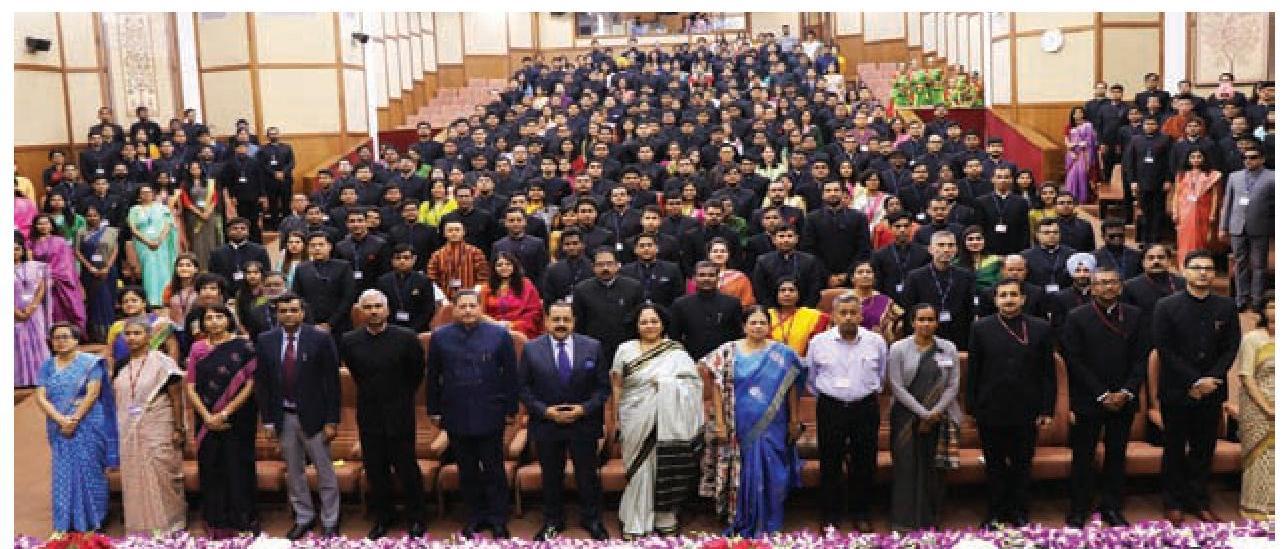
Dr Jitendra Singh, Hon’ble Minister of State for Personnel Public Grievances and Pensions with the Director of the Academy Dr Sanjeev Chopra and other faculty members during the $60^{\text {th }}$ Anniversary of LBSNAA
Induction Training Courses
8.3 The Academy conducts Induction training courses for direct recruits to the IAS and other civil services by UPSC as well as officers from state civil services promoted to the IAS.
Foundation Course (15 Weeks)
8.4 The Foundation Course is the flagship course of Induction training and is intended for the fresh entrant to the All-India Services, i.e. the Indian Administrative Service, the Indian Police Service and the Indian Forest Service, and the various Central Services (Group-A) of
the Union. It is a fifteen-week course conducted from August to December every year. The course aims at imparting basic understanding of the constitutional, political, socio-economic and legal framework of the country; and also fostering greater coordination among the members of the different public services by building esprit-de-corps with cultivating an attitude of co-operation and inter-dependence. This year total of 325 Officer Trainees including Eleven Officers from RBCS have participated in the $94^{\text {th }}$ Foundation Course organized from $26^{\text {th }}$ August 2019 to $6^{\text {th }}$ December 2019. The course was inaugurated by Dr Sanjeev Chopra, Director, LBSNAA.
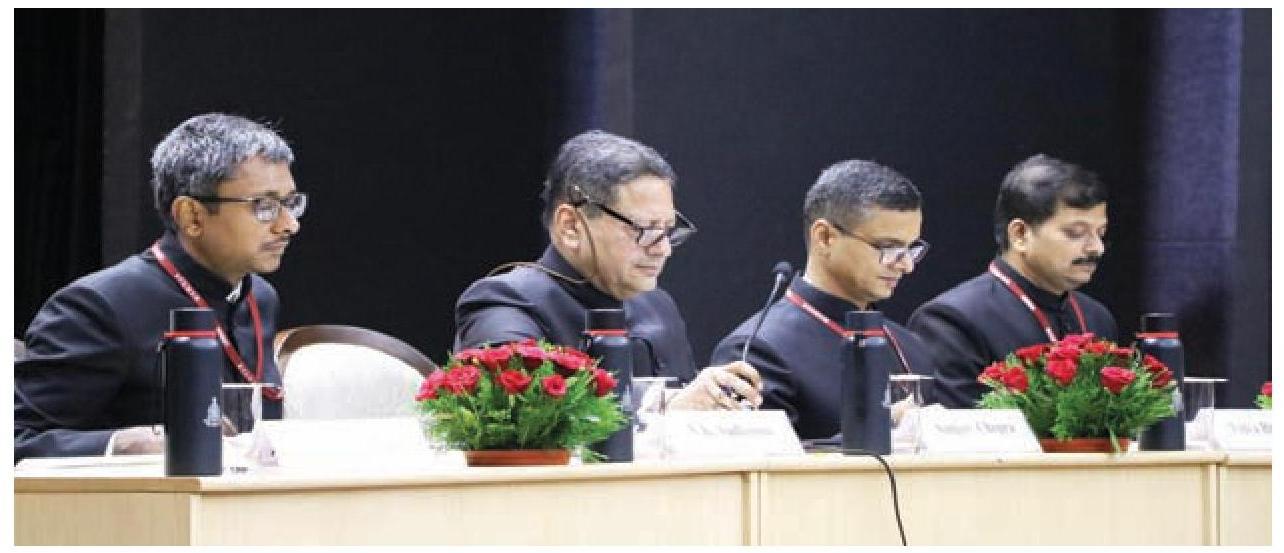
Inauguration of $94^{\text {th }}$ Foundation Course, 2019
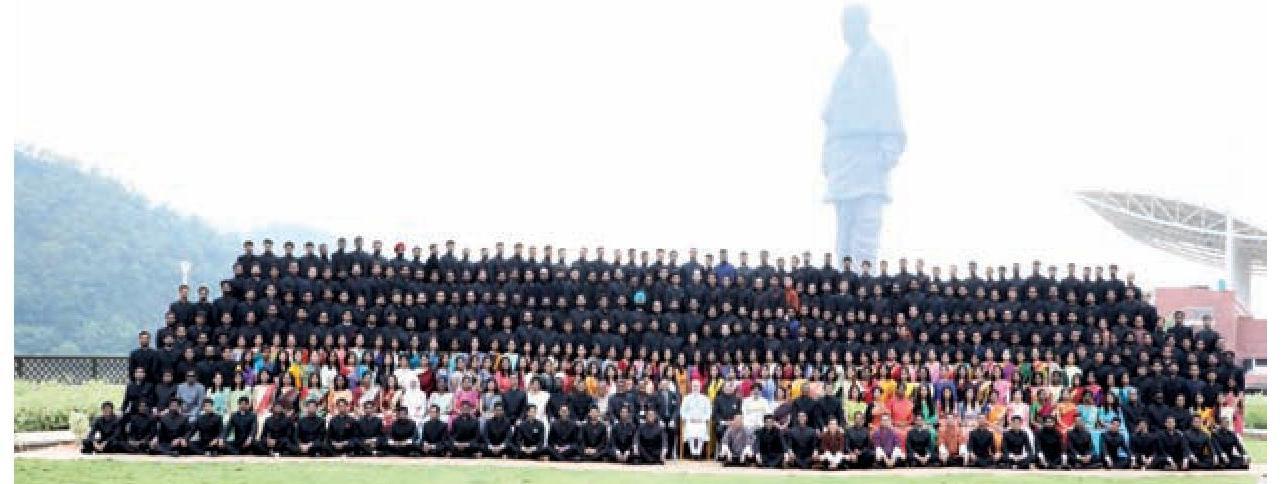
Hon’ble Prime Minister Mr Narendra Modi with Faculty members and Officer Trainees of $94^{\text {th }}$ Combined Foundation Course at Kevadia (Gujarat)
Common Foundation Course 2019
8.5 ‘AARAMBH’ 2019, the common foundation course for civil service probationers has been organized at the Statue of Unity at Kevadia, with 425 officer trainees. This was the first-ever of its kind common Foundation Course for civil service probationers. The theme was ‘How to achieve the goal of making India a 5 Trillion Dollar Economy’. The programme was inaugurated by World Bank president David Malpass on $28^{\text {th }}$ October 2019. He addressed the trainees at the event on the topic of ‘Capacity Building for Civil Servants’.
‘AARAMBH’ was concluded on October 31st 2019, being a fit tribute to the Iron Man of India on his birth anniversary, fondly celebrated as ‘Rashtriya Ekta Divas’. Prime Minister Narendra Modi addressed the probationers during the closing session on $31^{\text {st }}$ October. This program held in the lap of nature, under the stalwart statesman Sardar Patel’s statue is even more symbolic with the Civil Service Probationers imbibing the principles that Sardar Patel laid out for civil servants.
8.6 Major Activities
(i) Village visit presentation and Evaluation:
“Under the mentorship programme Nurture the Future, 425 civil service officials have been divided into teams to visit villages near Kevadia and each official has taken a youth under his wing and provided career and professional guidance. The probationer officials met local youth from 11 tribal villages.
(ii) Plenary session on philosophy of Sardar Vallabh Bhai Patel, the builder of Modern
India and its civil services.
(iii) Visit villages in Tribal areas to spend Diwali.
(iv) Session on Thinking Big and Doing Big: How the Statue of Unity was built
(v) Thematic Panel discussions on Agriculture & Rural Transformation, Wellbeing and Health, Inclusive Urbanization, Sustainable Resource Management and Jobs, skills and education, curated by the Academy with World bank.
(vi) IFTF Foresight Training for Indian Civil Servants with future thinking tools and practices.
(vii) Deeper insights into AI, Digital/ Disruptive/ Exponential Technologies including Machine Learning and their impact on society and governance with Singularity University.
(viii) Introduction to Exponential Technologies and Thinking in the context of India’s challenges and implications for the role of Civil Servants.
(ix) Artificial Intelligence, its application, future direction and it’s social, technical and ethical implications. Especially challenges and opportunities for India.
(x) Future of Data and Internet of Things (loT) Pros and cons, implications for the role of the civil servant.
(xi) Future of Manufacturing and logistics.
(xii) Exponential Leadership in the context of India’s challenges and criticalities to thrive in an exponentially changing world.
8.7 Other Activities
(i) Activities like Sharamdaan and exposure visit to National Institute for the Empowerment of Persons with Visual Disabilities (Divyangjan) (NIVH)/ Raphael Ryder Cheshire International (RAPHAEL) sensitized the officer trainees and gave them a synoptic view on the need for involved action and empathy. Gender sensitization and discussions on various aspects of exploitation were organized.
(ii) Extra-Curricular Activities are conducted in the afternoons and evenings to impart skills other than purely academic to the trainees in recognition of the need for an officer to have diverse interests and a well-rounded personality. Primarily, these include the celebration of India Day, Bhutan day (this year) and State Day mostly organized on Fridays to familiarize all OTs to the art, culture crafts,
handloom and cuisine of various states. Along with ECMs that provides an opportunity to learn new skills/games (Badminton, Baking, Calligraphy, horse Riding, Music, Painting, Swimming and Aerobics) which can be developed as a lifelong hobby.
(iii) AK Sinha One-Act Play Competition, Cross Country Run, Athletic Meet and Blood Donation Camp, Trekking and Village Visit Programme are some of the remarkable amongst other activities.
(iv) The clubs and societies are run by office bearers elected from among the OTs. They learn to work in groups and give valuable ideas in managing activities. A new club “Rahul Sankrityan” has been started this year to promote Hindi and Regional Languages. Sanskrit is being imparted from this year in addition to all regional languages.
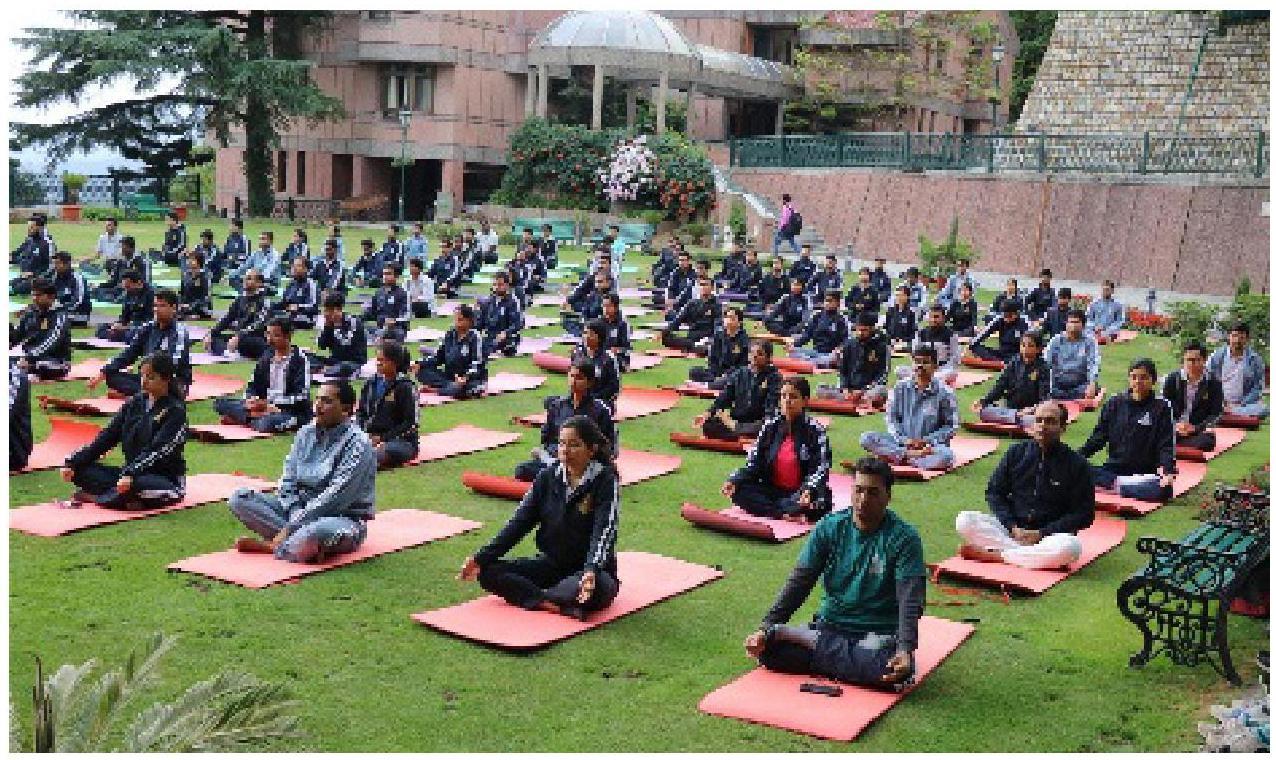
Yoga at the Academy on International Yoga Day on June 21, 2019
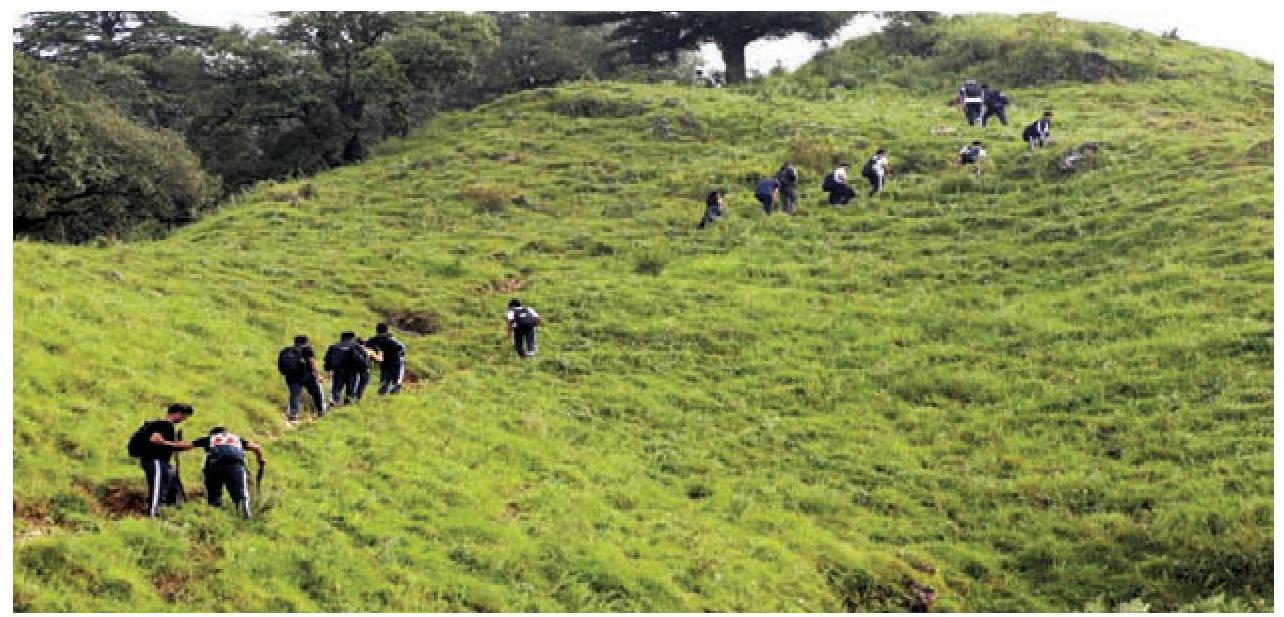
Trek during $94^{\text {th }}$ Foundation Course
IAS Professional Course Phase-I 2018 Batch (22 Weeks)
8.8 The IAS Officer Trainees of the 2018 batch (total 182 including 03 Officers Trainees from Royal Bhutan Civil Service) underwent the IAS Professional Course Phase – I from December 10, 2018, to May 10, 2019. This course aimed at developing professional skills in handling a large range of responsibilities that an officer shoulders within the first ten years of service. Emphasis was laid on understanding public systems and their management, together with a grounding in Public Administration, Law Economics, Management and Computer Applications. During the start of Phase – I, the Officer Trainees were sent on a 7 week Winter Study Tour (Bharat Darshan) to work in attachment with the three Armed Forces, Public Sector, Private Sector Units, Municipal Bodies, Civil Society Organizations and civil administration in challenging areas. Special focus on visit to places with traditional and modern water conservation practices was given. They were relieved on May 10, 2019, for their District Training as part of IAS Professional Course Phase – II.
District Training (53 Weeks)
8.9 During the year-long District Training, the IAS Officer Trainees learn about the various facets of administration at the district level. During this period they are under the direct charge of the District Collector in the State Government. They get an opportunity to obtain first-hand knowledge of the work of the Collector/District Magistrate and various other departments in the State government, along with orientation training at the State Administrative Training Institute. Most of the State Governments give them an opportunity of holding independent charge as Tehsildar, Sub Divisional Magistrate, Block Development Officer or Executive Officer in Municipal corporations. The 2018 batch of the IAS will return to the Academy for their Phase- II training commencing on May 18, 2020.
IAS Professional Course Phase-II 2017 Batch (06 Weeks)
8.10 While theoretical concepts are imparted in the Foundation and Phase-I courses, the ground level delivery mechanisms are expected to be imbibed by the trainees during District
Training. Phase-II is a time to debrief and share experiences and good practices from the various states. The course content of Phase-II is designed to consolidate the learning and assimilation of the district experience with the theoretical constructs taught earlier. A total of 178 Officer Trainees (including 3 Officer of Royal Bhutan Civil Service) underwent the Phase II course organized from May 20, 2019, to June 28, 2019. Upon completion of the Phase II course, the officers proceeded for 3 months deputation to the Government of India as Assistant Secretaries for the first-hand experience of Government of India functioning.
Induction Training Programme for officers promoted to IAS ( 06 Weeks)
8.11 The Academy also organizes Induction Training Programme for officers promoted to the IAS from the state civil services. This course aims to update levels of knowledge, skills and information and to provide opportunities for exchange of ideas, views and experiences with people who have
developed expertise in different sectors of national development. The underlying focus of the course is to provide the Induction Course participants with an all India perspective. The 121st Induction Training Programme held from July 08 to August 18, 2019 had 68 participants from 17 States. The programme aimed at training and sensitizing officers from the state civil services for the next level of governance and administration. The course included a Study Tour within India and to Seoul, South Korea to familiarize participants with various areas of governance. Participants were evaluated by mid-term exam, presentations, policy memo and on overall assessment based upon peer review, discipline and participation in the programme.
Besides LBSNAA, Mussoorie, another Induction Training Programme was organized at Mahatma Gandhi State Institute of Public Administration (MGSIPA), Punjab from $04^{\text {th }}$ November to $15^{\text {th }}$ December 2019 and 55 participants attended the said training.
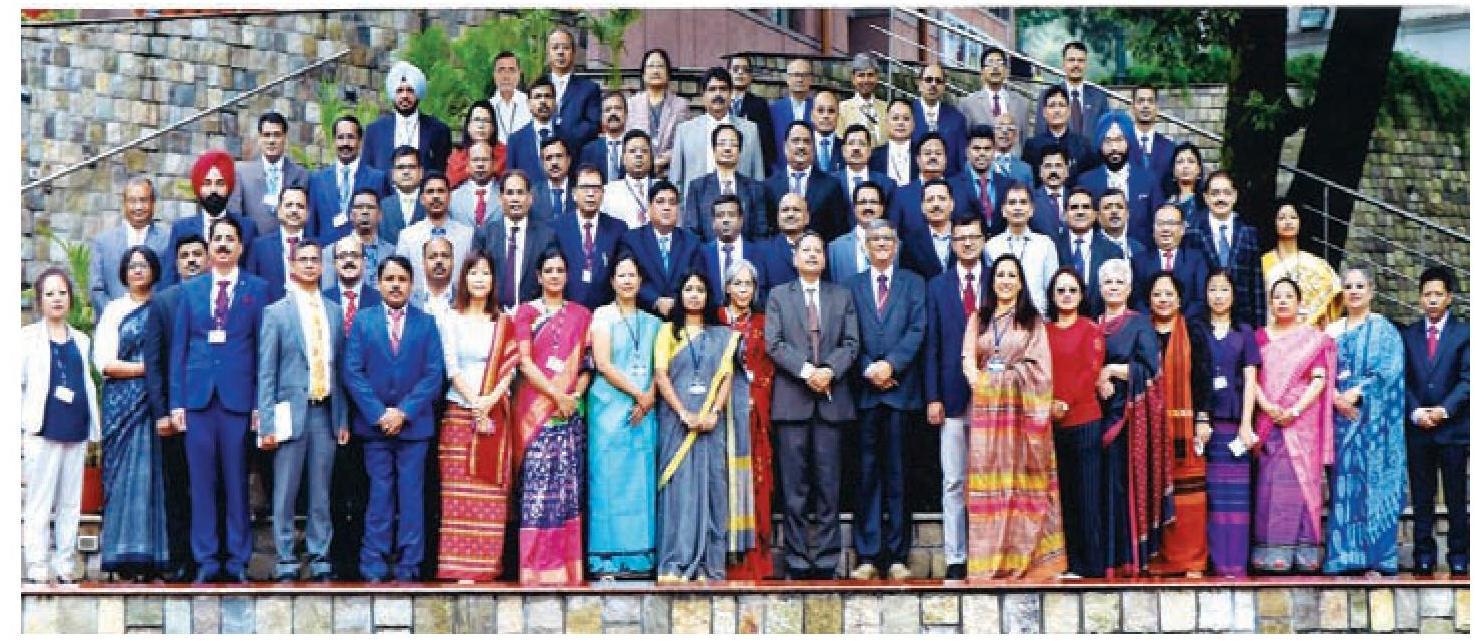
Group Photo of officers from State Civil Services promoted to IAS (121 st ITP)
Mid Career Training Programme (MCTP)
8.12 The Mid-Career Training Programme (MCTP) of IAS officers was introduced in 2007. The objective of MCTP was to equip officers to handle the next, higher level of responsibilities at certain identified stages of their careers; broadly when they have worked in the field for (7-9 years), at the policy formulation stage (14-16 years) and intersectorial policy formulation and implementation stage (26-28 years). Since 2010, the mandate for the design and delivery of these programmes has been devolved by the Government to the Academy. The MCTP was reviewed by the Government and
its duration was shortened. The revised courses are Phase III (4 weeks); Phase IV (4 weeks including 1 week Foreign Study Tour) and Phase V (3 weeks).
IAS Phase III Course (14 th Round) – (4 Weeks)
8.13 The Phase III course targets the officers having 7-9 years of seniority. This year the 4 weeks course started from $8^{\text {th }}$ July to $2^{\text {nd }}$ August 2019. The focus of the course was on Reflections, Public Policy, Leadership, project appraisal, Negotiation and IAS in Perspective. A total of 89 participants underwent the training course.
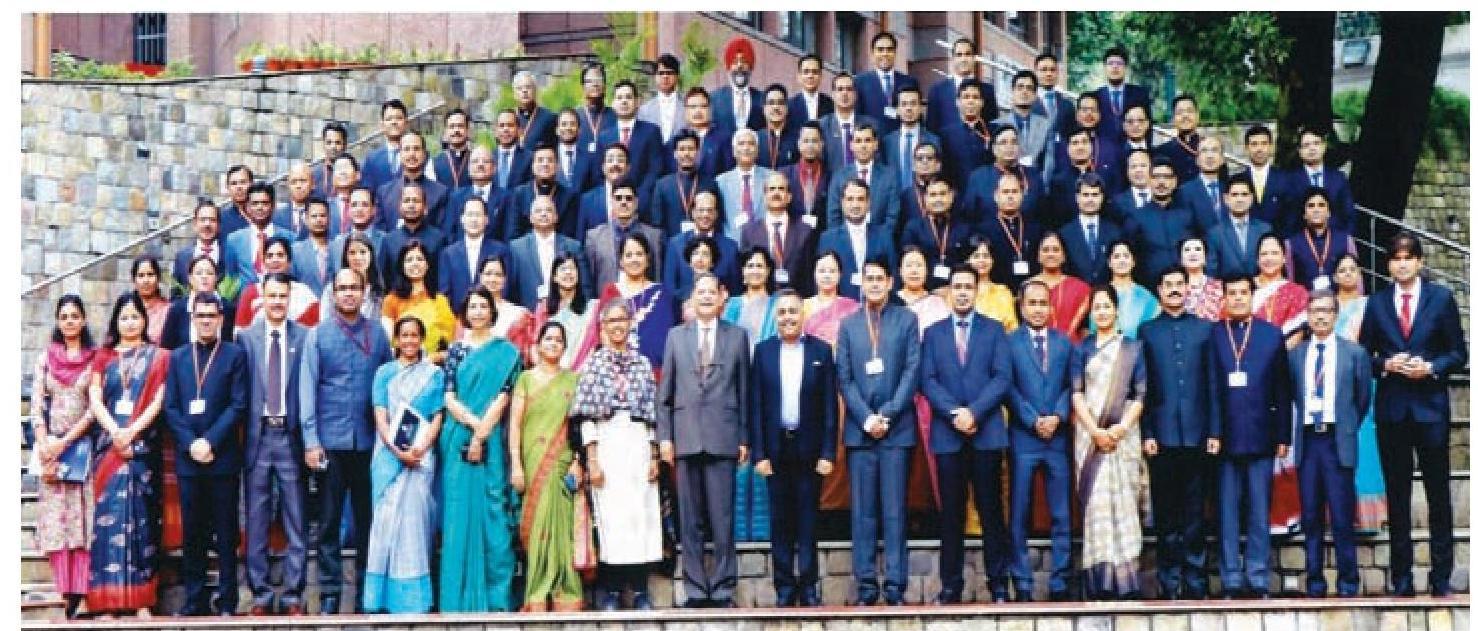
Group Photo of IAS Phase-III Course (14 th Round)
IAS Phase IV Course (14 th Round) – 04 Weeks
8.14 The Phase IV Course targets middlelevel officers (having 14-16 years of seniority) with a thrust on Public policy. Besides enhancing domain knowledge of the participants, especially in the realm of various aspects of public policy,
the Course also aims at broadening their perspective and developing soft skills. This year 78 participants attended the course organized from $04^{\text {th }}$ November to $29^{\text {th }}$ November 2019. The Course included a short Foreign Study Tour to the Syracuse University Maxwell School of Citizenship & Public Affairs, USA.
Phase V Course (14 th Round) – 03 Weeks
8.15 The Phase V Course aims at developing strategic leadership skills in senior-level IAS Officers (26-28 years of seniority) for effective
inter-sectoral policy formulation and strategic leadership in government. This year 66 officers underwent the training course organized at the Academy from $17^{\text {th }}$ June to $5^{\text {th }}$ July 2019.
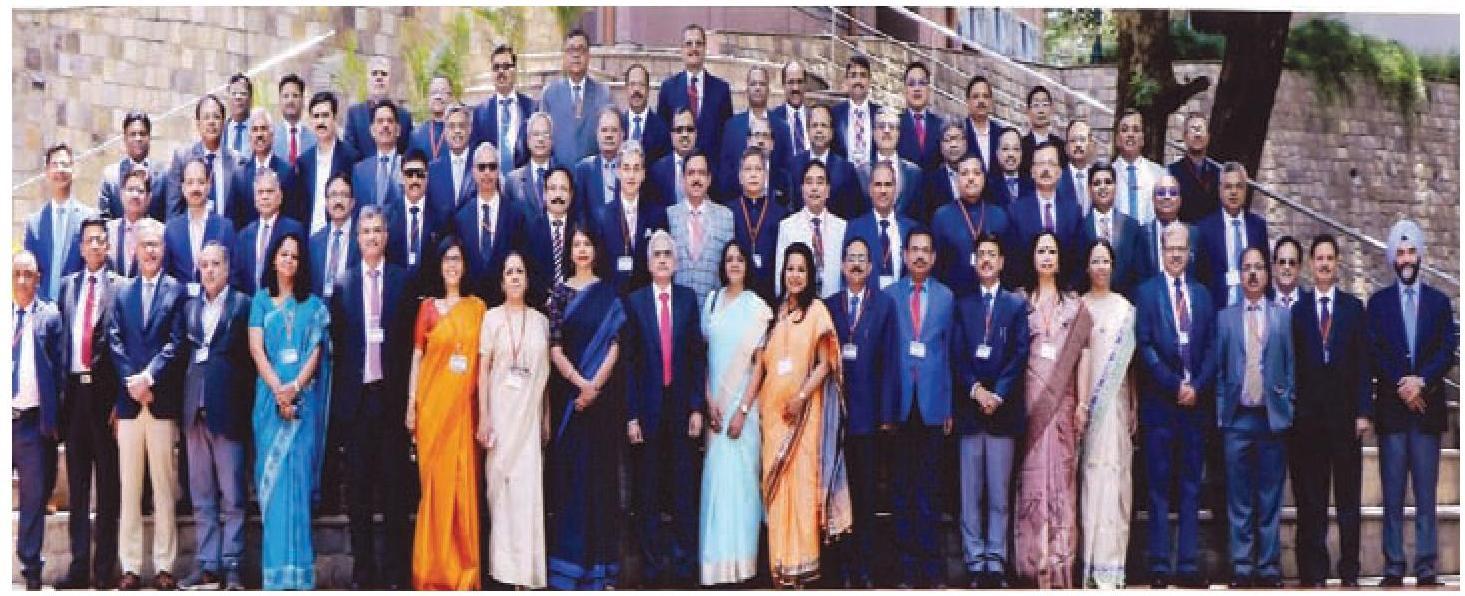
Group Photo of IAS Phase-V (14 th Round)
Other In-Service Training Courses/ Workshop/ Seminars
8.16 The Academy annually conducts short duration courses (ranging from one to two weeks) on a variety of subjects such as Joint Civil-Military Course on National Security, Courses on Gender, Disaster Management, etc.
Golden Jubilee Reunion
8.17 The Academy organizes a reunion every year for Officers who joined the service 50 years ago. The first was held in 1997, the Golden Jubilee Year of the new nation, where the ICS and IAS Officers, who were in service at the time of independence, participated. Since then, the retired officers are called every year for two-three days to share their rich experience with the faculty
and Officer Trainees. The Golden Jubilee Reunion for 89 officers of the 1969 batch (from various civil services who underwent FC at the Academy) was organized on May 30-31, 2019. The Reunion commenced with the inaugural ceremony on May 30, followed by a group photograph in the A.N. Jha Plaza. The participants were taken for a walk around the Academy campus before lunch and post-lunch there was a two-hour interaction with the Officer Trainees of the Phase-II 2017-19. The participants also had a session in small groups wherein they deliberated on issues of importance for the civil services in the present context before the Reunion comes to a close with the valedictory ceremony on May 31, 2019.
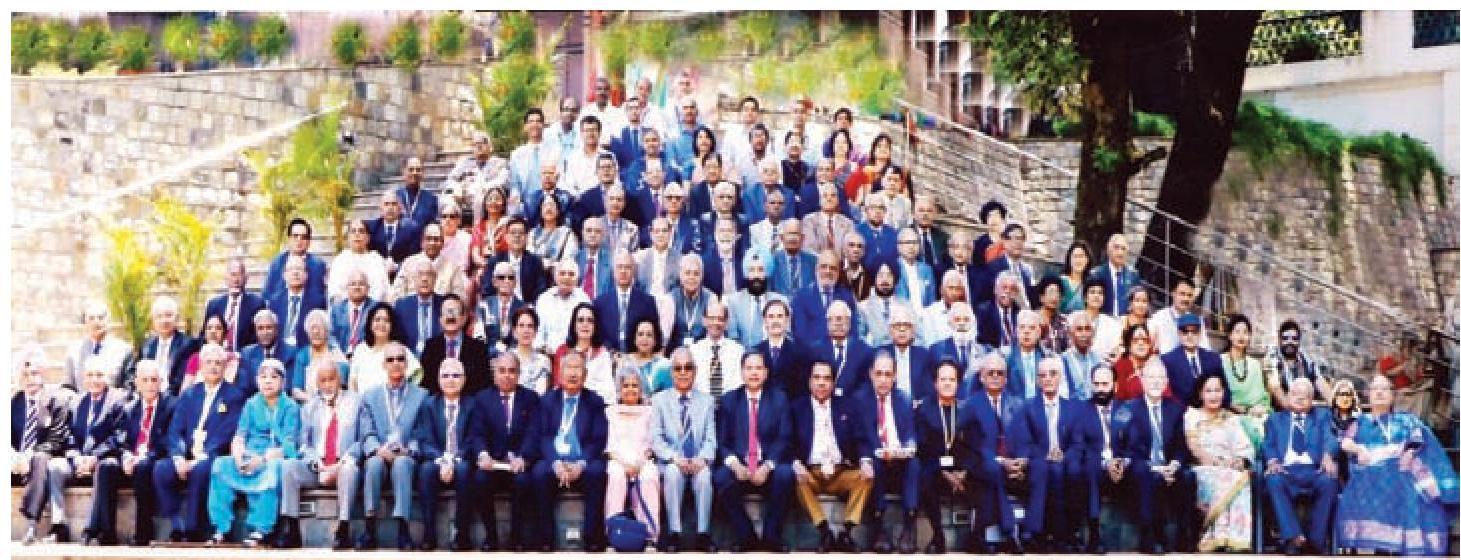
Golden Jubilee Reunion of 1969 Batch
Joint Civil-Military Training Program
8.18 The Joint Civil-Military Programme on National Security was initiated in the year 2001 following the recommendations of GoM on National Security pursuant to the Kargil Review Committee to foster structured interface between Civil Servants and Armed Forces officers for
a shared understanding of National Security. Participants are drawn from the Civil Services, Armed Forces, and the Central Armed Police Forces. In $25^{\text {th }} J C M$, from $24^{\text {th }}$ February to $01^{\text {st }}$ March 2019 and in $26^{\text {th }} J C M$ from $4^{\text {th }}$ August to $9^{\text {th }}$ August 2019, 34 and 44 officers underwent the training course respectively.
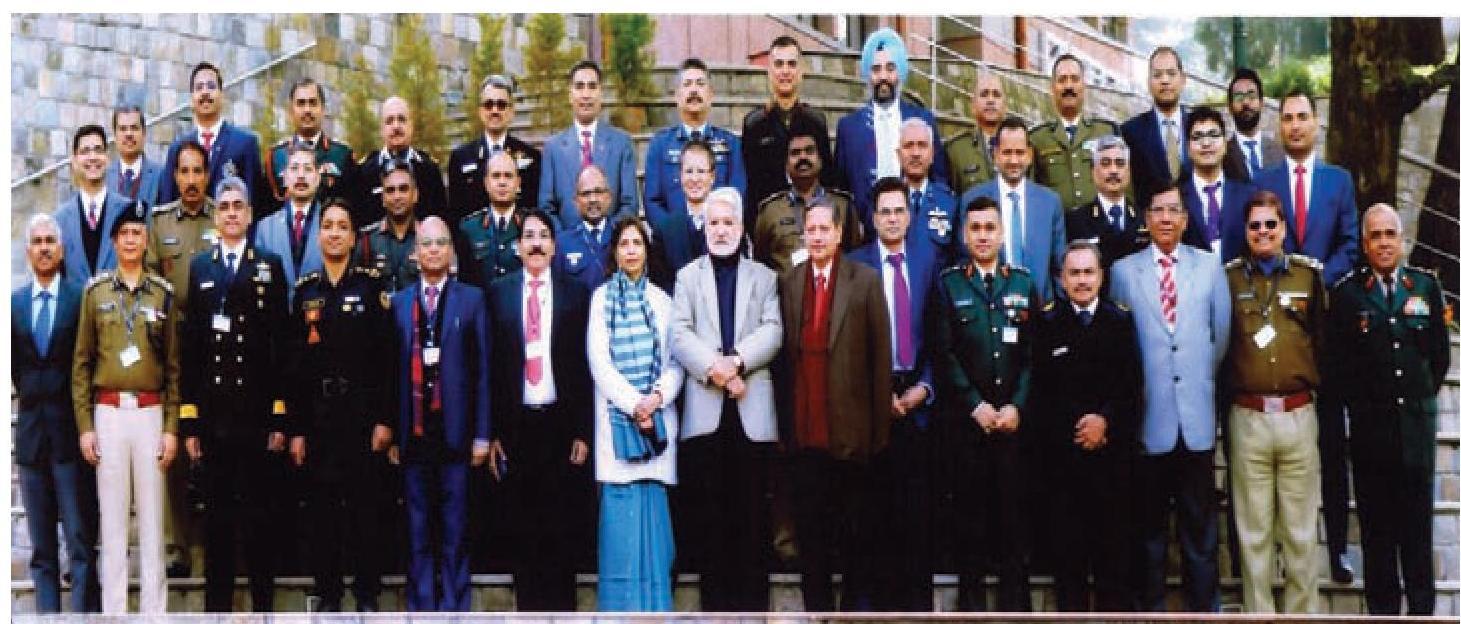
Group Photo of $25^{\text {th }}$ Joint Civil-Military Training Programme
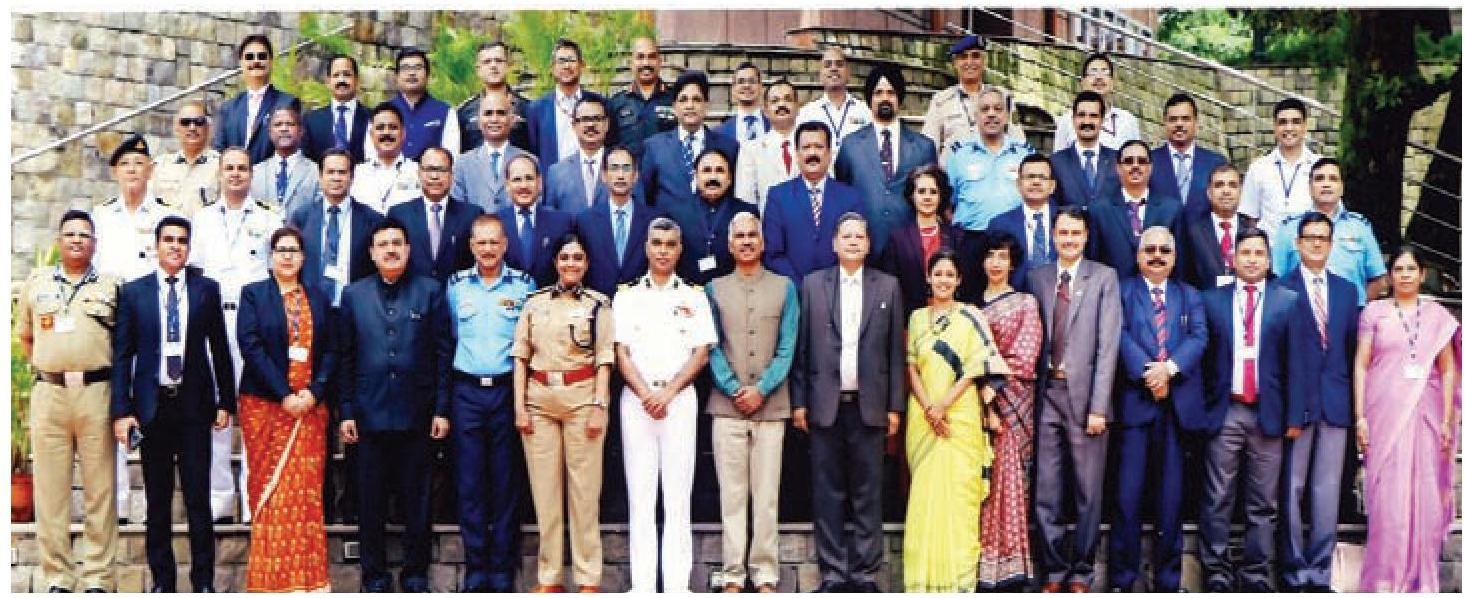
Group Photo of $26^{\text {th }}$ Joint Civil-Military Training Programme
Research Centres in the Academy
8.19 The centres of the Academy have been established to provide an avenue for initiating research in key areas of governance both from the policy as well as its implementation perspectives. The research is supposed to feed into the training curriculum and provide it with fresh insights. These centres (like BNYCRS) are mostly funded either by line ministries or are self-sustaining like the NGC and CDM and collaborate with various national and international funding agencies. Various Research Centers have been set up for undertaking action-research on domains linked to the Academy’s mandate and to feed into training inputs.
B. N. Yugandhar Centre for Rural Studies (BNYCRS)
8.20 The Centre for Rural Studies has been renamed as B.N. Yugandhar Center for Rural Studies in memory of Late Shri B.N. Yugandhar. BNYCRS was registered as a scientific training
and research society under the Indian Societies Registration Act 1860 on $1^{\text {st }}$ May 2015. The Ministry of Rural Development, Government of India has been supporting BNYCRS in its endeavours by providing regular finances since 1989.
8.21 Major Activities in 2019 -2020
(i) BNYCRS had finalized the 71 villages to conduct the village visit programme for officer trainees of the $94^{\text {th }}$ Foundation course.
(ii) Village Study Assignment for IAS Professional Course Phase-II
(iii) Longitudinal Study: Centre conducted a longitudinal study in 114 villages
(iv) Research Studies
a. Status of Implementation of the Scheduled Tribes and Other Traditional Forest Dwellers (Recognition of Forest Rights) Act, 2006, Amendment Rule, 2012 in the States of Himachal
Pradesh, Jharkhand, Maharashtra and Odisha.
b. Land Dispute Redressal: A Plea for Reforms
c. The Right to Fair Compensation and Transparency in Land Acquisition, Rehabilitation and Resettlement Act, 2013 (RFCTLARR Act, 2013) and other Acquisition Acts: Issues in Implementation, Divergence and Convergence
d. International Journal on Land and Rural Studies is issued every halfyearly (Print 2321-0249 and Online ISSN: 2321-7464). It carries special articles, policy briefs, working papers and book reviews. [July 2019 issue (7.2) – published]
Centre for Disaster Management (CDM)
8.22 Centre for Disaster Management (CDM) is a research and training centre, established in the year 2003 under the umbrella of Lal Bahadur Shastri National Academy of Administration. It was registered as a society in 2007 (Reg.No-199/20072008 Dt. 26-05-2007). The CDM is a Nodal agency for training in Incident Command System (ICS). The Centre is involved in training/capacity building of officers belonging to the IAS and other Group A civil services at induction as well as at in-service level in various aspects of disaster and emergency management through Classroom sessions, Case Studies, Experience Sharing Presentation, Panel Discussions, Workshops, Mock Drills, Scenario Building Exercise and Short film/Documentary. Apart from conducting training programmes on Fire
Safety, Search and Rescue, IRS, DDMP, School Safety, the centre is involved in various types of documentation/preparation and publication activities in terms of case studies, documentation of best practices, research papers, books and posters in national and international journals and many IEC training modules annually in the area of Disaster and Emergency Management and Science and Technology.
CDM is well equipped with GIS Software’s and conducted many activities related to GIS-based risk assessment and risk Mapping, besides this CDM is also providing training on GPS in terms of acquiring field level GPS points and mapping of these points through GIS Software. The centre is also equipped with wireless and HAM radio equipment for a robust communication network.
8.23 Training programmes conducted by the centre in 2019 -2020
(i) Incident Response System: (13-14 June 2019) for IAS.
(ii) Role of Technology in CommunityLevel Disaster Mitigation for Scientists & Technologists (19-23 August 2019)
(iii) Role of Technology in CommunityLevel Disaster Mitigation for Scientists \& Technologists: (04-08 November 2019)
(iv) Disaster Management Plan ( from 9-12-2019 to 10-12-2019)
(v) National Disaster Management Plan (from 16-12-2019 to 17-12-2019)
National Gender Centre (NGC)
8.24 The Centre was established in 1995, with the foremost aim of mainstreaming gender and
child rights in policy, programme formulation and implementation in Government. NGC is a capacitybuilding centre under the aegis of the Academy, driven by the mandate of gender mainstreaming and its commitment to build synergies with different institutions, working on gender equality, child rights and women’s empowerment.
8.25 Programmes conducted by the centre in 2019 – 2020
(i) Workshop on Stepping up to India’s Nutrition Challenge: The Critical Role of District Administrators (from 13 -15 February 2019)
(ii) Workshop for State Commissions for Women (from 19 – 21 June 2019)
(iii) National Consultation on Child Budgeting (from 24 – 26 June 2019)
(iv) Workshop for State Commissions for Women (from 29 – 31 July 2019)
(v) Consultation Workshop for Developing a Nutrition Training Roadmap for Administrators across India (from $08^{\text {th }} & 09^{\text {th }}$ August 2019)
(vi) India Flagship Course on Health System Strengthening and Sustainable Financing (from 19 – 23 August 2019)
Centre for Public Systems Management (CPSM)
8.26 The Centre for Public Systems Management was set up in 2016 by reconstituting the existing National Centre for Sustainable Community Systems (NCSCS) for more broadbased coverage of issues in public systems and their management. Four centres are functional
under the aegis of CPSM:
- $\quad$ Centre for Cooperatives and Rural Development (CCRD)
- $\quad$ Centre for Self Development Groups (SDGs)
- $\quad$ Centre for Food Planet and Health
- $\quad$ Centre for Corporate Social Responsibility (CSR)
8.27 The following programmes conducted in 2019 – 2020
(i) Faculty Development Program on “Public Procurement” $27^{\text {th }}$ January to $30^{\text {th }}$ January 2019
(ii) Training of Trainers on “Project Management” $31^{\text {st }}$ January 2019
(iii) The Policy Retreat – Three Day policy retreat for developing strategies and implementation plan for Education Quality Upgradation and Inclusion Programme (EQUIP) (22 nd April to $24^{\text {th }}$ April 2019)
(iv) “Co-Creating- cross-sectoral collaboration” Orientation Program for NITI Aayog Officers (24 $4^{\text {th }}-26^{\text {th }}$ May 2019)
(v) Workshop/training programme on “Alternative Dispute Redressal Mechanisms” collaboration with Nani Palkhivala Arbitration Centre (NPAC) ( $06^{\text {th }}-07^{\text {th }}$ June 2019)
Facilities at the Academy
8.28 The Academy is well-equipped with good training infrastructure in terms of academic buildings, classrooms, hostels and other support infrastructure. Some of the key infrastructure
facilities are given below:
Academic & Administrative Blocks
$\checkmark$ Karmashila
$\checkmark$ Dhruvshila
$\checkmark$ Gyanshila
$\checkmark$ Aadharshila
Gandhi Smriti Library – stocks 1.71 Lakh books, 279 journals/ magazine/ Newspapers and 7 e-resources databases
Officers Mess – can cater around 500
persons at 3 locations
Sports – well-equipped Officers Club, Riding Ground and Shooting Range
Health – well-equipped Medical Centre, AYUSH centre opening shortly
Executive Hostels – 4 executive hostels with 167 rooms
Officer Trainee Hostels – 3 hostels with 131 rooms
Wi-Fi campus
INSTITUTE OF SECRETARIAT TRAINING AND MANAGEMENT
Introduction
8.29 The Institute of Secretariat Training and Management (ISTM) is imparting training to the officers of the Central/State Governments, Public Sector Undertakings & Autonomous Bodies. Originally set up to conduct foundational and inservice training programmes for Assistants and Section Officers of the Central Secretariat, the range of the activities of the Institute has increased exponentially over the last seven decades. In addition to the in-house training programmes, the Peripatetic Training provided by the Institute to the officials of State Governments and Union Territories in Behavioral Skills, Management Techniques, Financial Management and Office Management, is of particular significance. On specific request from Central Government Departments, Autonomous Bodies, Public Sector Organizations, the Institute also organizes special programmes addressed to the specific customer needs in different areas.
From the year 2007-08, ISTM is also involved in the implementation of the Central Secretariat Service Cadre Training Plan (CSS-CTP) and from 2011 onwards Central Secretariat Stenographer’s Service Cadre Training Plan (CSSS-CTP), which envisages mandatory training programmes having linkages with career progression up to Director level officers.
Training Programmes
8.30 ISTM conducts the following programmes in various categories:
i. Foundational and in-service Courses conducted as per new CSS and CSSS Cadre Training Plan
ii. Induction Training for Group ‘A’ services of ICoAS, Director General Civil Aviation (DGCA) and CVOs of CVC
iii. Induction Training Component for various Group ‘A’ service like IAS, IFS, IRS, ISS, IES, ITS, ICLS, IDES, IIS \& IRTS probationers.
iv. Personnel Administration and Office Management
v. Financial Management
vi. Management Services
vii. Behavioural Training
viii. Training of Trainers, Master \& Recognized Trainers Development Programmes sponsored by DOPT
ix. Peripatetic Training Programmes
$x$. Right to Information
xi. Sexual Harassment of Women at Workplace
xii. Citizen-Centric \& Service Delivery Approach
xiii. Organization Specific Programmes/ Cadre Specific Programmes
xiv. Capacity Building Programmes for State Civil Services Officers and State Secretariat Service Officers of the North Eastern States sponsored by Department of Personnel \& Training
xv. Orientation Training Programmes on Office
Procedure for IAS Officers sponsored by DOPT.
xvi. Newly introduced training programme on Emerging Technologies in e-Governance
xvii. Three-day State Category Training Programmes (SCTP) sponsored by DoPT for Divyang Employees of Central and
State Government on Office Management, Computer Applications, Financial Management and Establishment Rules.
8.31 Number of Training programmes and Training weeks Planned & conducted during the year 2019-20)
Table 1
| Sr. No. | Programmes | No. of Programmes |
Training weeks |
|---|---|---|---|
| 1. | Number of programmes planned/scheduled during 2019-20 |
230 | 518 Weeks 1 day |
| 2. | Programmes Conducted during 2019-20 | 272 | 552 Weeks 3 Days No. of participants 7537 |
8.32 Other Non-Calendar Training Programmes
Table 2
| Sr. No. | Name of the programme | Number of programmes conducted during 2019-20 |
No. of training weeks and participants |
|---|---|---|---|
| 1. | CSS-CTP | 36 | 122 Weeks \& No of Participants -1715 |
| 2. | CSSS-CTP | 37 | 108 Weeks No of Participants-1117 |
| 3. | Calendared Courses other than CSS/CSSS-CTP |
112 | 102 Weeks No of Participants- 2519 |
| 4. | Organisation Specific Programmes/ Cadre Specific Programmes \& Peripatetic Training Programmes |
87 | 120 Weeks 03 Days No of Participants-2186 |
| Total | 272 | 552 Weeks 3 days No of Participants-7537 |
Consultancy Projects
ISTM is also engaged in the research and consultancy projects. The consultancy projects relating to the following Government Departments/
Organizations have been conducted / ongoing at present:-
(a) Consultancy work
(i) Recruitment Rules of Indian Institute of Food Processing Technology (IIFPT)
(ii) Work-Study of Andaman & Nicobar Administration, Department of Information Technology
(iii) Manpower study of Non-teaching cadres at the Indian Institute of Management Calcutta (IIMC)
(iv) Drafting of Regulations- Indian Institute of Management Calcutta (IIMC)
(b) Audit of proactive disclosure under RTI Act, 2005
(i) The audit of proactive disclosure under RTI Act, 2005 for 30-40 different Ministries/ Departments/UTs/ PSUs \& other autonomous bodies of Central Government is going on during 2019-20.
(ii) The audit of proactive disclosure under RTI Act, 2005 for 8 different Ministries/ Departments/UTs/ PSUs \& other autonomous bodies of Central Government are completed during 2019-20.
New Initiatives
8.34 Inclusion of additional module in Training Management Information System (TMIS)
The Training Management Information System (TMIS) project was initiated in the year 201112. TMIS has been evolved as a robust digital MIS and it is being continued to enable ISTM to establish a completely paperless system. Following works of TMIS are ongoing/ completed during 2019-20:-
(a) Standardization Testing and Quality
Certification (STQC) Audit of ISTM website www.istm.gov.in
(b) Automated System for course circulation generation
(c) Online Hostel Booking Module development
(d) Hostel Inventory Management module Development
(e) Development of Establishment Portal: Designing and Development of Establishment Portal of ISTM (Under process)
(f) Development of Gender Portal: Designing and Development of Gender Portal of ISTM (Under process)
(g) Development of Government Manpower portal at ISTM (Under process)
8.35 Special Training Programmes/Sessions/ Workshops/ Seminars
(i) International Yoga Day was celebrated in ISTM on 21.06.2019
(ii) Service Books of all employees of ISTM have been digitized and e-service Book made operational
(iii) A faculty seminar on “Meditation- Quality of Work Life” was organized on 08.06.2019, 11.06.2019 and 12.06.2019
(iv) A Seminar on “Healthy Life Style need of the Hour” was organized on 08.06.2019
(v) Soft copy of the updated reading material now provided to all the participants on their e-mail or pen drive.
(vi) Recognized Trainer Development Programme on Direct Trainer Skill and Design of Training (RTDP-DTS \& DoT) have been organized successfully at ISTM for Potential Recognized Trainers.
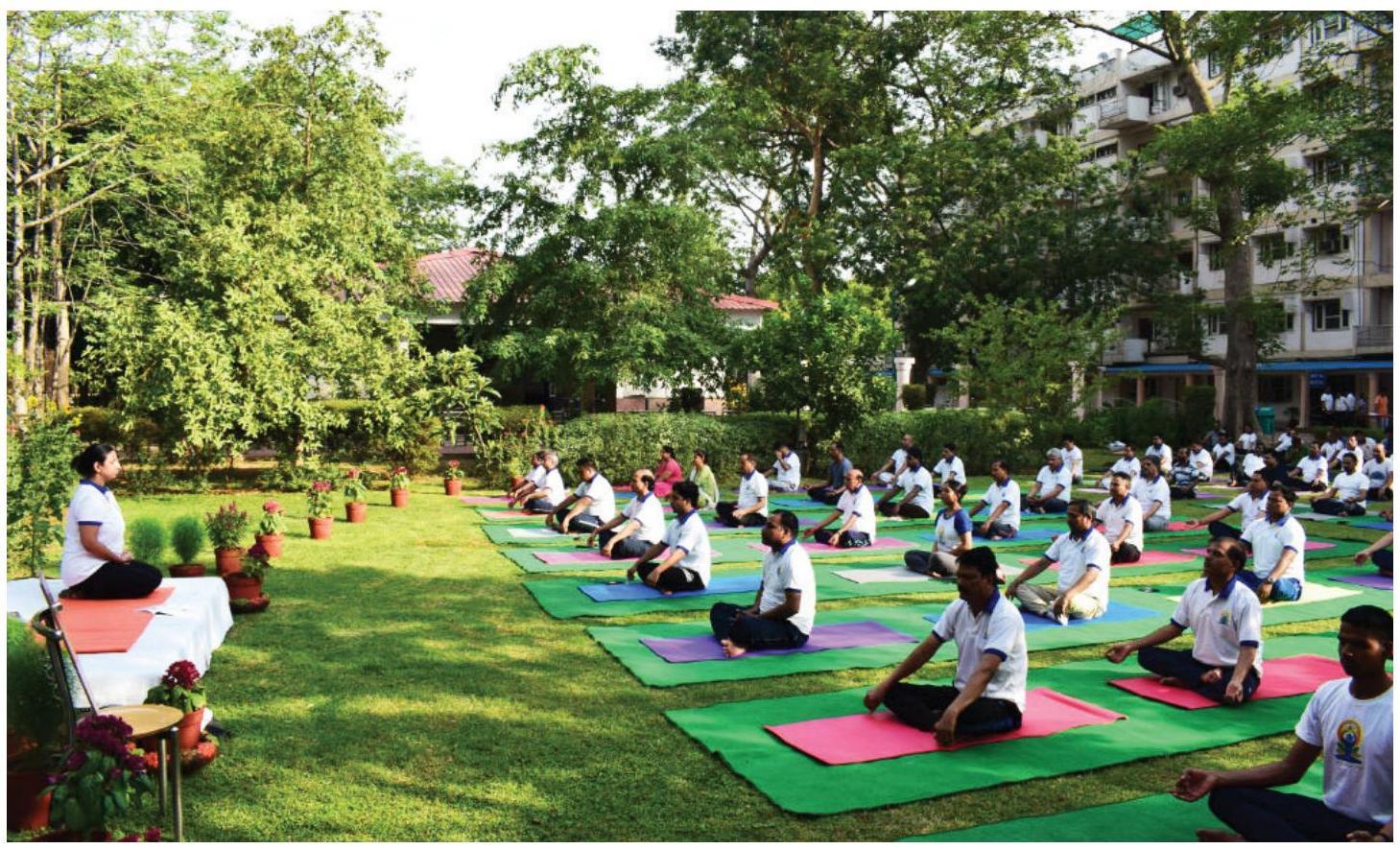
International Yoga Day Celebration (21.06.2019)
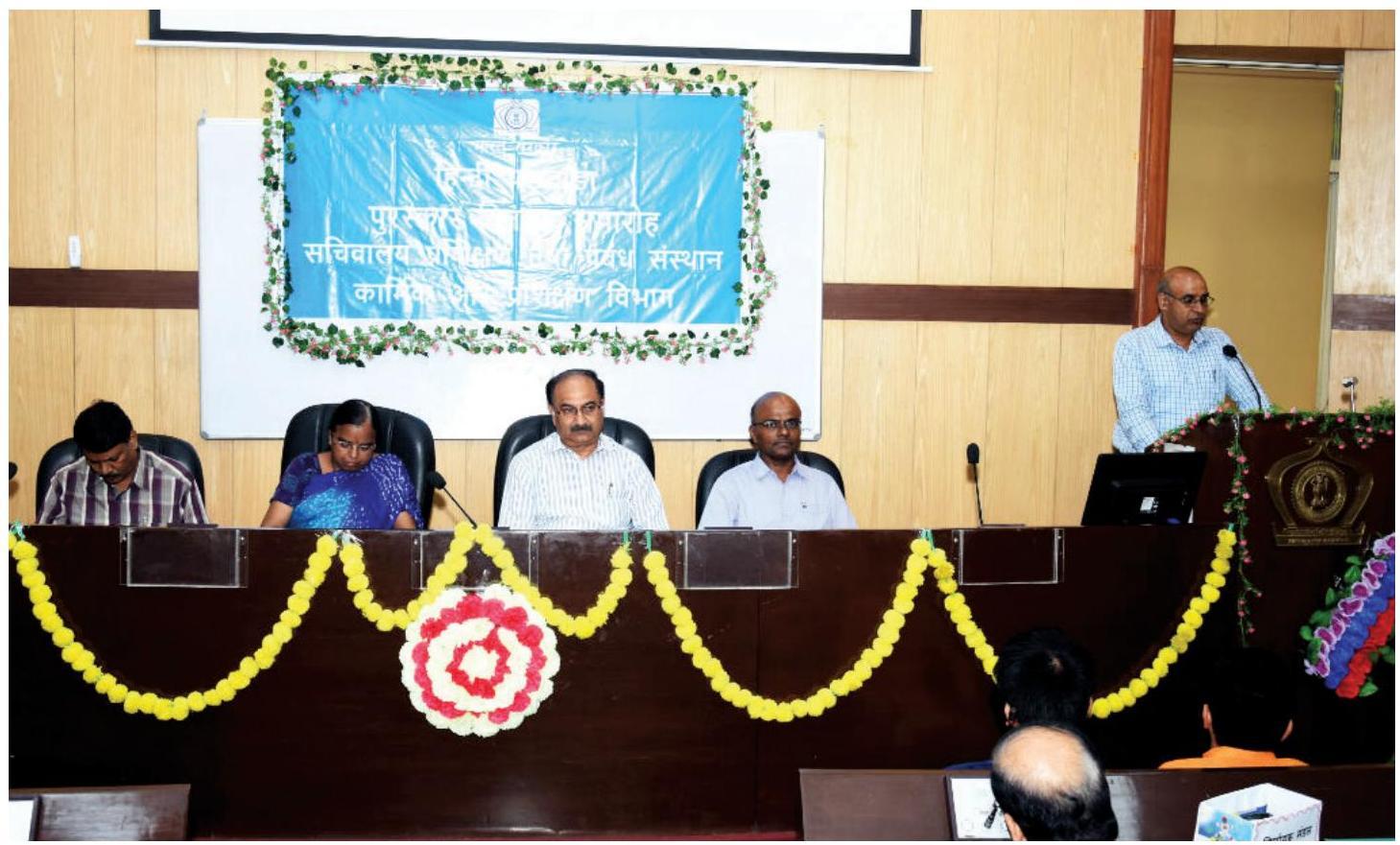
Hindi Maah Celebration on 20.09.2019
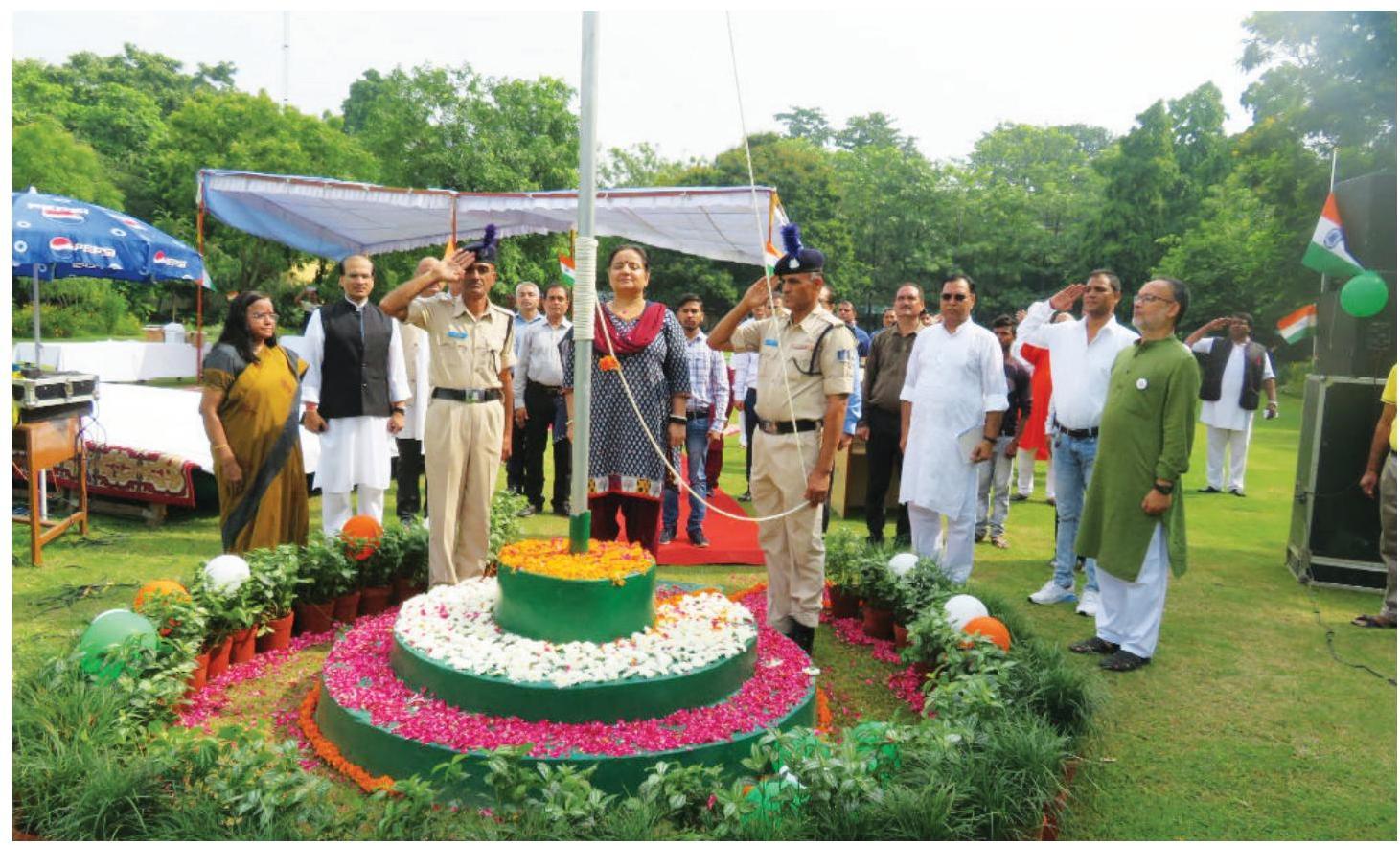
$70^{\circ}$ Independence Day Celebration 15.08.2019
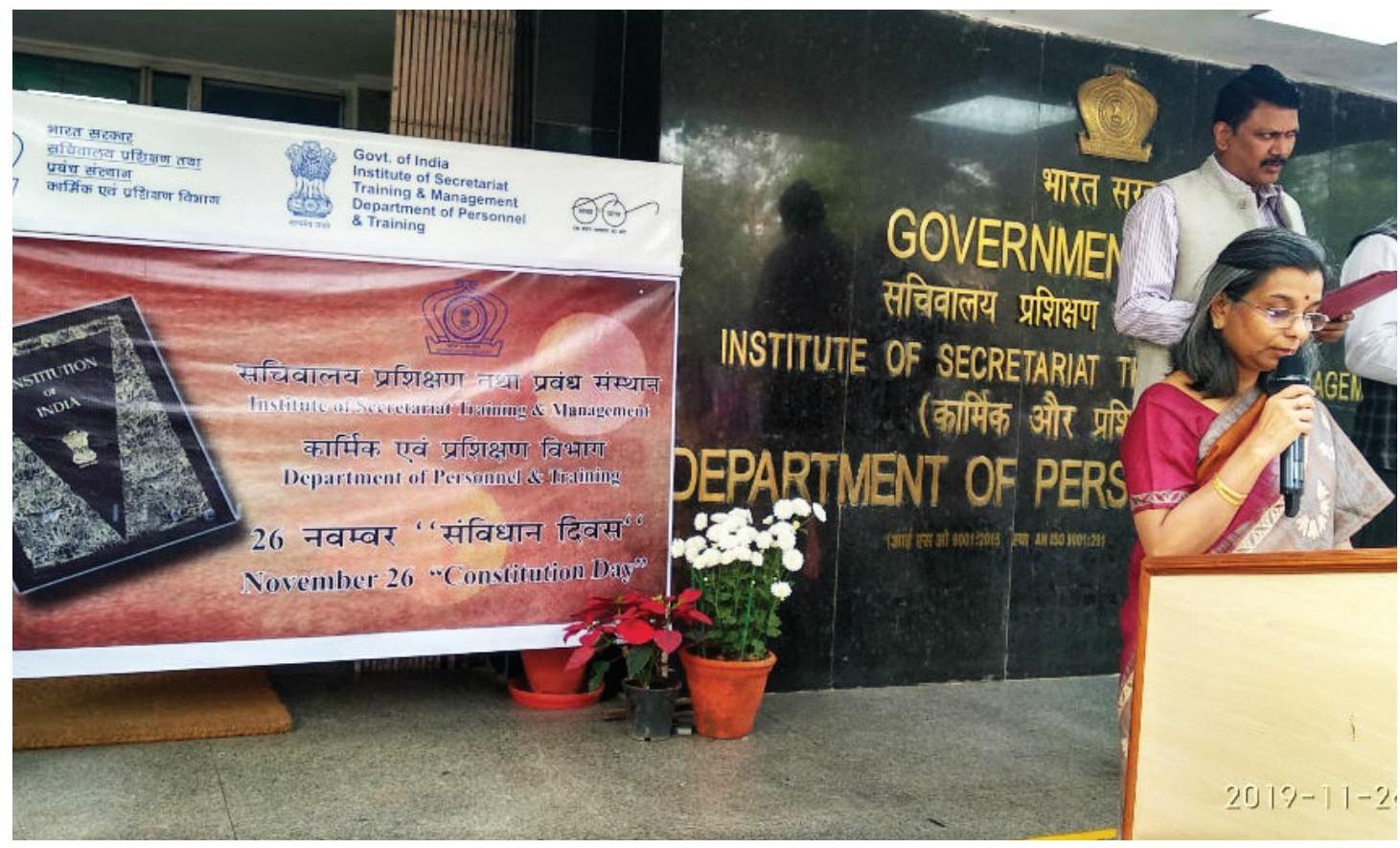
Celebration of Constitution Day on $26^{\text {th }}$ November 2019 at ISTM
8.36 New Initiatives in Training during the year 2019-20
(i) Development of five e-modules under process on the following subjects:-
- Administrative Vigilance
- Preventive Vigilance
- CGHS/ CSMA Rules
- Leave Rules
- LTC Rules
(ii) Assistant Section Officer (Direct Recruit) -Foundational Training Programme during 2019-20:- Total 360 ASO(DR) have joined foundation training programme [335 ASOs of CSS-CTP and 25 ASOs of Railway Board Secretariat Service (RBSS)] from $2^{\text {nd }}$ March 2020 and same has been conducted at four places as follows:-
| SI No. |
Name of Institute/ ATIs | No of Participants |
|---|---|---|
| 1. | Institute of Secretariat Training and Management(ISTM) |
173 |
| 2. | Haryana Institute of Public Administration (HIPA), Gurgaon |
48 |
| 3. | Mahatma Gandhi State Institute of Public Administration (MGSIPA), Chandigarh |
48 |
| 4. | Dr MCR HRD (MCRHRD) Institute of Telangana, Hyderabad |
91 |
8.37 New Training Programmes Introduced
(i) Workshop on Public Policy Formulation
(ii) Training Programme on Managerial / Supervisory Skills
(iii) Workshop on Policy Formulation and Legislation
(iv) Emerging Technologies for Governance
New topics Introduced
i. Handling Medical Emergencies
ii. Prohibition, protection and Grievances Redressal of Sexual Harassment of Women at the workplace.
8.38 Library Resources
ISTM has Library with all the modern facilities consisting of more than 17,450 books besides modest video collection. ISTM also subscribed to DELNET online services and provided access to faculty and staff members to update themselves. The Institute has built up a rich reservoir of continuously updated training material for distribution to its course participants.
8.39 Infrastructural Development
The following infrastructural facilities have been undertaken at ISTM during 2019-20:
(i) 1 GBPS line for the managed network has been installed in ISTM.
(ii) Upgradation of ICT Laboratories with latest systems including replacement of furniture/ minor civil works- The work is in progress.
(iii) Provision of Lift (to facilitate differently-abled people’s barrier-free access in Administrative Block)- The work is in progress.
(iv) Replacement of existing DG Set of 250 KVA installed in Electric Sub-station, Old JNU Campus for ISTM-The work is under consideration.
8.40 Blood Donation
During the year 2019-20, 01 blood donation camp was organized and 24 units of blood were collected. Seven blood donation camps were organized since 2017-18 at ISTM, in which 220 trainees and Officials/faculty members of ISTM donated blood.
8.41 Public Service
The trainees (present and past) and also some of the faculty members visit at regular intervals to Rain-Baseras and Dharmashalas of major hospitals of Delhi and arrange for medicines, radiological and pathological tests to the poor patients as prescribed by doctors. In winters, they also distribute woollen blankets/ clothes in the odd hours of the day to the needy people. Through these initiatives, it is expected that these officials/ officers will be able to develop a positive attitude which is expected to be reflected in their peoplefriendly, responsive and sensible approach at work.
ADMINISTRATIVE VIGILANCE DIVISION
MANDATE
9.0 Administrative Vigilance Division-I is responsible for the examination of disciplinary cases in respect of Indian Administrative Service officers working under the Central Government. The Division also processes cases referred by the State Governments and Ministries / Departments under Government of India on the following issues:
- Proposals from State Governments seeking to impose a major penalty of dismissal/removal / compulsory retirement on members of IAS;
- Proposals from State Governments seeking permission under the AIS (DCRB) Rules to initiate action against retired members of IAS;
- Proposals from State Governments for imposing the penalty of cut in pension against IAS officers;
- Proposals to initiate disciplinary proceedings/suspension of IAS officers working under the Government of India;
- Appeal against suspension submitted by IAS officers serving in the States;
- Requests for sanction for prosecution under the Prevention of Corruption Act, 1988 against IAS officers;
- Advice/clarification to the State Governments / Departments on the Procedural aspects of disciplinary proceedings;
- Vigilance status of IAS officers for purposes of their empanelment/training/posting on deputation and other purposes as per extant guidelines. To facilitate this function, a Computerized Vigilance Information System is in operation with a central database which can be accessed by the requisitioning Divisions concerned of this Department;
- Handling of Privilege Notices from Members of Parliament received from the Lok Sabha/ Rajya Sabha Secretariat as well as complaints against IAS Officers.
Disciplinary Proceedings
9.1 Final orders in disciplinary proceedings were issued in 08 cases during 01.04.2019 to 31.03.2020.
Sanction for Prosecution
9.2 Orders of sanction for prosecution against
IAS Officers under Prevention of Corruption Act, 1988 were granted in 08 proposals in respect of 11 IAS officers and sanction was denied in 02 cases in respect of 02 IAS officers during 01.04.2019 to 31.03.2020.
Monitoring of Proposals of Sanction for Prosecution under provisions of Prevention of Corruption Act, 1988.
9.3 In terms of para 2(ix) of DoP&T O.M. No. 399/33/2006-AVD-III dated 06.11.2006, the delayed cases of sanction for prosecution were reviewed by the Committee chaired by the Secretary (Personnel) on 08.07.2019 and 14.10.2019 during 01.04.2019 to 31.03.2020.
Complaints against IAS officers
9.4 During the period 01.04.2019 to 31.03.2020, 725 complaints were received and processed and 630 complaints were finally disposed of.
Privilege Notices and Complaints from Members of Parliament against IAS officers
9.5 During the period 01.04.2019 to 31.03.2020, 20 Privilege notices were received from the Lok Sabha / Rajya Sabha Secretariat and processed and 15 notices were finally disposed of.
9.6 During the period 01.04.2019 to 31.03.2020, 08 complaints were received from Hon’ble Members of Parliament and processed.
9.7 Administrative Vigilance Division-I is also responsible for the examination of disciplinary cases received from the Ministries / Departments in respect of Group ‘ $A$ ‘ and above the level of officers of the Central Secretariat Service (CSS) and Central Secretariat Stenographers Service (CSSS) for initiation of disciplinary proceedings under Rule 14 (major penalty), Rule 16 (Minor penalty), Rule 19 of CCS (CCA) Rules, 1965 and under Rule 9 of CCS (Pension) Rules.
During the period 01.04.2019 to 31.03.2020, final orders in 02 disciplinary cases against the Group
‘A’ officers of CSS were issued. Prosecution sanction in 01 proposal in respect of 02 Group ‘A’ officers was issued during this period.
Disagreement cases in disciplinary matters:
9.8 In order to bring about greater uniformity in disciplinary cases where the President is the disciplinary authority and there is a difference of opinion between the CVC and the concerned Department, the Departments are required to consult the DoPT before taking a decision not to accept the CVC’s advice. Similarly, disciplinary cases where Central Vigilance Commission advises major penalty and the UPSC favours a minor penalty or recommends exoneration, the matter is to be referred to this Department for resolving the disagreement before the Disciplinary Authority takes a final view. This Division has disposed of 02 such cases, between 01.04.2019 and 31.03.2020 (Annexure-II).
Disagreement in the matter of Prosecution Sanction cases:
9.9 Similarly, the cases of disagreement between the CVC/CBI and Sanctioning/Disciplinary Authority in the matter of Prosecution sanction cases are required to be referred to DoP\&T for a final decision in terms of this Department’s OM dated $6^{\text {th }}$ November 2006. This has been modified vide DoP\&T’s OM No. 372/19/2012-AVD-III dated $3^{\text {rd }}$ May 2012 providing that final decision for grant or denial of sanction for prosecution shall be taken by the Competent Authorities concerned even in cases they decide to differ with CVC’s advice after obtaining views of DoPT. Accordingly, the views of DoP\&T may be taken into account while passing the final speaking order. This Division has disposed of 02 such cases, between 01.04.2019
and 31.03.2020 (Annexure-II).
Central Vigilance Commission
Introduction
9.10 The Central Vigilance Commission is the apex integrity institution mandated to fight corruption and to ensure integrity in administration. It is a statutory multi-member body vested with the superintendence of vigilance administration in the Central Government and its organisations. The Commission also endeavours to create awareness amongst civil society and the public at large towards achieving transparency, accountability and corruption-free governance with its outreach measures.
Statutory Provisions
9.11 The Central Vigilance Commission (CVC) was set up by the Government of India through a Resolution vide No. 54/7/64 dated 11.02.1964 and was accorded statutory status by the Central Vigilance Commission Act, 2003 (No. 45 of 2003), notified in the Gazette of India Extraordinary on 12.09.2003.
9.12 The Commission is empowered to inquire or cause inquiries to be conducted into offences alleged to have been committed under the PC Act 1988 by specified categories of public servants and in terms of clause (b) of sub Section (2) of Section 8 of the Central Vigilance Commission Act, 2003 (45 of 2003) and subsequent notification issued vide $18^{\text {th }}$ March 2004 and $12^{\text {th }}$ September 2007.
The specified categories of officers are the following:
- Members of All India Services serving in connection with the affairs of the Union and Group ‘A’ officers of the Central Government;
- Chief Executives and Executives on the Board and other officers of the level of E-8 and above in Schedule ‘A’ and ‘B’ Public Sector Undertakings of the Central Government;
- Chief Executives and Executives on the Board and other officers of the level of E-7 and above in Schedule ‘C’ and ‘D’ Public Sector Undertakings of the Central Government;
- Officers of the rank of Scale V and above in the Public Sector Banks;
- Officers in Grade ‘D’ and above in Reserve Bank of India, NABARD and SIDBI;
- Managers and above in respect of General Insurance Companies;
- Senior Divisional Managers and above in Life Insurance Corporation of India; and
- Officers drawing grade pay of ₹ 8700/- per month (pre-revised) and above on Central Government DA pattern, as may be revised from time to time, in societies and local authorities owned or controlled by the Central Government.
9.13 The Commission exercises superintendence over the vigilance administration of the Ministries/Departments/Organisations of the Central Government.
9.14 The Lokpal and Lokayuktas Act, 2013 has amended some provisions of CVC Act, 2003 and the Commission has been empowered to conduct
a preliminary inquiry into complaints referred by Lokpal in respect of officers and officials of Groups B, C and D, besides Group A officers. The Commission’s additional function would include conducting a preliminary inquiry into the complaints referred by Lokpal in respect of Gr. ‘A’, ‘B’, ‘C’ and ‘D’ officials for which a Directorate of Inquiry for making a preliminary inquiry is to be set up in the Commission. The preliminary inquiry reports in such matter referred by Lokpal in respect of Group A and B officers are required to be sent to the Lokpal by the Commission. Further, as per mandate, the Commission is to cause further investigation into such Lokpal references in respect of Gr. ‘C’, and ‘D’ officials and decide on the further course of action against them.
9.15 The Commission is mandated to exercise superintendence over the functioning of CBI and monitoring cases taken up by CBI for investigation under PC Act.
9.16 The Central Vigilance Commission has been designated as the agency to receive and act on complaints or disclosure on any allegation of corruption or misuse of office from whistleblowers under the “Public Interest Disclosure and Protection of Informers’ Resolution” (PIDPI), 2014, which is popularly known as “Whistle Blowers” Resolution. The Commission is also empowered as the designated agency to take action against complainants making motivated or vexatious complaints.
9.17 The Commission conducts its activities concerning inquiry or causing inquiry through the Chief Vigilance Officers (CVOs), who are the extended arms of the Commission.
9.18 As per Section 14 of the CVC Act, 2003,
the Commission submits an Annual Report of its activities to the President within six months of the close of the year under report. The report also contains a separate part on the functioning of the Delhi Special Police Establishment (DPSE) in so far as it relates to sub-section (1) of section 4 of the DSPE Act, 1946 (25 of 1946).
Multi-Pronged Strategy of the Commission to combat Corruption
Punitive, Preventive and Participative Vigilance
9.19 As a part of its multi-pronged strategy the Commission has been stressing on punitive, preventive and participative vigilance measures to combat corruption.
Punitive Vigilance
9.20 The Commission feels that time-bound and effective punitive action resulting in exemplary and adequate punishment deters others from committing such misconduct. In terms of the mandate of the Commission, it tenders advice on issues referred to it by various organisations, reviews the progress of work periodically through the mechanism of annual sectoral reviews and other meetings, guides the Chief Executives and the CVOs of various organizations on issues pertaining to vigilance, seeks organizational responses and suggests systems improvement in areas attracting complaints, conducts direct inquiries on certain sensitive complaints and also summons officials for hearings on specific issues. All this is done as part of a comprehensive effort for better vigilance administration.
The advisory role of the Commission extends to references received from Departments/
Organisations of the Central Government in individual cases of officers covered under its jurisdiction and consists of a two-stage mechanism i.e. on investigation /inquiry reports before initiating disciplinary action termed as first stage advice and on completion of disciplinary proceedings as to the nature of penalty or otherwise termed as second stage advice.
Preventive Vigilance
9.21 The Commission has been laying stress on the importance of preventive vigilance in curbing corruption.Preventivevigilanceisbroadlyapackage of measures to improve systems and procedures, to reduce discretion and public interface and thereby eliminate corruption. The Commission has been strongly focusing on identifying the loopholes in the system to preempt the occurrence of corruption. Although potential areas of corruption are specific to organisations/sectors, there are some broad areas common to all organisations, such as procurement, sale of goods and services, allocation of scarce natural resources, human resource management (recruitment, promotion, transfer and postings), delivery of services to the common citizen, implementation of rules and regulations which remain more susceptible to corruption. The generic measures to combat corrupt practices include simplification and standardization of rules, leveraging technology, rethinking the structure of core processes in order to better fulfil the objectives of the organization and enhance transparency and accountability, regular and effective inspections, periodical rotation transfer of staff, training and awareness of employees and public etc. The Commission believes that preventive vigilance measures will lead to better management and governance resulting in improved delivery of services and
operational results. The thrust of the Commission on preventive vigilance has led to organisations re-examining their processes and has also led to many new initiatives and innovations. For the dissemination of good practices adopted by organizations in the area of preventive vigilance, the Commission has published four compilations in the form of booklets on Preventive Vigilance Initiatives. The fourth compilation released by the Central Vigilance Commissioner during Vigilance Awareness Week, 2019 including preventive vigilance initiatives adopted by 53 organizations. All compilations are available on the Commission’s website for wider dissemination.
Integrity Pact
9.22 The concept of Integrity Pact envisages an agreement between the prospective vendors / bidders and the buyers committing the persons/ officials of both the parties, not to exercise any corrupt influence on any aspect of the contract. As part of this scheme, organisations are directed to appoint a panel of Independent External Monitors in order to ensure proper implementation of the Integrity Pact.
Participative Vigilance
9.23 Participative vigilance seeks engagement with the citizens to root out corruption from the country. The most notable participative vigilance measure of the Commission is the observation of the Vigilance Awareness Week every year with a specific theme to create awareness amongst citizens, stakeholders, private sector, especially among youth and students about the menace of corruption and the need for its eradication. This outreach activity is conducted every year across the country. During the week, all the Ministries/
Departments, PSUs, Banks, etc. reach out to schools and colleges, NGOs, etc. under an extensive action plan prepared by the Commission to spread awareness amongst the citizens. The activities include organising workshops, seminars, debates, competitions, slogan/essay writing contests, cartoons, painting contests, etc. in towns and cities across the country. The Commission also encourages the organisations to conduct similar outreach activities throughout the year to keep the anti-corruption momentum alive and the officers of the Commission actively participate in such activities.
9.24 The theme of the Vigilance Awareness Week, 2019 was “Integrity- A way of life”. (“ईमानदारी – एक जीवन शैली”). Vigilance Awareness Week, 2019 commenced with the taking of the Integrity Pledge by Shri Sharad Kumar, Central Vigilance Commissioner along with all employees of the Commission.
9.25 Activities conducted within organizations included the distribution of pamphlets/handouts on preventive vigilance activities, whistleblower mechanism and other anti-corruption measures, and conduct of workshops and sensitization programmes for employees and other stakeholders on policies/procedures of the organization and preventive vigilance measures. Other activities included the publication of journals/newsletters on vigilance issues, systemic improvements and good practices adopted for wider dissemination and awareness, conduct of various competitions such as debates, quiz etc. for the employees and their families on issues relating to anti-corruption and the use of organizational websites for the dissemination of employees/customer-oriented information.
9.26 Seminars, panel discussions and other outreach events were organised involving the private sector, professional associations, trade unions and associations for wide participation of all sections of civil society. Outreach activities for public/citizens included the display of hoardings, banners, posters and distribution of handouts etc. at prominent locations/places in offices/field units and also at places with public interface and conduct of grievance redressal camps for citizens/ customers by organisations having customeroriented services/activities.
9.27 Marathons, walkathons, bicycle rallies, human chains, street theatre, etc., were also organised in various cities and towns across the country. Many organizations extensively used bulk SMS/E-mail, Whatsapp, electronic, print and social media for spreading awareness.
“Awareness Gram Sabhas” were organized on a large scale for the dissemination of awareness in Gram Panchayats (in rural and semi-urban areas) to sensitise citizens on the ill-effects of corruption. The public at large was encouraged to take the online “Integrity Pledge” developed by the Commission
9.28 Laying stress for creation of awareness on the ill-effects of corruption amongst school and college students, special efforts were made by field units/branches of public sector enterprises, nationalized banks and other organizations to reach out to students in schools and colleges. In this regard, various activities such as lectures, panel discussions, debates, quiz, essay writing, slogans/elocution/cartoon/poster competitions on moral values, ethics, good governance practices etc. were organized across the country.
9.29 ‘Integrity Clubs’ were set up in schools and colleges, as children are the future assets of the country and it is important to cultivate moral values in them continuingly.
Training and Capacity Building
9.30 Another aspect of the intervention strategy emphasizes capacity building for officials working in this area. Induction Training is being imparted for newly appointed CVOs to provide suitable exposure to statutory rules and regulations and also to empower them to discharge their functions efficiently. Besides induction training, short-term thematic training and refresher courses are organised, both nationally and internationally to build professional competencies and inculcate personal attributes by exposing the officers to courses on leadership development, stress management, ethics and values in public governance.
Lokpal & Lokayuktas Act, 2013 (No. 1 of 2014) \& related matters
9.31 In order to establish a more effective mechanism to deal with complaints relating to allegations of corruption against public servants, the Government of India enacted Lokpal and Lokayuktas Act, 2013 (the Act) which came into force with effect from 16.01.2014. The Lokpal and Lokayuktas Act, 2013 required some amendments, inter-alia, so as to provide for situations where the composition of the Selection Committee is deficient/incomplete due to absence of Leader of Opposition in the Lok Sabha, etc. Accordingly, Lokpal \& Lokayuktas and other related law (amendment) Bill 2014 was introduced in Lok Sabha on 18.12.2014. The same was referred to the Department-related Parliamentary Standing
Committee on Personnel, Public Grievances, Law \& Justice for examination \& report. The Committee submitted its $77^{\text {th }}$ Report in the Parliament. The recommendations made in the said report were placed before an Inter-Ministerial Committee, which considered the recommendations during its six meetings. The Bill has since lapsed with the dissolution of the $16^{\text {th }}$ Lok Sabha.
Meanwhile, the Government moved the Lokpal and Lokayuktas (Amendment) Bill, 2016 seeking amendment inter-alia to Section 44 of the Act relating to declaration of assets and liabilities by public servants. The said Bill was passed by both the Houses of Parliament and after the assent of President on 29.07.2016, it has become an Act tilted “the Lokpal and Lokayuktas (Amendment) Act, 2016”. This Amendment Act is deemed to have come into force with effect from 16-012014.
On $19^{\text {th }}$ March 2019, the Hon’ble President of India appointed the Chairperson and Members of the Lokpal and they assumed the charge of their offices on $23^{\text {rd }}$ March 2019 and on $27^{\text {th }}$ March 2019 respectively.
Rules made under the Act
9.32 The Central Government, in exercise of powers conferred by sub-section (1) read with clause (a) and (b) of sub-section (2) of section 59 of the Lokpal and Lokayuktas Act, 2013, has notified the following Rules:
(i) Search Committee (Constitution, Terms and Conditions of Appointment of Members and the Manner of Selection of Panel of Names for Appointment of Chairperson and Members of Lokpal) Rules, 2014 on 17.01.2014.
(ii) Lokpal (Complaint) Rules, 2020 prescribing the form of complaint, referred to in clause (e) of sub-section (1) of section 2 of the Lokpal and Lokayuktas Act, 2013, on 02.03.2020.
9.33 The following rules are at the drafting stage so as to effectively implement the provisions of the Act:-
i. The Public Servants (Declaration of Assets and Liabilities and Minimum Value of Assets) Rules
ii. The Lokpal (Procedure ) Rules
iii. The Lokpal (Finance and Accounts) Rules.
The Prevention of Corruption (Amendment) Act, 2018:
9.34 (i) The Prevention of Corruption (Amendment) Bill, 2013, for amending the Prevention of Corruption Act, 1988, traversed through Parliamentary Committees including Select Committee of Rajya Sabha and Law Commission of India as a part of the consultative exercise. The object of the Bill was to fill certain gaps in description and coverage of the offence of bribery so as to bring it in line with the current international practices and also to meet more effectively, the country’s obligations under United Nations Convention Against Corruption (UNCAC). Having been passed by both the Houses of the Parliament and upon receiving the Presidential assent, the Act has since been notified and brought into force with effect from $26^{\text {th }}$ July 2018.
(ii) The amendments are aimed at harmonising the existing provisions by use of uniform phraseology to facilitate clear and unambiguous interpretation and making the law more stringent to strike at big-ticket corruption while at the same time also ensuring that adequate protection is provided to honest public servants for the discharge of their duties without fear of any frivolous or vexatious investigation/ prosecution.
(iii) The amended law removes ambiguities by consolidating all offences relating to receiving of a bribe by a public servant under a single umbrella section – section 7 by incorporating the element of men’s rea for establishing an offence.
(iv) A provision has been inserted to expressly criminalize active bribery the act of giving bribe, however at the same time safeguard is provided for the citizen by stipulating that in case of prior intimation by bribe giver to investigating authority or in the case of coercive bribery when intimation regarding giving of such undue advantage or bribe is provided within 7 days of such incident, no offence shall be created against such bribe giver assisting the law enforcement agency. Vicarious liability is also created qua the senior management of a commercial organization if the act of giving bribe is committed with their knowledge and connivance.
(v) The amended law also lays down specific timelines for administrative processes for giving prior approval for inquiry/ investigation or prior sanction for prosecution, as also to provide for conclusion of trial within a total period of 4 years to ensure speedy delivery of justice
Whistle-Blowers Protection (Amendment) Bill, 2015:-
9.35 In order to establish a mechanism to receive complaints relating to the disclosure on any allegation of corruption or wilful misuse of power or willful misuse of discretion against any public servant and to inquire or cause an inquiry into such disclosure and to provide adequate safeguards against victimization of the person making such complaint and for matters connected therewith and incidental thereto, the Government has notified the Whistle Blowers Protection Act, 2014 (No. 17 of 2014) on $12^{\text {th }}$ May 2014. In terms of provision of sub-section (3) of section 1 of the Act, the provisions of the Act shall come into force on such date as the Central Government may, by notification in the Official Gazette, appoint. No such notification has been made by the Government for the reason that the Act requires amendments aimed at safeguarding against
disclosures affecting sovereignty and integrity of India, security of the State, etc. before it is brought into force. To make these amendments to the Act, the Government introduced the Whistle Blowers Protection (Amendment) Bill, 2015 in the Lok Sabha on $11^{\text {th }}$ May 2015 which was passed by the Lok Sabha on $13^{\text {th }}$ May 2015 and transmitted to the Rajya Sabha. The Bill has since lapsed upon the dissolution of the Sixteenth Lok Sabha.
Prevention of Bribery of Foreign Public Officials and Officials of Public International Organisations Bill, 2011
9.36 To criminalize the offence of bribery of Foreign Public Officials and Officials of Public International Organizations, in compliance of Article 16 of UNCAC, the Government introduced the Prevention of Bribery of Foreign Public Officials and Officials of Public International Organisations Bill, 2011 (Foreign Bribery Bill) in the Lok Sabha on 25-03-2011. The Bill, however, lapsed with the dissolution of the $15^{\text {th }}$ Lok Sabha. Subsequently, the Law Commission has also submitted its $258^{\text {th }}$ Report on this aspect. Further, the recommendations of the Law Commission were considered by a Team of Ministers (ToM). The ToM could not reach a conclusive decision as regards pursuing this piece of legislation.
CHAPTER
10
INTERNATIONAL COOPERATION
10.1 Department of Personnel and Training’s International Cooperation is the nodal Division for anti-corruption matters, mainly pertaining to review of the implementation of UNCAC (United Nations Convention Against Corruption), G 20 Anti-Corruption Working Group and BRICS Working Group on Anti-Corruption. This Division acts in coordination with departments/agencies involved with anti-corruption issues like Fugitive Economic Offenders Act, Money Laundering, Asset Recovery, Mutual Legal Assistance etc. The Indian delegations for such meetings are also constituted by the Division from concerned Departments and agencies directly dealing such anti-corruption matters. DoPT also provides its inputs for International Cooperation in Anticorruption matters pertaining to other platforms like UNTOC, FATF, SAARC, StAR and UNHRC etc.
10.2 UNCAC
10.2.1 The United Nations Convention Against Corruption (UNCAC) is a legally binding universal instrument to fight corruption at both domestic and global level. It was adopted by the United Nations General Assembly in October 2003. It offers a framework for effective action and international cooperation to fight corruption in public and private sectors by introducing a comprehensive set of standards, measures and rules that all countries can apply in order to strengthen their legal and regulatory regimes. India signed the Convention in December 2005 and ratified the same in May 2011.
10.2.2 The Convention has a detailed mechanism for peer review of the status of implementation of its articles by the Member States. The review of the implementation of UNCAC is carried out chapter-wise in cycles of 5 years. The reviewers from two selected countries along with experts from UNODC (United Nations Office on Drugs and Crime) submit a country report along with an executive summary regarding the implementation of selected chapters of UNCAC. Their report is based on the self-assessment questionnaire filled by the country under review and the visit of the country by the reviewers and their interaction with a core group consisting of officers drawn from different departments concerned with anti-corruption activities in the country under review. The first cycle of the review was carried out to assess the implementation of Chapter III (Criminalization and Law Enforcement) and Chapter-IV (International Cooperation) of UNCAC. The second cycle of review has been initiated since November 2016 to review the implementation of Chapter-II (Preventive Measures) and Chapter-V (Asset Recovery).
10.2.3 For India, the core group consisted of representatives of various departments concerned with anti-corruption matters like legislation, enforcement, monitoring and prevention of corruption. Reviewers have already submitted the Executive Summary for the first cycle of review for India Chapter-III & IV; the same is under examination. As regards the second cycle of review, India and Canada will be reviewing
Tajikistan in the first year of the review and India will also review the Maldives later. India itself will be reviewed in the $5^{\text {th }}$ year of the second cycle of the review for Chapter-II and V. India continues to update its list of governmental experts on the website of UNODC.
| S. No. | Description | Period | Venue |
|---|---|---|---|
| 1. | 10th Session of Implementation Review Group Meeting (IRG) |
27th to 29th May 2019 | Vienna, Austria |
| 2. | Open-ended Intergovernmental Working Group on Asset Recovery |
29-30th May 2019 | Vienna, Austria |
| 3. | 6th Open-ended intergovernmental expert meeting to enhance international cooperation under the UNCAC |
31st May 2019 | Vienna, Austria |
| 4. | 1st Resumed 10th session of the Implementation Review Group of UNCAC |
2-4th September 2019 | Vienna, Austria |
| 5. | Intergovernmental Working Group on Prevention |
4-6th September 2019 | Vienna, Austria |
| 6. | 2nd Resumed 10th Session of the Implementation Review Group of UNCAC |
17-18th December 2019 | Abu Dhabi, UAE |
| 7. | Conference of States Parties | 16-20th December 2019 | Abu Dhabi, UAE |
10.3 G 20 Anti-Corruption Working Group (ACWG)
10.3.1 The G20 is the premier forum for international economic cooperation. It gathers the Leaders of the largest economies of the world to discuss financial and socio-economic issues. The Anti-Corruption Working Group of G 20 was set up in June 2010 at the Toronto Summit. G-20 ACWG meetings are held thrice every year. The goal of this working group is to prepare comprehensive recommendations for consideration by AntiCorruption Ministers and Leaders on how the G 20 could continue to make practical and valuable contributions to international efforts to combat corruption.
10.2.4 UNODC holds UNCAC related meetings periodically. Details of India’s participation in such meetings during the period April 2019 to March 2020 are indicated below:-
10.3.2 International Cooperation Division
manages the matters pertaining to G 20 ACWG meetings. As per the G 20 ACWG Action Plan 2019-21, Asset recovery, the relationship between corruption and economic crimes, beneficial ownership, mutual legal assistance are the subjects of focus. Saudi Arabia is the main chair and Italy is the co-chair for G 20 ACWG for the year 2020. During 2020, Development and Implementation of Anti-Corruption Policies or Strategies, Promoting Public Sector Integrity through the Use of Information and Communication Technologies and Promoting Integrity in Privatization and PublicPrivate Partnerships are the main priorities of G 20 ACWG. The Group will finalize the High-Level Principles for the endorsement by Anti-Corruption
Ministers in the Ministerial Meeting to be held in October 2020 and subsequently, Country Leaders in the G 20 Summit to be held in November 2020.
10.3.3 India has been an active participant in G 20 ACWG meetings. India’s recent presentations on the subject of corruption and economic crimes have been well received. Due to India’s efforts, G 20 ACWG aims at publishing within 2020, a scoping paper on the subject for endorsement by
the Ministers and subsequently Country Leaders. This department has also initiated planning and preparing for holding G 20 ACWG in 2022 under India’s chairmanship, for which consultations are being held among all the stakeholders with DoPT as the nodal Department.
10.3.4 Details of India’s participation in G 20 ACWG meetings held from March 2019 to April 2020 are as follows:-
| S. No. | Description | Period | Venue |
|---|---|---|---|
| 1. | $2^{\text {nd }}$ G20 Anti Corruption Working Group Meeting 2019 |
$15-16^{\text {th }}$ June 2019 | Mexico City, Mexico |
| 2. | $3^{\text {rd }}$ G20 Anti Corruption Working Group Meeting 2019 |
$7-9^{\text {th }}$ October 2019 | Paris, France |
| 3. | $1^{\text {st }}$ G20 Anti Corruption Working Group Meeting 2020 |
$4-6^{\text {th }}$ Feb 2020 | Riyadh, Saudi Arabia |
10.4 BRICS Working Group on AntiCorruption (WGAC)
10.4.1 The BRICS Working Group on AntiCorruption (WGAC) was established in BRICS, Russia’s Summit in 2015. The Group meets at least twice every year along the margins of G 20 ACWG or UNCAC related meetings. During the meetings, the countries aim for making efforts to curb corruption and utilize this platform to have informal and open discussions on the issues related to corruption.
10.4.2 In 2019, India participated in the Online Poster and Video competition on Anti-corruption organized by Russia. India entry for Video won third prize at the International Level. Hon’ble MoS (PP) distributed prizes to the top three winners of the competition at National Level in November 2019.
CHAPTER
CENTRAL BUREAU OF INVESTIGATION
CONSTITUTION, ORGANIZATION AND EVOLUTION OF CBI
A. Setting-up of Special Police Establishment
11.1 During the early stages of World WarII, the Government of India realized that the enormously expanded expenditure for purposes connected with the war had brought about a situation in which unscrupulous and antisocial persons, both officials and non-officials, were enriching themselves dishonestly at the cost of the public and the Government. It was under these circumstances, that the setting up of a separate organization to investigate offences connected with these transactions was conceived. Consequently, the organization known as the Special Police Establishment (S.P.E.) was created by the Government of India, in 1941, by executive order.
11.2 The functions of the S.P.E. were to investigate cases of bribery and corruption in transactions with which the War and Supply Department of the Government of India was concerned. The superintendence of the S.P.E. was vested in the then War and Supply Department. Towards the end of 1942, the activities of the S.P.E. were extended to include cases of corruption in the Railways also, presumably because the Railways were strategically concerned with the movement and supply of war material.
11.3 An Ordinance No. XXII of 1943 was issued
by the Government of India, by which a Special Police Force for the investigation of certain offences committed in connection with departments of the Central Government and with powers to investigate such offences wherever committed in British India, was constituted. This Ordinance lapsed on $30^{\text {th }}$ September 1946 and was replaced by the Delhi Special Police Establishment Ordinance No. 22 of 1946 which was subsequently replaced by the Delhi Special Police Establishment Act, 1946 (Act XXV of 1946). After the promulgation of the Delhi Special Police Establishment Act (DSPE Act, 1946), the superintendence of the Special Police Establishment was transferred to the Home Department (later Ministry of Home Affairs) and its functions were enlarged to cover all Departments of the Government of India.
11.4 In 1953, an Enforcement Wing was added to the Special Police Establishment to deal with offences under the Import and Export Control Act. Over time, more and more cases under various laws other than the Prevention of Corruption Act and violations of the Import and Export Control Act were also entrusted to SPE. By 1963, SPE was authorised to investigate offences under 91 different sections of Indian Penal Code and 16 other Central Acts, besides offences under the Prevention of Corruption Act, 1947.
11.5 In 1963, the Delhi Special Police Establishment had 14 Branches, each under the charge of a Superintendent of Police. There were also two other Branches, called
the Central Investigating Agency comprising 2 squads, situated at Delhi, both having pan – India jurisdiction. At the Head Office of the CBI, the Delhi Special Police Establishment Division was under the direct charge of an Additional InspectorGeneral of Police under the overall control of the Inspector-General of Police. The Branches of the Delhi Special Police Establishment were divided into two Zones, each under the charge of a Deputy Inspector-General of Police.
B. Establishment and Evolution of CBI
11.6 The Central Bureau of Investigation (CBI) was established vide Resolution No.4/31/61-T, dated $1^{\text {st }}$ April 1963 of the Ministry of Home Affairs, Government of India, which reads as follows:
“The Government of India have had under consideration the establishment of a Central Bureau of Investigation for the investigation of crimes at present handled by the Delhi Special Police Establishment including especially important cases under the Defence of India Act and Rules particularly of hoarding, black-marketing and profiteering in essential commodities, which may have repercussions and ramifications in several States: the collection of intelligence relating to certain types of crimes; participation in the role of the National Central Bureau connected with the International Criminal Police Organization; the maintenance of crime statistics and dissemination of information relating to crime and criminals; the study of a specialized crime of particular interest to the Government of India or crimes having allIndia or interstate ramifications or of particular importance from the social point of view; the conduct of Police research; and the coordination of laws relating to crime. As the first step in that direction, the Government of India have decided
to set up with effect from Ist April 1963 Central Bureau of Investigation at New Delhi with the following six Divisions, namely:-
I. INVESTIGATION AND ANTI-CORRUPTION DIVISION (DELHI SPECIAL POLICE ESTABLISHMENT)
II. TECHNICAL DIVISION
III. CRIME RECORDS AND STATISTICS DIVISION.
IV. RESEARCH DIVISION.
V. LEGAL & GENERAL DIVISION.
VI. ADMINISTRATION DIVISION.
The Charter of functions of the above said Divisions will be as given in the Annexure. The assistance of the Central Bureau of Investigation will also be available to the State Police Forces on request for investigating and assisting in the investigation of interstate crime and other difficult criminal cases.”
11.7 Hence, CBI has evolved out of the Delhi Special Police Establishment (DSPE) with an enlarged Charter of functions. In fact, with the establishment of CBI on $1^{\text {st }}$ April 1963, the Delhi Special Police Establishment was made one of its Divisions, viz. ‘Investigation and Anti-Corruption Division’. The Investigation \& Anti-Corruption Division (Delhi Special Police Establishment) was entrusted with the following mandate in the Resolution although it continued to derive its jurisdiction and powers from DSPE Act, 1946:
- $\quad$ Cases in which public servants under the control of the Central Government are involved either by themselves or along with State Government servants and/or other persons.
- Cases in which the interests of the Central Government or any public sector project or undertaking, or any statutory corporation or body set up and financed by the Government of India are involved.
- Cases relating to breaches of Central Laws with the enforcement of which the Government of India is particularly concerned, e.g.:
(a) Breaches of Import and Export Control Orders.
(b) Serious breaches of Foreign Exchange Regulation Act.
(c) Passport frauds.
(d) Cases under the Official Secrets Act pertaining to the affairs of the Central Government.
(e) Cases of certain specified categories under the Defence of India Act or Rules with which the Central Government is particularly concerned. - Serious cases of cheating or fraud relating to the Railways, or Posts & Telegraphs Department, particularly those involving professional criminals operating in several States.
- Crime on the High Seas.
- Crime on the Airlines.
- Important and serious cases in Union Territories, particularly those by professional criminals.
- Serious cases of fraud, cheating and
embezzlement relating to Public Joint Stock Companies. - Other cases of a serious nature, when committed by organised gangs or professional criminals, or cases having ramifications in several States, including Union Territories, serious cases of spurious drugs, important cases of kidnapping of children by professional interstate gangs, etc. These cases will be taken up only at the request of or with the concurrence of the State Governments/Union Territories Administrations concerned.
- Prosecution of cases investigated by this Division.
C. Enlarging Role for Preventive Vigilance
11.8 To ensure probity, integrity, fairness and transparency in public life, MHA vide Office Memorandum No, 130/1/66-AVD dated 5-51966 entrusted Central Bureau of Investigation (CBI) with several Anti-Corruption and Preventive Vigilance functions in respect of the Central Government Departments, Central Public Sector Undertakings etc., such as:-
(a) Preparation of Agreed List of Suspect Officers of Gazetted status.
(b) Preparation of list of Officers of Doubtful Integrity.
(c) Preparation of Agreed List of Points and Places of Corruption.
(d) Preparation of list of Undesirable Contactmen.
(e) Provide inputs to Departments, Undertakings or Administrations for preparation of the list of Unscrupulous Contractor, Suppliers, Firms and Clearing Agents.
(f) Preparation of Appreciation Reports regarding modes of corruption in various Government Departments and Public Undertakings.
(g) Conducting Joint Surprise Checks and Special Drives.
(h) Provide inputs on Vigilance Status of officers for appointment to key positions.
(i) Discreet Verification & Scrutiny of Complaints and Source Information Reports.
D. Jurisdiction of CBI vis-a-vis State Police
11.9 In order to secure cooperation between the Special Police Establishment and the Ministries/ Departments of the Central Government, separate directives had been issued by the Ministry of Home Affairs, Railway Board and the Army, Naval and Air Headquarters and Defence Production Organisation. Subsequently, these separate directives were replaced by one single directive vide Ministry of Home Affairs Office Memorandum No. 371/13/66-AVD (III) dated 25-06-1969. Thereafter, amendments were issued by the Government of India from time to time with the last revised version of the Directive incorporating all amendments issued vide Office Memorandum No. 371/13/87-AVD.III dated 19-09-1988 by DOPT.
11.10 It was provided that Special Police Establishment enjoys with the respective State Police Force concurrent powers of investigation
and prosecution under the Criminal Procedure Code. However, to avoid duplication of effort, an administrative arrangement was arrived at with State Governments, which mainly prescribed:-
a) The cases which substantially and essentially concern the Central Government employees or the affairs of the Central Government, even though involving certain State Government employees, are to be investigated by the Special Police Establishment. The State Police is, however, kept informed of such cases and will render necessary assistance to the Special Police Establishment during an investigation; and
b) The cases which substantially and essentially involve the State Government employees or relating to the affairs of a State Government, even though involving certain Central Government employees, are investigated by the State Police. The Special Police Establishment is informed of such cases and it extends assistance to the State Police during an investigation, if necessary.
E. Expanding Role and Restructuring
11.11 The Economic Offences Division (EOD) in CBI was created vide Resolution No. 24/66/64AVD, dated June 29, 1964. The scope of EOD was expanded from time to time to cover various economic offences mainly pertaining to serious frauds in Banks, Stock Exchanges, Financial institutions, Joint Stock Companies, Public Limited Companies, misappropriation of public funds, misallocation of national natural resources like Coal, criminal breach of trust, cheating of small investors through Ponzi Scheme and Chit fund Scams, Cyber Crime, IMPEX Laws, counterfeiting
of currency, narcotics, drug trafficking, offences related to antiques, arts & treasures, piracy, forgery of travel documents/ identity papers, fraud in overseas job rackets, Wildlife crimes etc.
11.12 Over time, requests were made by various quarters for CBI to take up investigation even in conventional crimes like homicide, kidnapping, large scale Banks and Insurance Frauds, complicated matters etc. Constitutional Courts also reposed faith in CBI and started referring cases to it for enquiry/investigation based on petitions filed by the aggrieved persons in serious matters. This led to the multi-dimensional growth of the agency.
11.13 In 1987, internal work distribution in agency broadly categorised Investigation work into AntiCorruption division and Special Crimes Division, the latter dealing with cases of conventional crimes as well as Economic Offences. Subsequently, in wake of Securities scam of 1992, a separate Banking Frauds and Securities Cell was created. Even after the establishment of separate divisions, Special Cells were necessitated to take up investigation in important \& sensational cases of conventional nature like Special Investigation Team (SIT) was constituted in 1991 to investigate case relating to the assassination of Shri Rajiv Gandhi, Special Investigation Cell was created in 1992 to investigate cases relating to the demolition of Babri Masjid in Ayodhya and Special Task Force was created in 1993 to take up investigation relating to Bomb blasts in Bombay.
11.14 A comprehensive internal work distribution was done in 1994 and divisions were tasks as under:-
(a) Anti-Corruption Division – To deal with
cases of corruption and fraud committed by public servants of all Central Government Departments, Central Public Sector Undertakings and Central Financial Institutions.
(b) Economic Crimes Division -To deal with bank frauds, financial frauds, Import-Export \& Foreign Exchange violations, large-scale smuggling of narcotics, antiques, cultural property and smuggling of other contraband items, etc.
(c) Special Crimes Division – To deal with cases of terrorism, bomb blasts, sensational homicides, kidnapping for ransom and crimes committed by the mafia/underworld.
11.15 The Legal Division of CBI was reconstituted as Directorate of Prosecution by Government of India, Ministry of Personnel, Public Grievances and Pensions, Department of Personnel \& Training vide its OM No. 201/5/2000-AVD.II dated 9.7.2001. This was in pursuance to the direction of Hon’ble Supreme Court of India in Vineet Narain v/s Union of India case [(1998) 1 SCC 226]. The Directorate of Prosecution, CBI mainly performs the following functions:-
(i) Tendering Legal Advice in cases investigated by CBI.
(ii) Conducting and monitoring the prosecution of cases investigated by CBI
(iii) Matters relating to the appointment of CBI Retainer Counsels and Special Counsels.
(iv) Matters relating to the notifications regarding the appointment of CBI Prosecuting Officers
under sections 24(2), 24(8) and 25(1-A) of the Code of Criminal Procedure, 1973 (Act No. 2 of 1974)
(v) Processing legal matters pertaining to conferences and meetings.
(vi) Matters relating to the interpretation of laws, statutory rules and regulations and amendments thereof.
(vii) Matters relating to notification under sections 3, 5(1) and 6 of the Delhi Special Police Establishment Act, 1946 (Act No. 25 of 1946).
(viii) Examination of Letter Rogatory.
11.16 In order to further improve the organisational efficiency, the organisation was restructured with effect from 1.1.2009. The Organisation, to increase efficiency, was divided into Branches supervised by the Zones. A new Zone namely “Technical Forensic & Coordination Zone” (TFC) was created at CBI Head Quarters, New Delhi. This Zone is responsible for Technological up-gradation of CBI including the functioning of Technological and Forensic Support Units (TAFSU) and strengthening inter-branch, inter-state and international cooperation and coordination.
F. INTERFACE WITH CVC
11.17 In pursuance of the directions of the Hon’ble Supreme Court in the Vineet Narain case, the Central Vigilance Commission (CVC) was accorded statutory status by the enactment of the Central Vigilance Commission Act, 2003. The Commission was vested with superintendence over DSPE, in terms of Section 4 of the DSPE Act as far as it relates to the investigation of cases
under the Prevention of Corruption Act, 1988.
11.18 As per the DSPE Act, as amended by the CVC Act, 2003 (45 of 2003), the appointment of the Director, CBI was to be done by the Central Government on the recommendations of the Committee prescribed. The composition of the Committee got later modified by the Lokpal and Lokayuktas Act, 2013.
11.19 The other appointments in CBI (including an extension or curtailment of tenure) to the posts of the level of Superintendent of Police and above (except the Director) are to be done by the Central Government, on the recommendation of a Committee consisting of:-
(a) the Central Vigilance CommissionerChairperson;
(b) Vigilance Commissioners-Members;
(c) Secretary to the Government of India in charge of the Ministry of Home- Member;
(d) Secretary to the Government of India in charge of the Department of PersonnelMember:
The above Committee shall consult the Director before submitting its recommendation to the Central Government. The Central Government, on receipt of the recommendation, shall pass such orders as it thinks fit to give effect to the said recommendation.
11.20 The function and powers of the Commission, laid down in Section 8 of CVC Act, 2003 are as under:-
(a) Exercise superintendence over the
functioning of the Delhi Special Police Establishment in so far as it relates to the investigation of offences alleged to have been committed under the Prevention of Corruption Act, 1988 or an offence with which a public servant specified in sub-section (2) may, under the Code of Criminal Procedure, 1973, be charged at the same trial;
(b) Give directions to the Delhi Special Police Establishment to discharge the responsibility entrusted to it under sub-section (1) of Section 4 of the Delhi Special Police Establishment Act, 1946:
Provided that while exercising the powers of superintendence under clause (a) or giving directions under this clause, the Commission shall not exercise powers in such a manner so as to require the Delhi Special Police Establishment to investigate or dispose of any case in a particular manner;
(c) Enquire or cause an inquiry or investigation to be made on a reference made by the Central Government wherein it is alleged that a public servant being an employee of the Central Government or a corporation established by or under any Central Act, Government company, society and any local authority owned or controlled by that Government, has committed an offence under the Prevention of Corruption Act, 1988 or an offence with which a public servant may, under the Code of Criminal Procedure, 1973, be charged at the same trial;
(d) Inquire or cause an inquiry or investigation to be made into any complaint against any official belonging to such category of officials
specified in sub-section (2) wherein it is alleged that he has committed an offence under the Prevention of Corruption Act, 1988 and an offence with which a public servant specified in sub-section (2) may, under the Code of Criminal Procedure, 1973, be charged at the same trial;
(e) Review the progress of investigations conducted by the Delhi Special Police Establishment into offences alleged to have been committed under the Prevention of Corruption Act, 1988 or the public servant may, under the Code of Criminal Procedure, 1973, be charged at the same trial;
(f) Review the progress of applications pending with the competent authorities for sanction of prosecution under the Prevention of Corruption Act, 1988;
(g) Tender advice to the Central Government, corporations established by or under any Central Act, Government companies, societies and local authorities owned or controlled by the Central Government on such matters as may be referred to it by that Government, said Government companies, societies and local authorities owned or controlled by the Central Government or otherwise;
(h) Exercise superintendence over the vigilance administration of the various Ministries of the Central Government or corporations established by or under any Central Act, Government companies, societies and local authorities owned or controlled by that Government
Provided that nothing contained in this clause shall be deemed to authorise the Commission to exercise superintendence over the Vigilance administration in a manner not consistent with the directions relating to vigilance matters issued by the Government and to confer power upon the Commission to issue directions relating to any policy matters;
11.21 The persons referred to in clause (d) of sub-section (1) are as follows:
(a) members of All-India Services serving in connection with the affairs of the Union and Group ‘A’ officers of the Central Government;
(b) such level of officers of the corporations established by or under any Central Act, Government companies, societies and other local authorities, owned or controlled by the Central Government, as that Government may, by notification in the Official Gazette, specify in this behalf:
(c) On the reference made by the Lokpal under proviso to sub-section (1) of section 20 of Lokpal and Lokayuktas Act, 2013, the persons referred to in the clause (d) of subsection (1) shall also include:
(i) members of Group B, Group C and Group D services of the Central Government;
(ii) Such level of officials of staff of the corporation established by or under any Central Act, Govt. companies, societies and other local authorities, owned or controlled by the Central Government, as that Government may,
by notification in the Official Gazette, specify in this behalf.
Provided that till such time a notification is issued under this clause, all officers of the said corporations, companies, societies and local authorities shall be deemed to be the persons referred to in clause (d) of sub-section (1).
11.22 CVC exercises superintendence over the functioning of the DSPE in respect of investigation of offences under the PC Act. Issues discussed /reviewed during the Director, CBI and CVC Monthly Review Meetings are as under:
- Review of Under Investigation Cases under PC Act against Senior Govt. officers/ Politicians.
- $\quad$ Pendency of Under Trial cases under PC Act & their mode of disposal.
- $\quad$ Review of pending sanctions for prosecution under PC Act.
- $\quad$ Review of Under Investigation cases \& RDA against CBI Personnel
- $\quad$ Review of Vigilance Clearance for seniorlevel govt. appointments.
- $\quad$ Review of Complaints referred by the CVC.
G. LOKPAL AND LOKAYUKTAS ACT, 2013
11.23 With Lokpal and Lokayuktas Act, 2013 (Act No. 1 of the year 2014), the Delhi Special Police Establishment Act, 1946 has been amended providing for selection of Director, CBI on the recommendation of a Committee consisting of the Prime Minister – Chairperson, the Leader of Opposition recognized as such in the House of the People or where there is no such Leader of
Opposition, then, the Leader of the single largest Opposition party in that House – Member and the Chief Justice of India or Judge of the Supreme Court nominated by him – Member.
11.24 The Act of 2013 further provides for a Directorate of Prosecution in CBI headed by a Director who shall be an officer not below the rank of Joint Secretary to the Government of India, for conducting prosecution of cases under this Act. The Director of Prosecution shall function under the overall supervision and control of the Director, CBI. The Central Government shall appoint the Director of Prosecution on the recommendation of the Central Vigilance Commission and the Director of Prosecution shall notwithstanding anything to the contrary contained in the rules relating to his conditions of service, continue to hold office for not less than two years from the date on which he assumes office.
11.25 As per the Act, the Lokpal on receipt of a complaint, alleging commission of an offence punishable under PC Act, 1988 by a Public Servant, may order:-
(a) Preliminary inquiry against any public servant by the DSPE(CBI) to ascertain whether there exists a prima facie case for proceeding in the matter; or
(b) An investigation by DSPE (CBI) when there exists a prima facie case.
11.26 The Lokpal shall, notwithstanding anything contained in section 4 of the Delhi Special Police Establishment Act, 1946 and section 8 of the Central Vigilance Commission Act, 2003, have the powers of superintendence over, and to give direction to the Delhi Special Police Establishment
in respect of the matters referred by the Lokpal for preliminary inquiry or investigation to the Delhi Special Police Establishment under this Act; provided that while exercising powers of superintendence or giving directions as above, the Lokpal shall not exercise powers in such a manner so as to require the Delhi Special Police Establishment to investigate or dispose of any case in a particular manner.
H. CBI AS NCB- NODAL POINT FOR INTERPOL IN INDIA
11.27 CBI has been representative of the Country, since 1966, with International Criminal Police Organisation (ICPO), popularly known as Interpol. Director, CBI is the ex-officio Head of National Central Bureau of India (NCB-India).
11.28 NCB-India, also known as Interpol Wing of CBI, provides police-to-police communication and intelligence network for both State Police Agencies and Foreign Police Agencies. It also provides an interface to these agencies to seek assistance in a criminal investigation that extends beyond their national boundaries.
11.29 Keeping in view the multifarious role being performed by NCB-India and to make it a vibrant and useful support unit for CBI, State Police Forces, other Law Enforcement Agencies, MHA and MEA in the area of international police cooperation, an integrated unit by the name International Police Cooperation Unit (IPCU) consisting of two distinct though interlinked sub-units called NCB-India and International Police Cooperation Cell (IPCC), was set up.
11.30 NCB- India maintains 24X7 communication network, processing requests for issuance of
Notices including Red Notices and also process the requests received from Law Enforcement Agencies of different countries through their NCBs, gather information through Interpol Liaison Officers (ILOs) of different States and transmitting the same after due analysis, collating data from various enforcement and investigation agencies and providing the same to Interpol Database and retrieving and making available data relevant to the Law Enforcement Agencies of India. It has also been providing support to the Ministry of Home Affairs, Ministry of External Affairs and DoPT in handling incoming and outgoing Requests for investigation as well as outgoing Extradition Requests, negotiation of Mutual Legal Assistance Treaties, Conventions, and Extradition Treaties with other countries and various other arrangements.
11.31 Upon ratification of United Nations Convention on Transnational Organized Crime (UNCTOC) by India, Ministry of Home Affairs, Government of India designated the Central Bureau of Investigation (CBI) to act as a nodal authority to receive and respond to all requests for assistance as a single point of contact and to act as a liaison between the MEA and other State parties or matters relating to UNCTOC as well as the supplementary protocols thereto.
11.32 International Police Cooperation Unit (IPCU), CBI holds Conferences acting as the nodal point for law enforcement agencies in the country. It coordinates with States, primarily through Interpol Liaison Officers (ILOs) in pending matters of Extradition, Letters Rogatory (LRs), Mutual Legal Assistance / Requests in Criminal Matters, issuance of Notices and guidance for the International aspect of Investigation.
I. CENTRAL FORENSIC SCIENCE LABORATORY (CFSL-CBI)
11.33 In 1968, the Ministry of Home Affairs, Government of India, set up a Forensic Science Laboratory for Central Bureau of Investigation and Delhi Police, under the administrative control of the Central Bureau of Investigation. CFSL-CBI provides an expert opinion on various aspects of Forensic Science concerning crime investigation. Apart from CBI and Delhi Police, it also assists other agencies. The expertise available at the CFSL is also utilized in teaching and training activities. Various courts summon experts of CFSL for giving evidence. Their services are also utilized by investigating agencies for the inspection of scenes of crime.
J. SPECIALISED UNITS WITHIN CBI
11.34 Realizing the ominous trend of the exponential growth of Cyber Crimes early, the Cyber Crime Investigation Cell was set up in CBI in 1999. The Ministry of Home Affairs vides U.O.No.22011/1/2001-PMA dated 09.02.2001 nominated Cyber Crime Investigation Cell(CCIC) of the CBI as the nodal agency for developing national capabilities for fighting cyber-crime and to develop training courses for cyber-crime investigation for state police officers. In addition, Cabinet Secretary vides its DO letter no.281/29/6/2000 dated 03-062002 has designated this unit as the nodal point for investigating cases of hacking/defacement of Government Websites. CBI is Contact Point for G-8 24/7 Network for making requests for the preservation of electronic data.
11.35 Cyber & Hi-Tech Crime Investigation \& Training (CHCIT) Centre has been set up at CBI Academy in June 2010 by Ministry of Information
Technology, Government of India for capacity building in the areas of investigation of cybercrime, through training and providing tools and technology. The Centre aims to upgrade Cyber/HiTech Crime investigation capabilities of CBI and also to provide world-class training to investigators of CBI, State Police and Law Enforcement Agencies of South Asia and Asia Pacific Region.
11.36 Anti Human Trafficking Unit (AHTU) subsuming earlier Criminal Intelligence Cell has been set up to develop a specialization in the area of illegal human trafficking especially trafficking of children & women to beg, prostitution, pornography, forced labour in industries and other forms of exploitation. This unit collects data, analyses the same to develop actionable intelligence to conduct operations against organised gangs involved in trafficking for exploitation. The Government of India has designated all police officers of the rank of Inspector and above in CBI as “Trafficking Police Officers” to exercise powers of investigation under the Immoral Traffic (Prevention) Act, 1956 and other laws dealing with sexual exploitation of persons.
11.37 Economic Intelligence Unit (EIU) was created in CBI in the year 2007 for collection, collation and dissemination of intelligence with regard to economic crimes. The specialized unit also coordinates with other stakeholders like Central Economic Intelligence Bureau (CEIB), Financial Intelligence Unit (FIU) etc.
11.38 Some units under the Economic Offences Divisions have been designated to handle the offences related to Narcotics \& Drugs, Arms smuggling, Antique Theft and Smuggling, Wild Life Crimes and Counterfeiting and Fake Indian Currency Notes (FICN).
11.39 In addition, specific units have been dedicated in Economic Offences Divisions to specialize in the investigation of niche areas of Narcotics \& Drugs, theft of Arts/Antiquities, Counterfeiting Fake Indian Currency Notes (FICN) and Wildlife Crimes.
11.40 A Sports Integrity Unit has been established in CBI in the year 2014 for investigation/enquiry of matters concerning corruption in sports including sports bodies, match-fixing, doping, illegal betting and any other offences related to sports by individual sportsmen or/their agents or /and the role of organized crime syndicates.
11.41 An exclusive MAC \& Linux Forensic Lab is also functioning at CBI Academy. This lab is first of its kind in India and is equipped with latest Apple workstations and Forensic data recovery software from Apple devices such as iMAC, MAC BookPro, iPhone, iPad, iPod etc. as well as from Linux devices. Forensic tools for cloning/imaging, password recovery, forensic analysis, internet artefacts recovery etc. are also available. Ministry of Home Affairs, in 2014, has identified CBI Academy as Centre of Excellence in the field of Cyber Forensics.
11.42 A new specialized Unit namely “On-Line Child Sexual Abuse and Exploitation (OCSAE) Prevention/Investigation Unit” has been created in CBI to collect, collate and disseminate information regarding publication, transmission, creation, collection, seeking, browsing, downloading, advertising, promoting, exchanging, distribution of information relating to online child sexual abuse and exploitation; and investigation of offences covered under provisions of the Indian Penal Code (IPC) 1860, the Protection of Children from Sexual
Offences (POCSO) Act 2012 (32 of 2012) and the Information Technology Act 2000 (21 of 2000) and under various Laws of the land, as applicable, which are in force.
11.43 With the increasing number of Bank Fraud complaints, a need was felt to have a single point for receiving the same so that Bank Fraud cases are taken up earnestly without delay. Accordingly, a cell has been created under BS&F Zone in September 2019 to deal with complaints of Bank Frauds.
K. INTERNAL VIGILANCE
11.44 Members of Central Bureau of Investigation, the premier investigating agency fighting corruption, are required to maintain the highest standards of probity. As a public, Constitutional courts and the Government repose so much faith in the CBI, it zealously guards its standards of integrity. Therefore, a very robust internal vigilance system is put in place, which is constantly reviewed and upgraded. The policy of Zero Tolerance towards any questionable conduct on part of any CBI officer deviating from the organisation’s motto of Industry, Impartiality and Integrity is followed. The complaints pertaining to the integrity, high handed behaviour or moral turpitude of any CBI personnel are dealt with promptly, firmly and as per laid down procedure.
L. TECHNOLOGICAL UPGRADATION
11.45 Realising Technology as a great enabler for investigation of cases, a Centralized Technology Vertical (CTV) is being established in CBI to assist in Investigation of complex crimes and economic offences involving digital evidence, tools for sophisticated text mining, data analytics forensic
accounting, fraud examination, digital forensic analysis to understand the modus operandi and establish the money trail.
11.46 With an aim to upgrade the Information and Communications Technology (ICT) infrastructure of CBI and to address the existing and future needs of the organization, Core Application Software (CAS) application has been made operational in all CBI Branches across India from $15^{\text {th }}$ December 2019. The CAS includes the following functions:
Core Functions
- Case Management (Complaints/SIR, Preliminary Enquiry, Investigation, Prosecution and Malkhana Modules)
- Analytics ( CDR and Financial Analytical Tools)
- ICJS (Interoperable Criminal Justice System)
Support Functions
- File and Document Management System
- Human Resource Management Systems (HRMS) sub-modules namely Employee Information, Organisation Hierarchy Management System (OHMS), Employee Dashboard, Employee Exit, Higher Studies, Annual Performance Appraisal Report (APAR), Leave Management, Regular Departmental Action (RDA), CAT/Court cases.
Subsidiary Functions
- Accused Absconders Information
- INTERPOL
- CFSL Management System
M. FUNCTIONING OF CBI
11.47 Legally, CBI derives its power to investigate from DSPE Act, 1946. Section 2 of the Act vests DSPE with jurisdiction to investigate offences notified under section 3 of the Act in the Union Territories only. However, the jurisdiction of the DSPE Act can be extended by the Central Government to other areas, including Railway areas and States under Section 5(1) of the Act, provided a State Government accords consent under Section 6 of the Act. The Executive Officers of CBI of the rank of Sub-Inspector and above exercise all powers of a Station Officer-in-charge of the Police Station for the concerned area for investigation. As per Section 3 of the Act, Special Police Establishment is authorised to investigate under those sections of the law, which are notified by the Central Government from time to time. The Hon’ble Supreme Court of India and the Hon’ble High Courts also entrust matters for Investigation or Enquiry to CBI. These may be new cases or cases which are already registered by the State Police or other investigating agencies. In the cases entrusted to CBI by the Hon’ble Supreme Court or the Hon’ble High Courts, there is no requirement for any notification under section 5 or 6 of DSPE Act, 1946.
11.48 The superintendence of the Delhi Special Police Establishment in so far as it relates to the investigation of offences alleged to have been committed under the Prevention of Corruption Act, 1988, vests in the Central Vigilance Commission. The superintendence in all other matters vests in the Central Government.
11.49 The administration of Delhi Special Police Establishment vests in an officer appointed in this behalf by the Central Government ( referred to as the Director) who shall exercise in respect
of that police establishment such of the powers exercisable by an Inspector-General of Police in respect of the police force in a State as the Central Government may specify in this behalf.
11.50 The Director CBI heads the organization and is assisted by Special Director(s) and Additional Director (s). The organization is divided into Zones, each headed by a Joint Director. The Zones may be classified into Investigating Zones and Support Zones/Divisions.
11.51 CBI has 18 investigating Zones and 68 investigative Branches spread across India. The Investigating Zones comprise of Branches which are headed by DIG/SP, report to Joint Directors. They report to Director, CBI through a Special Director/ Additional Director. Some of these Zones have Ranges under them, which are headed by DIGs. They supervise the branches falling within their jurisdiction.
11.52 Each Branch is primarily specialized in nature and belongs to one of the three categories Anti Corruption; Economic Offence; Special Crime. Some of these Branches have territorial jurisdiction over a particular area, while some branches have all India jurisdiction and are centrally located. Some of the Zones are central zones comprising of specialized nature of Branches having all India jurisdiction whereas the others are Territorial Zones which comprise of Branches of different nature falling within its territorial jurisdiction.
11.53 At the Headquarter, there are Support Zones/Divisions viz. Administration Division, Policy Division, Training Division and Technical Forensic Coordination (TFC) Zone. Besides, there is a Directorate of Prosecution under the Director of Prosecution who functions under the overall supervision and control of the Director, CBI.
11.54 Over the years, the Central Bureau of Investigation has emerged as a premier Investigating Agency of the country, which enjoys the trust of the people, Parliament, Judiciary and the Government. The organisation has evolved from an Anti-Corruption Agency to a Multifaceted, Multi-Disciplinary Police Investigative Agency with capability, credibility and legal mandate to investigate and prosecute offences. As on date, offences under existing 103 Central Acts, 37 State Acts and 285 offences under the Indian Penal Code have been notified under section 3 of the DSPE Act, 1946.
N. HUMAN RESOURCE AND INFRASTRUCTURE UPGRADATION
11.55 CBI derives its strength from its multidisciplinary character which is ensured through having officers from various services, professions and streams.
11.56 The total sanctioned strength of CBI as on 31.12.2019 was 7273 against which 5978 officers were in position. The vacancies existed in the ranks of Special/Additional Director (3), Joint Director (1) Deputy Inspector-General of Police (31), Senior Superintendent of Police (9), Superintendent of Police (35), Additional Superintendent of Police (01), Deputy Superintendent of Police (79), Inspector (368), Sub-Inspector (91), Assistant SubInspector (49), Head Constable (58), Constable (78), Law Officers (75), Technical Officers (92), Ministerial Staff (285) and Canteen staff (40) at various levels were also lying vacant.
11.57 To provide better office-cum-residential environment various projects relating to construction of an office/residential buildings/ quarters in various CBI branches are underway
as part of the scheme – “Comprehensive Modernization of and purchase of land and construction of office/residence buildings for CBI”, under which fund to the tune of ₹ 88.96 crore was allocated in Budget Estimate 2019-20.
Induction
11.58 During the year 2019, 458 Officers/Officials were inducted on deputation in CBI in different ranks comprising of Director (1), Additional Director (1), Joint Directors (6), Deputy Inspector General (4), SP (14), Director of Prosecution (1), Deputy Director (OL) (1), Assistant Director (OL) (1), Chief Information Officer (1), IFA (1), Deputy Advisor (Civil/Engg.) (1), Admn. Officer (1), Inspector of Police (33), Bank Officer (Inspector) (6), Pairvi Officer (39), Constables (347).
Extension in Deputation Tenure
11.59 During the year 2019, deputation tenure of 186 personnel was extended in the different ranks comprising of Joint Director (1), Deputy Inspector General (2), SP (1), Inspector (43), Head Constable (2), Constable (137).
Direct Recruitment
11.60 During the year 2019, 65 Officers/Officials were recruited in different ranks under direct recruitment quota comprising of Public Prosecutor (40), APP (12), Steno Grade-II (2), Junior Translator (3), LDC (3), MTS (5).
Departmental Promotion Committee
Promotion
11.61 During the year 2019, 18 DPC/Review DPC meetings for promotions of Executive, Ministerial staff, Law officers etc. were held & 366
Officers/Officials were promoted in different ranks comprising of Joint Director (2), SP(7), ASP(34), DSP (26), Inspector (142), SI (16), ASI (19), HC/ GD (40), ALA (5), DLA(1), Programmer (3), OS (4), Sr.PS (7), PS (27), SG-I (1), CA (24), UDC (4), Tea/Coffee Maker (3), Halwai-Cum-Cook (1).
Confirmation
11.62 During the year 2019, 04 DPC meetings for confirmation were held and 54 employees were confirmed in different ranks comprising of Sr.PP (2), PP (47), MTS (2), SG-II (3).
Absorption
11.63 During the year 2019, 92 Constables were absorbed in CBI.
Grant of MACP
11.64 During the year 2019, MACPs were granted to 214 Officers/Officials of different ranks comprising of SG-I (5), SG-II (21), LDC (6), UDC (14), CA (17), MTS (3), Bearer/ Canteen Staff (2), Constable (59), Head Constable (40), ASI (18), Inspector (18), DEO (1), Assistant Programmer (1), Sr. PP (4), DSP (5).
O. CRIME STATISTICS
Registration
11.65 During 2019, a total of 710 cases were registered, comprising of 608 Regular Cases (RCs) and 102 Preliminary Enquiries (PEs). Out of these, 70 cases were taken upon the request of States Governments / Union Territories and 106 cases were taken up on the directions of the Constitutional Courts. A total number of 116 cases were registered for the demand of bribe by public servants for showing official favours and 46 cases
were registered for possession of disproportionate assets.
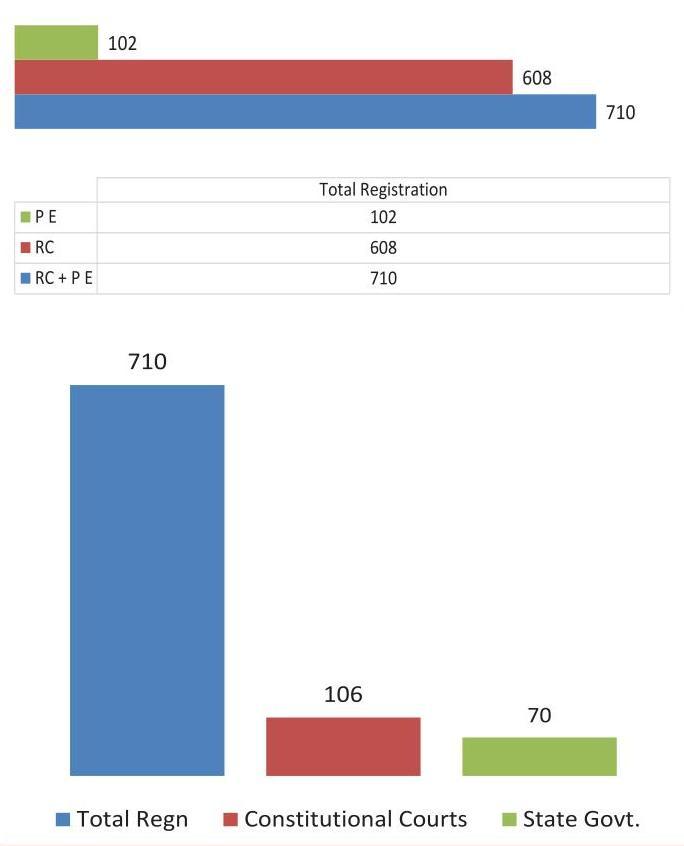
Investigation
11.66 During 2019, investigations were completed in 1012 cases, which comprised of 862 Regular Cases (RCs) and 150 Preliminary Enquiries (PEs). Out of 862 RCs, the prosecution was launched in 677 cases and sent to the competent courts for trial.
Disposal from Investigation/Enquiry
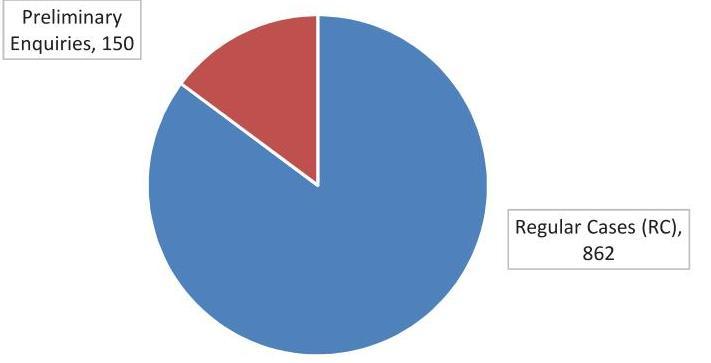
11.67 As on 31.12.2019, a total number of 1239 cases [RCs/ PEs] were under Investigation/ Enquiry.
Trial
11.68 During the year 2019, Courts delivered judgements in 755 Court Cases. Out of these, 467 cases resulted in Conviction, 186 in Acquittal, 22 in Discharge and 80 cases were disposed of for other reasons. The conviction rate was $69.19 %$.
The following details the break-up of cases decided by the courts during the year 2019:
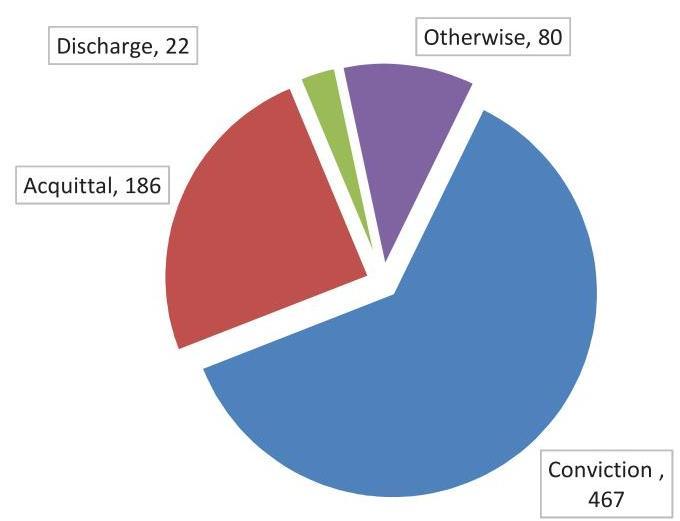
11.69 As on 31.12.2019, a total number of 9354 trials were pending in various courts.
P. INTERNATIONAL INVESTIGATION AND COORDINATION
Coordination with Law Enforcement /State/Union Territory
11.70 CBI plays a key role in facilitating improved coordination between State/UT Police agencies. Tackling interstate crimes and organized crime requires enhanced coordination, information
exchange and communication between police agencies across the country. CBI has been active in providing a common platform for bringing together police professionals across the country. Going forward, CBI shall strive to create more robust and institutionalized platforms for enhanced interstate coordination among police agencies.
$6^{\text {th }}$ Interpol Liaison Officers’ Conference
11.71 As part of coordination with State Police, $6^{\text {th }}$ Interpol Liaison Officers’ (ILOs) Conference, 2019 was held at CBI Headquarter on $20^{\text {th }}$ and $21^{\text {st }}$ June 2019, which was attended by 38 officers from the office of ILOs of different State and Union Territories of India. Shri Rajiv Gauba, Union Home Secretary, Government of India inaugurated the Conference. A Book titled “Investigation Abroad and Extradition”, got published by CBI, was also released. Discussions were held on topics relevant to the working of Interpol, Interpol Notices System, Interpol’s Operational Databases, Mutual Legal Assistance Requests and Extradition. Central authorities of India for Mutual Legal Assistance and Extradition were also invited to interact with the participants.
$1^{\text {st }}$ National Conference on Cyber Crime Investigation and Cyber Forensics
11.72 In coordination with variouslawenforcement agencies, $1^{\text {st }}$ National Conference on Cyber Crime Investigation and Cyber Forensics was held at CBI HQ on $4^{\text {th }}$ and $5^{\text {th }}$ September 2019, which was attended by 53 Officers from different State and Central Law Enforcement Agencies. During the Conference Hon’ble Minister Dr Jitendra Singh also interacted with the participants. There were deliberations on Cyber Crime Investigation,
Cyber Forensics, Crime against Digital Financial Infrastructure, Cross Border Digital Evidence, best practices like CyPAD, CCITR, I4C, Authenticating Electronic Evidence, Social Media: The Law Enforcement Challenges, Online Child Sexual Abuse: Need for Coordinated Law Enforcement Action, Indian Legal Provisions for Electronic Surveillance and Blocking, Emerging Trends in Mobile Forensics and Call Centre Frauds. Distinguished lawyers, cyber forensic experts and academicians, representatives from MHA and MEA took part in the conference as domain experts and panellists. Representatives from Social Media were also invited. Shri S. C. Jha, Chairman, NTRO delivered the valedictory address.
Letters Rogatory (Outgoing)
11.73 During the year 2019, 63 Letter Rogatory (LRs) were sent to foreign jurisdictions. Out of these, 35 LRs were pertaining to CBI cases and 28 pertaining to State Law Enforcement & Central Law Enforcement Agencies. In the year 2019, 46 LRs were executed/ partially executed and closed by Foreign Law Enforcement Agencies. These comprised of 30 LRs of CBI and 16 LRs of State Police and Other Law Enforcement Agencies. Further, during the same year, 31 LRs were returned/ withdrawn or disposed of. These include 10 LRs of CBI and 21 LRs of Other Law Enforcement Agencies. As on 31.12.2019, a total number of 482 LRs are pending with other countries, out of which, 274 pertain to CBI cases and 208 pertain to State Police and Other Law Enforcement Agencies.
Letters Rogatory (Incoming)
11.74 During the year 2019, as many as 114 Letters Rogatory (LRs) /Treaty Based Requests
were received from various countries requesting for assistance in the investigation of criminal matters. During the same period, Execution Reports in 85 cases were sent to MEA/MHA, after receiving the same from Indian Investigating Agencies, for onward transmission to the Law Enforcement Agencies of the requesting countries. Besides these, 11 LRs were otherwise disposed of as closed or withdrawn. As on 31.12.2019, 142 Requests for Assistance in Criminal matters received from foreign jurisdictions were pending for execution.
Interpol Notices
11.75 During the year 2019, NCB- India got the following number of Notices published:-
| Red Notices | 66 |
|---|---|
| Blue Notices | 175 |
| Yellow Notices | 06 |
| Purple Notices | 01 |
| Black Notices | 03 |
Extradition / Deportation
11.76 During the year 2019, the following numbers of fugitives were extradited/ deported/ arrested/ located: –
| Fugitives wanted by India, detected/ arrested in India based on the lookout circular |
06 |
|---|---|
| Fugitives wanted by India, arrested/ located in foreign countries |
27 |
| Fugitives wanted by other countries, arrested/ located in India |
01 |
| Fugitives extradited/ deported to India from foreign countries |
11 |
| Fugitives extradited/ deported from India to foreign countries |
03 |
Interpol Stolen and Lost Travel Documents (SLTD) Database
11.77 Till 31.12.2019, IPCU, CBI has uploaded data of 18,86,802 Stolen/ Lost/ Revoked Indian Passports in the SLTD Database maintained by Interpol. Till 31.12.2019, 1065 cases of use of SLTD recorded Indian passports have been reported/detected by various other NCBs.
Interpol Global Communication System [IGCS] Messages Received
11.78 During the year 2019, NCB India has received 10112 requests/ IGCS message/ letters from various NCBs, PLOs and Indian Law Enforcement agencies/authorities regarding various matters on police to police cooperation basis.
Q. OTHER MAJOR ACTIVITIES
$18^{\text {TH }}$ D.P. Kohli Memorial Lecture
11.79 The Chief Justice of India, Hon’ble Mr Justice Ranjan Gogoi on 13.08.2019 delivered the $18^{\text {th }}$ D.P. Kohli Memorial Lecture at Vigyan Bhawan, New Delhi on the subject “The Role of Police in Strengthening Justice Delivery”.
Visit of Secretary-General, Interpol to India
11.80 Mr Jurgen Stock Secretary-General, Interpol visited New Delhi from 29.08.2019 to 01.09.2019. There were bilateral meetings with the Hon’ble Union Home Minister, National Security Advisor, Home Secretary and Director CBI.
MOU between CBI and Anti- Corruption Commission (ACC) of Bangladesh
11.81 CBI has signed an MoU on 08.02.2019 with the Anti-Corruption Commission (ACC) of Bangladesh in the field of Anti-Corruption with cooperation as under:
(a) Provide each other (voluntarily or upon request) with information of relevance for prevention of corruption.
(b) Share best practices in information gathering and detecting corruption-related offences.
(c) Initiate joint projects and activities to prevent and combat corruption in a comprehensive way including education, training and research.
(d) To share studies and research on anticorruption measures.
(e) To perform other cooperative activities in the areas of preventing and combating corruption as deemed necessary.
R. CAPACITY BUILDING
11.82 In the year 2019, CBI Academy and the three Regional Training Centres (RTCs) at Kolkata, Mumbai and Chennai conducted a total of 155 courses and trained 3650 Officers/Officials which are tabulated as under:-
| No. of Courses | No. of Participants | Total | ||
|---|---|---|---|---|
| CBI | Non-CBI | |||
| CBI Academy | 129 | 1659 | 1579 | 3238 |
| RTC, Kolkata | 11 | 119 | – | 119 |
| RTC, Mumbai | 10 | 145 | – | 145 |
| RTC, Chennai | 5 | 148 | – | 148 |
| Total | 155 | 2071 | 1579 | $3650^{*}$ |
*includes 138 participants from Foreign Law Enforcement agencies.
11.83 Rank/Organization wise Break-up of the Participants
| DIG/ Director to GOI & above |
SP \& Equivalent |
IO (SI to Addl. SP) |
Law Officers |
Const to ASI |
Ministerial Staff (LDC to OS) |
Others | Total | |
|---|---|---|---|---|---|---|---|---|
| C.B.I. | 05 | 11 | 785 | 108 | 310 | 388 | 52 | 1659 |
| PSUs | 35 | 36 | 84 | – | – | – | – | 155 |
| Others | 04 | 313 | 124 | 61 | – | 26 | 138 | 666 |
| RTCs | – | – | 239 | 07 | 123 | 31 | 12 | 412 |
| CPOs | – | 34 | 42 | – | – | – | – | 76 |
| State Police |
23 | 20 | 595 | 36 | 08 | – | – | 682 |
| Total | $\mathbf{6 7}$ | $\mathbf{4 1 4}$ | $\mathbf{1 8 6 9}$ | $\mathbf{2 1 2}$ | $\mathbf{4 4 1}$ | $\mathbf{4 4 5}$ | $\mathbf{2 0 2}$ | $\mathbf{3 6 5 0}$ |
The CBI Academy also conducted seven exclusive courses in 2019 in which it trained 138 participants from three countries viz. Bangladesh, Sri Lanka and Palestine depicted vide pie chart as under:-
11.84 Foreign Participants at CBI Academy -Award of Utkrisht Seva Padak Country-wise Break-up
| Bangladesh Sri Lanka Palestine |
|---|
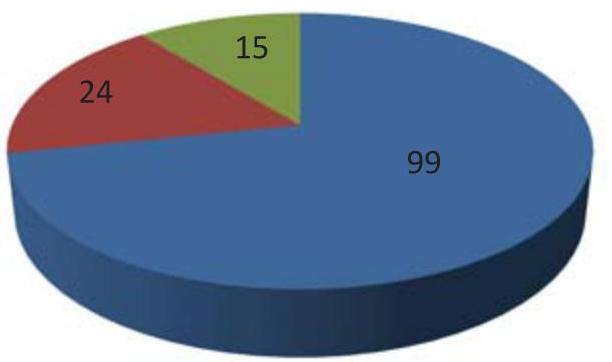
S. AWARDS AND ACCOLADES TO CBI OFFICERS DURING 2019
President’s Police Medal \& Indian Police Medal
11.85 Fourteen (14) officers have been awarded President’s Police Medals (PPM) for Distinguished Services and forty-six (46) officers were awarded Indian Police Medal (IPM) for Meritorious Services on the occasion of the Republic Day and Independence Day.
Award of Utkrisht \& Ati Utkrisht Seva Padak
11.86 Seventy-three (73) officers were awarded ‘Utkrisht Sewa Padak’ for their 15 years of continuous service with a specially distinguished record and thirty-six (36) officers were awarded ‘Ati Utkrisht Sewa Padak’ for their 25 years of continuous service with a specially distinguished record.
Union Home Minister’s Medal for Excellence in Investigation Awarded to CBI Personnel
11.87 Nine (09) officers were awarded Union Home Minister’s Medal for Excellence in investigation for the year 2018 and fifteen (15) officers were awarded Union Home Minister’s Medal for Excellence in investigation for the year 2019.
Asadharan Aasuchana Kusalata Padak
11.88 Two (02) officers were awarded “Asadharan Aasuchana Kusalata Padak” for exceptional courage and skill in intelligence service.
T. FUTURE ROADMAP
11.89 CBI has over the years established itself as a premier investigating agency of the country enjoying the trust of the Public, Government and Judiciary. The credibility of CBI is derived from strong, time tested procedures for investigation, including CBI Crime Manual. CBI also has capabilities for the proactive development of information about corruption and building up a case based on such information. The investigation is adequately supported by the legal and the technical wing, at every stage, thus, ensuring exhaustive investigation for putting up best possible legally admissible evidence before the Court.
Recognising that specialisation, technology and coordination are the key elements for future growth, CBI is taking definitive steps to upgrade
itself and stay in tune with the times. There is an impetus on greater use of technology for expediting and enriching investigations. A paradigm shift is being made to essentially make investigations multidisciplinary and done by a team. CBI is providing leadership in strengthening coordination with sister agencies, for enhancing investigation capacities. Efforts are being made to specialise in niche areas of investigation having significant international or interstate components like Cybercrimes, Online Child Sexual Exploitation, Arts and Antiquities etc. As part of the mandate, there is renewed vigour to assist Government Departments in Preventive Vigilance by identifying corruption-prone individuals and places. With the amendment in the Prevention of Corruption Act, there are plans to actively collaborate with the private sector for promoting integrity in the private sector.
CHAPTER
12
JOINT CONSULTATIVE MACHINERY
12.0 The Scheme for Joint Consultative and Compulsory Arbitration for the Central Government Employees was introduced in the year 1966 on the lines of the Whitely Councils in the U.K. The scheme provides a platform for constructive dialogue & discussion between the representatives of the staff side and the official side for peaceful resolution of all disputes between the Government as the employer and the employees. The scheme was introduced with the objectives of promoting harmonious relations and securing the greatest measure of cooperation between the Central Government as the employer and the employees in matters of common concern and with the object of further increasing the efficiency of the public service combined with the well being of those employed.
12.1 The JCM Scheme provides for three-tier machinery:
(i) The National Council as the apex body; (chaired by the Cabinet Secretary);
(ii) Departmental Councils at the level of individual Ministries / Departments including their attached and subordinate offices (chaired by respective Secretaries); and
(iii) Regional / Office Councils to deal with mainly the local problems at the level of each office, depending on its structure. (Chaired by Head of the office of respective organizations).
12.2 The scope of the JCM Scheme includes all matters relating to:
conditions of service and work;
the welfare of the employees; and
improvement of efficiency and standards of work.
12.2.1 Provided, however, that
(i) Regarding recruitment, promotion and discipline, consultation is limited to matters of general principles; and
(ii) Individual cases are not considered.
National Council (JCM)
12.3 Under the JCM Scheme, there have been continuous interactions with staff unions at the National level as well as at the Departmental level and many important issues have been resolved amicably through mutual discussions. So far, 47 meetings of the National Council (JCM) have been held, since its inception in 1966.
The last $47^{\text {th }}$ meeting of the National Council (JCM) has held on $13^{\text {th }}$ April, 2019 under the Chairmanship of Cabinet Secretary. The Minutes of the $47^{\text {th }}$ meeting of National Council (JCM) were circulated duly amongst all Ministries/Departments and Staff-Side NC (JCM). The Action Taken Report on the concerned agenda items is awaited and many are under process.
National Anomaly Committee
12.4 National Anomaly Committee has been set up under the Chairmanship of Secretary (Personnel) to settle the anomalies arising out of the Implementation of the Seventh Central Pay Commission’s recommendations.
The first National Anomaly Committee meeting was held on $17^{\text {th }}$ July 2018 under the Chairmanship of the Secretary (Personnel). The Staff Side (JCM) sent 18 agenda items for discussion in the Anomaly Committee meeting. Minutes of the meeting had been circulated to concerned Ministries/Departments. The Action Taken Report relating to the agenda items discussed are awaited and many are under process.
Standing Committee Meeting of the National Council (JCM)
12.5 Standing Committee meeting of the National Council (JCM) was held on $7^{\text {th }}$ March 2019 under the Chairmanship of the Secretary (Personnel). The Staff Side, (JCM) sent 49 Agenda Items for discussion in the meeting. The Minutes of the meeting had been circulated amongst all concerned Ministries/Departments and Staff-Side NC(JCM). The Action Taken Report relating to the agenda items are awaited and many are under process.
$7^{\text {th }}$ Central Pay Commission Recommendations
12.6 Dress Allowance:
Based on the recommendation of $7^{\text {th }}$ Central Pay Commission and in supersession of the earlier orders relating to Uniform Allowance / Washing Allowance / Stitching Charges / Shoe
allowance, etc to common categories of Group ‘ $C$ ‘ and erstwhile Group ‘ $D$ ‘ employees of various Ministries / Departments, including attached/ subordinate offices, who are required to wear uniform regularly, are now paid Dress Allowance at the rate of ₹ 5000/- per annum with effect from 01.07.2017 which was implemented vide DOPT’s OM No. 14/4/2015-JCA-2 dated 31.08.2017.
12.7 Revision of Entitlement of TA/DA to JCM Members:
Based on the recommendation of Seventh Central Pay Commission the Travelling Allowance/Daily Allowance for the Staff Side Members of the National Council (NC) Departmental Council and Third Level/Regional Councils of JCM was revised with effect from $1^{\text {st }}$ July 2017, vide DoPT’s OM No. 8/10/2008-JCA dated 20.08.2018.
ARBITRATION
12.8 An important feature of the JCM Scheme is the provision for arbitration in cases where there is no agreement between the Official Side and the Staff Side on matters relating to:-
pay and allowances;
weekly hours of work; and
leave, for a class or grade of employees.
BOARD OF ARBITRATION (BOA)
12.9 A Board of Arbitration (BOA) is appointed by the Government on matters of dispute in the National Council/Departmental Councils, comprising three Members; a Chairman (an independent person) and two Members, nominated, one each by Staff Side and Official Side.
The functions under the administrative control of the Ministry of Labour & Employment. An Award of the Board of Arbitration is binding on both the Official and Staff Sides, subject to the overriding authority of Parliament to modify or reject an Award, on grounds of the national economy or social justice.
CHAPTER
13
ADMINISTRATIVE TRIBUNALS
13.0 The Administrative Tribunals Act, 1985 owes its origin to Article 323-A of the Constitution of India which empowers Central Government to set up Administrative Tribunals by an Act of Parliament for adjudication of grievances and disputes arising out of the conditions of service of an employee appointed to the public services and posts in connection with the affairs of the Union and the States. In pursuance of the provisions contained in the Administrative Tribunals Act, 1985, the Administrative Tribunals, set up under it, exercise original jurisdiction in respect of service matters of employees covered by the Act. As a result of the Supreme Court’s judgment dated 18.03.1997 in the case of L. Chandra Kumar & Others Vs UOI, the appeals against the orders of an Administrative Tribunal shall lie before the Division Bench of the concerned High Court.
13.1 The Administrative Tribunals are distinguishable from the ordinary courts with regard to their jurisdiction and procedure. They exercise jurisdiction only in relation to the service matters of the litigants covered by the Act. They are also free from many of the procedural technicalities of the ordinary courts. The procedural simplicity of the Act can be appreciated from the fact that the aggrieved person can also appear before it personally. The government can also present its cases through its departmental officers or legal practitioners. Further, only an affordable and nominal fee of ₹ 50 is to be paid by the applicants for filing the original application before the Tribunal. Thus, the objective of the Tribunal is to provide
speedy and affordable redress to the aggrieved applicants arising out of employment or conditions of service.
13.2 The Central Administrative Tribunal was set up on 01.11.1985. As on 31.03.2020, it has 17 regular Benches, 15 of which operate at the principal seats of High Courts and the remaining two at Jaipur and Lucknow. A statement showing the location of Central Administrative Tribunal Benches, the dates of their establishment and the number of courts in each of these Benches along with a list of places where they hold Circuit Sittings is given in Appendix-I.
13.3 The Tribunal consists of a Chairman and Members. It has also been the constant endeavour of this Ministry to ensure that the posts of Chairman and Members are filled up well in time and no post remains vacant for a long time. The Members of Central Administrative Tribunal (CAT) and State Administrative Tribunals (SATs) are drawn from judicial as well as administrative streams, so as to give the Tribunal the benefit of domain expertise both in legal and service matters. The sanctioned strength of the Chairman is one and sanctioned strength of the Members of Central Administrative Tribunal is 65, out of which 32 are Judicial Members and 33 are Administrative Members.
13.4 The appointment of Members in CAT is made based on the recommendations of a Selection Committee chaired by a sitting Judge of Supreme Court (nominated by the Chief Justice of India).
After obtaining the concurrence of Chief Justice of India, appointments are made with the approval of Appointments Committee of the Cabinet.
13.5 State Administrative Tribunals (SATs) were also set up in the following States:
(i) Andhra Pradesh
(ii) Karnataka
(iii) Maharashtra
(iv) West Bengal
(v) Kerala
(vi) Haryana
13.6 The appointments to the vacancies in SATs are made based on proposals sent by the State Governments with the approval of the Governor. Thereafter, their appointments undergo the same process as the one in respect of Central Administrative Tribunal.
13.7 Since its inception in 1985 and up to 28.02.2020, the Central Administrative Tribunal received 8,18,886 cases for adjudication (including those transferred from High Courts), out of which 7,70,645 cases have been disposed of, leaving a pendency of 48,241 cases. On average, more than $94.1 %$ of the cases instituted are disposed of and for the calendar year 2019, the percentage of disposal is $104.36 \%$. A statement indicating the institution, disposal and pendency of cases since the inception of CAT is at Appendix-II.
13.8 Section 14(2) of the Administrative Tribunals Act, 1985 empowers the Central Government to extend the provisions of the Act to local or other authorities within the territory of India or under the control of Government of India and to Corporations or Societies owned or controlled by Government
of India. In exercise of these powers, the Central Government had extended the provisions of the Act to 214 organizations so far.
13.9 In order to familiarize the newly appointed Members of CAT with the functioning of the Tribunal, a short Orientation Programme / Training is held from time to time. So far, four such Orientation Programme / Training has been held at the National Judicial Academy, Bhopal.
13.10 Further, for maintaining absolute integrity and promoting fair practices in the professional court dealings and keeping in view the general directions of the Hon’ble Supreme Court, the designated Selection Committee, in its meeting decided that a Judicial Member of CAT, who earlier practised as Advocate in a Court in that station, should not normally be considered for posting in the CAT Bench of the same station.
13.11 It has been the constant endeavour of the Government to strengthen the infrastructure in all the Benches of CAT for their smooth functioning. During the Financial Year 2016-17, fund of ₹ 29.67 crores was allocated to CAT for purchase of land and construction of the building. In the Financial Year 2017-18 also, fund of ₹ 11.78 crores was allocated to CAT for this purpose. In the Financial Year 2018-19, fund of ₹ 5.00 crore was allocated to CAT for this purpose. In the current FY 2019-20, fund of ₹ 11.05 crore (₹ $5.25+₹ 5.80$ ) has been allocated to CAT.
13.12 Justice Shri L. Narasimha Reddy is the Chairman of CAT. He was appointed as Chairman, CAT with effect from 03.07.2018. Before he was appointed the Chairman, CAT, Justice Reddy was the Chief Justice of Patna High Court.
NAME, DATE OF SETTING, NO. OF COURTS AND ADDRESSES OF VARIOUS BENCHES OF CENTRAL ADMINISTRATIVE TRIBUNAL (As on 31.03.2020)
| S. No. | Name of the Bench | Date of Setting | No. of Courts | Address |
|---|---|---|---|---|
| 1. | PRINCIPAL | 01.11 .1985 | 6 | NEW DELHI |
| 2. | AHMEDABAD | 30.06 .1986 | 1 | AHMEDABAD |
| 3. | ALLAHABAD | 01.11 .1985 | 4 | ALLAHABAD |
| 4. | BANGALORE | 03.03 .1986 | 2 | BANGALORE |
| 5. | CHANDIGARH | 03.03 .1986 | 2 | CHANDIGARH |
| 6. | MADRAS | 01.11 .1985 | 2 | CHENNAI |
| 7. | CUTTACK | 30.06 .1986 | 1 | CUTTACK |
| 8. | ERNAKULAM | 01.09 .1988 | 2 | ERNAKULAM |
| 9. | GUWAHATI | 03.03 .1986 | 1 | GUWAHATI |
| 10. | HYDERABAD | 03.06 .1986 | 2 | HYDERABAD |
| 11. | JABALPUR | 30.06 .1986 | 1 | JABALPUR |
| 12. | JAIPUR | 15.10 .1991 | 1 | JAIPUR |
| 13. | JODHPUR | 30.06 .1986 | 1 | JODHPUR |
| 14. | CALCUTTA | 01.11 .1985 | 2 | KOLKATA |
| 15. | LUCKNOW | 15.10 .1991 | 1 | LUCKNOW |
| 16. | MUMBAI | 01.11 .1985 | 2 | MUMBAI |
| 17. | PATNA | 30.06 .1986 | 2 | PATNA |
STATEMENT SHOWING THE NAME OF BENCH AND PLACES WHERE CIRCUIT SITTINGS ARE HELD (As on 31.03.2020)
BENCH
- ALLAHABAD BENCH
- Nainital
- CALCUTTA BENCH
- CHANDIGARH BENCH
- MADRAS BENCH
- GUWAHATI BENCH
- JABALPUR BENCH
- BOMBAY BENCH
- PATNA BENCH
- ERNAKULAM BENCH
- Port Blair, Gangtok
Shimla, Jammu, Srinagar
Pondicherry
Shillong, Itanagar, Kohima, Agartala, Imphal, Aizwal
Indore, Gwalior, Bilaspur
Nagpur, Aurangabad, Panaji
Ranchi
Lakshadweep
APPENDIX – II
STATEMENT SHOWING THE POSITION OF INSTITUTION, DISPOSAL AND PENDENCY OF CASES IN THE CENTRAL ADMINISTRATIVE TRIBUNAL SINCE INCEPTION UPTO 31.10.2019.
(As provided by Central Administrative Tribunal, Principal Bench from time to time)
| S. No. | Period | Institution | Disposal | Pendency at the End of the Year |
|---|---|---|---|---|
| 1. | 1985 | 2,963 | 30 | 2,933 |
| 2. | 1986 | 23,177 | 8,934 | 17,176 |
| 3. | 1987 | 19,410 | 15,084 | 21,502 |
| 4. | 1988 | 19,425 | 13,769 | 27,158 |
| 5. | 1989 | 18,602 | 13,986 | 31,774 |
| 6. | 1990 | 19,283 | 15,495 | 35,562 |
| 7. | 1991 | 21,623 | 17,552 | 39,633 |
| 8. | 1992 | 25,184 | 23,782 | 41,035 |
| 9. | 1993 | 27,067 | 28,074 | 40,028 |
| 10. | 1994 | 26,230 | 26,409 | 39,849 |
| 11. | 1995 | 25,789 | 23,668 | 41,970 |
| 12. | 1996 | 23,584 | 20,667 | 44,887 |
| 13 | 1997 | 23,098 | 21,981 | 46,004 |
| 14. | 1998 | 21,911 | 18,394 | 49,521 |
| 15. | 1999 | 22,944 | 24,566 | 47,899 |
| 16. | 2000 | 25,146 | 31,398 | 41,647 |
| 17. | 2001 | 25,977 | 31,953 | 35,671 |
| 18. | 2002 | 25,398 | 29,514 | 31,555 |
| 19. | 2003 | 25,089 | 28,076 | 28,568 |
| 20. | 2004 | 23,825 | 27,735 | 24,658 |
| 21. | 2005 | 21,528 | 22,408 | 23,778 |
| 22. | 2006 | 18,722 | 17,774 | 24,726 |
| 23. | 2007 | 17,725 | 18,674 | 23,777 |
| 24. | 2008 | 18,287 | 20,352 | 21,712 |
| 25 | 2009 | 24,496 | 23,681 | 22,527 |
| 26. | 2010 | 26,620 | 25,477 | 23,670 |
| S. No. | Period | Institution | Disposal | Pendency at the End of the Year |
|---|---|---|---|---|
| 27 | 2011 | 25,869 | 24,750 | 24,789 |
| 28 | 2012 | 27,733 | 24,206 | 28,316 |
| 29 | 2013 | 27,442 | 21,654 | 34,104 |
| 30 | 2014 | 27,913 | 24,739 | 37,278 |
| 31 | 2015 | 29,089 | 25,150 | 41,217 |
| 32 | 2016 | 26,984 | 26,266 | 41,935 |
| 33 | 2017 | 25,402 | 20,055 | 47,282 |
| 34 | 2018 | 26,309 | 23,538 | 50,053 |
| 35 | 2019 | 24,952 | 26,040 | 48,965 |
| 36 | Upto Feb, 2020 | 4,090 | 4,814 | 48,241 |
| 37 | Total | $8,18,886$ | $7,70,645$ |
CHAPTER
STAFF WELFARE
14.0 The Central Government is the largest single employer in the country and bears the major responsibility for looking after the welfare of a large number of employees spread all over the country. Realizing that improvement in the working and living conditions of the employees and their families leads to efficiency and high morale, the Department of Personnel and Training supports various staff welfare measures. A brief account of various welfare measures dealt with by the Welfare Division is given below.
RESIDENTS’ WELFARE ASSOCIATION
14.1 In order to foster a spirit of mutual help and goodwill among residents of Government colonies and to promote social, cultural and recreational activities, Department of Personnel & Training (DOPT) has been encouraging the formation of Central Government Employees Residents Welfare Associations (CGERWAs). Every CGERWA seeking recognition and grants-in-aid from Government is required to adopt the Model Constitution prescribed by DOPT. At present, there are 95 recognized Associations. The members of the Managing Committees of these Associations are elected every two years under the provisions of a Model Constitution framed by the Department of Personnel and Training. This Department sanctions grants-inaid only to recognized Associations, subject to a maximum of ₹ 10,000/- per annum for an Association.
AREA WELFARE OFFICERS
14.2 Area Welfare Officers (AWOs) are nominated in residential colonies having a large number of Central Government employees. AWO’s serves as a link between the Government and residents in matters relating to the welfare of Government employees living in various colonies. They also work as field officers in coordinating and maintaining liaison with various agencies of Government such as CPWD, CGHS, and Police etc. Applications are invited from Gazetted Officers working in various Ministries/Departments for being nominated as Area Welfare Officers for two years. Officers desirous of being nominated as AWOs on the voluntary and honorary basis are required to apply through their respective Ministries/ Departments.
CENTRAL CIVIL SERVICES CULTURAL \& SPORTS BOARD (CCSCSB)
14.3 The Central Civil Services, Cultural \& Sports Board, a society registered under the Societies Registration Act, 1860 is the central agency for the promotion of Cultural \& Sports activities amongst the Central Government employees in the country. The Board was set up in 1964 as Central Secretariat Club in the Ministry of Home Affairs. Initially, the objective of the Board was to promote cultural and sports activities amongst the Central Government Employees located in Delhi only. Subsequently, Regional Sports Boards were set up in various states. Financial grants-in-aid are sanctioned every year by the Board to the Regional Boards.
ACTIVITIES OF THE BOARD-INTER MINISTRY TOURNAMENTS 2019-20
14.4 The Board organizes Inter-Ministry Tournaments in 18 disciplines of sports. In the year 2019-20, the Board organized Inter-Ministry Tournament in all the disciplines of Sports.
AII INDIA CIVIL SERVICES TOURNAMENTS HELD DURING THE YEAR 2019-20
14.5 These tournaments, which are open to Central and State Government employees, aim to give an opportunity to the civil servants to meet and interact with each other and compete. AICS Tournaments are being organized in collaboration with different States/UTs. All India Civil Services Tournaments were held in various disciplines in 2019-20 in which the Central Secretariat teams performed well. Women teams of CCSCSB participated in Kabaddi, Wrestling, Volleyball, Powerlifting and weightlifting for the first time.
NEW ACTIVITIES UNDERTAKEN BY THE BOARD IN 2018-19 FOR THE FIRST TIME
14.6(1) CCSCSB organized athletics competition and Dance and Music competition for wards of Central Government Employees.
14.6(2) CCSCSB also organized Half Marathon for Central Government employees and their immediate family members in collaboration with YHAI.
SCHEME FOR PROMOTION OF ADVENTURE SPORTS & SIMILAR ACTIVITIES AMONGST CENTRAL GOVERNMENT EMPLOYEES
14.7 As a welfare measure, the CCSCSB launched a Scheme for promotion of adventure sports and similar activities amongst Central
Government Employees working in the Ministries/ Departments. The Scheme includes up to 10 days programme having components of environmental awareness, disaster management, team spirit, capacity building, and Swachh Bharat Campaign and activities like Trekking, Mountaineering, RockClimbing, Cycling in difficult terrain, Skiing, Rafting, Para-Sailing, Jungle Safari and Environmental Awareness Camps etc.
14.8 It is expected that participation by Central Government Employees in adventure sports and similar activities will give them a platform where they would learn lessons from nature and use the knowledge acquired for the welfare of the society. It would also foster the spirit of risk-taking, cooperative teamwork, the capacity of readiness, vital response to challenging situations, endurance and environmental awareness.
14.9 CCSCSB provides financial assistance up to ₹ 20,000/- including to and fro travel charges to the Central Govt. employees.
BOARD’S AFFILIATION TO NATIONAL FEDERATION
14.10 The Board is affiliated to many sports Associations/Federations at the National level. Board’s teams participate in the National Tournaments organized by these Associations/ Federations in Kabaddi, Hockey, Football, Carrom, Cricket and Chess.
SPORTS FACILITIES IN DELHI
14.11 The Board has a sports complex at Vinay Marg, New Delhi which has facilities for Football, Hockey, Cricket, Athletics, Lawn Tennis, Basketball, Volleyball and practice pitches for Cricket. The Board also maintains Lawn Tennis Courts at
Brassy Avenue, Bharti Nagar, Pandara Road and R.K. Puram Sector 13, New Delhi. Brassy Avenue, New Delhi has facilities for Volleyball and Cricket practice pitches also. There is the facility for Indoor games such as Table Tennis, Carrom and Chess at Nirman Bhawan, New Delhi. Open Gym facilities are available at Vinay Marg, Bharti Nagar and R. K. Puram Sector 13.
COACHING FOR CHILDREN DEPENDENTS OF GOVERNMENT EMPLOYEES
14.12 The Board also conducts regular coaching in Cricket, Football and Lawn Tennis for the children/ dependents of Government employees at Vinay Marg Sports Complex, New Delhi. Coaching in Lawn Tennis is also available at Bharti Nagar, Pandara Road, R.K. Puram Sector-13.
14.13 The Board also organizes Summer Coaching camp in Basketball, Cricket, Football, Volleyball, Self-defence and Lawn Tennis for children/dependents of government employees.
PARTICIPATION OF GOVERNMENT EMPLOYEES AND THEIR FAMILIES IN SPORTING ACTIVITIES CONDUCTED IN COLLABORATION WITH SAI
14.14 The Board has introduced Scheme for Swimming for Central Government Employees and their children in collaboration with Sports Authority of India at Major Dhyanchand National Stadium & Talkatora Stadium New Delhi. Under the Scheme, Government employees and their dependents/families avail the facility of Swimming at nominal charges. Badminton, Table tennis and Fitness Centre facilities are also extended to Government Employees under “Come and Play” scheme of Sports Authority of India to the employees and their families. Under this scheme,
the amount charged by SAI is reimbursed to the beneficiary after deduction of a nominal fee.
SETTING UP OF GYMNASIUM IN MINISTRIES/DEPARTMENTS
14.15 The Board has framed the Scheme for the establishment of indoor Gymnasium, open Gym and augmentation of existing Gyms in Ministries/ Departments. As a Staff welfare measure, the CCSCSB provide financial assistance to the Ministries/Departments of Central Government for setting up of indoor \& open Gymnasium and augmentation of existing Gyms.
GRIH KALYAN KENDRA
Grih Kalyan Kendra (GKK) is a registered Society under the Societies Registration Act, 1860 and functioning under the aegis of Ministry of Personnel, Public Grievances \& Pensions.
14.16 The basic objectives of the Kendra in brief are: –
a) To promote social, economic, cultural and educational activities for the welfare of Central Government Employees and their families.
b) To impart technical and vocational training in home crafts and other household arts for useful utilization of leisure time and better and efficient housekeeping.
c) To organize and promote economic activities that may provide opportunities for gainful employment to families of Central Government employees for supplementing the family income.
14.17 The GKK is administered by GKK Board.
The Board, which has the Secretary (P) or his nominated officer as the President, is responsible for the organization and administration of GKK.
14.18 In pursuance of its objectives, GKK has been conducting the following activities:
a) Training classes in cutting, tailoring and embroidery for the housewives and grown-up girls during their leisure hours.
b) Nursery education for children in the age group of 3 to 5 years.
c) Creches or Day Care Centres for children between the age of 90 days to 10 years.
d) Recreational facilities like Health Club/Gym, badminton and tennis, etc.
e) Coaching classes in Martial Arts, Yoga, Music, Dance, English Speaking Course, Computer, Brain Development, Fine Arts, Lawn Tennis etc.
14.19 The welfare activities run by Grih Kalyan Kendra are indicated in the table given below:
| Place | Number of Samaj Sadans/Centres |
Craft Centres |
Nursery Schools |
Creche Centres |
Health Clubs/ Gyms |
|---|---|---|---|---|---|
| Delhi | 32 | 7 | 13 | 10 | 7 |
| Mumbai | 4 | 3 | 4 | – | – |
| Chennai | 3 | – | 2 | – | – |
| Jaipur | 2 | 1 | – | 1 | – |
| Dehradun | 2 | – | 2 | – | – |
| Nagpur | 2 | – | – | – | – |
| Bangalore | 3 | – | – | – | – |
| Faridabad | 1 | 1 | 1 | 1 | – |
| Kolkata | 1 | – | – | – | – |
| Ghaziabad | 1 | – | – | – | – |
| Total | 51 | 12 | 22 | 12 | 07 |
14.20 The Grih Kalyan Kendra has undertaken the following activities during the year 2019:-
i) 1520 children attended Nursery Schools, 124 Students attended Craft Centres, 167 Children were taken care in Creches, 120 persons used Health Clubs/ Fitness Centres, 1200 approx in Outsourced Activities and
1250 in Yoga Activity have been availing the facilities.
ii) DOPT launched a Yoga training scheme w.e.f. 01.04.2015 in association with Morarji Desai National Institute of Yoga, New Delhi for the benefit of Central Government employees and their dependents free of cost. The training
sessions are conducted in 25 locations in Delhi and 13 SamajSadans of Grih Kalyan Kendra outside Delhi. Yoga Trainers have been selected by Morarji Desai National Institute of Yoga (MDNIY), New Delhi. These trainers have been engaged by Grih Kalyan Kendra on a contract basis. Government has allocated ₹ 1.85 crores for the scheme of Yoga Training sessions under the Non-Plan Head in 2018-19 and ₹ 2 Crore for the year 2019-20.
(iii) 1635 participants attended Yoga Training Sessions at various Samaj Sadans in Delhi in the International Yoga Day held on 21.06.2019. International Yoga Day was celebrated even at the Samaj Sadans located outside Delhi namely, Kolkata, Chennai, Mumbai, Nagpur, Dehradun, Bangalore, Faridabad and Ghaziabad where the number of participants were totally 658.
KENDRIYA BHANDAR
OBJECTIVES OF THE ORGANISATION
14.21 The Central Government Employees Consumer Cooperative Society Ltd., New Delhi, operating in the name of KENDRIYA BHANDAR was set up in 1963 in pursuance of Cabinet decision as a Welfare Project for the benefit of the Central Government Employees. The society endeavours to serve the Central Government Employees and the general public at large by providing quality goods of daily needs at reasonable prices through its retail stores. The range of items which Kendriya Bhandar provides includes consumer goods, grocery items, stationery and medicines etc.
MULTI-STATE COOPERATIVE SOCIETY
14.22 The Society is registered under
MSCS Act 2002, as a Multi-State Co-operative Society and operates in Delhi and other States of the country.
NETWORK
14.23 The Society operates a network of 153 stores/branches in Delhi, Maharashtra, Tamil Nadu, Andhra Pradesh, Karnataka, Cochin, Daman, Goa, Gujarat, Uttar Pradesh, Uttaranchal, Rajasthan, Madhya Pradesh, West Bengal, Jharkhand, Assam, Haryana, Punjab and Chandigarh etc.
14.24 At Delhi, Kendriya Bhandar has a chain of 110 numbers self-service grocery consumer retail stores beside the Institutional Sales Unit (ISU) and 06 Pharmacy shops (inclusive of four JAN Aushadhi Generic Drug Shops). At Grocery/ Consumer stores, all items of consumer goods, grocery items and certain stationery items are being sold. Through its Institutional Sales Unit, Kendriya Bhandar continues to provide goods to institutions like Tihar Jail, JNU/IIT Hostels, Janpath/Samrat Hotel, Hyderabad House, President House, Vigyan Bhawan, Homes of Social Welfare Department of Govt. of Delhi, Govt. Hospitals etc. In addition, Kendriya Bhandar has an exclusive counter at East Block and West Block, R.K. Puram, New Delhi for sale of stationery and other products.
14.25 Furthermore, Kendriya Bhandar is supplying medicines and related items to CGHS Dispensaries and Hospitals in Delhi through its existing chemist shops. Jan Aushadhi Generic Drug Shops in GTB Hospital, DDU Hospital Shastri Bhawan and NTPC as a part of Jan Aushadhi project of the Department of Pharmaceuticals, Govt. of India.
Kendriya Bhandar has also opened new stores at Subroto Park, Pinto Park, Sekhon Vihar, Lodhi Colony, Noida Metro rail Corporation (Greater Noida) and Vayusenabad (Tughlakabad). In addition, 11 stores have been opened in DelhiNCR under franchisee system.
SHARE CAPITAL
14.26 As on $31^{\text {st }}$ March 2019 Kendriya Bhandar had a paid-up capital of ₹ 101.50 lakhs of which ₹ 68.18 lakhs have been subscribed by the Central Government and the rest by individual members.
MODER NISATION/ AUTOMATION EFFORTS
14.27 Activities such as billing to customers, purchase, inventory etc. of Stationery division of Kendriya Bhandar, located at R.K. Puram East & West Blocks are computerized through Local Area Network. Further, in Head Office, purchases \& stocks of Consumer items, pulses and spices are computerized. All retail stores have already been computerized and also inventory has been computerized.
14.28 Debit/Credit Card swiping machines have been installed in all stores of Kendriya Bhandar for the convenience of customers.
SALES AND FINANCIAL PERFORMANCE
14.29 Kendriya Bhandar has achieved sales of ₹ 1539.92 crores during the financial year 201819 against the sale of ₹ 750.14 crores in the Financial year 2017-18 and also achieved a net profit of ₹ 2.01 crores in the F.Y 2018-19 (after making provision for wage revision of ₹ 2 crores) against the net profit of ₹ 1.89 crores during the F.Y. 2017-18.
14.30 Kendriya Bhandar has declared a dividend of $10 %$ for the year 2018-19. There is no financial assistance from Govt. to Kendriya Bhandar. Source of income of Kendriya Bhandar is trading of products, interest on FDRs etc.
BENEFITS TO CUSTOMERS
14.31 The Society has been able to maintain competitive prices for various products sold by it as compared to those prevailing in the market. Selling prices prevailing in Kendriya Bhandar now are deemed as the benchmark in the market.
14.32 For better quality control, full-fledged Quality Control Department is in place for monitoring the product quality and for making improvements on an ongoing basis. Packed grocery items are sold after pre-testing in the laboratory. On the shelf, post-testing is done periodically. The goods sold in the manufacturers packing carry the warranty of the manufacturer. Complaints books are provided in all the stores for the customer to enter their complaints/suggestions which are acted upon from time to time.
14.33 It is pertinent to mention that the Society has been involved in welfare activities and has always assisted the Central Government and the Govt. of NCT of Delhi in arresting the price rise at the time of crisis. Recently, Kendriya Bhandar has sold onions @ ₹ 20/- per kg which was the lowest rate of onions when the rate of onions in the open market was ₹ 60/- to ₹ 80/-per kg.
14.34 All the stores have been computerized, CCTV cameras have been provided in a large number of stores as a preventive measure against shoplifting, theft etc.
The Civil Service Society (Sanskriti School)
Introduction
14.35 The Civil Services Society is a society registered under the Societies Registration Act. The Society was set up in February 1995, by the wives of the officers of the All India and Allied Civil Services. The wife of serving Cabinet Secretary is the Chairperson of the Civil Services Society. The office of the Society is at Dr S Radhakrishnan Marg, Chanakyapuri, New Delhi – 110021.
Aims and Objectives
14.36 The aims and objectives of the society, inter-alia, are as under:-
- To establish progressive schools or other educational institutions in Delhi or outside Delhi, open to the children of officers of the All India and Central Services. Depending on the availability of seats, children of officers of the Public sector of non – government servants may also be admitted, at the discretion of the Governing Body.
- To impart sound and liberal education to boys and girls during their impressionable years – a type of education that will lay stress on character building, teamwork, esprit-decorps, physical development and to infuse in school children a spirit of adventure, fair play and justice.
- To develop among its students a feeling of pride in Indian culture and to produce citizens who will truly be global and rise above social, communal, religious and provincial prejudices.
14.37 The Society started its first school with the
strength of 32 students, the Sanskriti School, in New Delhi, in the year 1998. The Chairperson of the Society is also the Chairperson of the School. Sanskriti School is a recognized integrated coeducational school, affiliated to the CBSE, offering education from Nursery to Class XII.
14.38 The Society believes that every child can and must realize his/her full potential, and towards this end, must be enabled through appropriate means. With this in mind, the School has a Learning Centre with Special Educators and Counselors guiding children who have special needs, through an Individual Education Program (IEP).
14.39 Likewise, for those from the relatively less privileged sections of society, the Society runs a parallel school Umang in the afternoon. Efforts are also made to mainstream some of the children. These children from the economically weaker sections are admitted through the admission process under the Delhi Education Act.
14.40 The Civil Services Society has set up a Centre for Excellence to promote teacher training initiatives. It has instituted the Sanskriti Lecture Series to motivate students by exposing them to the thought processes of eminent persons.
Management
14.41 The general management of the affairs of the Society is vested in its Executive Committee.
14.42 The general management of the affairs of Sanskriti School is also guided by the Managing Committee.
Activities
14.43 As on $31^{\text {st }}$ March, 2020, Sanskriti School
has 2829 students on its rolls from Nursery to Class XII. It has well-stocked libraries, smart classrooms, laboratories, a gymnasium, a football field and a swimming pool. Apart from the prescribed curriculum, Sanskriti School offers its students a choice of sports and games, like cricket, football, basketball, table tennis, swimming and wide-ranging co-curricular activities like yoga, chess, theatre, music, dance, quiz, public speaking, papercraft, etc.
Finance
14.44 The Society has no income of its own other than the annual subscription of the members. For Sanskriti School, the source of income is the fees collected from the students.
CIVIL SERVICES OFFICERS INSTITUTE (CSOI)
INTRODUCTION
14.45 The Civil Services Officers’ Institute is a registered society under the Societies Registration Act and was set up in February 1998. CSOI was allotted a building at K.G Marg, M.S. Apartments complex in 1998 which was later re-appropriated by CPWD to provide facilities of an Institute. Subsequently, the land was allotted to CSOI in 2002 at Vinay Marg, Chanakyapuri measuring 4.23 acres by Ministry of Urban Development, GOI. The new building was constructed by NBCC at a cost of ₹ 44.33 crore and it became operational with effect from December 2012. The Governing Council of CSOI decided to run both the Institutes at their respective locations in view of increased membership.
AIMS AND OBJECTIVES
14.46 The aims and objectives of the CSOI inter-alia include:-
(i) To promote the welfare of the officers of the Civil Services and bring them together under one umbrella to secure complete integration of the services and to build a corps of officers imbibed with the spirit of co-operation in all aspects of Civil Services.
(ii) To hold, organize, arrange and conduct seminars, symposiums, talks, debates, workshops, lectures and other means of dispensing education to meet the needs and challenges of modern-day Civil Administration.
(iii) To print and publish journals, periodicals and manuals to keep the civil servants abreast with modern-day development.
(iv) To acquire and promote modern skills of Civil Administration and harmonize between different fields of Civil Administration by disseminating or exchanging knowledge thereof and by providing such other facilities as would lead to their Universal application.
(v) To establish and maintain libraries and information system to facilitate the study of Civil Administration at International level and spreading information in regard thereto.
(vi) To organize and maintain, on no profit – no loss basis, limited residential accommodation for the members of the Society coming to participate in the activities of the Association and of other bodies with cognate objectives, as well as non-members, invited to participate in the activities of the Association.
MANAGEMENT
14.47 CSOI is managed by a Governing Council headed by Cabinet Secretary, an Executive
Committee headed by Secretary (P), DoPT and a Working Committee headed by Additional Secretary (DoPT).Various sub-committees of comprising of members to assist Working Committee in its day to day smooth functioning, viz:
a) Finance subcommittee
b) Food & Beverages subcommittee
c) Arts \& Events subcommittee
d) Building Maintenance subcommittee
e) IT subcommittee
f) Library subcommittee
g) Sports subcommittee.
EVENTS
(a) Book \& Authors Session ‘India Armenia’ by Amb. Achal Malhotra.
(b) In House Lady Members Dance Programme Bihu Folk Dance by Assamese Group.
(c) A Talk on ‘The Science \& Art of eating right’ by Dr. Ishi Khosla.
(d) Stage Play ‘Bhaag Oliver Bhaag’ by Living Room Theatre.
(e) ‘Haryali Teej’ by In House Group.
(f) Stage Play ‘Haamid’ (Hamlet) by Hill ThespianJammu.
(g) Odissi Classical Dance by Vishwa Nath Manga Raj.
(h) Stage Play ‘Bapu’ by Tikam Joshi.
DEPARTMENTAL CANTEENS
14.48 As a measure of Staff Welfare, Departmental Canteens/Tiffin Rooms have
been set up in the Central Government Offices/ Establishments to make available beverages, snacks and meals prepared in hygiene conditions, to the employees at reasonable rates. At present about 1000 Departmental Canteen/Tiffin rooms are functioning in various Central Government Offices all over India. To bring cleanliness, quality of service etc. detailed instructions is issued from time to time including orders on policy matters. Detailed instructions on the functioning of Department Canteen are contained in Administrative Instructions on Departmental Canteens in Government Offices and Industrial Establishments.
Important instructions/orders issued during 2019-20
(i) Canteen Allowance (previously called Special Allowance) was increased by a factor of 1.5; the revised allowance is admissible to certain categories viz., General Manager, Dy. Genl. Manager/ Manager Gr.II/Manager-cumaccountant and Astt. Manager-cum-StoreKeeper w.e.f. 01.07.2017.
(ii) Cooking Allowance @ ₹ 1000/- p.m is introduced to cooking category viz. Astt. Halwai-cum-cook and Halwai-cum-cook in non-statutory departmental canteens w.e.f. 01.10.2019.
(iii) The scholarship is granted to eligible wards of Canteen employees from the Discretionary fund of Director (Canteens). The Scholarship scheme was revised vide O.M. dated 24.12.2019, giving a decent hike in the scholarship amount in 21 discipline in the range of ₹ 1000 to ₹ 10000. Earlier it was in the range of ₹ 750 to ₹ 2500.
(iv) The Department of Personnel and Training, under the scheme for modernization of Canteens, grants funds to Non-Statutory Departmental Canteens located in Central Government Offices, for modernizing their canteens. The scheme is formulated during the year 2015. This Scheme applies to Departmental Canteens under the administrative control of various Ministries/
Departments/Attached/Subordinate offices in Delhi/Outside Delhi. The grant of a fund ranges from ₹ 5 lakhs to ₹ 20 lakhs depending on the type of canteen. Out of the amount of ₹ 50 lakhs allocated for the year 201920 for the scheme, a sum of ₹ 30 lakhs has been released towards modernization of four canteens as on 08.01.2020.
CHAPTER
RIGHT TO INFORMATION
MANDATE
- Administration of the RTI Act and Rules including amendments thereof.
- Issue of Guidelines and clarification on RTI.
- Implementation of the Annual Programme titled ‘Improving Transparency and Accountability in Government through Effective Implementation of RTI Act’.
- Management of RTI online web portal.
- Administrative matters of Central Information Commission.
- Selection of Chief Information Commissioner and Information Commissioners in the Central Information Commission.
- Framing of Right to Privacy Law.
SALIENT FEATURES OF THE RIGHT TO INFORMATION ACT, 2005
15.1 To set out a practical regime for securing information by citizens from the Public Authorities and to promote transparency and accountability in the working of all Public Authorities, the Parliament enacted the Right to Information Act in 2005.
15.2 The Act is comprehensive and covers disclosure of information by public authorities on matters of governance. It applies to Government at all levels- Union, State and Local and also to the bodies owned, controlled or substantially financed directly or indirectly by the Government. It covers legislative bodies, the judiciary, the executive and Constitutional bodies.
15.3 The Act casts an obligation on public authorities for suo-motu disclosure/publication of information held by them. It also requires the
public authorities to supply information called for by any citizen and to permit him to inspect the documents and collect samples of various works. The procedure for seeking information is very simple. A person seeking information has to make a request to the concerned Public Information Officer indicating the information required. The request may be sent either by post or be submitted in person or online if such a facility exists with the public authority. It can be made in Hindi or English or in the official language of the area in which the application is made.
15.4 The Act creates the machinery to ensure supply of information, which consists of Public Information Officers, Assistant Public Information Officers, Departmental Appellate Authorities, independent Central and State Information Commissions etc.
15.5 The Act requires information to be provided in a time-bound manner. A Public Information Officer is required to send information called for at the specified address within 30 days. In case the information concerns the life or liberty of a person, it has to be provided within forty-eight hours. The Act provides for the imposition of stringent penalty on the Public Information Officer if the information is not provided within the prescribed period which could be ₹ 250/- per day of delay subject to a maximum penalty of ₹ $25,000 /-$.
15.6 The Act has created a system of two appeals. On not being provided information within the prescribed period or on not being satisfied with the reply provided, an applicant can make the first appeal within 30 days to the departmental appellate authority, who is generally the next superior officer to the Public Information Officer. If not satisfied with the decision of the first appellate authority, the applicant can file a second appeal to the Central Information Commission or the State Information Commission, as the case may be, within 90 days.
15.7 However, certain types of information pertaining to security of the country, scientific or economic interest of the country and information on trade secrets etc. are exempted from disclosure. Certain security or intelligence organizations have been exempted from disclosing any information except that pertaining to corruption or violation of human rights. Such organizations are required to designate Public Information Officers and First Appellate Authorities to deal with applications and appeals relating to information pertaining to corruption or violation of human rights.
15.8 With a view to create a brand for the Right to Information, a logo as given below had been
adopted for the RTI on $28^{\text {th }}$ October 2010. The logo is very simple and iconic. A sheet of paper with information on it, and the authority figure behind it – providing the information. This represents the two key stakeholders in the process of sharing information under the RTI Act.
RIGHTTO
INFORMATION
CENTRAL INFORMATION COMMISSION
15.9 The Government of India has constituted a Central Information Commission. Further, all the 29 States to which the Act applies, have constituted State Information Commissions. These Commissions are high powered independent bodies which, inter-alia, can look into the complaints made to them and decide the appeals. The Commissions have the power to impose a penalty on the defaulting Public Information Officers. Central Information Commission entertains complaints and appeals in case of offices, financial institutions, public sector undertakings, etc. under the Central Government and the Union Territories while the State Information Commissions entertain appeals pertaining to offices, financial institutions, public sector undertakings, etc. under the concerned State Government.
15.10 The Central Information Commission, when constituted initially, had five Commissioners including the Chief Information Commissioner. With the last appointment of one Chief Information Commissioner and one Information Commissioner on $6^{\text {th }}$ March 2020. The Commission has now SIX Information Commissioners apart from the Chief Information Commissioner.
RIGHT TO INFORMATION RULES, 2012
15.11 In supersession of the Central Information Commission (Appeal Procedure) Rules, 2005 and the Right to Information (Regulation of Fee and Cost) Rules, 2005, the Right to Information Rules, 2012 has been notified in the Gazette of India on $31^{\text {st }}$ July 2012.
15.12 The Right to Information Rules, 2012 provide inter-alia that a request for obtaining information shall be accompanied by an application fee of rupees ten by way of cash against proper receipt or by demand draft or bankers’ cheque or Indian Postal Order payable to the Account Officer of the public authority. The applicant may have to pay a fee in addition to the application fee for obtaining documents or for inspecting the documents. The persons below the poverty line are not required to pay any fee for seeking information.
15.13 The RTI Rules, 2012 also prescribe the procedure for deciding appeals by the Central Information Commission, covering the following aspects:
(i) Documents to be enclosed with the appeal;
(ii) Return of Appeal
(iii) Process of Appeal
(iv) Procedure for deciding appeals
(v) Presence of the appellant before the Commission
(vi) Presentation by the Public Authority
(vii) Service of notice by Commission
(viii) Order of the Commission
RIGHT TO INFORMATION RULES, 2019
15.14 RTI Amendment Bill, 2019 was passed by the Lok Sabha on 22.07.2019 and Rajya Sabha on 25.07.2019. The Bill received the assent of the President on $1^{\text {st }}$ August 2019.
15.15 The RTI (Amendment) Act, 2019 was notified, by the Legislative Department, in the Gazette of India on $1^{\text {st }}$ August 2019.
15.16 Notification to bring into force the provision of the RTI (Amendment) Act, 2019 has been published in the Gazette of India, Extraordinary under Part II, Section 3, Sub-Section (ii) on 24.10.2019.
15.17 Consequently, ‘The Right to Information (Term of Office, Salaries, Allowances and Other Terms and Conditions of Service of Chief Information Commissioner, Information Commissioners in the Central Information Commission, StateChiefInformationCommissioner and State Information Commissioners in the State Information Commission) Rules, 2019’ have been notified in the Official Gazette of India, Extraordinary under Part II, Section 3, Sub-Section (i) on 24.10.2019.
RTI WEBSITE
15.18 There is a dedicated website on RTI www. rti.gov.in, which contains valuable information including circulars, notifications and Guides on RTI, the search facility for locating CPIOs and Appellate Authorities in Central Government etc. It has links with other RTI related sites as well.
ANNUAL PROGRAMME ON RIGHT TO INFORMATION
15.19 The Government has launched a
Centrally Sponsored Plan Scheme “Improving Transparency and Accountability in Government through Effective Implementation of the Right to Information Act” in August 2010 to undertake activities in the area of awareness generation and capacity building. Under the scheme, the State Administrative Training Institutes and State Information Commissions are supported through the release of grants for awareness generation and training programmes of all stakeholders. The total outlay of the scheme under the XII th Five Year Plan was ₹ 110.36 crores. Afterwards, the Scheme has been changed to an Annual Programme. During the last financial year i.e., 2018-19 an expenditure of ₹ 4.54 crores have been incurred under the Scheme. During the current F.Y i.e 2019-20, an amount of ₹ 4.57 crores has been released till 31.03.2020.
TRAINING
15.20 The above Plan Scheme has components of training of Public Information Officers / First Appellate Authorities of Centre as well as States. On the training of State PIOs, a sum of ₹ 2.32 Crores was released to Administrative Training Institutes during the current Financial Year (up to 31.03.2020).
AWARENESS GENERATION FOR RTI
15.21 The component of awareness generation includes the Organization of Workshops, RTI Week Celebration, Innovative Awareness Generation Programmes and Publication of Guidebooks. During the year under review an expenditure of ₹ 173.00 lakhs was incurred on these components during the current Financial Year (till 31.03.2020).
INTERNSHIP ON RTI
15.22 Considering the need to consolidate and document the experiences of the Ministries / Departments of Government of India in the implementation of RTI, its successes, constraints in implementation, to identify the areas which need more attention, to address the gap areas and to see what more needs to be done to help achieve the objectives of the RTI Act, 2005. DoPT provides Short Term Internships to Undergraduates pursuing the five years integrated course in Law and pursuing Graduation in Law to analyze applications received under the RTI Act in Select Public Authorities. During the year under review, Internship was offered to 20 (Twenty) interns under RTI Internship Programme from 17.06.2018 till 16.08.2018. All the selected interns successfully completed the internship.
RTI FELLOWSHIP
15.23 The RTI fellowship of 3-month duration is awarded every year to four fellows in the age group of 25-40 years from the field of Media/ Journalism/Civil Society Organizations associated with RTI/RTI Trainers to conduct field-based research on themes relating to RTI with the aim that the research output will enhance our understanding of the status of the implementation of the Act, including its success, constraints in its implementation and how those are being/could be overcome and what more needs to be done to help achieve the objectives of the Act. During the fellowship period, each fellow is granted a total stipend of up to ₹ 2.00 lakhs. The fellowship has been started in 2010.
RTI CELLS IN MINISTRIES / DEPARTMENTS
15.24 Department of Personnel & Training
provides a one-time grant of ₹ 50,000/- under the Annual Programme for setting up RTI Cells in the Central Ministries / Departments to streamline receipt and disposal of RTI applications/appeals and orders. So far 39 Central Public Authorities have received grants for setting up RTI Cells.
RTI ONLINE PORTAL
15.25 A web portal namely ‘RTI Online’ has been launched to provide the facility for the Indian Citizens to file online RTI applications and first appeals and also to make online payment of RTI fees. The prescribed fee can be paid by the applicant through internet banking of the State Bank of India as well as by Credit/Debit cards of VISA / Master, through the payment gateway of SBI, which is linked to RTI Online portal.
15.26 The RTI online portal provides for sending online replies to applications and appeals, though reply can be sent by regular post also. For a successful implementation of this facility, extensive training to the CPIOs / FAAs has been provided by DOPT, with the help of NIC. As on 31.03.2020, 2334 Public Authorities have been aligned with this portal.
SUO MOTU / PROACTIVE DISCLOSURE
15.27 Section 4(1)(b) of the RTI Act lays down the information which should be disclosed by Public Authorities on a suo motu or proactive basis. Sections 4(2) and 4(3) of the Act prescribe the method of dissemination of this information. In order to improve the proactive disclosure, the Government of India constituted a Task Force on suo motu disclosure in May 2011. After considering the recommendations of the Task Force, the Government of India has issued
guidelines to Central Ministries / Departments for Proactive Disclosure under section 4 of the RTI Act on 15.4.2013 and the same were reiterated on 07.11.2019. These guidelines envisage –
(a) Suo motu disclosure of more items under section 4,
(b) Guidelines for digital publication of proactive disclosure,
(c) Detailing of certain clauses of section 4(1)
(b) to make disclosure more effective
(d) Compliance mechanism for suo motu disclosure
(e) Personal information of an individual not to be disclosed
15.28 As per the guidelines, Pubic Authorities may publish information relating to procurement, publicprivate partnerships, transfer policy and orders, RTI applications, CAG and PAC paras, citizens’ charter, discretional and non-discretionary grants, foreign tours of Prime Minister and Ministers.
15.29 The guidelines further provide that each Central Ministry/ Public Authority should get its proactive disclosure package audited by a third party every year and that such audit should be communicated to the Central Information Commission annually through publication on their websites along with the names of the third-party auditors. Under these guidelines, a senior officer of the level of Joint Secretary in the case of Ministry/ Department and Additional HoD in the case of attached/subordinate offices must be nominated as nodal officer for ensuring compliance with the proactive disclosure guidelines.
15.30 The above guidelines have been reiterated duly incorporating a slight revision to Para 4.4 of the above guidelines allowing for third party audit by any Government Training Institute, in cases where no Training Institute exists under the concerned Ministry/Department/Public Authority.
15.31 State Governments have also been requested to consider issuing similar guidelines, along with templates for disclosure at various levels, for better implementation of suo motu disclosure at State level. Four areas have been identified for development of templates viz. Public
Distribution System, Panchayats, MGNREGA and Primary and Secondary Schools.
15.32 A facility to upload the reply of RTI applications and first appeals on the respective website of the Ministry/Department has been started from $31^{\text {st }}$ October 2014. All the Ministries/ Departments of Govt. of India have been requested to upload the reply to RTI application and first appeal on their respective websites, except the replies relating to the personal information of an individual, if they do not serve any public interest.
CHAPTER
GRIEVANCE REDRESSAL MECHANISM & CITIZENS’ CHARTER
Citizens/ Client’s Charter and Sevottam Compliant Public Grievance System of the Department:
16.1 The Citizens’/Clients’ Charter of the Department was reviewed by the Task Force constituted by the Department. The Task Force appreciated the efforts of the Department and suggested some changes/modifications which were duly carried out and the revised Charter has been uploaded in the website of the Department. The revised citizens’/clients’ charter of the Department contains the services provided by the various Divisions, name and contact, details of the responsible officer, service standards and time taken, the process involved and documents required. The charter also contains the name and contact details of public grievance officer. The services included in the citizens’/clients’charter are:
i. Processing of proposals for ACC approval.
ii. Allocation of Service based on the result of the Civil Services Examination (Display on the website of this Department)
iii Nomination of the candidate to whom service allocated for Foundation Course (Display on the website of this Department)
iv Release of holiday list for the Government Department/organisations.
v. Release of Grants-in-aid to staff side Secretariat of National Council (JCM).
vi. Grant of advice on disagreement cases with
UPSC on disciplinary matters.
vii. Clarification on ACRs/APARs.
viii. Processing for extension of ad-hoc appointment /Grant of approval.
ix. Processing of proposals for framing/ amendment/relaxation of RRs (including proposals received online on RRFAMS).
x. Cadre Clearance for Deputation.
xi. NOC for filling up of posts in Government organisation.
xii. Nomination of officers under domestic Funding of Foreign Training- Long Term Training Programmes (6 months- 1 year) \& Short Term Training Programmes (up to 6 months).
xiii. Nomination of officers for Advanced Professional Programme in Public Administration (APPPA).
xiv. Advice /clarification to Ministries/ Departments on the issue of Reservation in services to SC, ST, OBC, PWD and ExServicemen.
xv. Payment to vendors for invoices submitted, except air bills, submitted complete in all respects.
16.2 Review of implementation of Citizens’/ Clients’ Charter is a continuous process and the Department is committed to include more services and improve service standards.
Public Grievances Redressal System
16.3 The Department is implementing the centralized Public Grievances Redressal and Monitoring System (CPGRAMS) an online grievance redressal mechanism, developed and monitored by the Department of Administrative Reforms and Public Grievances (DARPG). During the period from April 2019 to December 2019, the Department has received 11595 grievances in CPGRAMS, out of which 10911 grievances have been disposed of.
16.4 In addition, this Department receives grievances in printed/handwritten copies as well from citizens and forwarded by other Ministries/ Departments of the Government of India. These Grievances are forwarded to various Divisions concerned in DoPT for examination and redressal. The grievances which do not pertain to this Department are forwarded to the Ministries/ Departments concerned and the petitioners are informed, accordingly.
16.5 Grievance redressal position, the obstacles which prevent an early resolution, as
well as measures to improve on the performance, are discussed at regular intervals under the Chairpersonship of both the Joint Secretary and the Secretary, DoPT.
16.6 Joint Secretary(Admn.), DoPT is the Nodal Officer of Public Grievances for DoPT. As per the instructions of the Department of Administrative Reforms and Public Grievances, Wednesdays are observed as meeting-less day so that the citizens can meet the officers concerned with their grievances.
Information and Facilitation Centre
16.7 Information and Facilitation Centre (IFC) of this Department is functioning with a Help Desk for providing information to the citizens both at North Block and Lok Nayak Bhawan, New Delhi. Apart from facilitating and guiding the citizens, the IFC disseminates information regarding the Department of Personnel and Training and its activities. IFC has been set up with a view to facilitating easy accessibility for the citizen.
CHAPTER
17
PROGRESSIVE USE OF HINDI IN OFFICIAL WORK
17.0 The Ministry continued to make concerted efforts to promote the use of Hindi in official work and to ensure compliance of the provisions of the Official Language Act, 1963 as amended in 1967 and Official Language Rules, 1976 framed thereunder. Various orders/instructions issued from time to time by the Department of Official Language with a view to ensure proper implementation of the Official Language Policy of the Union are also implemented in the Ministry.
17.1 MACHINERY FOR IMPLEMENTATION AND TRANSLATION
17.1.1 The Ministry has a full-fledged Official Language Division headed by a Joint Director (OL) with one (01) Deputy Director (OL) and two (02) Assistant Directors (one post vacant) and other supporting staff. This Division caters to the needs of the Department of Personnel and Training. There is a separate Official Language Section under a Deputy Director (OL) with necessary supporting staff in the Department of Administrative Reforms and Public Grievances. Likewise, there is a separate OL Section under one (01) Assistant Director (OL) with necessary supporting staff also in the Department of Pension and Pensioners’ Welfare. Besides monitoring the implementation of the Official Language Policy and the Annual Programme, the Official Language Division arranges in-service training for the staff for learning Hindi Language, Hindi Stenography and Hindi Typewriting. It also undertakes the translation of the material received from various
sections/desks of the Department from English to Hindi and vice versa such as General Orders, Standard forms, Notifications, Resolutions, Cabinet Notes (except the annexure relating to other Ministries/Departments), Administrative and other Reports, Press Releases and Periodic Statements/Summaries etc. referred to in section 3(3) of the Official Language Act, 1963 in addition to Parliamentary and Budgetary matters.
17.2 VARIOUS COMMITTEES FOR EFFECTIVE IMPLEMENTATION OF OFFICIAL LANGUAGE POLICY
17.2.1 Kendriya Hindi Samiti
Kendriya Hindi Samiti headed by the Hon’ble Prime Minister suggests various ways and means to the Ministries/Departments to promote the use of Official Language Hindi in the official work. The last meeting of the committee was recently held on 06.09.2018 under the chairmanship of the Hon’ble Prime Minister. The directions and follow up actions of the Committee are being implemented in the Department.
17.2.2 Hindi Salahakar Samiti
This is a high committee consisting of 30 members. The reconstitution of the Hindi Salahakar Samiti of this Ministry after the constitution of $17^{\text {th }}$ Lok Sabha is in the final stage. Proposal is being sent to the Department of Official Language, Ministry of Home Affairs for nominating the remaining three members of Hindi Slalahkar Samiti and
thereafter the resolution regarding the constitution of Salahakar Samiti shall be issued.
17.2.3 Kendriya Rajbhasha Karyanvayan Samiti
Kendriya Rajbhasha Karyanvayan Samiti is headed by the Secretary, Department of Official Language which reviews the ongoing progress of the use of Hindi in all the Ministries/Departments of Government of India. The directions of this Committee are being complied within the Department.
17.2.4 Official Language Implementation Committee (OLIC)
The meetings of the Official Language Implementation Committee (OLIC) of the Department of Personnel and Training are held periodically in the Department to discuss the Quarterly Progress Reports and suggest various measures for progressive use of Official Language Hindi in the Department. The meetings of Official Language Implementation Committee (OLIC) are being held regularly in the Department. The last meeting was held on 04.11.2019. The Quarterly Progress Reports related to Official Language Hindi are reviewed in the meetings of Official Language Implementation Committee (OLIC) and various measures are taken for progressive use of Official Language Hindi in the Department.
17.2.5 Official Language Implementation Committee (OLIC) of Attached Offices
All the attached/subordinate offices of the ministry have their own Official Language Section and they have their own Official Language Implementation Committee (OLIC). The meetings of Official
Language Implementation Committee are held regularly in these offices and the representatives of the Department also attend these meetings.
17.3 SPECIFIC MEASURES TAKEN FOR PROMOTING THE USE OF OFFICIAL LANGUAGE HINDI
17.3.1 Quarterly Progress Report and Annual Assessment Report
To assess the work done in Hindi by the personnel of the Department in their official work, a Quarterly Progress Report (QPR) is compiled after collecting relevant and real-time data from various Divisions/ Sections in a prescribed proforma and sent to the Department of Official Language, Ministry of Home Affairs on regular basis. Similarly, the Annual Assessment Report (AAR) is also sent to the Department of Official Language, Ministry of Home Affairs.
17.4 CASH AWARDS AND INCENTIVE SCHEMES
Various incentive schemes of the Department of Official Language to encourage officers and employees to do their official work in Hindi are in vogue in all the government departments. One such scheme is in vogue in this Department under which cash awards are given to staff members who carry out their official work (Noting & Drafting) in Hindi. For the year 2018-19 total nine (09) winners have been selected under the scheme who will be provided with cash prizes and commendation certificates at the earliest.
17.5 HINDI WORKSHOPS
Hindi Workshops are organized in the Department to remove the hesitation among the officers
and employees to do their official work in Hindi in which all the participants are given practical training of Rajbhasha Hindi and relevant rules and procedures thereof. During the period under review, four Hindi Workshops were organized on 26.03.2019, 21.06.2019, 24.09.2019 and 18.12.2019 at North Block, New Delhi.
17.6 ORGANISING HINDI MONTH/ FORTNIGHT/DIWAS
Hindi Month was organized in the Department from $2^{\text {nd }}$ September 2019 to $30^{\text {th }}$ September 2019. During the fortnight eleven (11) competitions namely; Hindi Noting & Drafting (Hindi/NonHindi), Hindi Essay Writing (Hindi/Non-Hindi), Official Language Hindi and General Knowledge,
Translation, Hindi Story Writing, Hindi Extempore, Hindi Typing and Hindi Poetry Recitation etc. were organized. Hindi Symposium: “Despite Hindi being replete with the feeling of ‘all-languageinclusiveness’, it has not got the respected status of main Official Language: Causes and Remedies” was also organized as the $11^{\text {th }}$ competition in this series on this occasion in which a large number of officers and employees of the Department enthusiastically participated. The participants who secured first, second and third positions and also those who performed well were awarded cash prizes. Commendation certificates are to be distributed to the winners for the same by the Hon’ble Minister of State in the award ceremony to be organized at the earliest.
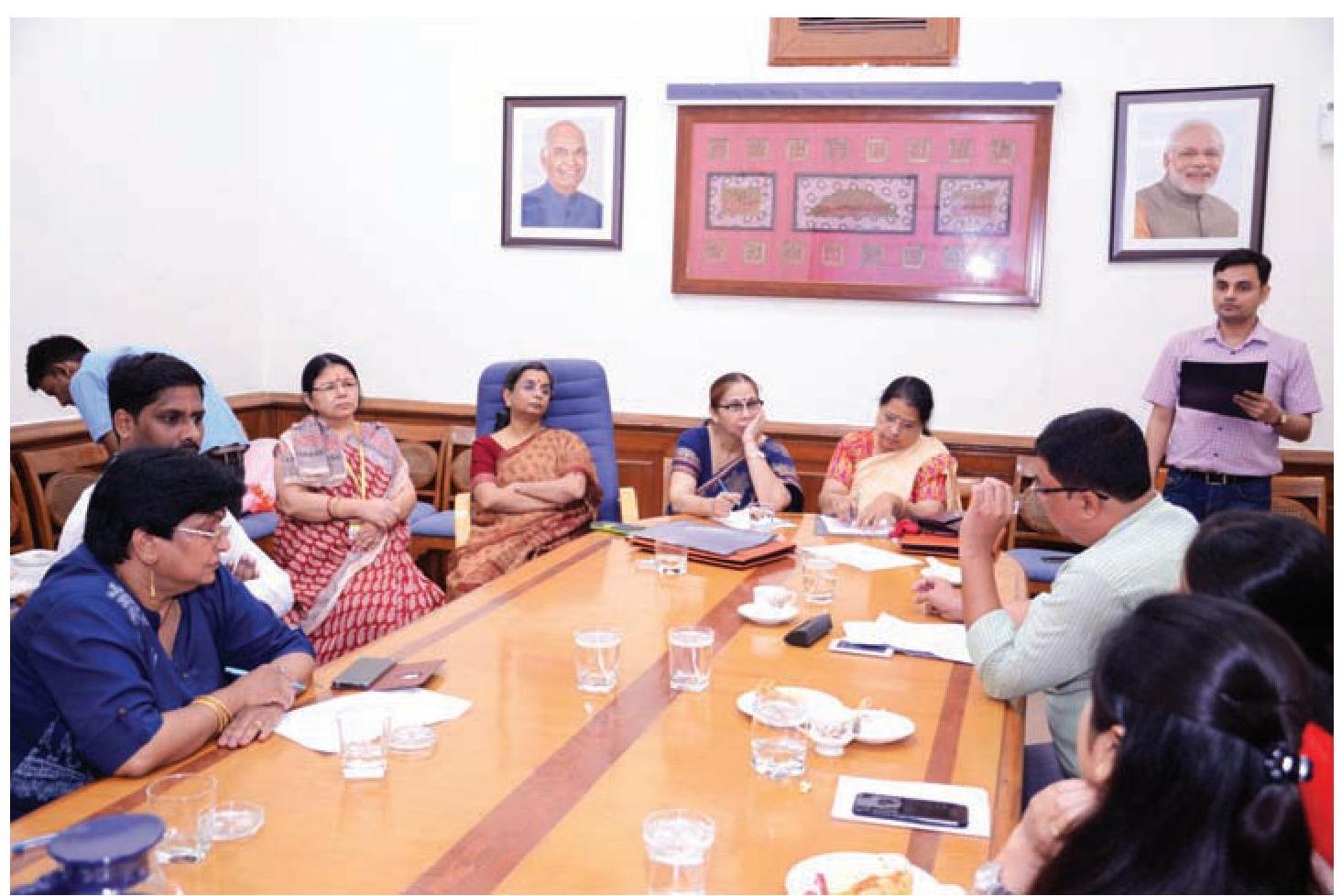
# Competitions held during Hindi Fortnight.
17.7 HINDI IN TRAINING INSTITUTIONS
The two Training Institutions under the Ministry viz. Lal Bahadur Shastri National Academy of Administration (LBSNAA), Mussoorie and the Institute of Secretariat Training and Management (ISTM), New Delhi have made considerable progress in providing the training material in Hindi. In LBSNAA, the teaching material of the main subjects are provided in book form and translation of the lecture notes of the topics taken by the faculty members is provided immediately on the demand of trainee officers. Institute of Secretariat Training and Management (ISTM) also has its all the training material available in bilingual form.
17.8 MONITORING AND INSPECTION
The progress made in Hindi for effective implementation of the Official Language Policy is reviewed based on the Quarterly Progress Report (QPR) and Annual Assessment Report (AAR). The progress made in the progressive use of Hindi is discussed at length in the quarterly meetings of internal Official Language Implementation Committee in which remedial measures are suggested to remove the shortcomings found.
Besides, Divisions/Sections and the Attached Offices of the Ministry are inspected by Official Language Section of the Department of Personnel and Training in a phased manner and necessary measures are taken and directions are given to overcome the practical difficulties experienced in the course of implementing the Official Language Policy of the Union.
17.9 RAJBHASHA SHIELD YOJANA
With a view to promote cooperative and competitive feeling and synergy among subordinate offices
and headquarters for promoting progressive use of Rajbhasha Hindi in the official work of the Department, an ambitious shield scheme consisting of two parts entitled as Rajbhasha Shield Yojana was launched. The first part is meant for the sections located at Headquarters under which Rajbhasha Shield would be given to the section using Hindi in its official work at a premium with other sections and the officers and employees working there in Hindi would be rewarded. The second part of the scheme is meant for the Subordinate Offices in which provisions have been made to give the Rajbhasha Shield to the Subordinate Office doing its official work in Hindi at a premium with any of the Subordinate Offices. The yojana has created a spirit of competition and dynamism for progressive use of Official Language Hindi among the officers and employees of the Department. Selection of winners for their outstanding work in Hindi for the year 2018-19 has been made wherein AVD Section under the category of sections at headquarters and Lal Bahadur Sashtri National Academy of Administration (LBSNAA) under the category of subordinate offices have emerged as winners. They will be awarded cash prizes and shields at the earliest.
17.10 2 nd Edition of e-Magazine “KAUSHAL”
In a first of its kind initiative, the Department of Personnel and Training started an e-magazine christened as “KAUSHAL” to provide a platform to the officers and employees of the Department to make a creative, conducive and positive environment for progressive use of Hindi Language in official work in the year 2019. This initiative is leading to a keen desire among the officers and employees to give vent to their creative urge in the Hindi language. This is a progressive step to make Official Language Hindi more popular among the
officers and employees of the Department which would go a long way in translating the vision of ‘Sabka Sath Sabka Vikas’ of Government of India into reality by rendering public administration and public service delivery mechanism more inclusive. Hence, this ambitious initiative is helping create a positive synergy among the officers and employees to do their official work in Hindi which in turn will make public administration more
citizen-centric and decentralized with the greater active participation of the citizens. It would also make public administration more responsive and accessible with increased popular participation and two-way communication between the Government and the citizens. The publication of the $2^{\text {nd }}$ edition of the magazine has been finalized and the link of the same has been made available on the website of the Department shortly.
CHAPTER
18
FINANCIAL MANAGEMENT
18.1 Secretariat: The provision is for the expenditure of the Ministry of Personnel, Public Grievances & Pensions in respect of:
a) Department of Personnel \& Training which is entrusted with the work relating to framing/ interpretation of rules and regulations; recruitment, promotion and reservation policy; induction, training and refresher courses for all levels/grades of Civil Services posts; service conditions, career and manpower planning, vigilance, discipline and welfare activities of Central Government servants; investigation and prosecution in corruption cases and other serious crimes; redressal of grievances of public servants.
b) Department of Administrative Reforms \& Public Grievances which is entrusted with matters relating to Administrative Reforms, O\&M and policy, coordination and redressal of grievances including those pertaining to Central Government Agencies; hosting of Civil Service Day, PM’s Award, Chief Secretaries Conference etc.
c) Department of Pension \& Pensioners Welfare which administers all activities relating to retirement benefits including Gratuity, Pension, fringe benefits to pensioners, etc.
18.2 Central Bureau of Investigation:
The provision is for the establishmentrelated expenditure of the Central Bureau of
Investigation which is entrusted with investigation and prosecution in corruption cases against public servants, private persons, firms and other cases of serious crimes. This also includes provision for various projects such as CBI e-Governance, Modernization of Training Centres of CBI, Establishment of Technical and Forensic Support Units, Comprehensive modernization \& purchase of land/ construction of office/ residence buildings for CBI.
18.3 StaffSelectionCommission:Theprovision is for the establishment-related expenditure of the Staff Selection Commission including expenditure on the conduct of examinations for recruitment of staff in Central Ministries/ Departments etc.
18.4 Central Administrative Tribunal:
The provsion is for the establishment-related expenditure of the Central Administrative Tribunal which is entrusted with the redressal of grievances exclusively of public servants. This also includes provision for Purchase of Land and Construction of Building for various Benches of CAT.
18.5 ISTM, LBSNAA \& Training Division:
The provision includes establishment related expenditure of Institute of Secretariat Training \& Management (ISTM), Lal Bahadur Shastri National Academy of Administration (LBSNAA) \& Training Division, DOPT. These Organizations arrange several training programmes including foundation courses, refresher courses, midcareer training, etc. to equip all levels/grades of
Secretarial functionaries with adequate exposure to the latest rules and regulations, aptitude etc., expenditure on domestic/overseas travel, course fees etc. in respect of CSS / CSSS officials who are to undergo mandatory training at ISTM as a precondition for consideration for promotion to next higher grade have also been included centrally in the budget of this Ministry.
18.6 PESB & CIC: The provision is for establishment related expenditure of Public Enterprises Selection Board and Central Information Commission.
18.7 Lokpal: The provision is for the establishment and construction-related charged expenditure for Lokpal.
18.8 Loans to AIS Officers: The provision is meant for reimbursement to State Governments towards House Building Advances paid to All India Service Officers.
18.9 Training Schemes: This also includes provision for Training schemes like Training for all, Domestic Funding for Foreign Training, Upgradation of LBSNAA to a Centre of Excellence, and Augmentation of Training Facilities at ISTM.
18.10 Administrative Reforms \& Pensioners’
Scheme: This also includes Scheme provision for Department of Administrative Reforms \& Public Grievances scheme for Modernisation of Government Offices, Pilot projects on Administrative Reforms which consists of the promotion of e-governance, fostering of good governance, learning from success, sevottam etc. It also includes an allocation for Department of Pension’s scheme “Pensioners Portal”.
18.11 IIPA \& NCGG: This also includes Grants in Aid allocations to Indian Institute of Public Administration and National Centre for Good Governance.
18.12 Autonomous Bodies of DOPT: The provision includes Grants-in-aid assistance to Grih Kalyan Kendra \& Central Civil Services Cultural \& Sports Board.
18.13 This includes fund allocations in respect of CIC’s Construction of Head Office Building and DOPT’s Propagation of RTI Act.
18.14 Organisation Wise RE 2019-20 \& BE 202021 Allocations.
Demand No-73, Ministry of Personnel, Public Grievances \& Pensions
(₹ in crore)
| SI No |
Organisation | Actuals 2018-19 |
BE 2019-20 | Exp up to 31st Dec 2019 |
RE 2019-20 | BE 2020-21 |
|---|---|---|---|---|---|---|
| (A) | (B) | (C) | ||||
| 1 | DoPT | 101.51 | 127.66 | 95.91 | 131.39 | 155.79 |
| 2 | D/o Pensions | 12.50 | 13.75 | 6.89 | 12.90 | 12.77 |
| Establishment | 7.02 | 7.75 | 5.62 | 7.90 | 7.77 | |
| Pensioners’ Portal Scheme |
5.48 | 6.00 | 1.28 | 5.00 | 5.00 |
| $\begin{aligned} & \text { SI } \ & \text { No } \end{aligned}$ | Organisation | Actuals 2018-19 | BE 2019-20 | Exp up to 31 st Dec 2019 | RE 2019-20 | BE 2020-21 |
|---|---|---|---|---|---|---|
| 3 | DARPG | 35.59 | 45.97 | 14.62 | 41.02 | 45.41 |
| Establishment | 12.51 | 14.47 | 9.80 | 14.52 | 15.41 | |
| Scheme for Administrative Reforms | 23.08 | 31.50 | 4.82 | 26.50 | 30.00 | |
| 4 | CBI | 772.59 | 781.01 | 597.48 | 798.00 | 802.19 |
| 5 | Staff Selection Commission | 142.57 | 240.22 | 221.00 | 243.92 | 241.66 |
| Professional Services | 103.63 | 200.00 | 191.56 | 203.86 | 200.00 | |
| 6 | Central Administrative Tribunal |
114.44 | 126.52 | 93.55 | 131.57 | 124.92 |
| 7 | Training Division | 87.69 | 97.36 | 57.01 | 91.16 | 94.06 |
| 8 | Institute of Secretariat Training and Management (ISTM) | 33.44 | 65.95 | 19.85 | 32.38 | 37.33 |
| Establishment | 31.84 | 32.18 | 18.82 | 28.25 | 32.03 | |
| Scheme | 1.60 | 33.77 | 1.03 | 4.13 | 5.30 | |
| 9 | Lal Bahadur Shastri National Academy of Administration (LBSNAA) | 69.78 | 72.60 | 54.39 | 102.38 | 107.06 |
| Establishment | 41.18 | 43.60 | 34.89 | 57.38 | 48.06 | |
| Scheme | 28.60 | 29.00 | 19.50 | 45.00 | 59.00 | |
| 10 | Central Information Commission (CIC) | 26.56 | 26.41 | 16.65 | 24.42 | 30.80 |
| 11 | Public Enterprises Selection Board (PESB) | 4.61 | 5.60 | 3.65 | 5.60 | 5.60 |
| 12 | Lokpal | 0.00 | 101.29 | 10.26 | 18.01 | 74.70 |
| 13 | Indian Institute of Public Administration (IIPA) | 20.74 | 18.00 | 9.00 | 18.00 | 18.00 |
| 14 | National Centre for Good Governance (NCGG) | 4.25 | 4.25 | 4.25 | 4.25 | 4.25 |
| Total | 1426.28 | 1726.59 | 1204.53 | 1655.00 | 1754.54 |
18.15 Details of Central Sector Schemes of this Ministry as per Statement of Budget Estimates (SBE) 2020-21.
Scheme wise allocations are given below:-
(₹ in crores)
| SI.No. | Name of the Programme/ Scheme |
Revenue Or Capital |
Budget Estimates 2019-20 |
Revised Estimates 2019-20 |
Expenditure as on 31 Dec 2019 |
Budget Estimates 2020-21 |
|---|---|---|---|---|---|---|
| 1 | 2 | 3 | 4 | 6 | 7 | 8 |
| I | Training Schemes | |||||
| (a) | Training for All | R | 28.00 | 27.80 | 15.44 | 28.00 |
| (b) | Domestic Funding for Foreign Training |
R | 66.00 | 60.00 | 40.49 | 62.70 |
| (c) | Augmentation of Training Facilities at ISTM |
R | 3.00 | 2.97 | 1.03 | 3.00 |
| C | 30.77 | 1.16 | 0.00 | 2.30 | ||
| (d) | Improvement of Infrastructure and up- gradation of Essential facilities at LBSNAA – Up- gradation of LBSNAA to a Centre of Excellence |
R | 11.00 | 11.00 | 4.80 | 11.00 |
| C | 18.00 | 34.00 | 11.10 | 48.00 | ||
| Total – Training Schemes | 156.77 | 136.93 | 72.86 | 155.00 | ||
| II | Administrative Reforms & Pensioners’ Scheme | |||||
| (a) | Scheme for Administrative Reforms |
R | 31.50 | 26.50 | 4.82 | 30.00 |
| (b) | Pensioner’s Portal | R | 6.00 | 5.00 | 1.28 | 5.00 |
| Total – Administrative Reforms \& Pensioners’ Scheme |
37.50 | 31.50 | 6.10 | 35.00 | ||
| Total | 194.27 | 168.43 | 78.96 | 190.00 | ||
| Revenue | 145.50 | 133.27 | 67.86 | 139.70 | ||
| Capital | 48.77 | 35.16 | 11.10 | 50.30 |
18.16 AUDIT OBSERVATIONS IN RESPECT OF MINISTRY OF PERSONNEL, PUBLIC GRIEVANCES & PENSIONS
18.16.1 Public Accounts Committee
No PAC para is pending in this Ministry.
18.16.2 Comptroller \& Auditor General of India
No C\&AG paras are pending in this Ministry
18.16.3 Statutory Audit Paras
| S.No. | Name of the office | No. of Outstanding paras as on 31/10/2018 |
No. of Outstanding paras as on 31/10/2019 |
|---|---|---|---|
| 1 | Department of Personnel \& Training | 51 | 48 |
| 2 | Staff Selection Commission | 55 | 34 |
| 3 | Union Public Service Commission | 5 | 4 |
| 4 | Institute of Secretariat Training \& Management | 8 | 8 |
| 5 | Department of AR \& PG | 7 | 7 |
| 6 | Deptt. of Pensions \& Pensioners’ Welfare | 9 | 8 |
| 7 | Lal Bahadur Shastri National Academy of Ad- ministration |
19 | 31 |
| 8 | Central Administrative Tribunal | 44 | 38 |
| 9 | Central Vigilance Commission | 15 | 15 |
| 10 | Central Information Commission | 17 | 11 |
| 11 | Central Bureau of Investigation | 153 | 173 |
| Total | $\mathbf{3 8 3}$ | $\mathbf{3 7 7}$ |
All the concerned authorities have been instructed to take steps for early settlement of the audit objections.
CHAPTER
DEPARTMENT OF ADMINISTRATIVE REFORMS AND PUBLIC GRIEVANCES
VISION
- Excellence in governance for the benefit of all citizens.
MISSION
To foster excellence in governance and pursuit of administrative reforms through:
- Improvements in government policies, structures and processes;
- Promoting citizen-centric governance with an emphasis on grievance redressal;
- Innovations in e-Governance;
- Awards and Documentation & dissemination of Best Practices.
OBJECTIVES
- Promoting administrative reforms in government policies and processes;
- Formulation of policy and coordination of issues relating to redress of grievances;
- Dissemination of governance knowledge and best practices;
- Promoting reforms through e-Governance.
EXECUTIVE SUMMARY
19.0 The Department of Administrative Reforms and Public Grievances is the nodal agency of the Government of India for administrative reforms as well as redressal of public grievances relating to the States in general and those pertaining to Central Government agencies in particular. The Department endeavours to document and disseminate successful governance practices by way of audio-visual media and publications. The Department also undertakes activities in the
field of international exchange and cooperation to promote public service reforms. There are 8 Divisions in the Department namely Administrative Reforms, Organization \& Methods, e-Governance, Documentation \& Dissemination, International Exchange \& Cooperation, Administration \& Coordination and Public Grievances and Administrative Reforms Commission (ARC)/eOffice.
19.1 The Department is headed by the Secretary, Department of Administrative Reforms & Public Grievances and Pensions \& Pensioners’ Welfare. Available staff strength is one Secretary, one Additional Secretary, 2 Joint Secretaries, 7 Directors/ Deputy Secretaries and 15 Under Secretary level officers in the Department. An organizational chart of the Department is at Annexure-III. Incumbency position of Under Secretary and above level officers is at Annexure-IV. Information regarding steps taken by this Department for Prevention of sexual harassment of women at workplace and welfare of SC, ST, OBC and Persons with Disability (PwD) are at Annexure-V and Annexure-VI respectively. The Shillong Declaration adopted during the $22^{\text {nd }}$ National e-Governance Conference, 2019 is at Annexure-VII and Mumbai Declaration during the $23^{\text {rd }}$ National e-Governance Conference, 2020 is at Annexure-VIII.
19.2 As per the Government of India Allocation of Business Rules, the following subjects have been allocated to the Department of Administrative Reforms \& Public Grievances:
- Administrative Reforms, including e-Governance and dissemination of best practices.
- Organization and Methods.
- Policy, coordination and monitoring of issues relating to –
(a) Redress of public grievances in general; and
(b) Grievances pertaining to Central Government agencies.
(c) Monitoring of implementation of e-Office in Central Ministries / Departments - (a) Research in public management;
(b) Liaison with State Governments, professional institutions etc. in public management matters. - Administration of Central Secretariat Manual of Office Procedure:
PERFORMANCE (2019-20)
| SI. No. | Objective | Targeted Activities |
|---|---|---|
| 1. | Formulation of policy and coordination of issues relating to redress of grievances. | (1.1) Review of pendency of grievances in Ministries/ Departments/ Organizations (including all subordinate offices) |
| (1.2) Training of CPGRAMS in Ministries. | ||
| (1.3) Capability building of State ATIs for bringing in service delivery in their respective State/ Government/ Department. | ||
| (1.4) CPGRAMS Reforms for user-friendly and faster grievance redressal. | ||
| 2. | Dissemination of governance knowledge and best practices | (2.1) Providing financial assistance to States/ UTs/ CTIs for professional documentation and dissemination of Good Governance practices. |
| SI. No. | Objective | Targeted Activities |
|---|---|---|
| (2.2) Production of documentary films on good governance practices | ||
| (2.3) Publishing of books containing articles on shortlisted and awarded initiatives. | ||
| (2.4) Publication of biannual e-magazine ‘Minimum GovernmentMaximum Governance’ | ||
| (2.5) Organizing of Regional Conferences | ||
| 3. | State Collaboration Initiative | (3.1) DARPG has sanctioned 48 projects to date in various States/UTs. |
| 4. | Redress of public grievance | (4.1) Total no of public grievances disposed of as on 30.11.2019 $-14,95,898$. |
| 5. | Promoting reforms through e-Governance | (5.1) Organizing National Conference on e-Governance and presenting National Awards for e-Governance |
| (5.2) Publishing of Compendium of select papers on issues of e-Governance, a booklet on excellence in e-Governance, a booklet on citations for National e-Governance Award Winners, and a compilation of conference papers. (5.2.1) Publishing of National e-Governance Service Delivery Assessment report (NeSDA). |
||
| 6.* | Transparency/ Service delivery in the Department |
(6.1) A Pilot Project of Study of Citizens’ Charters of two Ministries/Departments viz., Ministry of External Affairs (MEA) and Central Board of Direct Taxes (CBDT) was conducted through Quality Council of India (QCI) for improvement of public service delivery through effective implementation of Citizens’ Charter (6.2) The single objective of the Project was to undertake a diagnostic study of services provided by these two Ministries/ Departments with a view to enhancing the respective Citizens’ Charters by making it more citizen-centric. (6.3) The Citizens’ Charter of Ministries/Departments, as well as States/UTs, is available on goicharters.nic.in. |
| 7.* | Administrative Reforms | (7.1) Prime Minister’s Awards for Excellence in Public Administration. (7.2) Organizing Civil Services Day. (7.3) Development of case studies on best practices. |
| SI. No. | Objective | Targeted Activities |
|---|---|---|
| (7.4) Promotion of Administrative Reforms through simplification of procedure such as the abolition of affidavits and promotion of self-certification. (7.5) Develop Good Governance Index, recommended by Sectoral Group of Secretaries on Governance to present a state-wise comparative picture about the strong and weak areas of service delivery, which would help them in generating performance improvement mechanism. |
||
| 8.* | Improving Internal Efficiency/ Responsiveness. | (8.1) Update departmental strategy to align with Plan priorities/ objectives of the Scheme. |
| 9.* | Ensuring compliance with the Financial Accountability Framework | (9.1) Timely submission of Action Taken Notes on Audit paras of C&AG. (9.2) Timely submission of Action Taken Reports to the PAC Sectt. on PAC Reports. |
| 10. | e-Office Progress | (10.1) 56 Central Ministries and Departments have already achieved the target of complete e-Office. |
| 11. | National Centre for Good Governance (NCGG) | (11.1) The Centre is envisaged to be the apex think-tank that would guide the Government and help in implementing Good Governance Reforms. |
- Mandatory objectives
19.3 FUNCTIONS
(i) Matters relating to administrative reforms.
(ii) Organization of Civil Services Day and Prime Minister’s Awards for Excellence in Public Administration.
(iii) Capacity building, change management and Government Process Re-engineering to provide reform through e-Governance.
(iv) e-Office Mission Mode Project under NeGP.
(v) Organisation of National Conference on e-Governance and National awards on e-Governance.
(vi) Management of Public Grievance Redressal Mechanism.
(vii) Documentation and dissemination of Good Governance Practices – innovations, adaptation and replication.
Important events/achievements of the Department
19.4 Promoting Prime Minister’s Awards for Excellence in Public Administration
The Prime Minister’s Awards for Excellence in Public Administration are awarded by Hon’ble Prime Minister of India to select districts and implementing units under various categories.
For PM’s Awards schemes, 2019 four priority programmes namely (i) National Agriculture
Market (e-NAM) (ii) National Rural Livelihood Mission (NRLM), (iii) SAUBHAGYA (Pradhan Mantri Sahaj Bijli Har Ghar Yojana) and (iv) Mission Indradhanush were identified. Two Awards were also for Organizations of Central/ State Governments / Districts for Innovations in environment conservation, disaster management, water conservation, energy, education and health, women and child-centric initiatives etc., of which one shall be given for innovations by Aspirational districts, under the Aspirational Districts Programme (ADP). Further, three awards were for Officers of the Government of India. The Empowered Committee meeting under the chairmanship of Cabinet Secretary was concluded for shortlisting of awardees. The award function could not be organised on $21^{\text {st }}$ April 2019 due to announcement of Model Code of Conduct due to General Elections to be held in May 2019.
19.5 PUBLIC GRIEVANCES
19.5.1 An online system for grievance redress, called the ‘Centralized Public Grievance Redress and Monitoring System (CPGRAMS) has evolved since 2007. During the year, the Department has extensively used the System to forward public grievances to both the Central Government Ministries/Departments/Organisations as well as the State Governments concerned. The inflow of both Centre and State-related grievances is in two forms (i) through the CPGRAMS and (ii) through the post. The grievances received by post are digitized and sent online through the System as well as by post to the Central Ministries/ Departments/Organisations/State Government concerned.
19.5.2 For better monitoring, analytical reports are generated through CPGRAMS as per requirement.
The format includes receipts, disposal and % disposals with reference to cases pending for 2-6 months, 6-12 months and more than one year.
19.5.3 Public Grievance Mechanism of PMO available on website www.pmoindia.gov.in has been integrated with the pgportal.gov.in. This enables the transfer of grievances lodged to the PMO to the Central Ministries/Departments/ Organisations and State Governments and online monitoring of public grievances through CPGRAMS.
19.5.4 The Public interface of CPGRAMS has been duly integrated with the pensioners’ portal and an option has been provided to the users to lodge pension related grievances to the pensioners’ portal by clicking the relevant option on the pgportal.gov.in
19.5.5 Public grievance mechanism of PMO, the President’s Secretariat, the Directorate of Public Grievances (Cabinet Secretariat), Department of Administrative Reforms & Public Grievances (DARPG) and that of Department of Pensioners’ portal has been duly integrated through CPGRAMS thus enabling grievances lodged to any of these entities to be transferred to the Central Ministries/Departments and State Governments online through CPGRAMS.
19.5.6 Operational trainings on Centralized Public Grievance Redress and Monitoring System (CPGRAMS) are being held regularly by the Department on last Thursday of every month. A system for online registration for this training has been put in place by the Department during the year.
19.5.7 During the period from 2019-2020, seven
intensive review meetings have been held for reviewing the status of pending public grievances in Ministries/Departments/Organisations and expediting action on them.
19.5.8 An Award Scheme for recognizing outstanding performance on CPGRAMS through issue of Certificate of Appreciation is in place. The scheme started in the year 2015 and so far 30 Certificates of appreciations have been awarded to various Ministries/Departments/Organisations during the period.
19.6 Citizens’ Charter
19.6.1 The Department of Administrative Reforms and Public Grievances in its efforts to provide more responsive and citizen-centric governance coordinates the efforts to formulate and operationalize Citizen’s Charters in Central Government as well as State Governments and UT Administrations. It provides guidelines for the formulation and implementation of the Citizen’s Charters. The Citizen’s/Client’s Charter (CC) was first introduced simultaneously in Central Departments and all State Governments in May 1997. The Citizen’s/Client’s Charter of DARPG has been reviewed and updated in February 2019 which has been uploaded on the website of the Department as well as on the “goicharters.nic.in”.
19.7 Sevottam
19.7.1 Sevottam is a generic framework for achieving excellence in public service delivery. It comprises of 3 modules namely, Citizen’s Charter, Grievance Redressal Mechanism and Capability Building for Service Delivery. As part of the Strategic Plan for Capability Building towards implementing Sevottam Quality Management
System, a Scheme for Strengthening of State ATIs/CTIs has been implemented during the $12^{\text {th }}$ Five Year Plan 2012-2017 in Training Institutions in 10 States. This Scheme has been extended for a further period of 3 years till 31.03.2020
19.8 INTERNATIONAL EXCHANGE AND COOPERATION:
19.8.1 The Department works as the nodal point in respect of matters relating to international cooperation in the field of Public Administration and Governance, which includes organizing programmes and visits of the foreign delegations to India and visits of Indian delegations abroad as part of projects / bilateral measures taken up in accordance with the Memorandum of Understandings (MOUs) / Agreements signed between India and other countries (bilateral or multilateral).
19.8.2 Department of Administrative Reforms and Public Grievances as the institutional member and Board member of Commonwealth Association for Public Administration and Management (CAPAM) is actively engaged with various strategic programmes and activities of CAPAM in promoting good governance across the Commonwealth. However CAPAM was winded up in 2019, hence activities under CAPAM will no longer take place.
19.8.3 Under Capacity Building in the field of Public Administration and Governance, the Department organized a Foreign Training Programme on the theme ‘Minimum Government with Maximum Governance’ for a group comprising 12 officers of Government of India and States/UTs including recipients of PM/ National e-Gov Award winners at the Duke University, Duke Center for International Development, Durham, USA during 14-18 January 2019.
19.8.4 The Department also organized Capacity Building Programme for 11 Member delegation led by the Vice-Chairman, Public Services Commission of Gambia, Mrs Awa Auber, from 2-6 December 2019 and for 15 Permanent Secretaries and Secretary Generals of Maldives from 6-13 December 2019 in New Delhi in collaboration with the National Centre for Good Governance
19.9 Promoting Adoption of Selfdeclaration and Self-attestation
19.9.1 Affidavits are required in support of facts given by the applicants for the issue of various certificates. Affidavits impose their own cost on the citizens buying stamp paper, locating a deed writer, payment to the Notary for attestation and, of course, the time and efforts consumed in these processes. On the other hand, affidavits have no particular sanctity in law unless specifically ruled by any statute. The information can be given by way of self-declarations. Affidavits, therefore, can be replaced by self-declaration, which is adequate for the law. Similarly, attestation by the Gazetted officers also can be replaced by selfcertification. The applicant/signatory continues to be responsible for the statement made. Thus the practice of self-declaration/certification needs to be adopted in place of affidavits/ attestation by Gazetted Officers to the extent possible.
19.9.2 In this background the DARPG has persuaded Ministries/Departments of the Govt. of India and the State/UTs to review the requirement of Affidavits and Attestation by Gazetted Officers in various application forms. About 58 Ministries/ Departments of the Central Government and the majority of the States have already abolished the requirement of Affidavit and Attestation by Gazetted officers except where it is required under
a statute. DARPG is pursuing with the Ministries/ Departments of Gol and the State/UTs, which have not adopted this practice through meetings/ letters at the highest level so that citizens at large could get the benefit from the Govt.’s initiative. Even in the case of 58 Ministries who have adopted the processes, efforts would be made to widen and deepen the process across the Ministries/Departments concerned. Abolition of the requirement of Affidavits and Attestation by Gazetted Officers in various services across the country would save money, time and would establish trust between Government and the Citizen.
19.10 Minimum Government Maximum Governance Initiatives (implementation of e-office-Mission Mode Project)
e-Office is one of the Mission Mode Projects (MMPs), under the National e-Governance Plan (NeGP). The project is aimed at significantly improving the operational efficiency of Central Government Ministries and Departments through improvement in the workflow mechanisms and associated with office procedure manuals. The DAR&PG is the nodal agency for implementing the project “e-Office”. Effective steps have been taken to expedite implementation of e-Office in Central Government Ministries/Departments. 56 Central Ministries and Departments have already implemented e-Office fully and other Central Ministries/Departments have also started showing improving trends.
19.11 INITIATIVE FOR SWACHHATA PAKHWADA:
19.11.1 DAR\&PG undertook massive cleanliness drive and activities during the Swachhata
Pakhwada w.e.f. $16^{\text {th }}$ May to $27^{\text {th }}$ May 2019. The Department undertook various activities for the cleanliness of office premises, canteens, toilets, and surrounding areas adjacent to the building during the programme. Poster(s) Competition was organized on the theme ‘Swachh Bharat’ by the Department on this occasion.
19.12 Promoting Documentation and Dissemination of Good Governance Initiatives
The Documentation and Dissemination Division of the Department primarily carries out the activities of documentation and dissemination of good governance practices of Central and State Governments and Union Territory Administration with a view to facilitate sharing of experience with one another and replication elsewhere.
This Department brings out its e-Magazine titled ‘Minimum Government – Maximum Governance’ (MGMG) as an e-Book in its endeavours to document and disseminate successful good governance practices. In the e-Magazine, writeups based on the shortlisted initiatives of PM Awards and National e-Governance Awards instituted by DARPG have been compiled and published on the website of the Department in e-Book form biannually.
19.13 Promoting e-Governance (National e-Governance Awards)
The Department of Administrative Reforms & Public Grievances along with the Ministry of Electronics and Information Technology, in association with one of the State Governments, has been organizing the National Conference on e-Governance every year since 1997. This conference provides a platform for the senior officers of the Government including IT Secretaries of State Governments, IT Managers of the Central Government, and resource persons, experts, intellectuals from the industry and academic institutions, etc. to discuss, exchange views and experiences relating to various e-Governance initiatives.
19.14 CELEBRATION OF INTERNATIONAL DAY OF YOGA
19.14.1 DARPG celebrated $5^{\text {th }}$ International Day of Yoga on $21^{\text {st }}$ June 2019. In this connection, regular Yoga classes in the premises of $5^{\text {th }}$ Floor, Sardar Patel Bhawan during June 2019 where all senior officers including Secretary, AR\&PG and other officers/officials participated. Officer/officials of this Department also participated in the $5^{\text {th }}$ International Day of Yoga held on $21^{\text {st }}$ June 2019 at different places.
CHAPTER
20
ADMINISTRATIVE REFORMS
Civil Services Day and Prime Minister’s Awards Scheme for Excellence in Public Administration
20.1 Government of India celebrates April 21 every year as ‘Civil Services Day’ to rededicate themselves to the cause of citizens and renew their commitment to public service and excellence in work. This date coincides with the date when the first Home Minister of Independent India Sardar Vallabh Bhai Patel addressed the first batch of Indian Administrative Service Officers at Metcalfe House New Delhi. The first such function was held in Vigyan Bhavan, New Delhi on $21^{\text {st }}$ April 2006. On this occasion, the Hon’ble Prime Minister conferred ” Prime Minister’s Awards for Excellence in Public Administration” to acknowledge, recognize and award the extraordinary and innovative work done by officers of the Central and State Governments including Districts. In 2019 CSD could not be held due to election proceedings.
Prime Minister’s Awards for Excellence in Public Administration, 2019
20.2 Four priority programmes namely (i) National Agriculture Market (e-NAM) (ii) National Rural Livelihood Mission (NRLM), (iii) SAUBHAGYA (Pradhan Mantri Sahaj Bijli Har Ghar Yojana) and (iv) Mission Indradhanush were identified for PM’s Awards schemes. Two Awards were also for Organizations of Central/ State Governments / Districts for Innovations in environment conservation, disaster management, water conservation, energy, education and health,
women and child-centric initiatives etc., of which one shall be given for innovations by Aspirational districts, under the Aspirational Districts Programme (ADP). Further, three awards were for Officers of the Government of India.
20.3 Application for PM Awards is received online on a designated portal and evaluated by three hierarchical Committees i.e. Screening Committee chaired by Additional Secretary level officers, Expert Committee chaired by Secretary, Department of AR&PG and Empowered Committee chaired by Cabinet Secretary. Citizens’ feedback of shortlisted Districts/Organizations obtained through Call Centre, spot study reports and presentation/interaction by the Districts etc. are taken into account while selecting the candidates for PM Awards.
20.4 The Empowered Committee meeting under the chairmanship of Cabinet Secretary has been concluded for shortlisting of awardees. The awards to be conferred on the date to be decided by Government of India.
State Collaboration Initiatives
20.5 DARPG provides funds to the State Governments under the scheme “State Collaboration Initiatives” with a purpose to build collaboration with State Governments for improving public service delivery. The scheme was revised in 2015-16 to include funding for replication of PM awarded and National e-Governance awarded initiatives.
20.5.1 The objective of the State Collaboration Initiative is to promote and support improvement in public administration for improving service delivery through a programmatic approach which will:
i. Develop collaborative relationships with central ministries, states and other stakeholders
ii. Develop a coherent programme of initiatives which will support and encourage administrative reform and put the citizen at the centre stage, particularly the poor
iii. Build capacity at district, state and centre to ensure optimal use of systems and resources.
Good Governance Index
20.6 Department of Administrative Reform and Public Grievances (DARPG), GOI has taken a lead in developing the proposed Good Governance Index (GGI) recommended by the Group of Secretaries (GoS) on Governance. The proposed Good Governance Index (GGI) would not only present a comparative picture but also yield valuable state-wise insights about their strong and weak areas of service delivery, which would help them in generating performance improvement mechanism. Hon’ble MOS(PP) has launched the Good Governance Index on Good Governance Day i.e. $25^{\text {th }}$ December 2019.
20.6.1 The parameters of Good Governance has been developed through consultation with various stakeholders. A brief detail of activities undertaken as part of the consultation is provided below:
National Consultative Meeting:
A one-day national consultative meeting was organised at Centre for Good Governance (CGG), Hyderabad on 04 May 2017 chaired by Secretary, DARPG, Gol. The purpose of the meeting was to present CGG’s approach and methodology for the design and development of Good Governance Index (GGI) and to seek inputs for refinement in the same.
Meeting with Ministries of Government of India
Three rounds of consultations [(i) 01-02 June 2017 (ii) 08 June 2017 (iii) 15-16 June 2017] have been undertaken with 25 Ministries of Government of India. The purpose of the meetings was to understand their mandate/priorities and focus to achieve Good Governance as well as the availability of state/district-level database to identify suitable indicators which are output and outcome-oriented.
State-Level Consultations
- $\quad$ The purpose of the consultation was to seek the state’s feedback/ comments/suggestions on indicators and make necessary amendments if needed.
- Regional-conference involving Northern states organised by the DARPG, Gol at Nainital during 07-08 July 2017. Second conference involving remaining states was organised on 22 July 2017 at CGG, Hyderabad. Third conference was organized by the DARPG, Gol at Goa during 14-15 September 2017. Fourth consultation was done at Guwahati during 22-23 December 2017.
National Centre for Good Governance (NCGG)
20.7 National Centre for Good Governance was established as an autonomous institute under the aegis of Department of Personnel and Training by upgrading the erstwhile National Institute of Administrative Research, Lal Bahadur Shastri National Academy of Administration Mussoorie. DARPG is the administrative authority for NCGG from 8.11.2017. NCGG has been administratively transferred from DoP&T to DARPG on 08.11.2017.
20.7.1 The Centre is envisaged to be the apex think-tank that would guide the Government and help in implementing good Governance reforms. It seeks to be a high-level institute for research and capacity building to deal with the entire gamut of governance issues from the National to State to the local level and in sectors across the Government.
20.7.2 NCGG is governed by a Governing Body, under the Chairmanship of the Cabinet Secretary, Gol and a Management Committee with Secretary, Department of Administrative Reforms and Public Grievances (DARPG), Gol as the Chairperson.
Objectives of NCGG
- To be a think tank for governance \& policy reforms, cutting across administrative, social, economic and financial spheres.
- To function as a national repository on information on best practices, initiatives and methodologies that promote Good Governance, E-Governance, innovation \& change management within the government;
- To initiate and participate in action research and capacity building on various aspects of
regulatory and development administration, public policy, governance and public management at National/State \& local levels; - To advise on key issues in governance and development synergy across various Ministries/ Departments of Gol, and State Governments;
- To promote sharing and replication of innovative ideas and best practices in Governance.
- To interact with national and international organizations, in and outside government, engaged in research and capacity building in the above spheres.
Mandate of NCGG
To promote Good Governance by:
- Carrying out Action Research/ Studies on issues relating to governance.
- Capacity Building on Public Policy and Governance at both National and International level.
- Organizing consultations, workshops, seminars \& talks to promote improved governance.
- Undertaking initiatives for citizen-centric governance.
Activities of NCGG
Capacity Building Training Programmes (CBTP) on Public Policy and Governance for Neighboring Countries
International
- NCGG has been conducting Capacity Building Training Programme (CBTP) for the Civil Servants of Bangladesh, Myanmar, Maldives and Combodia entrusted by Ministry of External Affairs (MEA), Govt. of India.
- NCGG is also conducting a Capacity Building Training Programme (CBTP) for the Civil Servants of Gambia.
Capacity Building Training Programmes (CBTP) on Public Policy and Governance for the States/UTs
National
- NCGG has been conducting Training Programmes on Public Policy and Governance for the Officers of State Civil Servants for Odisha, Madhya Pradesh, Rajasthan, Manipur, Mizoram & Sikkim.
- NCGG is currently engaged to train the officers from Government of Gujarat on Comprehensive Training Programme -Public-Private Partnerships (PPP).
- Capacity Building Training Programmes for the senior officials of Government of Jammu \& Kashmir was conducted in January 2020 at Jammu in the filed of General Financial Rules 2017 and e-Procurement focus with GeM.
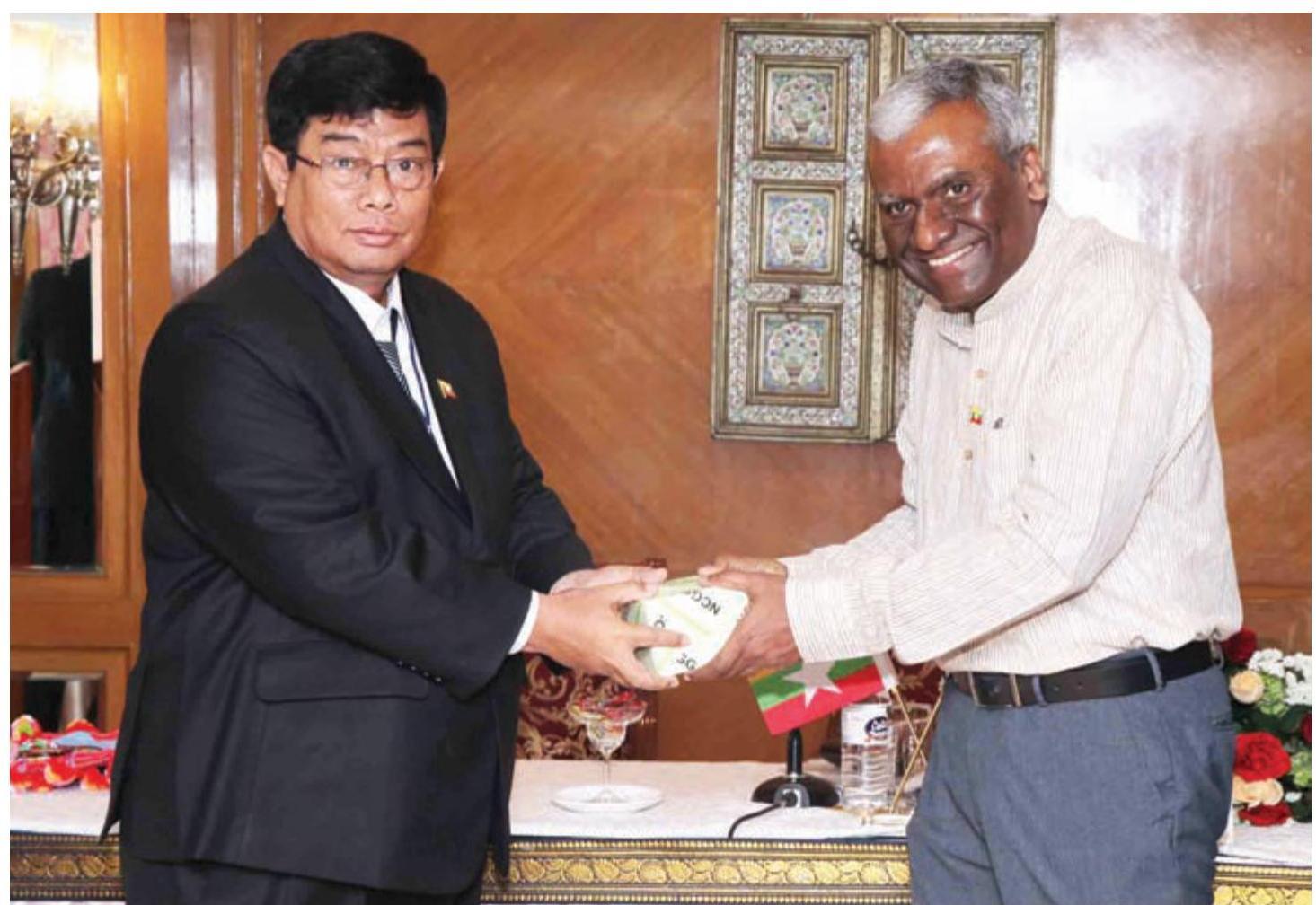
Mid-Career Training Programme for District Administrators of Myanmar (25 th March 2019 – 06 th April 2019)
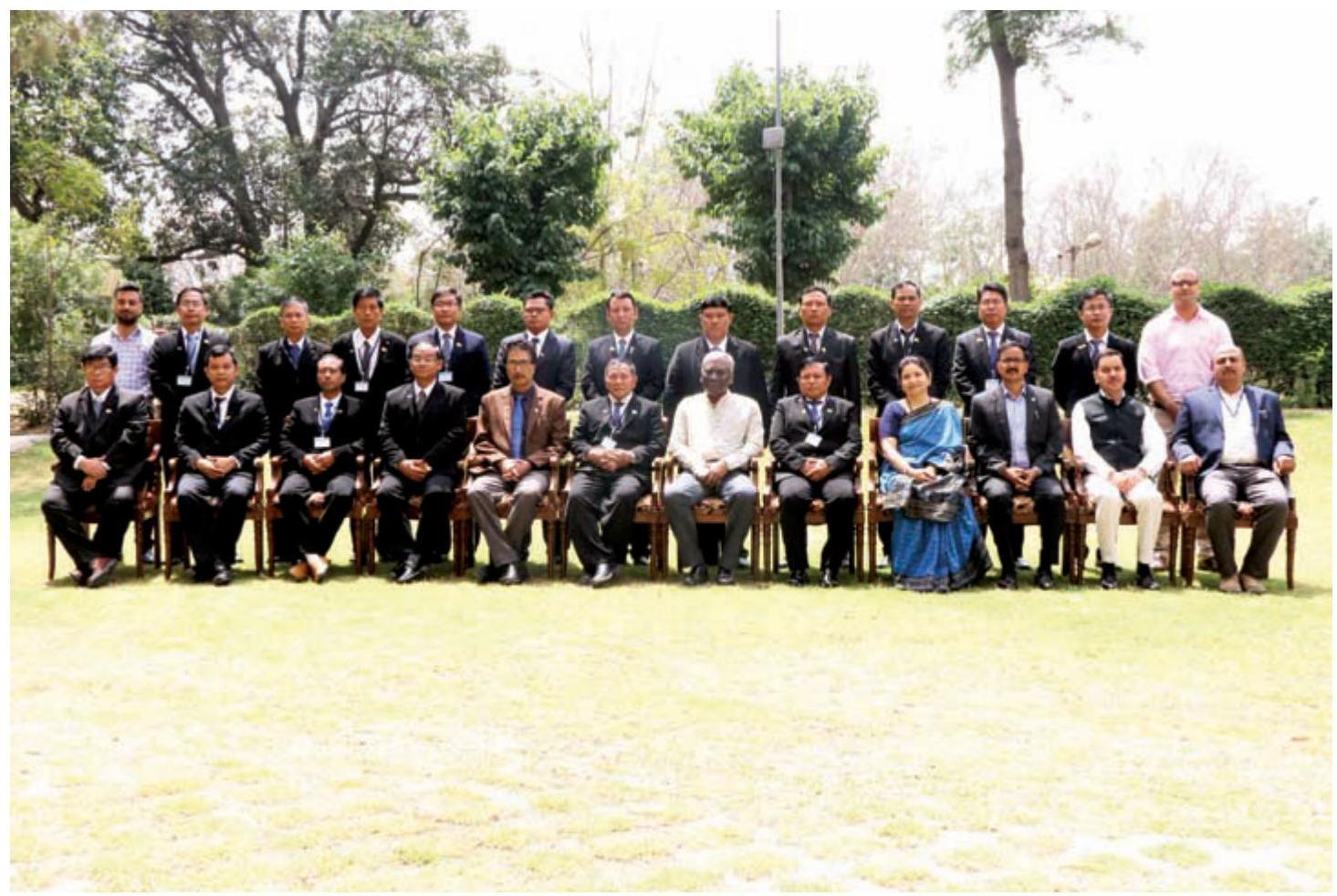
Group Photograph of Mid-Career Training Programme for District Administrators of Myanmar
(25th March 2019 – 06th April 2019)
PUBLIC GRIEVANCES
MANDATE
The Public Grievances Division is responsible for issuing policy guidelines and coordinating & monitoring of issues regarding redress of public grievances for the Central Government. In accordance with the federal principle of governance, the grievances relating to States are forwarded to concerned State Government for appropriate action. To provide more responsive and citizencentric governance, the PG Division coordinates efforts to formulate and operationalize the Citizen’s Charters of various Ministries/Departments/Organisations and State Governments. The PG Division also handles Sevottam which is a part of a citizen-centric quality management framework for better service delivery.
21.1 The Allocation of Business Rules, 1961, allocates to DARPG inter-alia, the responsibility for Policy, Coordination and Monitoring of issues relating to (a) Redress of Public Grievances in general and (b) Grievances pertaining to Central Government Agencies, in particular. The Public Grievance Division is responsible for this activity since December 1987. From 1997, the Division has also been made responsible for several Citizen-Centric Initiatives under the platform of ‘Responsive Government’. These include the Citizens’ Charter, and Quality Management System (QMS) framework called Sevottam, for bringing improvement in public service delivery continuously.
21.2 The management of Public Grievances today envisages a reduction in grievances, by bringing continuous improvement in Public Service Delivery. The extension of the Quality Management System ‘Sevottam’ in the states envisages strengthening of the State ATIs.
Under this 10 State ATIs are being funded by the Department.
21.3 The Public Grievances Division has undertaken various activities during the year, some of which are on-going activities from the previous years, to improve the grievances redressal mechanism and to provide citizencentric governance.
21.3.1 CPGRAMS – An online system for grievance redress, called the ‘Centralized Public Grievance Redress and Monitoring System’ (CPGRAMS) has evolved since 2007. CPGRAMS facilitates forwarding of public grievances received online from the citizens to both the Central Government Ministries/Departments/Organisations as well as the State Governments concerned. The inflow of these Centre and State-related grievances are in two forms (i) online registered grievances through CPGRAMS and (ii) offline grievances received through post. The grievances received through
the post are digitized, uploaded on CPGRAMS and forwarded online through the System as well as by post to the Central Ministries/Departments/ Organisations/State Government concerned. At present, the Department has undertaken CPGRAMS Reforms in the top 20 grievance receiving Ministries/Departments. The CPGRAMS reforms envisage ensuring user-friendly lodging of grievance by a citizen and enabling navigation of the grievance to reach the field office responsible for the resolution of the same. CPGRAMS Reforms
will streamline the grievance redressal mechanism so that the grievances reach the rightful redressal Office, surpassing the line offices. The broader salient features of the CPGRAMS Reforms 7.0 are that it is citizen-friendly as there is a questionnaire guided registration process. Besides, there is a provision of lodging a grievance which will be automatically forwarded to field level directly. The system will also improve grievance redress time and lodging of grievance is done through dropdown menus.
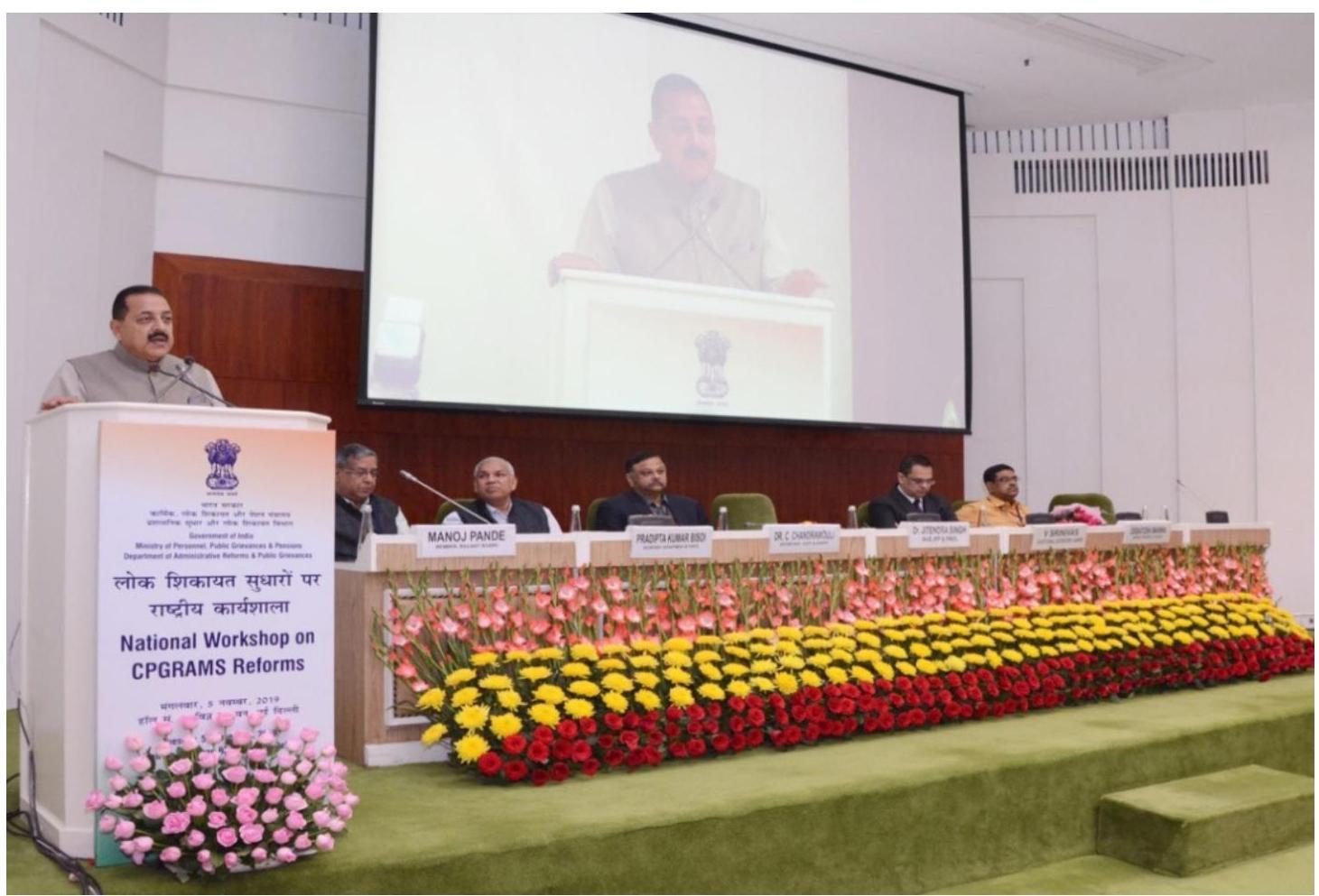
Address by Hon’ble Minister in the National Workshop on CPGRAMS Reforms held on 05.11.2019 at Vigyan Bhawan.
21.3.2 The CPGRAMS Reforms version 7.0 has been launched in the Department of Posts on $25^{\text {th }}$ September 2019 and in the Departments of Telecommunications and Financial Services
(Banking & Insurance Division) on $5^{\text {th }}$ November 2019 in the National Workshop on CPGRAMS Reforms held at Vigyan Bhawan, New Delhi.
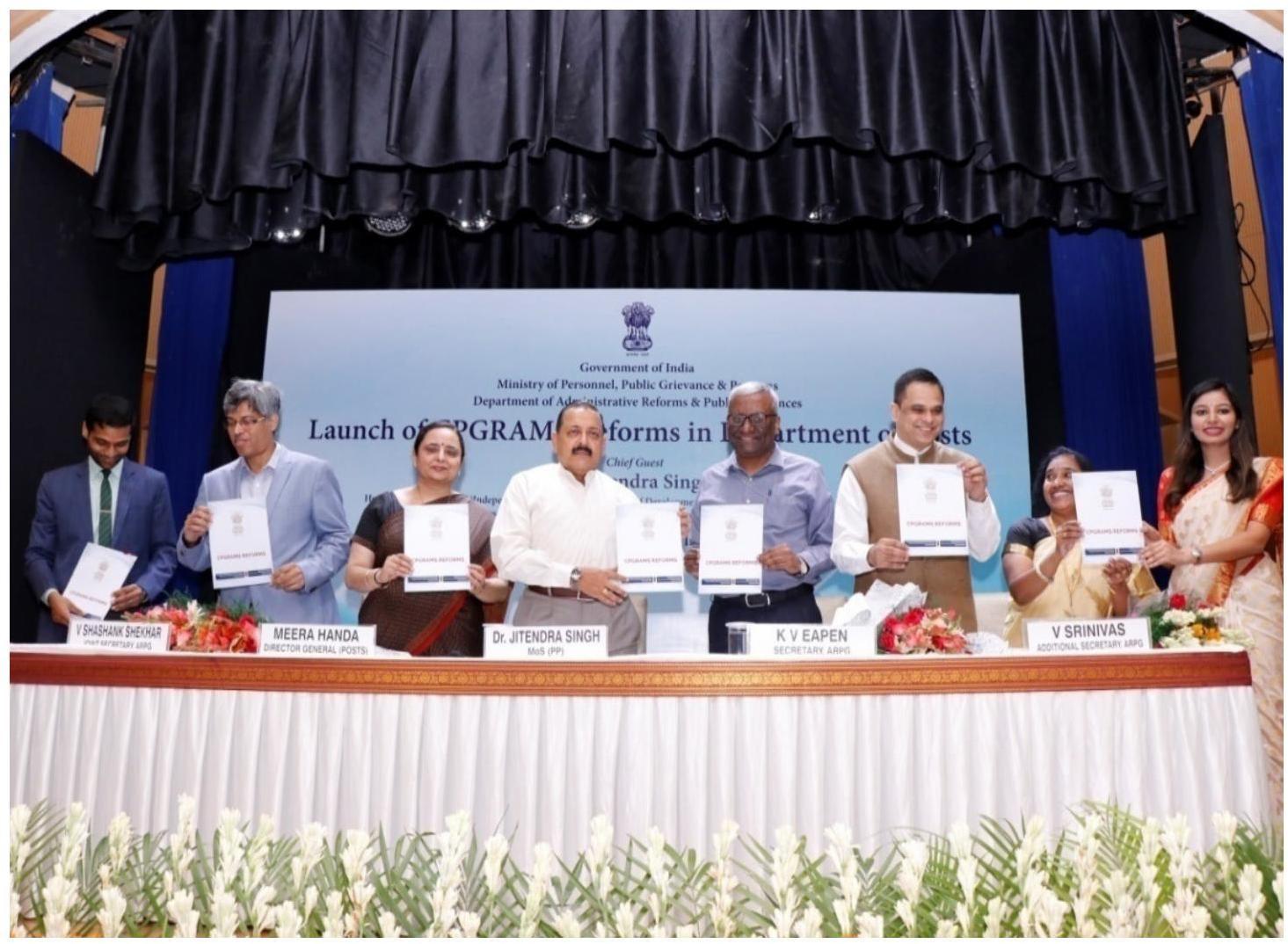
Launch of CPGRAMS Reforms in the Department of Posts by Hon’ble Minister on 25.09.2019 at Dr Ambedkar International Centre
21.3.3 Citizens can use a Mobile App for lodging of public grievances and the action Status can also be viewed on the mobile itself. This mobile app is integrated with Unified Mobile Application for New-age Governance (UMANG). The app is available in both Android and iOS versions. A new mobile app called My Grievance is also available which is independent of CPGRAMS.
21.3.4 Public grievance mechanism of PMO, the President’s Secretariat, the Directorate of Public Grievances (Cabinet Secretariat), Department
of Administrative Reforms & Public Grievances (DARPG) and the Pensioners’ portal has been duly integrated through CPGRAMS thus enabling grievances lodged to any of these entities to be transferred to the Central Ministries/Departments and State Governments online through CPGRAMS. The CPGRAMS interlinks 86 Central Ministries/ Departments/ Organisations and 37 States /UTs. There are more than 51,000 sub-ordinate users listed on it which includes subordinate and field officers also.
Year-wise Receipts/Disposal graph on grievances received on CPGRAMS Receipt/Disposal graph of Total receipts in CPGRAMS, as on 30-11-2019
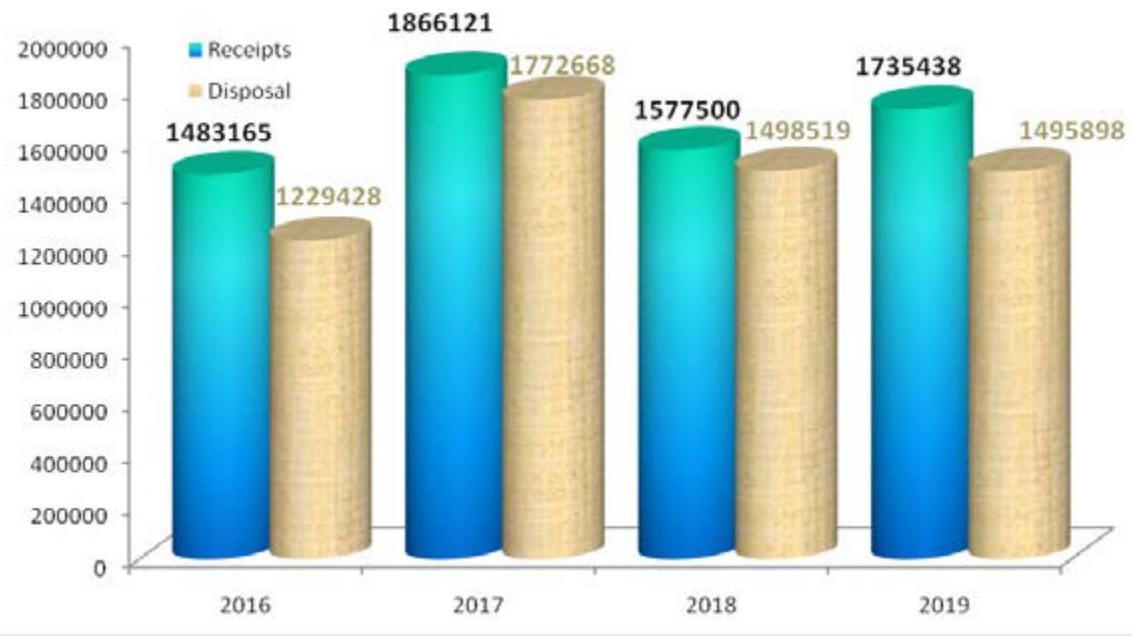
Year-wise Receipts/Disposal graph for Public Grievances received by GOI Organizations (Centre)
Total No of Organizations registered in CPGRAMS: 51000
Total Ministry/Departments/States/UTs: 123
Total grievances sent to States by DARPG in 2019-20 as on 1.1.2019 to 30.11.2019: 15126 (Total No. of Grievances Received by DARPG is 36958 out of which 5048 have been received Manually/by Post)
Receipt/Disposal graph of GOI Organizations in CPGRAMS, as on 30-11-2019
Receipts Receipts and Disposals as on 30.11.2019
Disposal
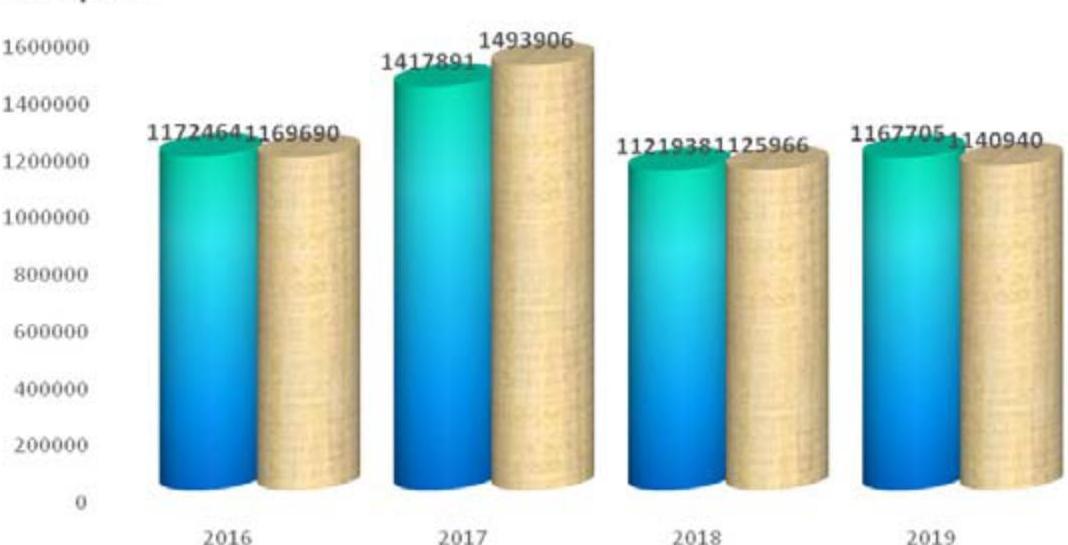
Receipt/Disposal graph of grievances received in States on CPGRAMS, as on 30-11-2019
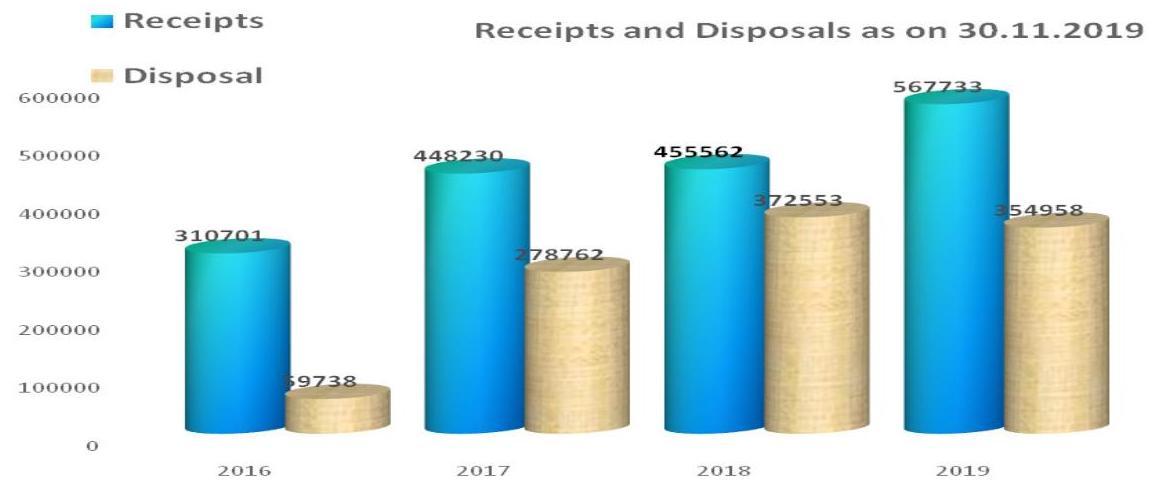
21.3.5 During the year, the Division has extensively used the System to forward public grievances to the State Governments. The inflow of State related grievances is in two forms (i) through the CPGRAMS and (ii) through the post. The grievances received by post are digitized and sent both through the System as well as by post to the State Government concerned. During 201920 a total of 15,126 grievances have been sent to State Governments by Department of ARPG. Out of these, 13100 were received electronically, and
2026 were received by post or given in person by the complainants.
21.3.6 The grievance portal of J&K ‘Awaz-e-Awam’ has been duly integrated with the CPGRAMS. The grievances lodged on CPGRAMS which are related to J \& K will now directly be forwarded to Awaz-e-Awam portal and this will facilitate faster redressal of grievances. A similar integration proposal with the Government of Madhya Pradesh is being worked out presently by the Department.
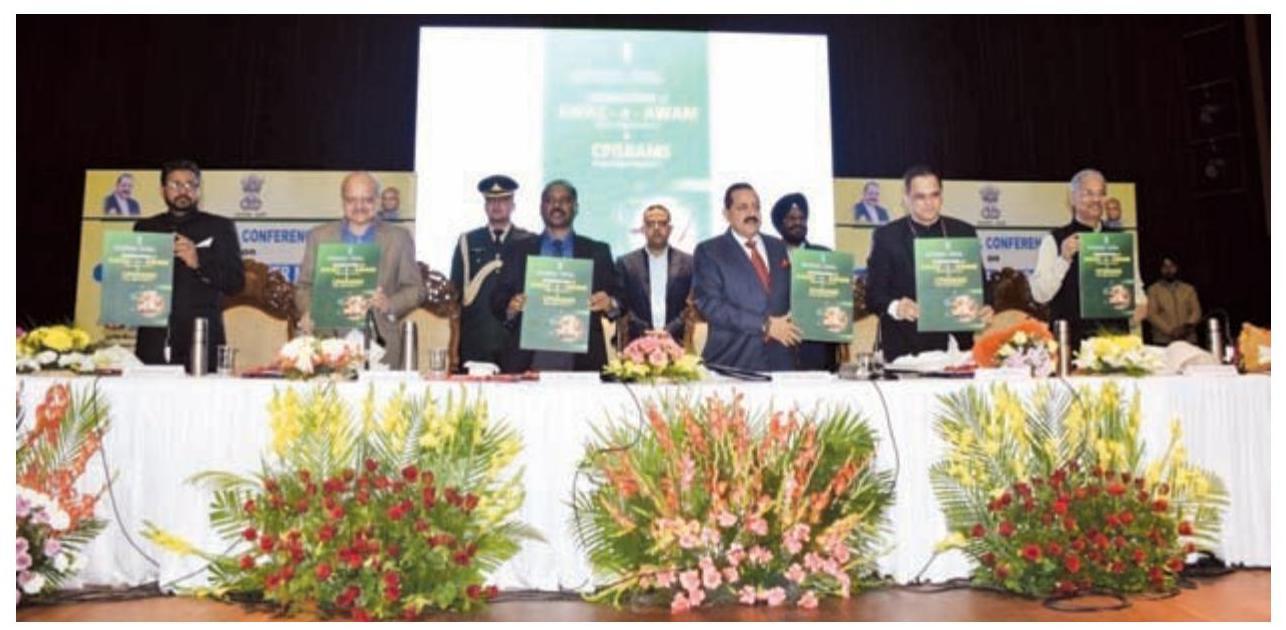
Launch of Integration of Awaz-e-Awam with CPGRAMS by Hon’ble Minister and Lt. Governor of UT of J\&K on 30.11.2019 in Jammu.
21.3.7 During the year 2019-20 (up to November 2019), ten operational trainings on CPGRAMS have been conducted. The training imparted relates to new features and improvements in CPGRAMS. Problems which are being faced by the nodal Public Grievance Officers during the redressal of grievances are also taken up and resolutions on the same imparted during the training sessions.
21.3.8 The Department holds regular meetings to monitor and review the pendency of grievances and for expediting action on them. During the period 2019-20, a total of seven review meetings were held for reviewing the status of pending public grievances in 86 Central Ministries/Departments and 10 State Governments.
21.3.9 An Award Scheme has been launched for recognizing outstanding performance on CPGRAMS through issue of Certificate of Appreciation. The Scheme takes into consideration the number of grievances disposed of by the Ministries/ Departments/ Organizations. The scheme commenced in the year 2015 and so far 30 Certificates of appreciations have been awarded to various Ministries/Departments/ Organisations.
21.4 PUBLIC SERVICE DELIVERY
21.4.1 One of the citizen-centric initiatives that were taken by this Department was to develop a Quality Management System (QMS) framework called ‘Sevottam’ for bringing excellence in service delivery by Government organizations. This has institutionalized an assessmentimprovement framework for improving the quality of service delivery on a continuous basis through the involvement of Ministries / Departments
and citizens. Sevottam comprises of 3 modules in relation to a public service organization viz., (a) Citizens’/Clients’ Charter that specifies the service delivery standards (b) Grievance Redress Mechanism that gets activated if the service delivery is not as per standards in the charter, and (c) Service Delivery Capability of the organization to delivery service as per standards in the charter.
21.4.2 As part of the Strategic Plan for Capability Building towards implementing Sevottam QMS, a Scheme for Strengthening of State ATIs/CTIs was implemented during the $12^{\text {th }}$ Five Year Plan 20122017 in ATIs/Govt. approved Training Institutions in 10 States. This Scheme has been extended for a further period of 3 years till 31.03.2020. The Scheme has resulted in building capacity of the ATI by enabling conducting of training programmes and workshops by the ATIs for sensitizing the officers of the State Government for implementation of Citizens’ Charter and Grievance Redress Mechanism.
21.5 CITIZENS’/ CLIENTS’ CHARTERS
21.5.1 In lieu of decision taken in Conference of Chief Ministers held on 24 May 1997 presided by Hon’ble Prime Minister, formulation of Citizen’s Charter by Central & State Governments began. The process started with sectors having a large public interface (e.g. Railways, Telecom, Posts, Public Distribution Systems). Charters were required to include (i) standards of service (ii) time limits for public service delivery (iii) avenues for grievance redress. Guidelines for formulating the Charters as well as a list of do’s and don’ts were communicated to various government departments/organisations by DARPG to enable them to bring out focused and effective
charters. A comprehensive Website of Citizens’ Charter, www.goicharters.nic.in was launched by the DARPG on 31 May 2002 which apart from guidelines contains the Citizens’ Charters existing in Ministries/Departments/States/ UTs/ Organisations. A Pilot Project of Study of Citizens’ Charters of two Ministries/Departments viz., Ministry of External Affairs (MEA) and Central Board of Direct Taxes (CBDT) was conducted for the improvement of public service delivery through effective implementation of Citizens’ Charter. The single objective of the Project was to undertake a diagnostic study of services provided by these two Ministries/Departments with a view to enhancing the respective Citizen’s Charters by making it more citizen-centric. The Study has been completed and the final report of the study has been shared with MEA and CBDT. The MEA has already revised the Citizen’s Charter based on the recommendations made in the study. CBDT has already initiated action for revising their Citizen’s Charters as per the recommendations made in the Study.
21.6 ONLINE HACKATHON FOR CITIZEN GRIEVANCE REDRESSAL
21.6.1 The Department is conducting an Online Hackathon for inviting innovative solutions for the Citizen Grievance Redressal Mechanism. The basic objective is to provide technology-driven solutions to improve the grievance redressal mechanism in the country. The Hackathon was launched by Hon’ble Minister on 05.11.2019 in the National Workshop on CPGRAMS Reforms. The online registration is for 60 days.
21.6.2 The problem statements for the Hackathon are as under:
- Create a Chatbot that will help the Citizens to resolve their common queries related to filing a Grievance in the CPGRAMS portal (https://pgportal.gov.in) and expedite the smooth submission of grievances.
- Making the redressal process more robust and data-driven to reduce the Grievance submission and resolution lifecycle. Technology such as AI and ML could be used.
- $\quad$ Improvise the quality of public grievance disposals for the greater satisfaction of citizens.
- Create predictive models using datasets to smooth the Grievance redressal mechanism.
21.6.3 The expected outcomes categories are (i) Chatbot; (ii) User Story Map/Pipeline; (iii) Application system (web and mobile) and (iv) Predictive Models. The online Hackathon contest is open to Students, Indian startups, Indian Companies, Research Scholars/Researchers/ Academic Experts and Individuals. More than 4,00,000 data sets on the public grievances received on CPGRAMS has been made available to the contestants.
21.6.4 On closing of the online submission, entries would be evaluated and shortlisted in four categories i.e. Chatbot, User Story Map/Pipeline, Application System (web and mobile) and Predictive Models. Potential solution prototypes would be initially screened by a screening committee and those shortlisted therein will be selected for being awarded by an eminent Jury comprising experts from Government, Academia, Community, Industry, etc., Selected entries from
online challenge would be appropriately awarded and recognized. All shortlisted entries would be
given appreciation certificate.
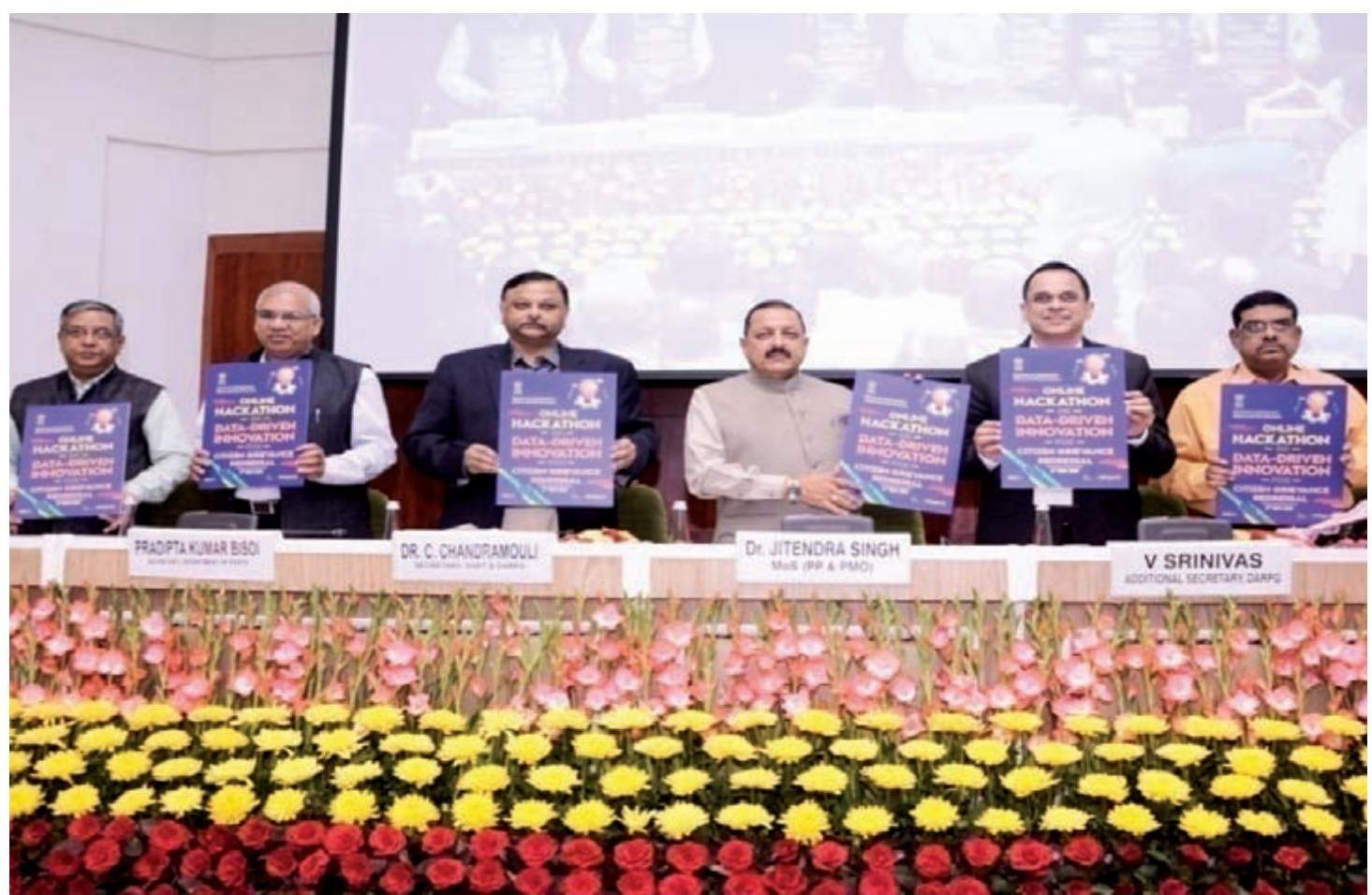
Online Hackathon on Data-Driven Innovation for Citizen Grievance Redressal made live by Hon’ble Minister on 05.11.2019 at Vigyan Bhawan, New Delhi.
CHAPTER
ORGANISATION AND METHODS DIVISION
MANDATE
- Formulation and simplification of office procedures.
- Publication and updating of the paper-based Central Secretariat Manual of Office Procedures (CSMOP), electronic-based Central Secretariat Manual of e-Office Procedure (CSMeOP) and Record Retention Schedule (RRS).
- Aiding and advising the Central Ministries/Departments and States/UTs Governments on O&M aspects.
- Implementation of the Plan Scheme of Modernization of Central Government offices located in the city of Delhi and NCR.
Central Secretariat Manual of Office Procedure (CSMOP)
22.1 The Department of Administrative Reforms \& Public Grievances brought out the Fifteenth Edition of the Central Secretariat Manual of Office Procedure, 2019 (CSMOP, 2019) on the Occasion of Good Governance Day i.e. $25^{\text {th }}$ December 2019. In this edition of the Manual, the procedures laid down in the Central Secretariat Manual of Office Procedure, 2015 and the Central Secretariat Manual of Electronic Office Procedure 2012 have been aligned in light of advances made in digital governance. The salient features of draft CSMOP 2019 are as under:-
- The Manual has 16 chapters. Definitions have been categorized as Glossary and given at the end of the CSMOP 2019.
- Decision making in Government, Knowledge
Management, and Digitization Framework are three new Chapters.
3. Provision for officers of the rank of DS and above to obtain Virtual Private Network.
4. Provision for officers of the rank of ASO and above to obtain Digital Signature Certificate (DSC)
5. The e-Office procedure has been incorporated in the form of e-boxes in the chapters wherever applicable
Modernization of Government Offices Scheme
22.2 In order to give catalytic effect to the modernization of offices as an overall process of Administrative Reforms, the DAR\&PG is implementing a Plan Scheme for Modernization of Government offices located in the city of Delhi
since the year 1987-88. The scheme has been extended to the Government offices located in NCR in the year 2018.
22.3 Under the Scheme the Department provides $75 %$ financial assistance of the total cost of the project which is recommended by an
Inter-Ministerial Screening Committee and the beneficiary has to chip in with $25 \%$ of the cost. Since the year 1987-88 till date, the DAR&PG has extended financial assistance of 87 crores approximately for financing 486 modernization projects/proposals.
CHAPTER
E-GOVERNANCE
23.1 e-Governance
Department of Administrative Reforms & Public Grievances and Ministry of Electronics \& Information Technology, Government of India, in association with one of the State Governments, have been organizing the National Conference on e-Governance every year since 1997. This Conference provides a platform to the senior officers of the Government including IT Secretaries of State Governments, IT Managers of the Central Government, Resource Persons, Experts, Intellectuals from the industry and academic institutions etc. to discuss, exchange views and experiences relating to various e-Governance initiatives.
23.2 22nd National Conference on e-Governance
The $22^{\text {nd }}$ National Conference on e-Governance has been jointly organized by the Department of Administrative Reforms and Public Grievances (DARPG), in association with Ministry of Electronics and Information Technology (MeitY), Government of India and Meghalaya on 8-9th August 2019 at the State Convention Centre, Shillong. This forum brought together about 535 delegates and senior officials from as many as 28 States and all the Union Territories along with regional experts, development partners, business organizations and other key stakeholders. Exhibitions were also being held on the sidelines to showcase India’s achievement in the field of e-Governance, along with Hall of Fame of the award winners. Besides, there were discussions on six sub-themes in
plenary sessions and two sub-themes in three Breakout sessions during the Conference.
The theme of the conference-`Digital India: Success to Excellence’, focused primarily on providing considerable momentum to e-Governance initiatives in the North-East Region and also to provide an opportunity to civil servants and others to showcase their successful interventions in providing end-to-end service delivery. Discussions were held on the following sub-themes in Plenary and Breakout sessions during the Conference:
Sub-themes-
- India Enterprise Architecture (IndEA)
- Digital Infrastructure
- Inclusion and Capacity Building
- Emerging Technology for Practitioners
- Secretariat Reforms
- National e-Governance Service Delivery Assessment (NeSDA)
Breakout Session sub-themes-
- One Nation – One Platform
- End to End Digital Services: IT initiatives by some of the State Governments
The Shillong Declaration was read out by Shri V. Srinivas, Additional Secretary, DARPG, Government of India. The Conference has unanimously adopted the Shillong declaration after intensive deliberations during the sessions held over two days (Annexure-VII).
The event was attended by a large number of delegates from the Government of India, State
Governments, Industry, Academia, and Private Sector.
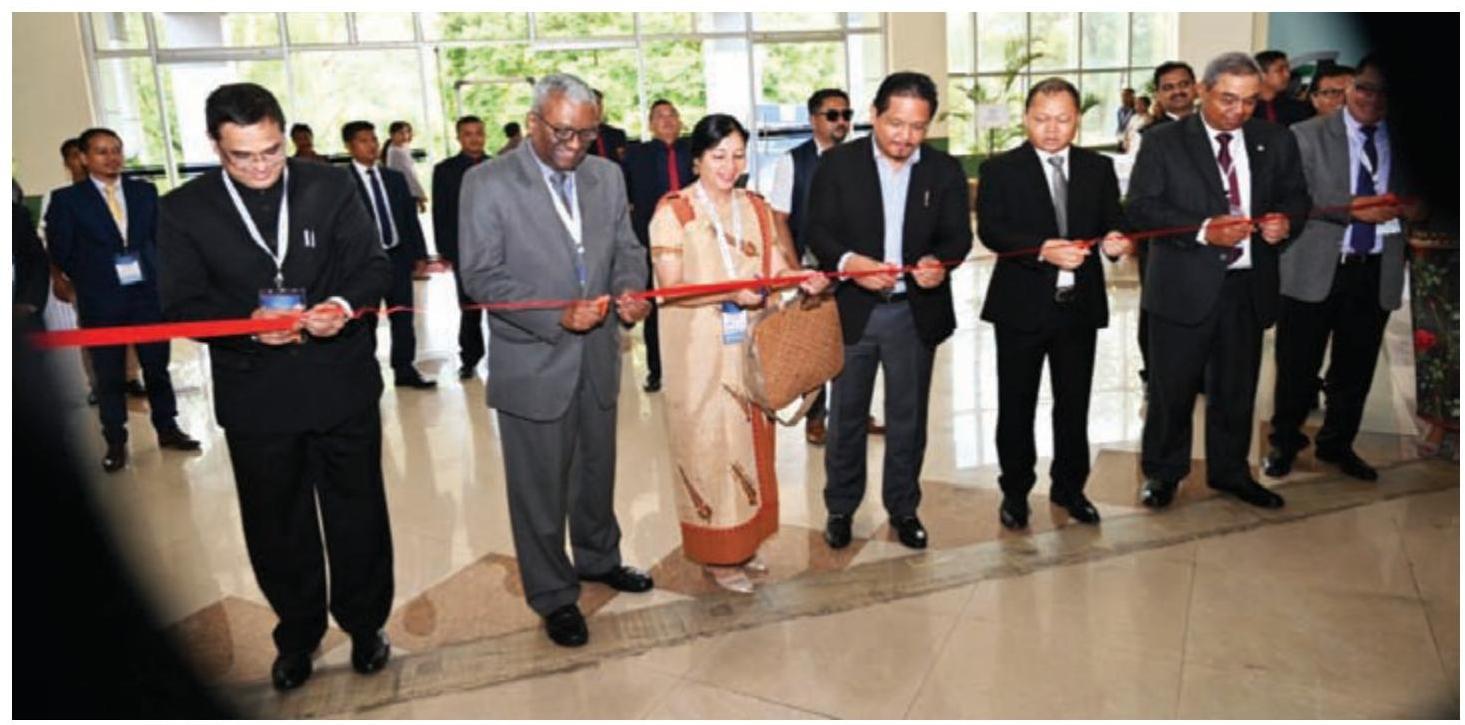
Inauguration of the Exhibition of the $22^{\text {nd }}$ National Conference on e-Governance. From left to right Shri V. Srinivas, Additional Secretary, DARPG, Govt of India; Shri K.V. Eapen, Secretary, DARPG, Govt of India; Ms R.V. Suchiang, Additional Chief Secretary, Govt. of Meghalaya, Shri Conrad K Sangma, Chief Minister of Meghalaya; Shri Hamletson Dohling Minister of Urban Affairs Department, IT&C Department, Govt. of Meghalaya; Shri P.S. Thangkhiew, Chief Secretary to the Govt. of Meghalaya
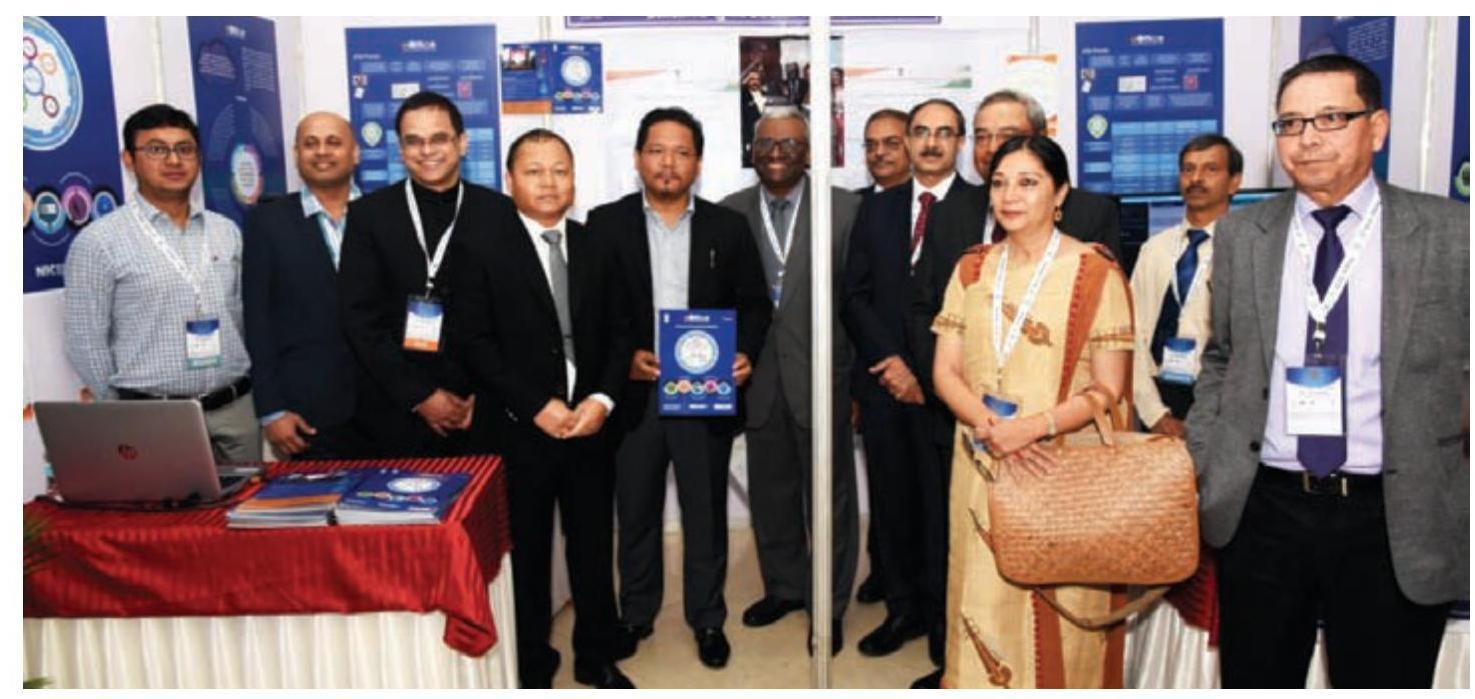
Exhibitions stall of DARPG. From left to right Shri V. Srinivas, Additional Secretary, DARPG, GoI; Shri Hamletson Dohling, Minister of Urban Affairs Department, IT\&C Department, Govt. of Meghalaya; Shri Conrad K Sangma, Chief Minister of Meghalaya; Shri K.V. Eapen, Secretary, DARPG, GoI; Shri Ajay Prakash Sawhney, Secretary, MeitY, GoI; Shri P.S. Thangkhiew, Chief Secretary to the Govt. of Meghalaya; Ms R.V. Suchiang, ACS, Govt. of Meghalaya
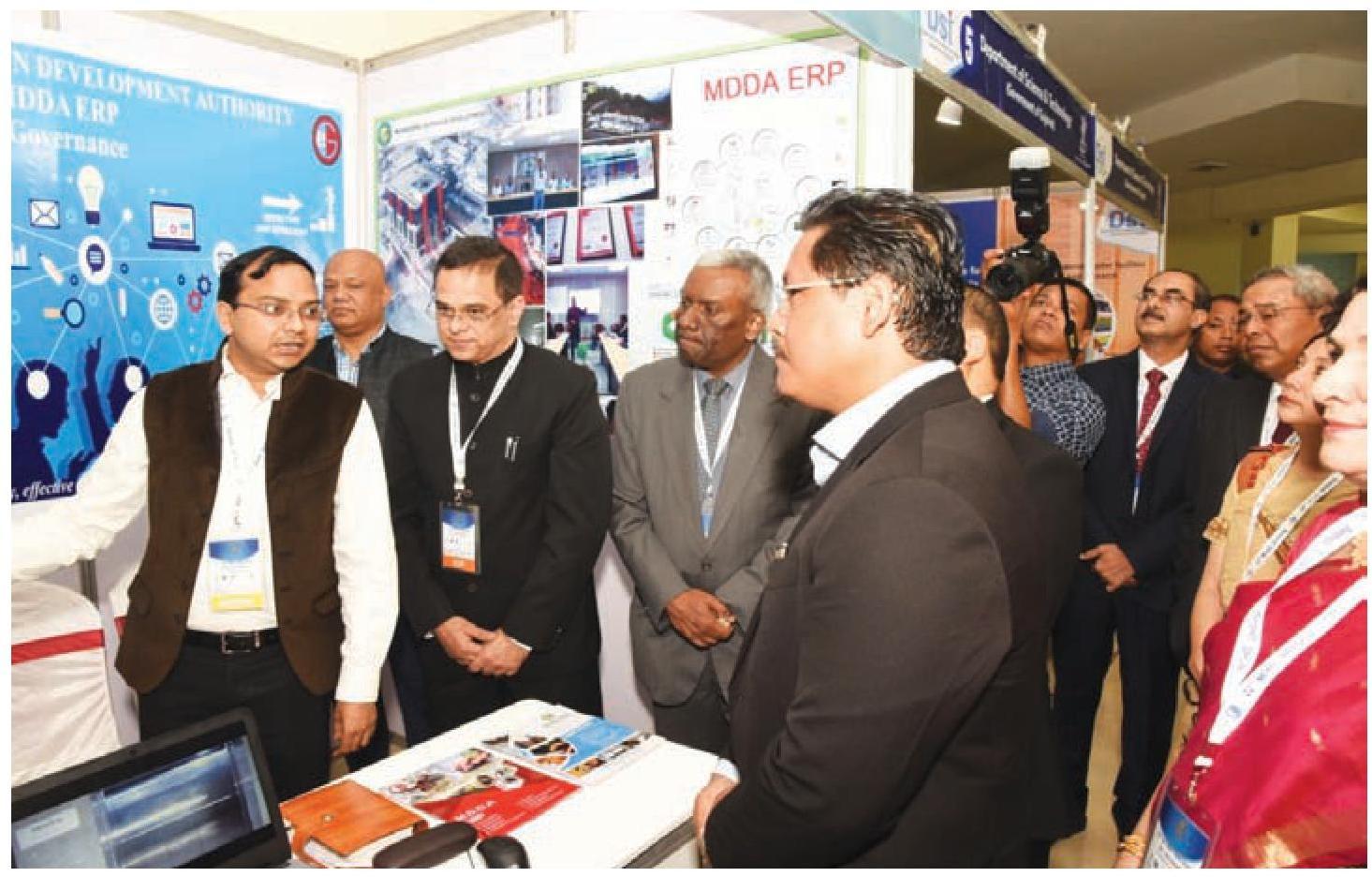
Exhibition stall of Government of Uttarakhand
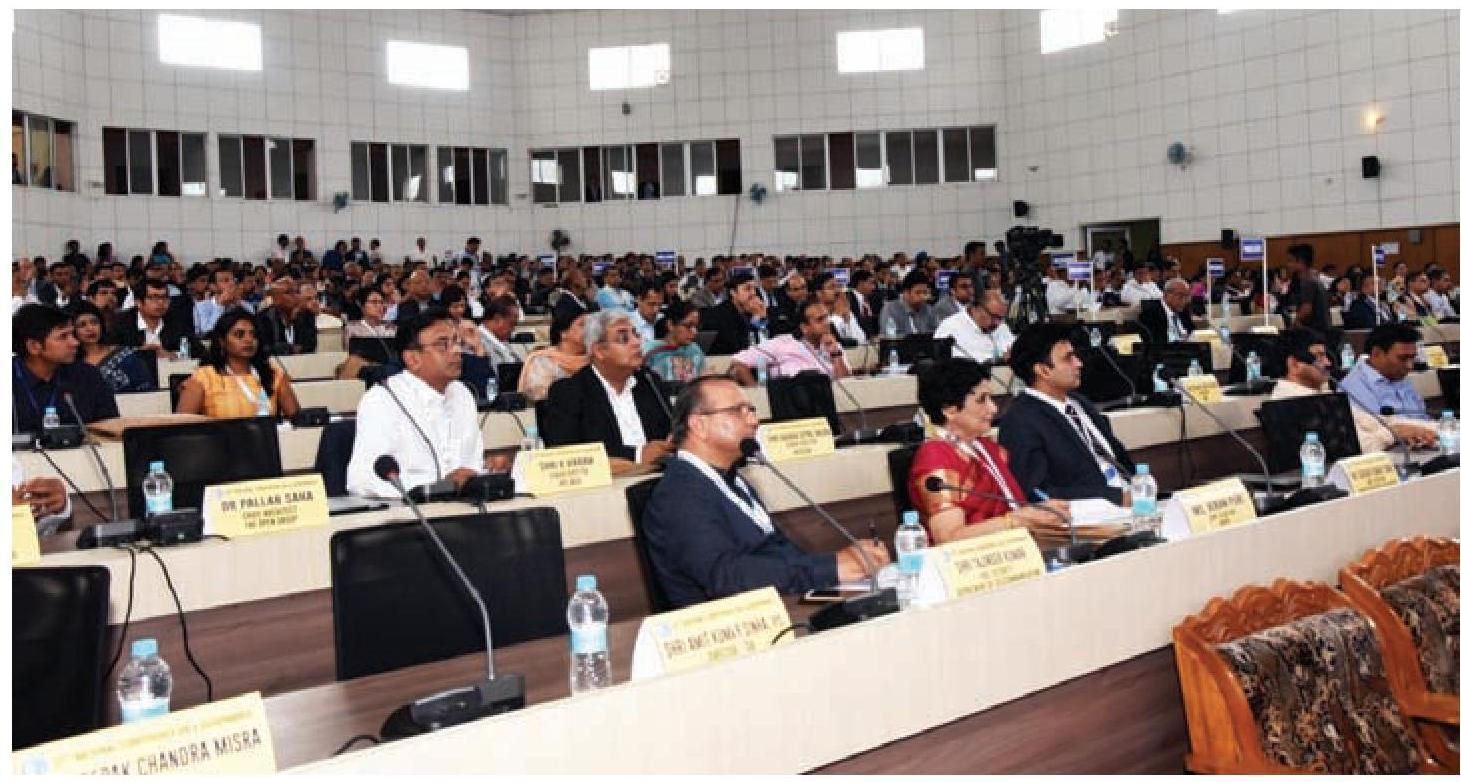
State Convention Centre, Shillong
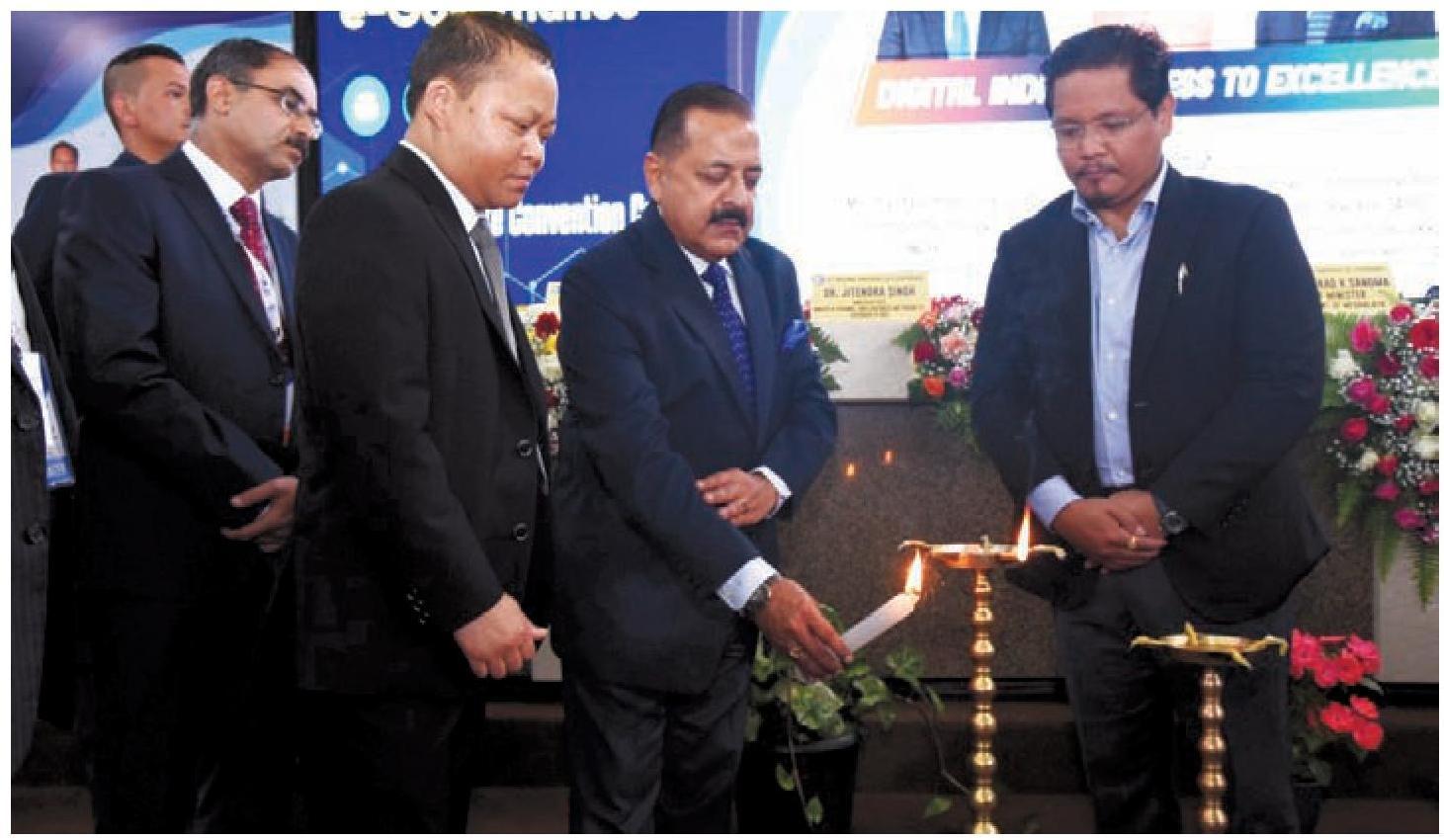
Inauguration of the $22^{\text {nd }} \mathrm{NCeG}$. From left to right Shri Ajay Prakash Sawhney, Secretary, MeitY, Gol; Shri Hamletson Dohling, Minister of Urban Affairs Department, IT&C Department, Govt. of Meghalaya; Dr Jitendra Singh, Hon’ble Minister of State for (Independent Charge) of the Ministry of Development of North Eastern Region, Minister of State in the Prime Minister’s Office; Ministry of Personnel, Public Grievances \& Pensions; Department of Atomic Energy \& Department of Space, Government of India and Shri Conrad K Sangma, Chief Minister of Meghalaya
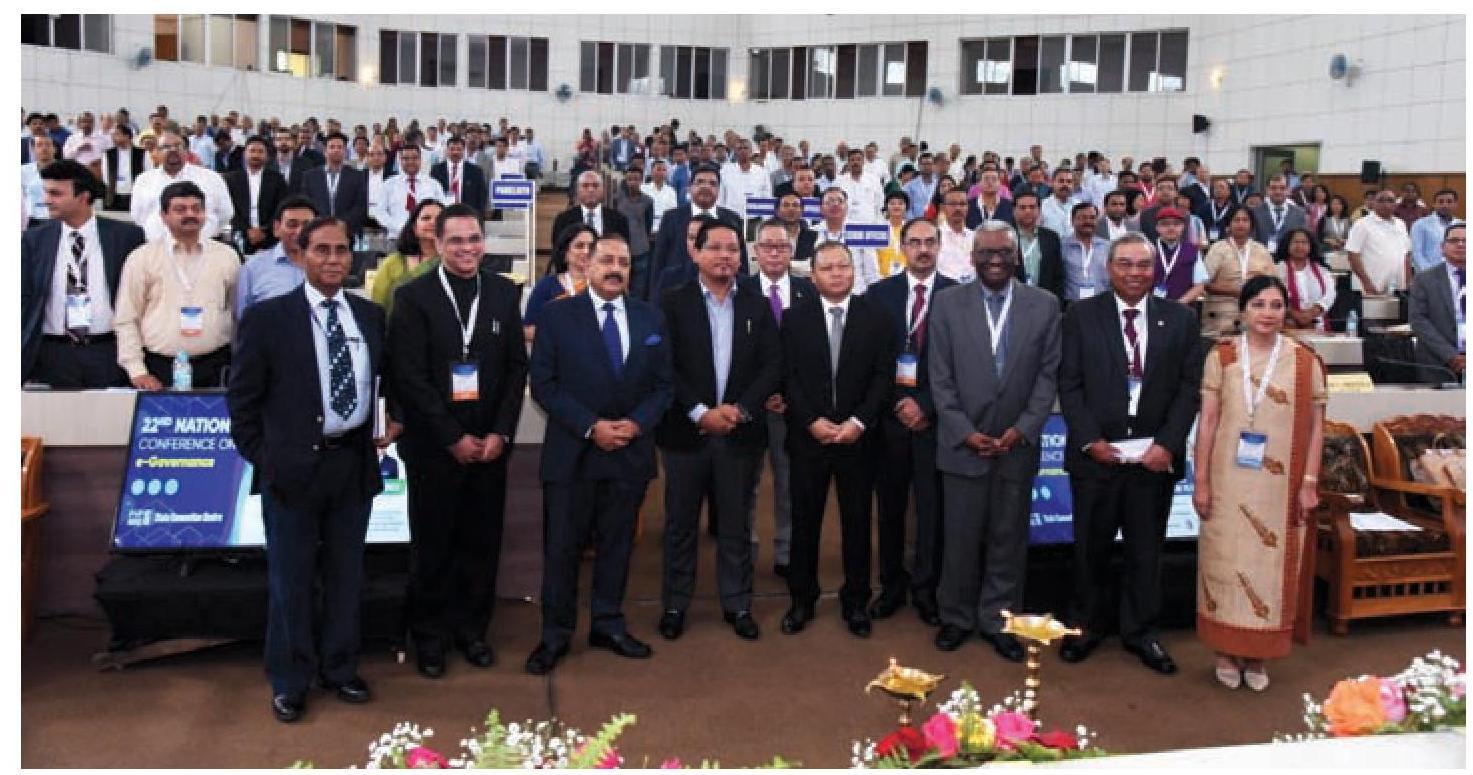
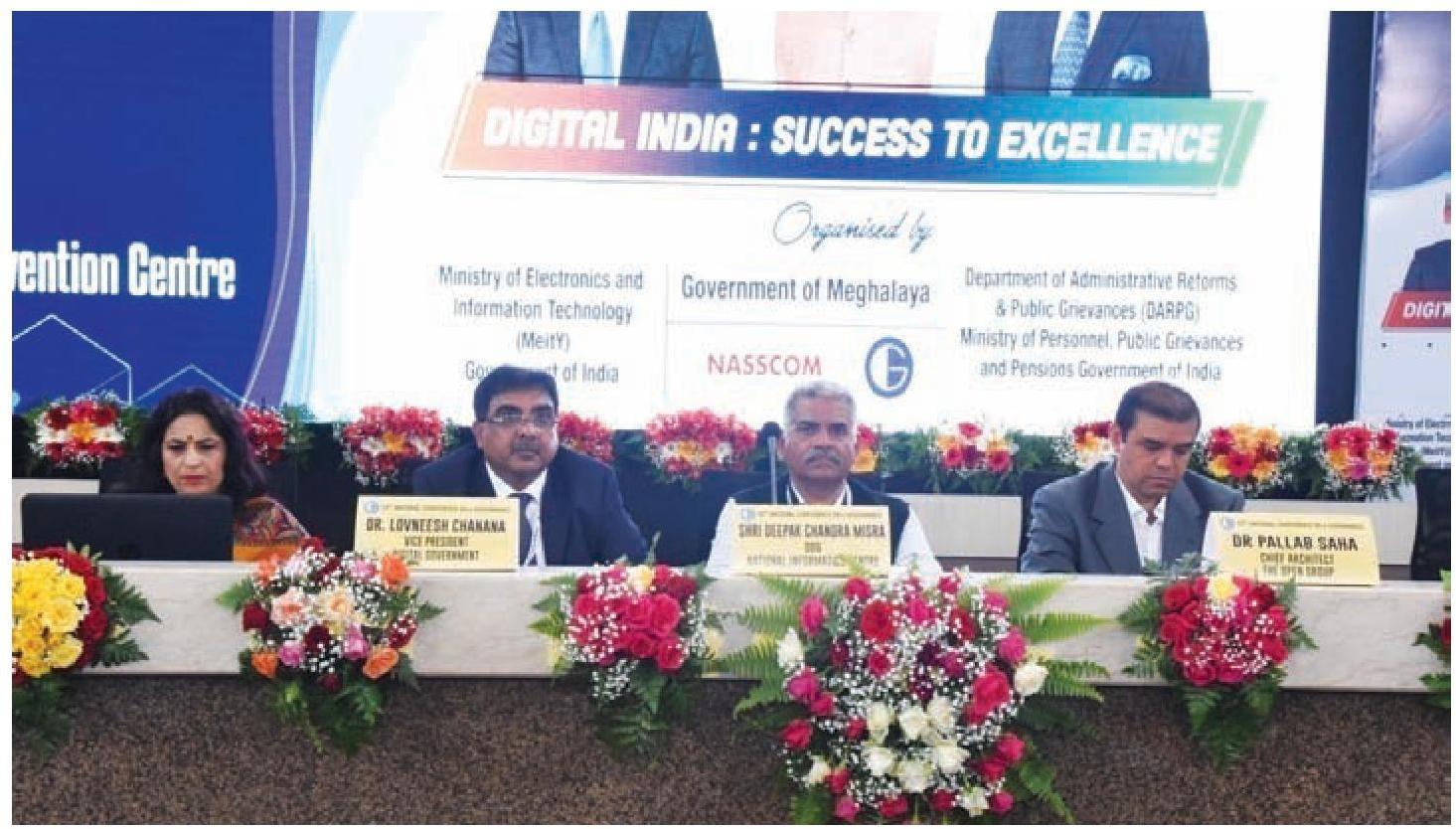
First Plenary Session on ‘India Enterprise Architecture (IndEA)’. From left to right Dr Charru Malhotra, Associate Professor, IIPA; Dr Lovneesh Chanana, Vice President of Digital Government – Asia Pacific and Japan, SAP India; Shri D.C. Misra, DDG, NIC and Dr Pallab Saha, Chief Architect, The Open Group
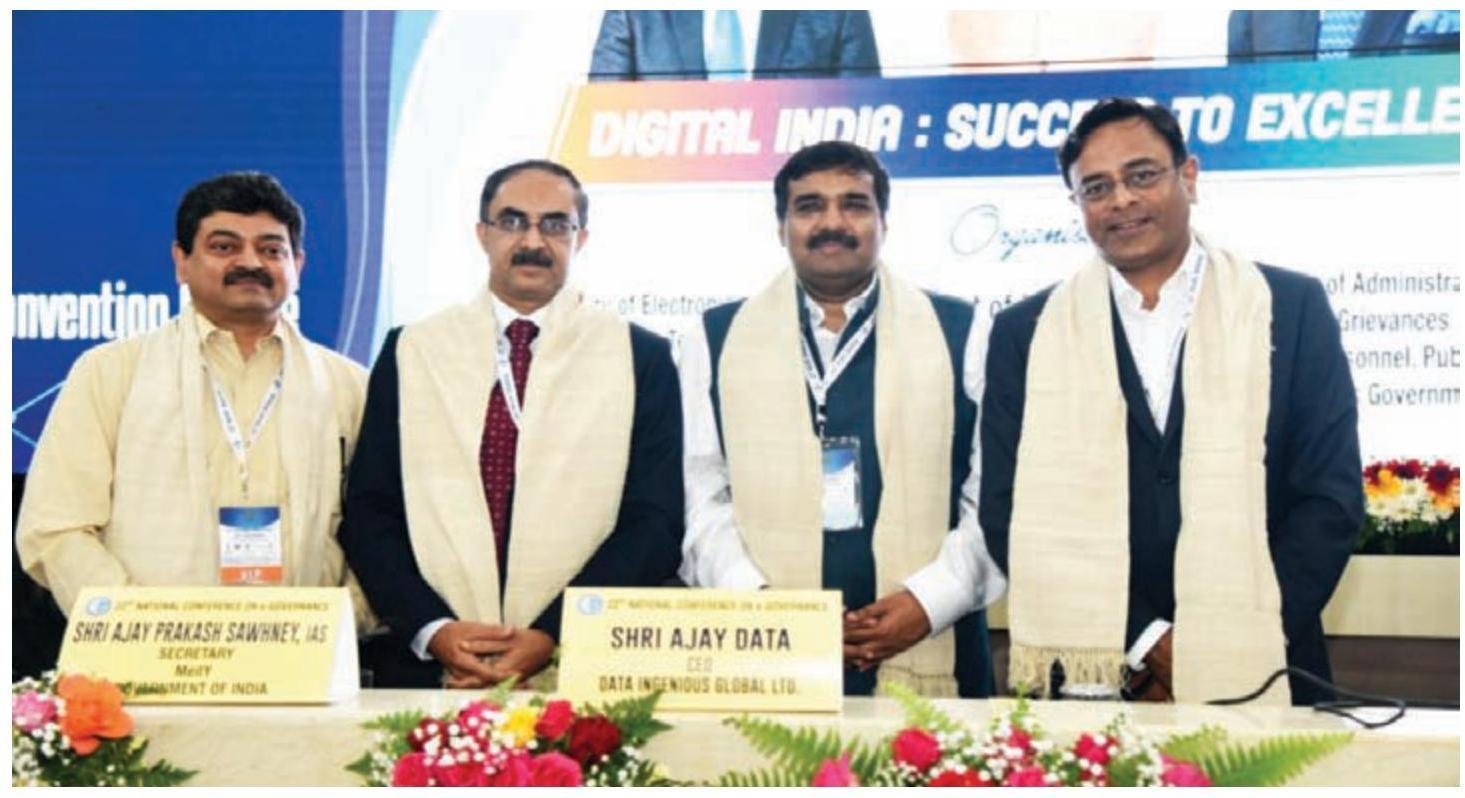
Second Plenary Session on ‘Digital Infrastructure’. From left to right Shri Sanjay Goel, Joint Secretary, Ministry of Electronics and Information Technology (MeitY), Govt of India; Shri Ajay Prakash Sawhney, Secretary, MeitY, Govt of India; Dr Ajay Data, CEO, Data Infosys and Council Member, ICANN and Shri K. Vikram, Senior Director, Industry and Enterprise, HPE India
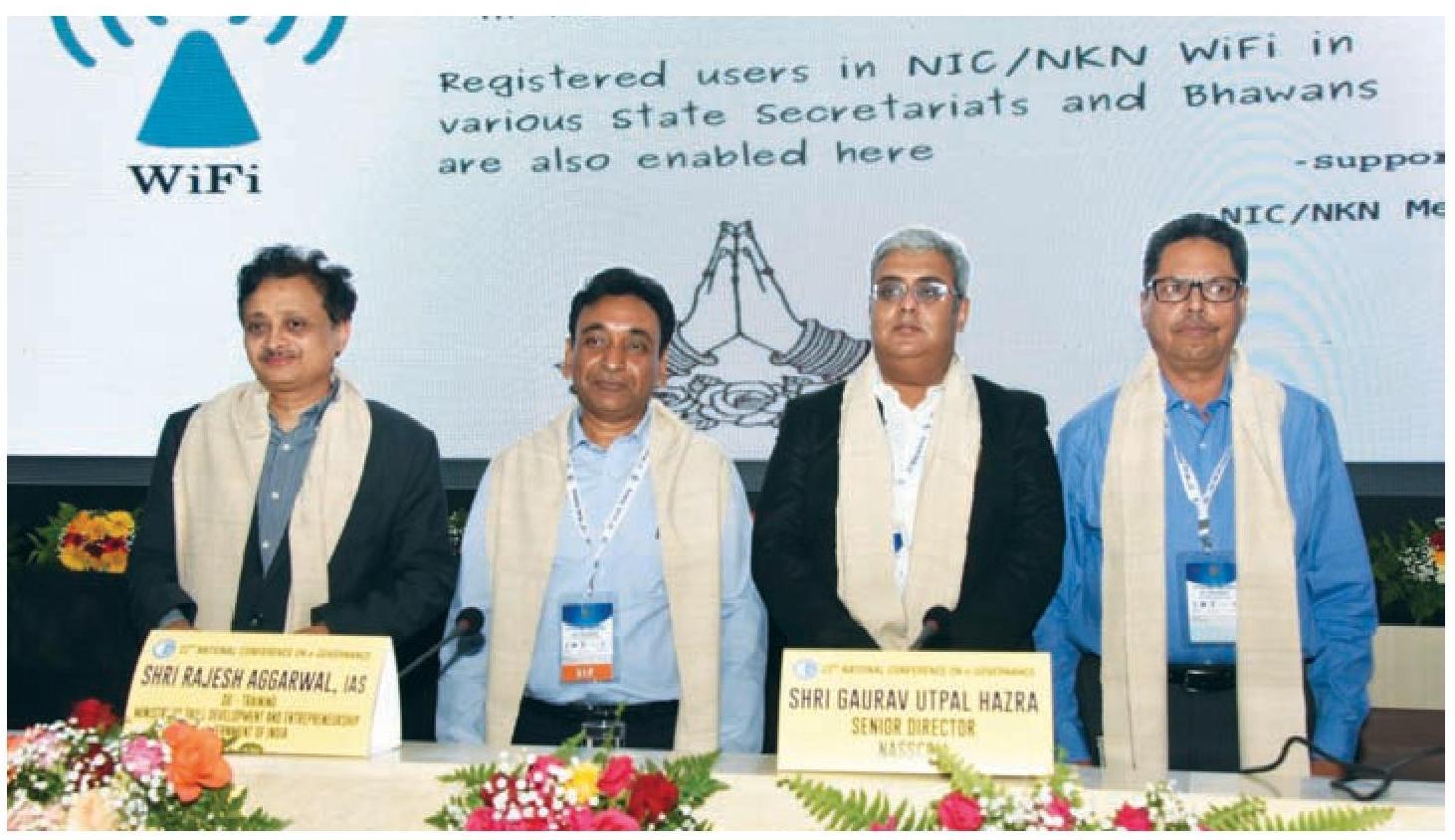
Third Plenary Session on ‘Inclusion and Capacity Building’. From left to right Shri S.V.R. Srinivas, Principal Secretary, IT, Govt. of Maharashtra; Shri Rajesh Aggarwal, DG-Training, Ministry of Skill Development and Entrepreneurship; Shri Gaurav Hazra, Senior Director & Head-India Market, NASSCOM; Shri N.K. Mohapatra, CEO, Electronics Sector Skills Council of India
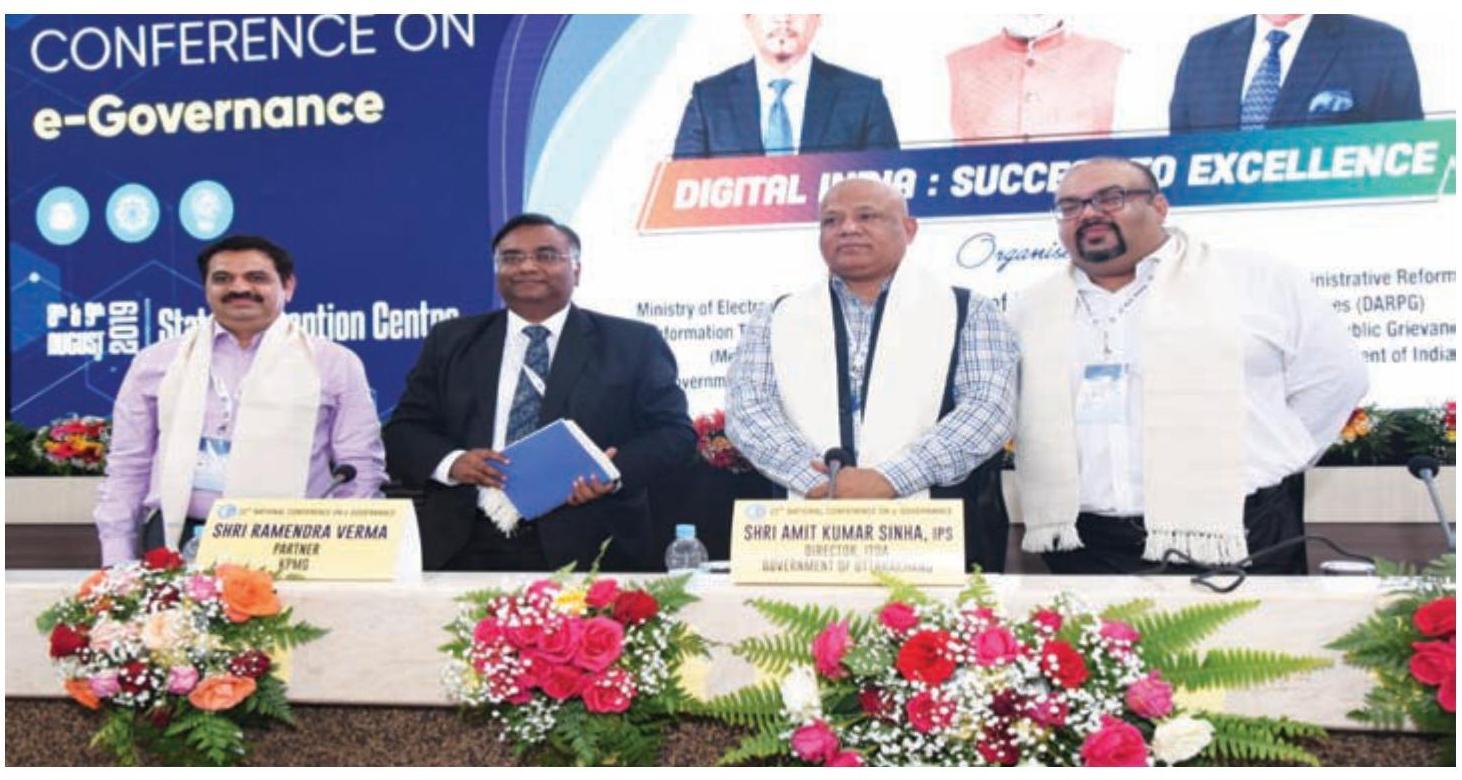
Fourth Plenary Session on ‘Emerging Technology for Practitioners’. From left to right Shri Sandeep Dutta, Chief Practice Officer \& Executive Team Member at Fractal Analytics, Gurgaon, India; Shri Ramendra Verma, Partner and Head Infrastructure, Government \& Healthcare, KPMG India; Shri Amit Kumar Sinha, IPS, Director (ITDA), Uttarakhand and Shri Debashish Goswami, Partner \& Head North-East Business, Wipro India
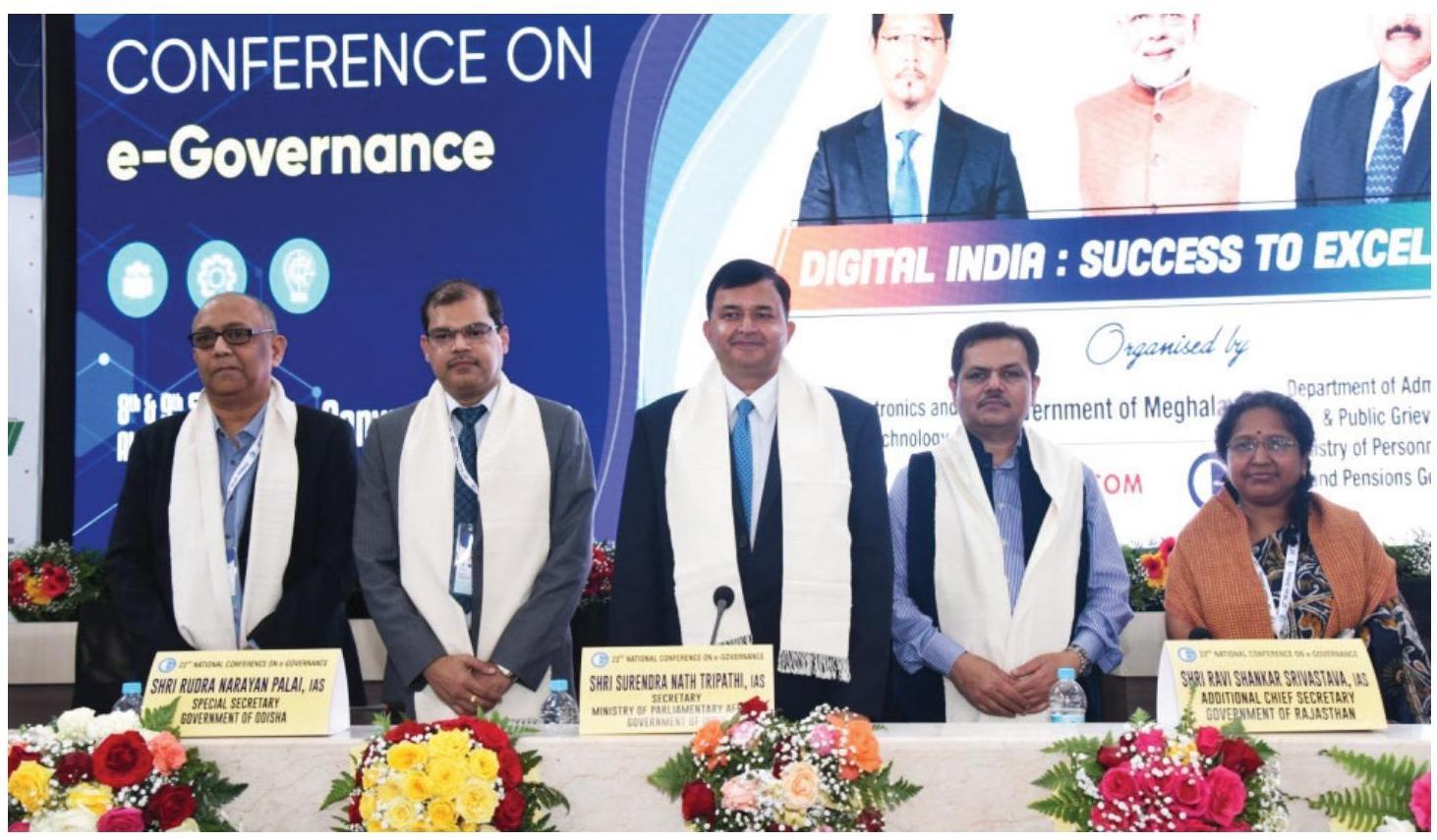
Fifth Plenary Session on ‘Secretariat Reforms’. From left to right Shri Somnath Chatterjee, CEO, Webel Technologies Ltd., Govt of West Bengal; Shri R.N. Palai, Special Secretary, Department of IT, Govt. of Odisha; Shri S.N. Tripathi, Director, IIPA; Shri Ravi Shankar Srivastava, ACS, Govt. of Rajasthan; Ms Rachna Srivastava, DDG & HOD, eOffice, NIC
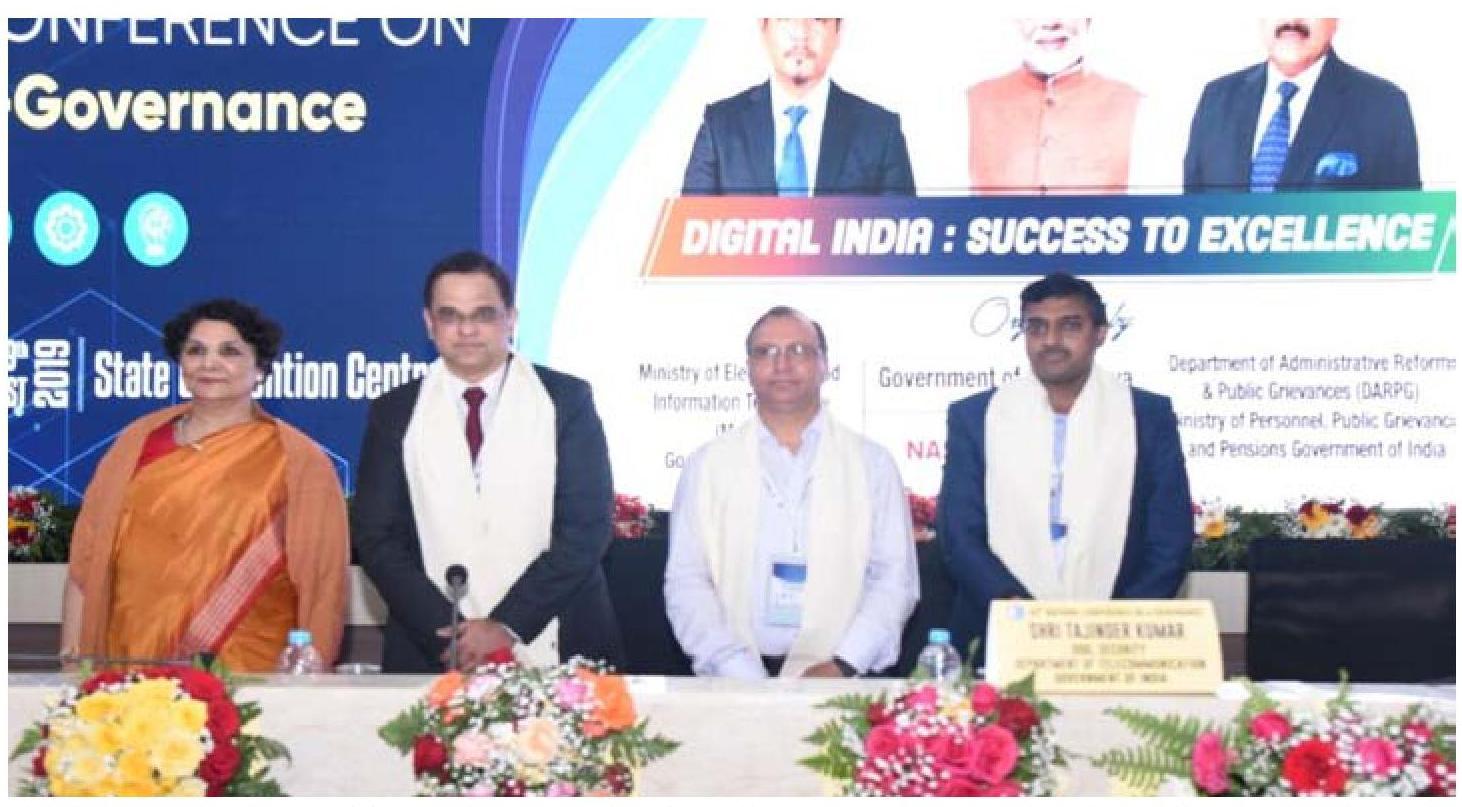
Sixth Plenary Session on ‘National e-Governance Service Delivery Assessment (NeSDA)’. From left to right Ms KiranPuri, Joint Secretary, DARPG, GoI; Shri V. Srinivas, Additional Secretary, DARPG, GoI; Shri Tajinder Kumar, DDG, DOT; Shri Prasad Unnikrishnan, Partner IGH, KPMG
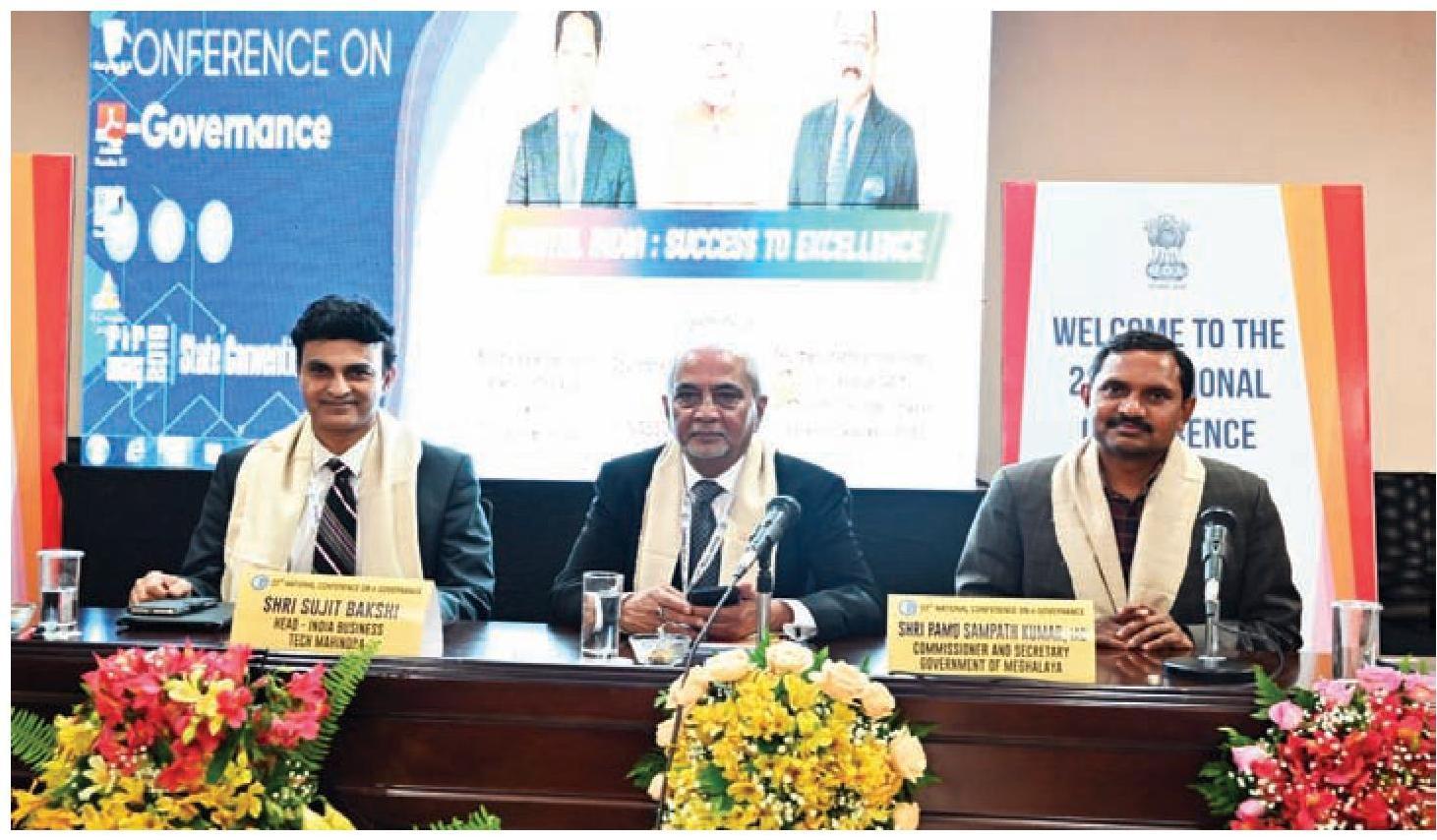
First Breakout Session on ‘One Nation One Platform’. From left to right Shri Saurabh Kumar Tiwari, Joint Secretary, Cabinet Secretariat, GoI; Shri Sujit Baksi, President, Corporate Affairs, Tech Mahindra and Shri Pamu Sampath Kumar, Commissioner Secretary, Govt. of Meghalaya
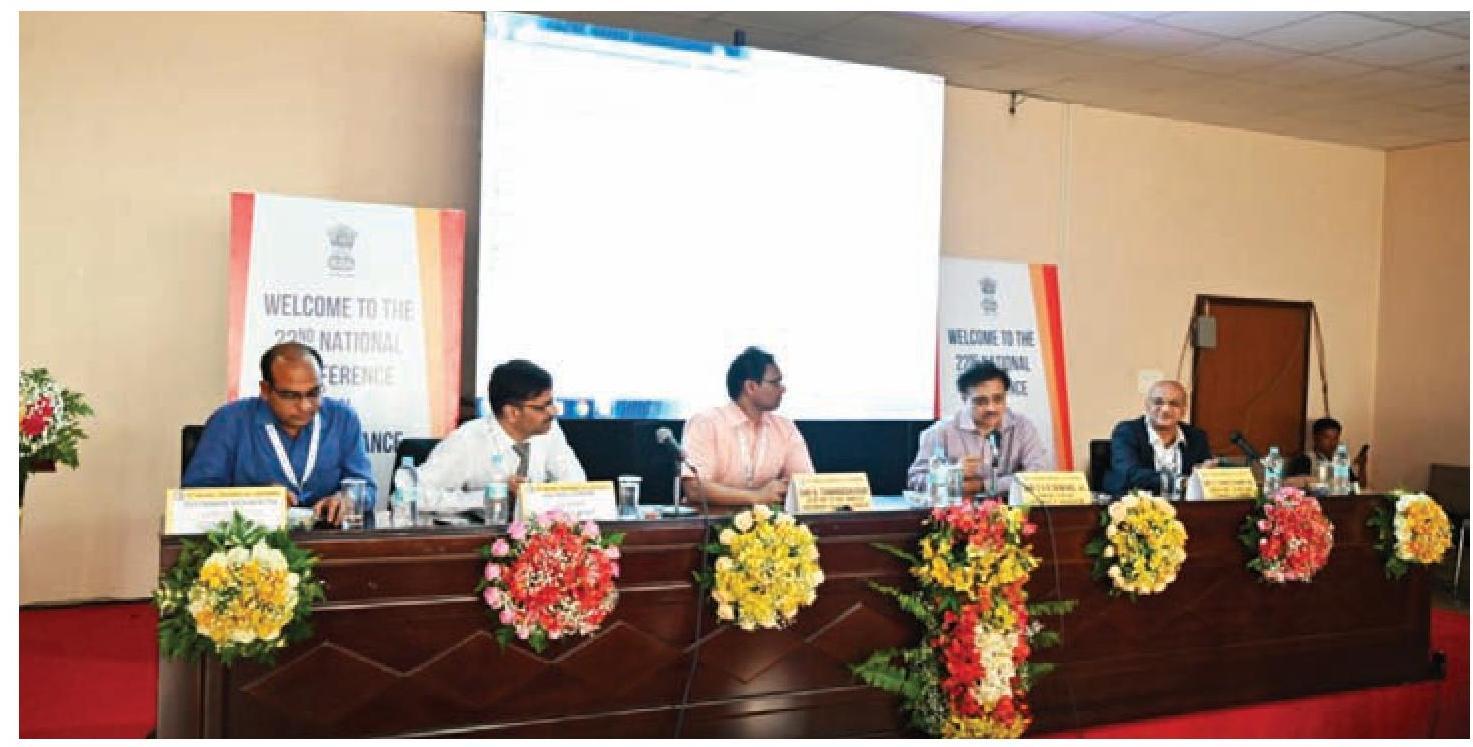
Second Breakout Session on ‘End to End Digital Services. From left to right Shri Deepankar Mohapatra, Joint Director, Odisha Treasury; Shri Anurag Diwan, Joint Director, Chhattisgarh Infotech Promotion Society (CHiPS); Shri B. Chandrashekar, Secretary to the CM, Govt. of Madhya Pradesh & MD, SAMAGRA \& ED, SAPS; Shri S.V.R. Srinivas, Principal Secretary (IT), Govt. of Maharashtra; Shri G.T. Venkateshwar Rao, Commissioner (ESD), ITE\&C Dept., Govt. of Telangana
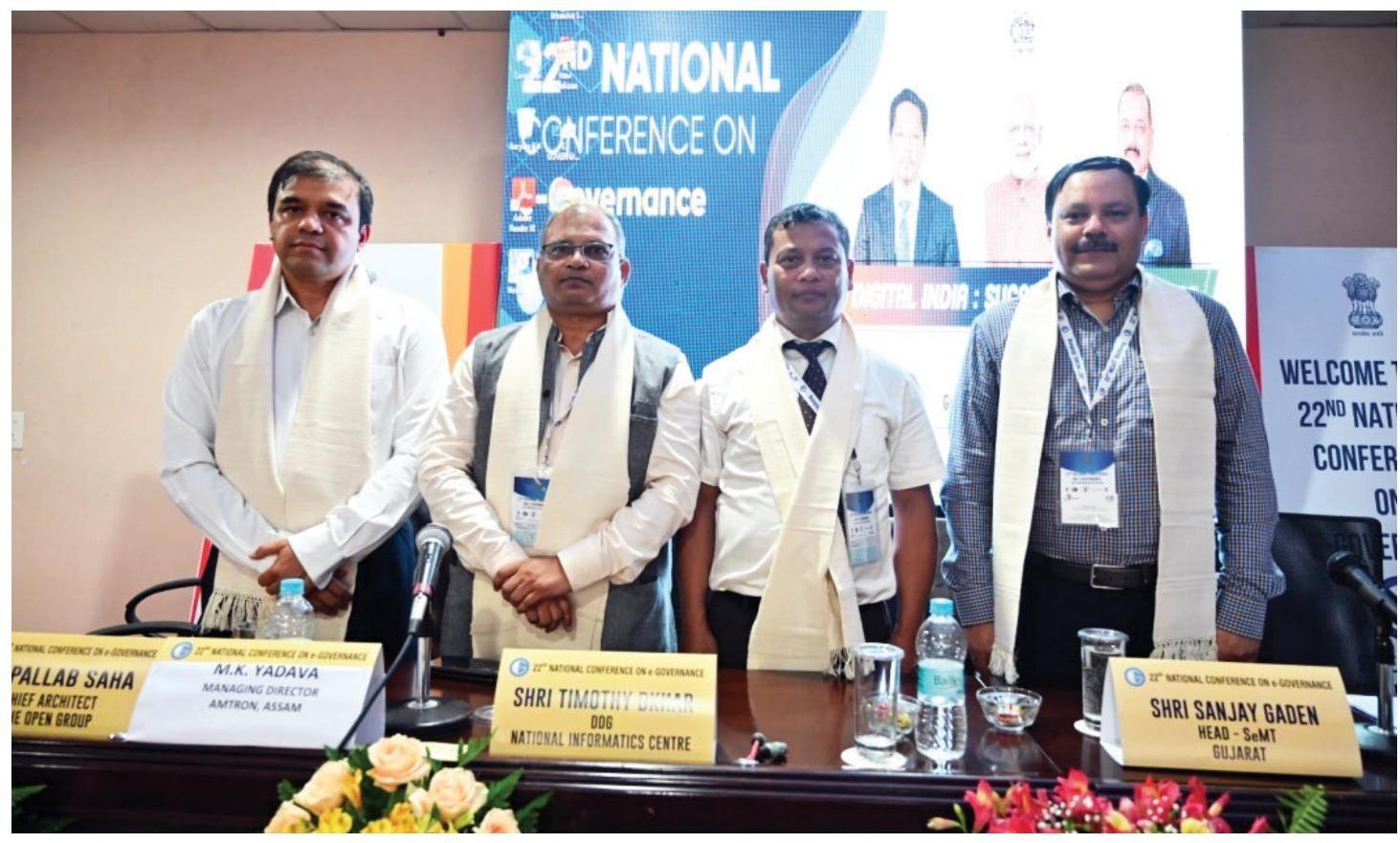
Third Breakout Session on ‘End To End Digital Services’. From left to right Dr Pallab Saha, Chief Architect at the Open Group, President of Association of Enterprise Architect; Shri Mahendra Kumar Yadava, IFS, APCCF & MD, Assam Electronics Development Corporation Ltd.; Shri Timothy Dkhar, DDG and SIO, NIC, Meghalaya and Shri Sanjay Gaden, Principal Consultant and Head, SeMT, Gujarat
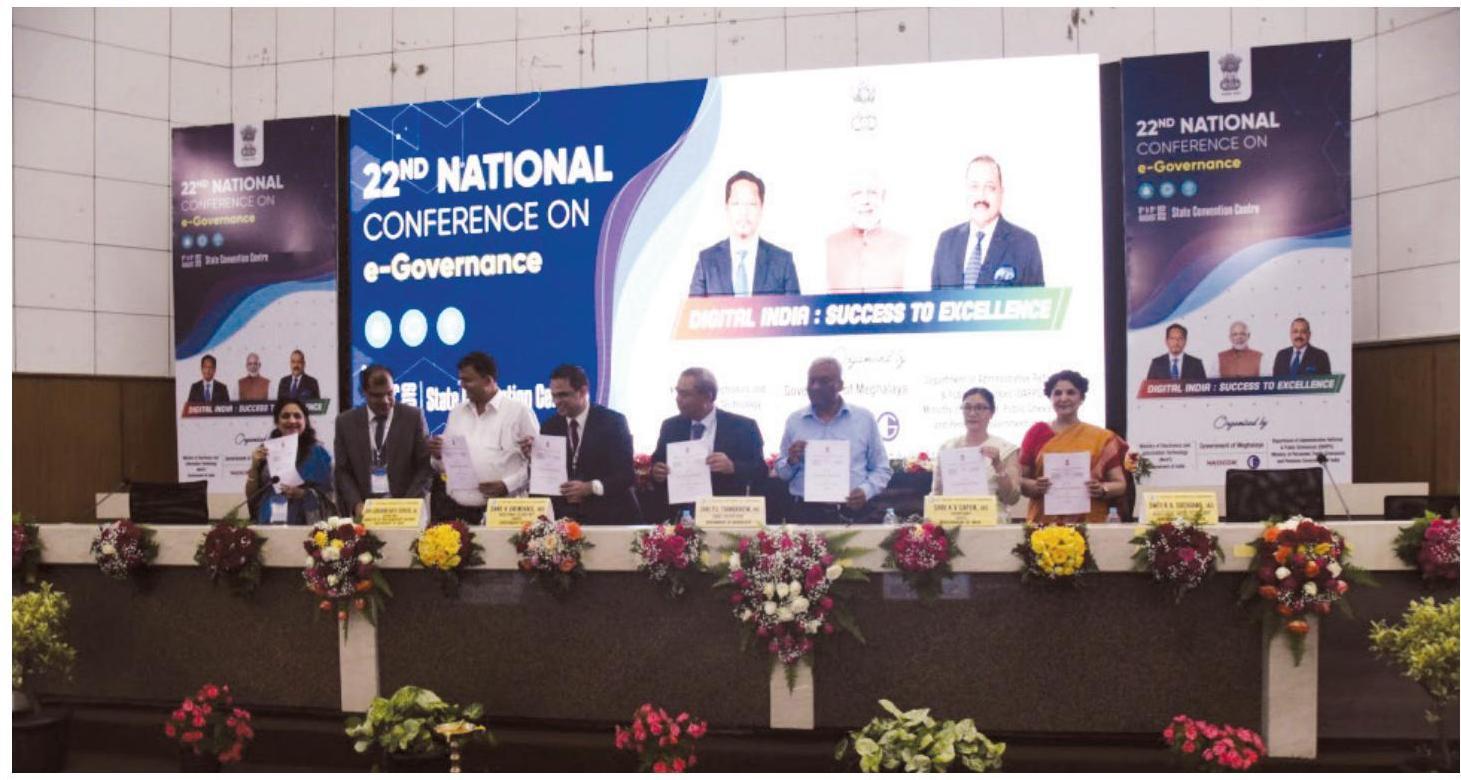
23.2.1 $23^{\text {rd }}$ National Conferenceone-Governance (NCeG)
The Department of Administrative Reforms & Public Grievances (DARPG) and Ministry of Electronics \& Information Technology (MeitY), Government of India, in association with the State Government of Maharashtra organized the $23^{\text {rd }}$ National Conference on e-Governance (NCeG) 2020 on $7^{\text {th }}-8^{\text {th }}$ February 2020 at Mumbai,
Maharashtra. The theme of this Conference was “India 2020: Digital Transformation”. An Exhibition including Wall of Fame showcasing the awarded and other best practices of the country was also organized during the Conference. The Conference was attended by more than 800 delegates from Government of India, State/UT Governments, Industry, Academia, and Private Sector. National e-Services Delivery Assessment (NeSDA) 2019 Report was released during the Conference.
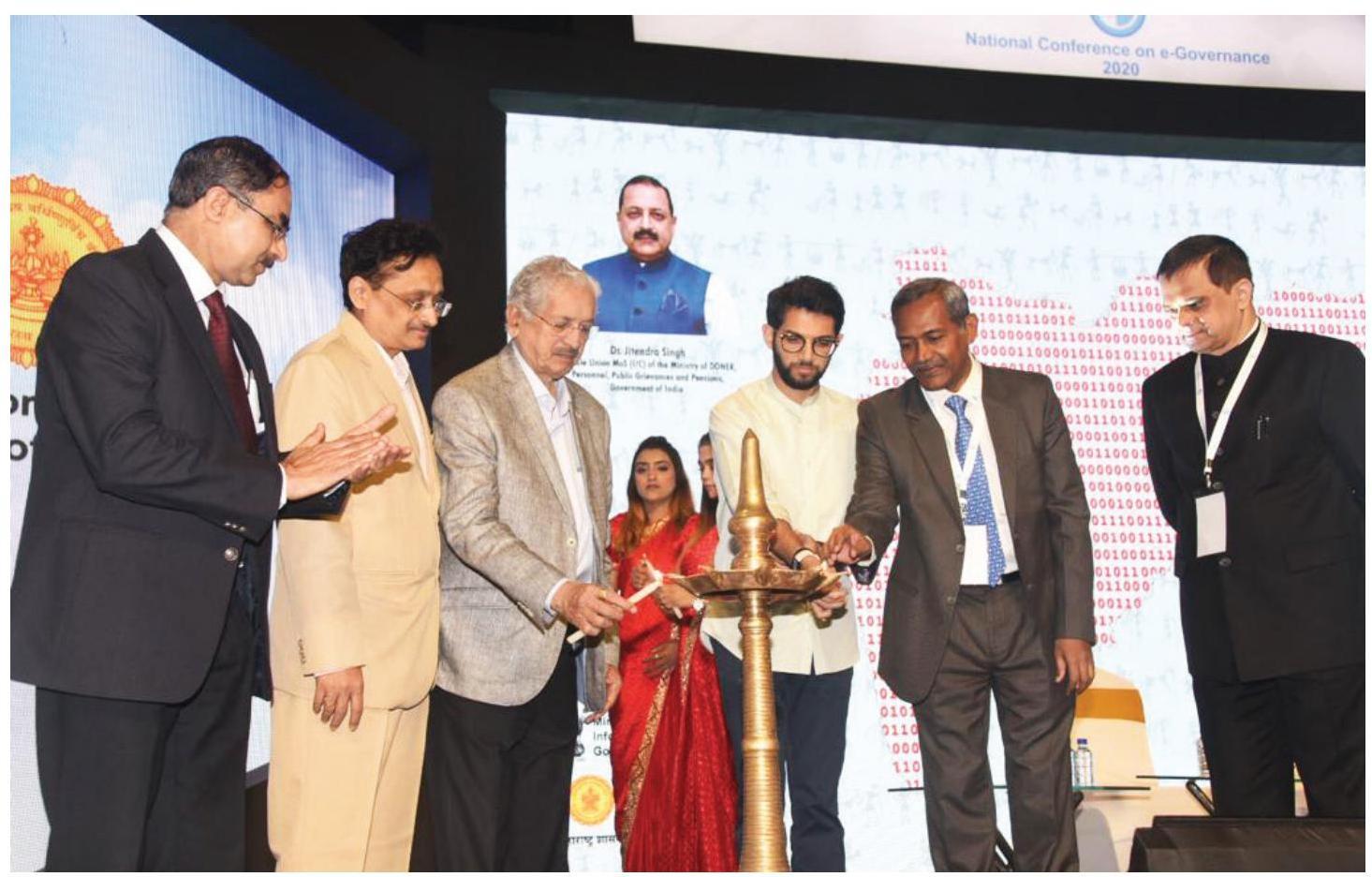
Inauguration of the $23^{\text {rd }}$ National Conference on e-Governance. From left to right Shri Ajay Prakash Sawhney, Secretary, MeitY, Govt. of India; Shri S.V.R. Srinivas, Principal Secretary (IT), Govt. of Maharashtra; Shri Subhash Desai, Hon’ble Minister for Industries and Mining, Govt. of Maharashtra; Shri Aditya Thackeray, Hon’ble Minister for Environment, Tourism and Protocol, Govt. of Maharashtra; Dr Kshatrapati Shivaji, Secretary, DARPG, Govt. of India; Shri V. Srinivas, Additional Secretary, DARPG, Govt of India
Discussions were held on the following subthemes in Plenary and Breakout sessions during the Conference:
Plenary Sessions Sub-themes:
(i) Digital Platforms and Digital economy
(ii) Blockchain for Effective Governance and Service Delivery
(iii) Improving service delivery
(iv) Digital payments and Fintech
(v) National e-Governance Service Delivery Assessment (NeSDA), Digital Service Standards (DSS) and Procurement reforms
(vi) Skilling and Capacity Building
Breakout Sessions sub-themes:
(i) Hackathon award winner’s presentations
(ii) End to End Service delivery (IT initiatives by States/UTs)
(iii) AI/Machine Learning and Language
(iv) Building Digital Trust- Transparency, Security and Privacy
The Conference was concluded with the launch and adoption of Mumbai Declaration which focuses on improving the public service delivery using digital platforms (Annexure VIII).
National Awards for e-Governance
The National Awards for e-Governance for the year 2019-20 were presented in the $23^{\text {rd }}$ National
Conference on e-Governance. A total of twenty (20) awards (8 Gold, 9 Silver and 3 Jury) were given in the following six categories to recognize achievements in the area of e-Governance:
(i) Excellence in Government Process Reengineering for Digital Transformation
(ii) Excellence in providing Citizen-Centric Delivery
(iii) Excellence in District level Initiative in e-Governance
(a) North-East States + Hilly States
(b) UTs (including Delhi)
(c) Other States.
(iv) Outstanding research on Citizen-Centric Services by Academic/Research Institutions.
(v) Innovative Use of ICT in e-Governance solutions by Startups
(vi) Excellence in Adopting Emerging Technologies.
The e-Governance initiatives, which were awarded the National e-Governance Awards for 2019-20 are as follows:
| S.No. | Award | Project Name | Department/Organization |
|---|---|---|---|
| Category-I: Excellence in Government Process Re-engineering for Digital Transformation | |||
| 1 | GOLD | Ayushman Bharat Pradhan Mantri Jan Arogya Yojana |
National Health Authority, Ministry of Health and Family Welfare |
| 2 | SILVER | GO SWIFT (Government of Odisha Single Window for Investor Facilitation and Tracking) |
Industrial Promotion and Investment Corporation of Odisha Limited, Odisha |
| 3 | SILVER | ERONET (Electoral Registration Officers Network) |
Election Commission of India |
| 4 | JURY AWARD |
Real-Time Pollution Monitoring System (RTPMS) |
Andhra Pradesh Pollution Control Board, Andhra Pradesh |
| S.No. | Award | Project Name | Department/Organization |
|---|---|---|---|
| Category- II: Excellence in providing Citizen-Centric Delivery | |||
| 5 | GOLD | Antyodaya Saral Haryana | Department of IT, E&C, Haryana |
| 6 | SILVER | Rail Madad | Railway Board, Ministry of Railways |
| 7 | JURY AWARD |
An Instantaneous Over the Counter Caste, Income \& Residence Certificate Issuance System | Revenue Department, Karnataka |
| Category-III: Excellence in District level initiative in e-Governance (i) North-East States + Hilly States (ii) UTs (including Delhi) (iii) Other States |
|||
| 8 | GOLD | District Adhoc Wireless Surveillance Communication System using Drone Technology | Subcategory (i) | District Disaster Management Authority, Rudraprayag, Uttarakhand |
| 9 | SILVER | LouchaPathap- Online Land Record Computerization and National Generic Document Registration System (NGDRS) |
| District Administration, Imphal East, Manipur |
| 10 | JURY AWARD |
eForestFire- Himalayan Forest Fire Prediction | | Department of Environment \& Forests, Arunachal Pradesh |
| 11 | GOLD | SAKOON | Subcategory (ii) | Deputy Commissioner, Udhampur, Jammu \& Kashmir |
| 12 | GOLD | WeDeserve – Right assistance to the Right person at the Right Time | Subcategory (iii) | District eGovernance Society, Kasaragod, Kerala |
| 13 | SILVER | Public Services from block to panchayatSarkarBhawan through e-governance | | District Administration, Saharsa, Bihar |
| Category IV: Outstanding research on Citizen-Centric Services by Academic/ Research Institutions | | | ||
| 14 | GOLD | Satellite-Based Agriculture Information System: An Efficient Application of ICT | | Indian Institute of Technology, Roorkee, Uttarakhand |
| 15 | SILVER | ICT based e-Agricultural Extension for Enhanced Technology and Information Delivery | | Agricultural University, Sabour, Bihar |
| S.No. | Award | Project Name | Department/Organization |
|---|---|---|---|
| Category V: Innovative Use of ICT in e-Governance solutions by Startups [Startup as defined by Department of Industrial Policy and Promotion (DIPP) Government of India] |
|||
| 16 | GOLD | Providing farm-scale data from multi-satellite |
Satyukt Analytics Private Limited, Karnataka |
| 17 | SILVER | A Tool and System for Generation and Use of Personalized, Interactive Laboratory Reports Using Real-Time Report |
Cognitivecare India Lab LLP, Telangana |
| 18 | SILVER | FotonVR – Virtual Reality in Education |
Kachhua Education Services LLP, Gujarat |
| Category VI: Excellence in Adopting Emerging Technologies | |||
| 19 | GOLD | T-Chits | Registration & Stamps Department, Telangana |
| 20 | SILVER | Wildlife Surveillance and Anti- Poaching System(WSAPS) |
Department of IT\&C, Rajasthan |
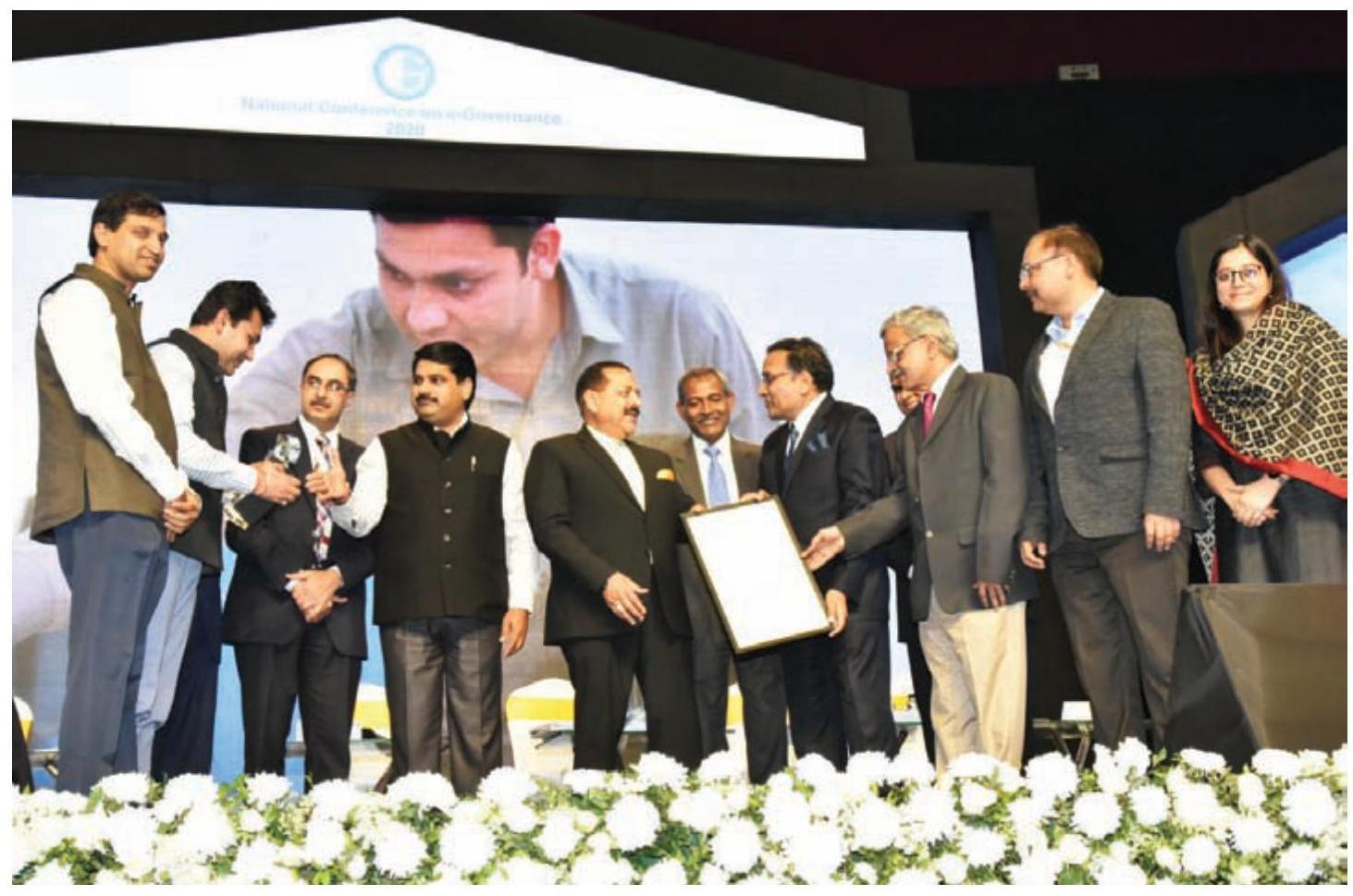
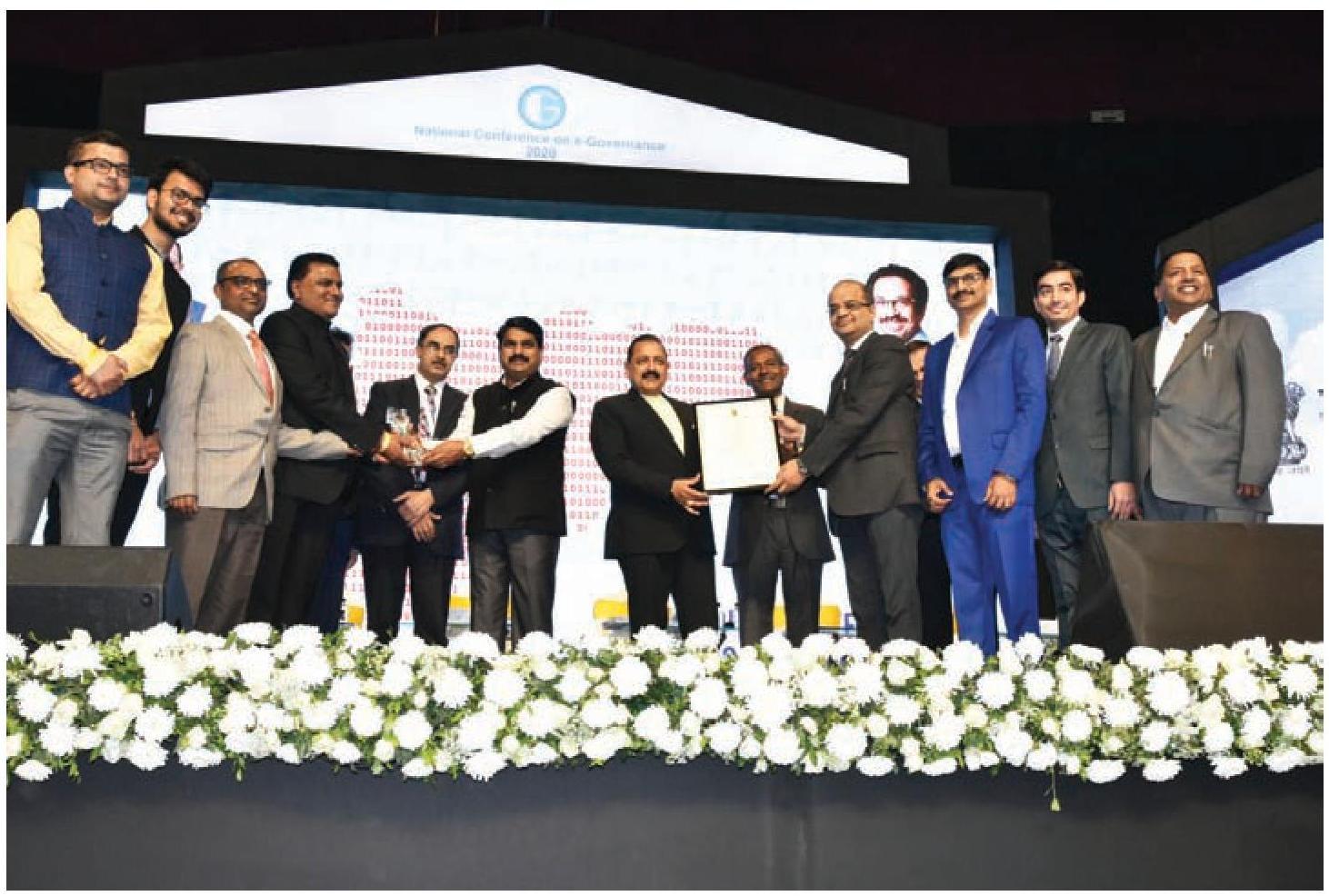
Implementation of e-Office in Central Ministries/Departments/Organisations
23.3 e-OFFICE
23.3.1 DAR&PG is the nodal Department for implementation of e-office project in Central Ministries/Departments. National Informatics Centre (NIC) is the technical partner of DARPG in this project. The e-Office Mission Mode Project (MMP) was launched in 2011-12 in a phased manner. DARPG provides financial assistance to the Central Ministries/Departments for e-office implementation.
23.3.2 Effective steps have been taken by DAR\&PG to expedite implementation of e-office in all central Government Ministries/Departments
by conducting regular review meetings and also by establishing a project monitoring unit in the Department. 56 Central Ministries/Departments have already achieved the target of complete e-office and other Central Ministries/Departments have also started showing improving trends.
23.3.3 On the spot inspection of Ministries/ Departments who have achieved $80 %$ target is done before certification. Also, Ministries/ Departments performing unsatisfactorily are invited/ visited for understanding their issues and prepared roadmaps for improving their performance.
Workshop on e-Office
23.3.4 A workshop on best practices on e-Office
implementation was organized by DAR&PG on 12.02.2020 at Pravasi Bhartiya Kendra (PBK), Chanakyapuri, New Delhi. In the workshop, apart from National Informatics Centre making a presentation on the subject, the officials of the CGA, Ministry of Information \& Broadcasting,
Ministry of Home Affairs, CAG, Department of Expenditure, Ministry of Power participated in the Technical Sessions. This was followed by an interactive session. Dr Jitendra Singh, Hon’ble MOS (PP) awarded the top performer central Ministries, Departments and organizations.
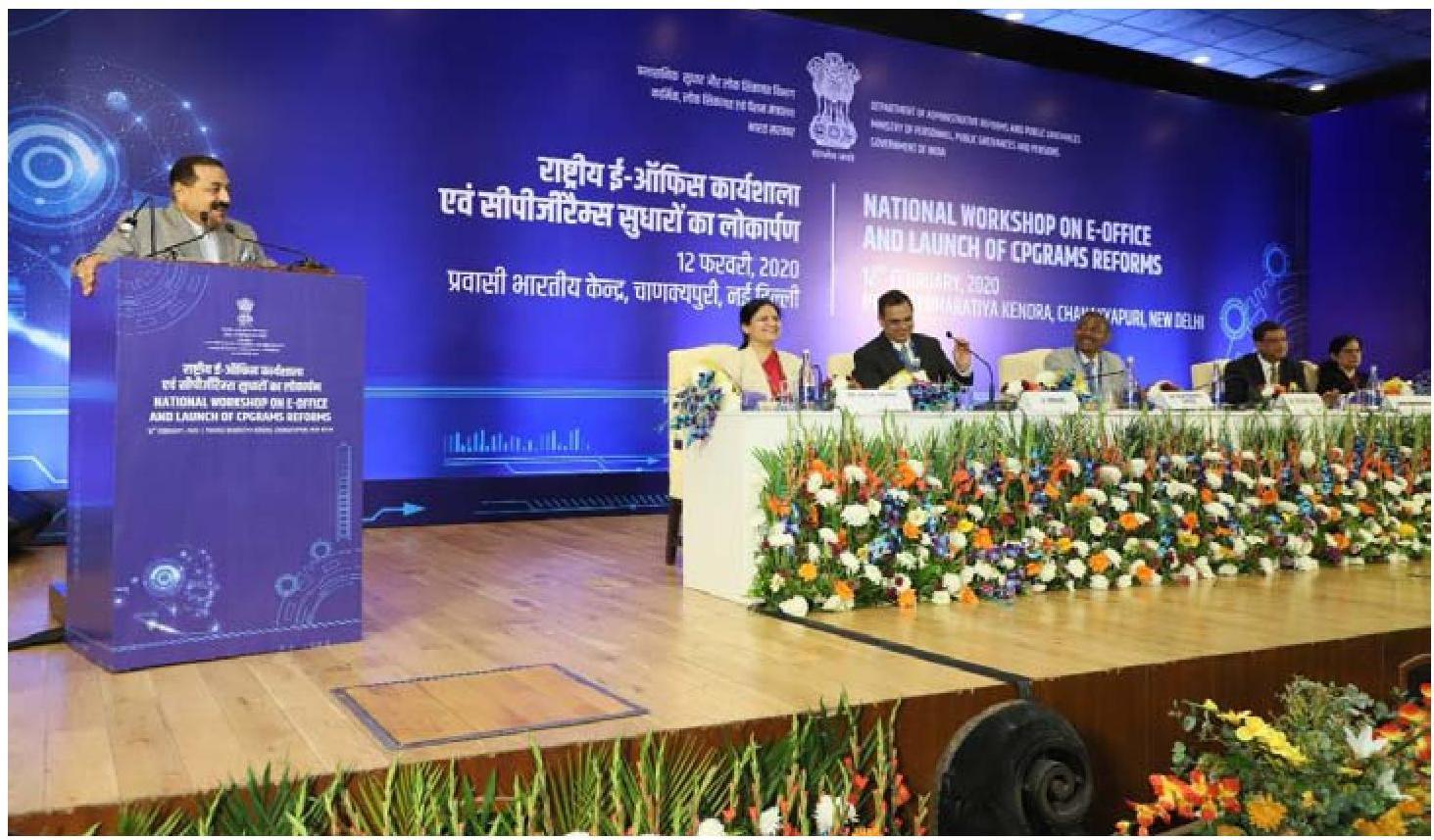
Address by Hon’ble Minister in the National Workshop on e-Office and CPGRAMS Reforms held on 12.02.2020.
23.4 Compliance with the Guidelines for Indian Government Websites (GIGW)
23.4.1 NIC had brought out the Guidelines for Indian Government Websites (GIGW) in 2009, which was adopted by the Department of Administrative Reforms \& Public Grievances. The GIGW were circulated by the DAR\&PG, way back in May 2009 to all central Ministries/Departments for compliance and also furnishing status of action taken in the matter. Subsequent, to that DAR\&PG and Cabinet Secretariat, has made several references to all the central Ministries/
Departments for early compliance of the websites with the GIGW.
23.4.2 Due to continuous monitoring 70 Central Ministries/Departments have obtained GIGW compliant Certificate from STQC and many central Ministries/Departments are on the way of becoming GIGW compliant in near future. NIC in collaboration with DARPG brought out the second edition of GIGW2018 and the same was circulated to all Ministries/ Departments of Govt of India along with all State Government/ UT Administration for compliance.
INTERNATIONAL EXCHANGE AND COOPERATION
24.1 The Department of Administrative Reforms & Public Grievances (DARPG) deals with matters relating to international exchange and cooperation in the field of Public Administration and Governance, which includes, among other things, organizing programmes and visit of Indian delegations to foreign countries and visit of foreign delegations to India as part of projects / bilateral measures in furtherance of activities included in the Memorandum of Understandings (MOUs) / Agreements signed between India and other countries (bilateral or multilateral).
24.2 The aim of international exchange and cooperation component is to share information, best practices and personnel across national governments. Presently bilateral MOUs in the areas of Public Administration and Governance have been signed with France, Malaysia, Singapore, United Kingdom, Portugal, China and trilateral MoU with Brazil and South Africa (IBSA).
24.3 India-Portugal Cooperation
24.3.1 Department has signed a MoU in June 2017 with Ministry of the Presidency and of Administrative Modernization, Government of Portuguese Republic on ‘Cooperation in the field of Public Administration and Governance Reforms’. The areas of co-operation under this MoU includes Digital transformation of Government, Administrative simplification and process reengineering, Public Service Delivery, Building and developing staff capability, Sharing good
governance practices in public administration, Public Grievance Redress Mechanism.
24.3.2 In pursuance of the MoU, a four-member Indian delegation led by Secretary (DARPG) visited Lisbon, Portugal on 8-9 May 2018 to attend a first Senior Consultative Body meeting held under the Memorandum of Understanding signed with Government of Portugal. During the meeting, both sides discussed initiatives and approach for Digital Government, Administrative Simplification \& Public Service Delivery and Public Grievance Redress Mechanism.
24.3.3 In order to discuss further on the areas of cooperation the Department will organize the second meeting of the Senior Consultative Body in New Delhi after deciding the mutual convenient dates.
24.4 India-United Kingdom Cooperation
24.4.1 Department of Administrative Reforms and Public Grievances, has signed an MoU with the Cabinet Office, Her Majesty’s Government of the United Kingdom (HMG), for ‘Cooperation in Public Administration and Governance Reforms in November 2015. The areas of co-operation under this MoU includes (i) sharing good governance practices in public administration, (ii) userled service design, (iii) reducing bureaucracy in service delivery, (iv)government process re-engineering, (v) building and developing staff capability, (vi) public grievance redress mechanism, (vii) local government reforms, (viii)
reforms towards strengthening of social security, (ix) collaboration in strategies for the promotion of ethics in Government, (x) collaboration between Government and industry on staff management., (xi) mechanisms for public engagement, (xii) crisis and disaster management and (xiii) digital transformation of government.
24.4.2 India-UK First Joint Working Group meeting was held in London, UK in January 2016. Both sides shared their best practices in the area of public administration, governance reforms and online delivery of citizen-centric services and explored the possibilities of adopting suitable best practices in these areas.
24.4.3 Subsequently, four-member delegation from the Govt. of United Kingdom led by UK’s Chief Technology Officer [Mr. Andy Beale, CTO Government Digital Service (GDS)] visited India during in September 2016. The delegation held meetings with Senior officers various Ministries/ Departments of Government of India and discussed and shared best practices in e-governance, citizencentric online delivery of services, good governance practices in public administration, user- led service design, Government Process Re-engineering etc.
24.4.4 The second meeting of the India UK Joint Working Group will be held in New Delhi to review the programme of action as was agreed between the two sides during the first meeting of the JWG.
24.5 India – France Cooperation
24.5.1 The Department of Administrative Reforms and Public Grievances, Ministry of Personnel, Public Grievances & Pensions has signed a Partnership Agreement in January 2016 with Ministry for Devolution and Civil Service of the
Government of France on ‘Public Administration and Administrative Reforms’.
24.5.2 The main objectives of the Partnership Agreement are to strengthen and promote bilateral cooperation between the two countries in public administration and governance. The areas of co-operation under this Partnership Agreement includes cooperation in the field of civil services, human resource management, public administration and administrative reforms for the mutual benefit of the official and institutional level, in such areas as the Parties, agree upon.
24.5.3 The first meeting of the India-France Joint Working Group, under the Partnership Agreement, was held in June 2016. Both sides exchanged/ shared views in the area of public administration, governance reforms and online delivery of citizencentric services and explored the possibilities of adopting suitable best practices in these areas.
24.5.4 As the MoU with France expired in January 2019, its renewal is currently underway.
24.6 India-Malaysia Cooperation
24.6.1 An MoU on cooperation in the field of Public Administration and Governance was signed in November 2013. The areas of cooperation under the MoU in the field of Public Administration and Governance are – (i) human resources management, (ii) improved systems of public service delivery, (iii) e-governance, (iv) accountability and transparency, (v) capacity building and skills up-grading, (vi) quality of outcome, (vii) governance reforms of both countries, and (viii) any other areas of co-operation in the field of Public Administration and Governance to be jointly decided by the Participants.
24.6.2 India-Malaysia third Joint Working Group Meeting on Public Administration and Governance was held in Kuala Lumpur, Malaysia in September 2015 to carry forward the implementation of MoU signed between the two countries. In furtherance to the Programme of Action agreed during Joint Working Group Meeting (a) 15 officers of Government of India / States and UTs including recipients of Prime Minister’s Award (Category I Excellence in Implementing a Priority Programme) attended the training programme at National Institute of Public Administration (INTAN), Kuala Lumpur, Malaysia. in July 2016; and (b) Ministry of Skill Development nominated 2 officers for ASEAN Skill Competition (ASC) 2016 held in Kuala Lumpur, Malaysia in September 2016. Both the training programmes were funded by the Government of Malaysia.
24.6.3 The MoU with the Government of Malaysia expired on $24^{\text {th }}$ November 2018. The Department has already taken up the matter with the Government of Malaysia for its renewal.
24.7 India – China Cooperation
24.7.1 MOU on cooperation in the field of Civil Services, Personnel Management and Public Administration between Department of Administrative Reforms and Public Grievances, Government of India and the Ministry of Human Resources and Social Security of the People’s Republic of China was signed in May 2010 during the visit of President of India to China. The areas of cooperation under the MOU are – (i) capacity building and skills up-gradation, (ii) improved systems of public service delivery, (iii) human resources development – civil services, (iv) human resources management in public sector, and (v) public sector reforms. It has since held four India-
China Joint Working Group meetings, the last bilateral meeting was held in November 2013.
24.7.2 MOU with Government of China lapsed in May 2015. Modalities for renewal of MoU are being worked out.
24.8 India – Singapore Cooperation
24.8.1 Memorandum of Understanding (MOU) on cooperation in the field of Personnel Management and Public Administration between Department of Administrative Reforms and Public Grievances, Government of India and Public Service Division, Prime Minister’s Office was signed in November 2011. The areas of cooperation under the MoU are (i) Workforce, Workplace and Jobs, (ii) Public Service Delivery, (iii) Human Resource Management, (iv) Public Sector Reform, (v) Leadership/Talent Development; and (vi) E-Governance/Digital Government.
24.8.2 Two Joint Working Group meetings between the two countries under the MoU have been held so far. The last one was held in January 2015 in Singapore. Under the aegis of MOU and Programme of Action (POA) agreed between the two sides during the India Singapore $2^{\text {nd }}$ Joint Working Group meeting, a 4-day training programme for a Group comprising 25 officers of Government of India and States/UTs including PM/National e-Governance Award winners was organized on the theme e-governance in Civil Services College, Singapore in July 2016
24.8.3 The MoU with Singapore expired in November 2016. Department has signed/ renewed the MoU on $1^{\text {st }}$ June 2018 with the Public Service Division of the Republic of Singapore on ‘Cooperation in the field of Personnel Management and Public Administration.
24.8.4 The third meeting of India Singapore Joint Working Group, under the MoU, will be held in New Delhi for which dates are being mutually decided.
24.9 India-Brazil-South Africa (IBSA) Forums
24.9.1 An MoU on cooperation in the field of Public Administration and Governance was signed in October 2007 in South Africa during the $2^{\text {nd }}$ IBSA Summit. The areas of cooperation under the MoU are (i) integrated monitoring and evaluation, (ii) e-governance, (iii) human resource development, (iv) citizen-oriented service delivery, (v) anti-corruption and ethics, and (vi) accountability and transparency.
24.9.2 The $7^{\text {th }}$ WGPA meeting was held in New Delhi in March 2011, where the Working Group decided a way forward in terms of an Action Plan for implementing the MOU in identified areas of interest.
24.9.3 As India is keen to engage with IBSA Forum, it has already proposed to hold the next meeting of the WGPA to carry forward IBSA dialogue and cooperation in the identified areas of mutual interest.
24.10 Visits
24.10.1 Visit of a delegation from Bangladesh
A 5-member Bangladesh delegation led by their Secretary, Coordination & Reforms, Cabinet Division visited India on $22^{\text {nd }}$ January 2019. During the interaction with the Indian delegation led by Mr Shashank Shekhar, Joint Secretary, our side shared knowledge experience on Indian Public Grievances and Pensions system.
24.10.2 Visit of Delegation from Vietnam
An 8-member delegation led by Mr Tran Van Tuy, Member Central Party Committee and Deputy Head of the Party’s Central Committee’s Commission for Organization met Shri K.V. Eapen, Secretary, and other senior officers of the Department in New Delhi on $26^{\text {th }}$ June 2019 and discussed the administrative reforms policies being pursued in India and public grievance redressal mechanisms being adopted. Both sides agreed that it was necessary for India and Vietnam to adopt e-Governance practices. As a follow-up to the discussions, Mr Tran Van Tuy said that a delegation of Vietnamese officials would be sent to India to study the innovative approaches to e-Governance and develop further collaboration.
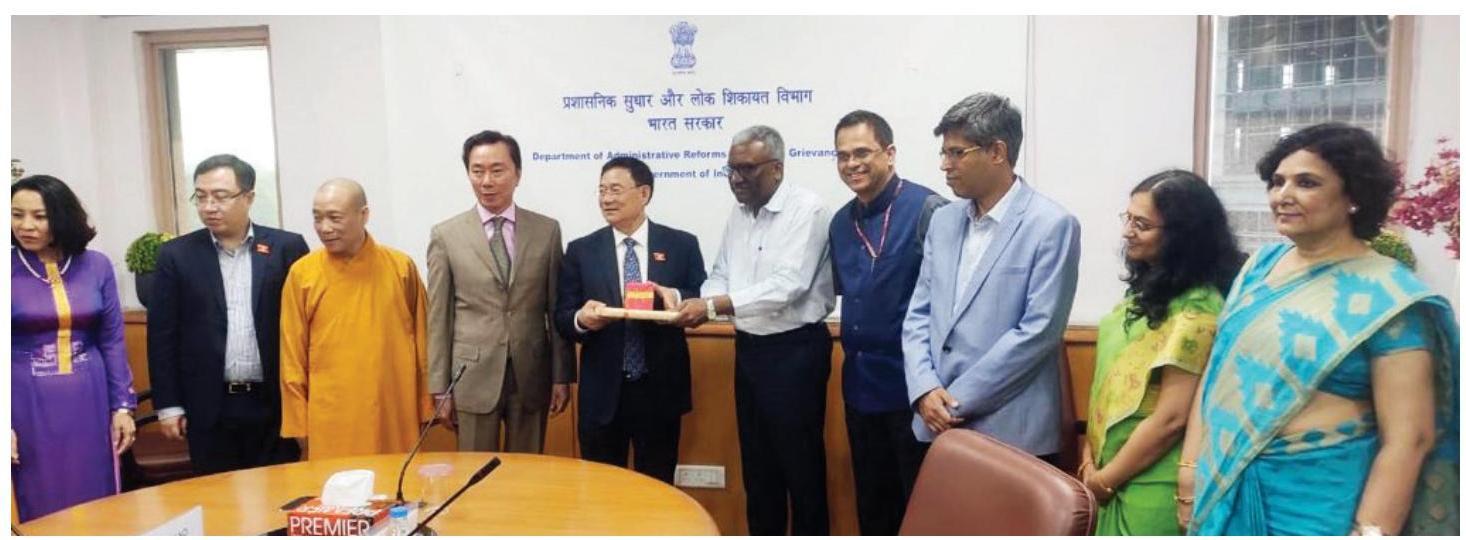
Mr Tran Van Tuy, Member, Central Party Committee \& Dy Head of the Party’s Central Committee’s Commission for Organization, Vietnam meeting with Sh. K.V. Eapen, Secretary, DARPG and discussed India-Vietnam collaboration in e-Governance
24.10.3 Visit of Delegation to Maldives
A 2-member delegation led by Shri V. Srinivas, Additional Secretary, Department of Administrative Reforms and Public Grievances, visited Male, Maldives on 19-20 August 2019 to operationalize India-Maldives MoU on Training and Capacity Building Programme for Maldivian Civil Servants. As a part of this initiative, the first Capacity Building Training Programme in Field Administration for the Civil Servants of Maldives was successfully
organised in collaboration with the National Centre for Good Governance (NCGG) from $08^{\text {th }}$ to $20^{\text {th }}$ April 2019 in New Delhi.
During the visit, Shri V. Srinivas also addressed Permanent Secretaries and Deputy Secretaries of Government of Maldives at Civil Services Training Institute, Male, on the theme “Ethics and Accountability in Governance and Redressal of Public Grievances – The Indian Experience”.
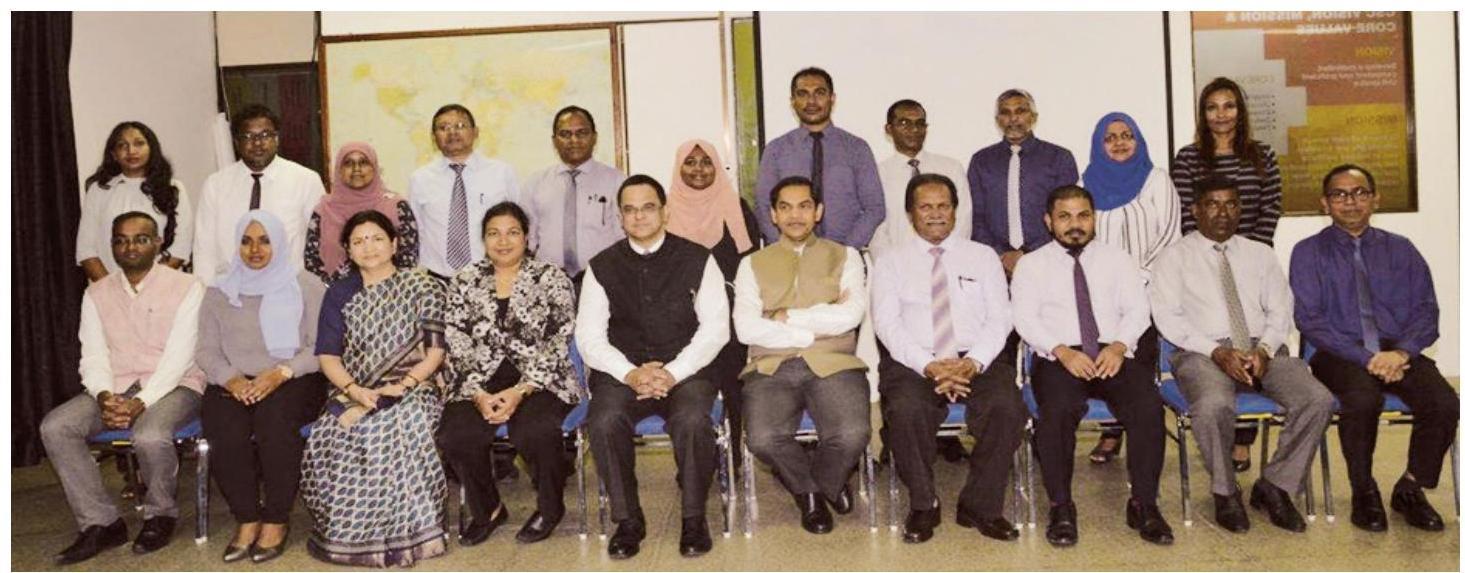
Senior Officials of DARPG, NCGG, Civil Service Commission of Maldives & Civil Services Training Institute of Maldives with High Commissioner of India to Maldives
ASSOCIATION WITH MULTILATERAL ORGANIZATIONS IN THE FIELD OF PUBLIC ADMINISTRATION
24.11 Cooperation with International Institute of Administrative Sciences (IIAS)
24.11.1 TheDepartmentis an institutional member of the International Institute of Administrative Sciences (IIAS), Brussels, Belgium since 1998. IIAS was established to promote the development of Administrative Sciences, better organization and operation of public administrative agencies, improvement of administrative matters and
techniques and for the progress of International Administration. Additional Secretary (DARPG) is on the Council of Administration of IIAS in an exofficio capacity. Additional Secretary (DARPG) has been nominated Vice President for South East Asia and the Pacific region of IIAS for the term 2016-19.
Shri V. Srinivas, Additional Secretary, DARPG participated in IIAS Council of Administration Meeting held in Singapore on $18^{\text {th }}$ June 2019. During the meeting enhanced collaboration between IIAS and the DARPG in the areas of
capacity building of Senior Civil Servants of India, refurbishing personnel administration, ethics,
transparency and accountability, and effective grievance redressal mechanisms, were discussed.
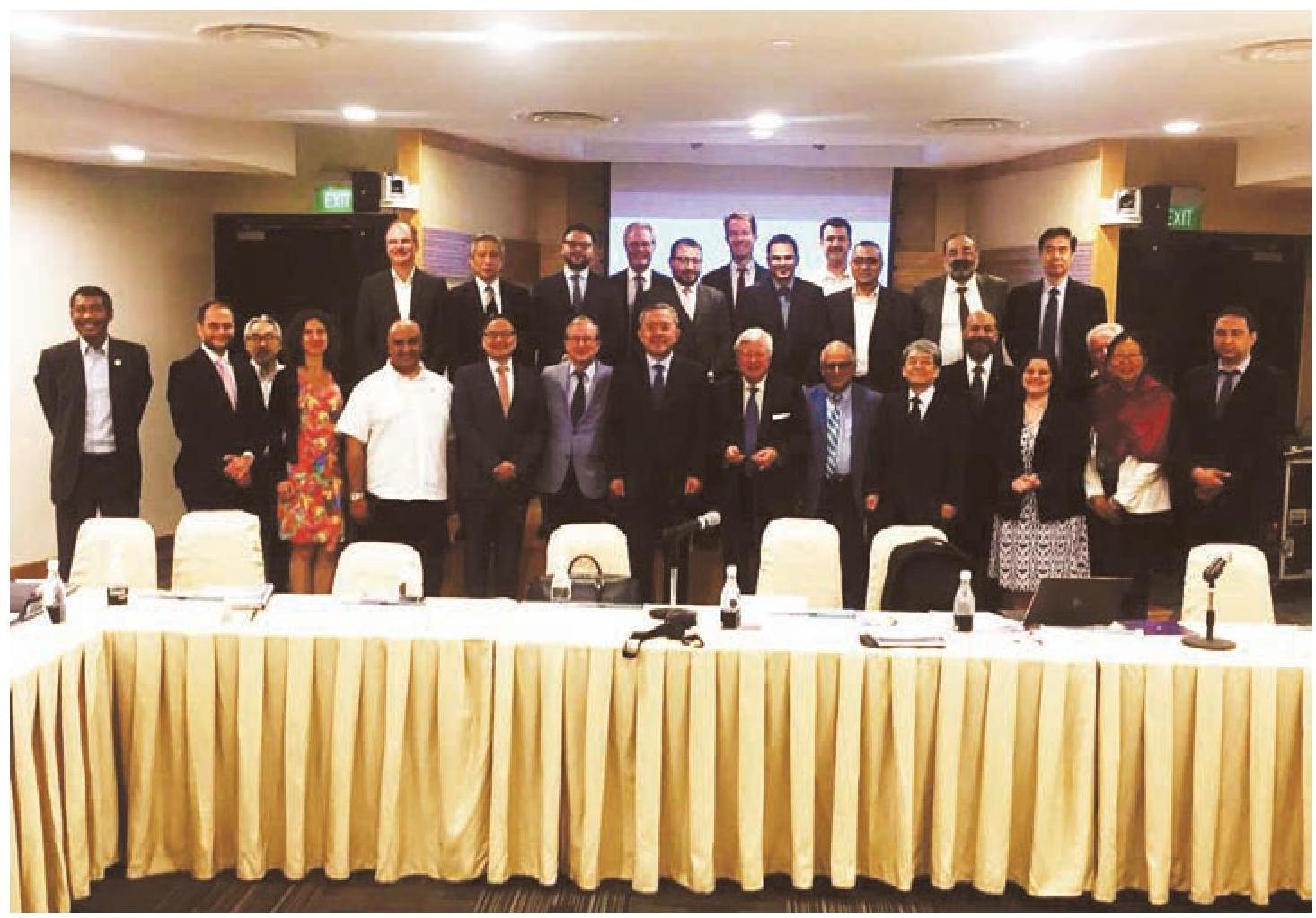
Group Photo of the IIAS Council of Administration Meeting held in Singapore on $18^{\text {th }}$ June 2019.
24.12 Capacity Building in the field of Public Administration and Governance
24.12.1 As part of its international collaborative efforts, Department has been exploring the possibility of learning and sharing the administrative experiences of other countries, particularly in the area of e-Governance and on-line delivery of public services.
24.12.2 During 2019, the Department organized a Foreign Training Programme on the theme ‘Minimum Government with Maximum Governance’ for a group comprising 12 officers
of Government of India and States/UTs including recipients of PM/National e-Gov Award winners at the Duke University, Duke Center for International Development, Durham, USA during 14-18 January 2019.
24.12.3 The Department in collaboration with the National Centre for Good Governance, an autonomous body under the Department, also organized the $2^{\text {nd }}$ Batch of Capacity Building Programme of 11 Member delegation led by the
Vice-Chairman, Public Services Commission of Gambia, Mrs Awa Auber, from 2-6 December
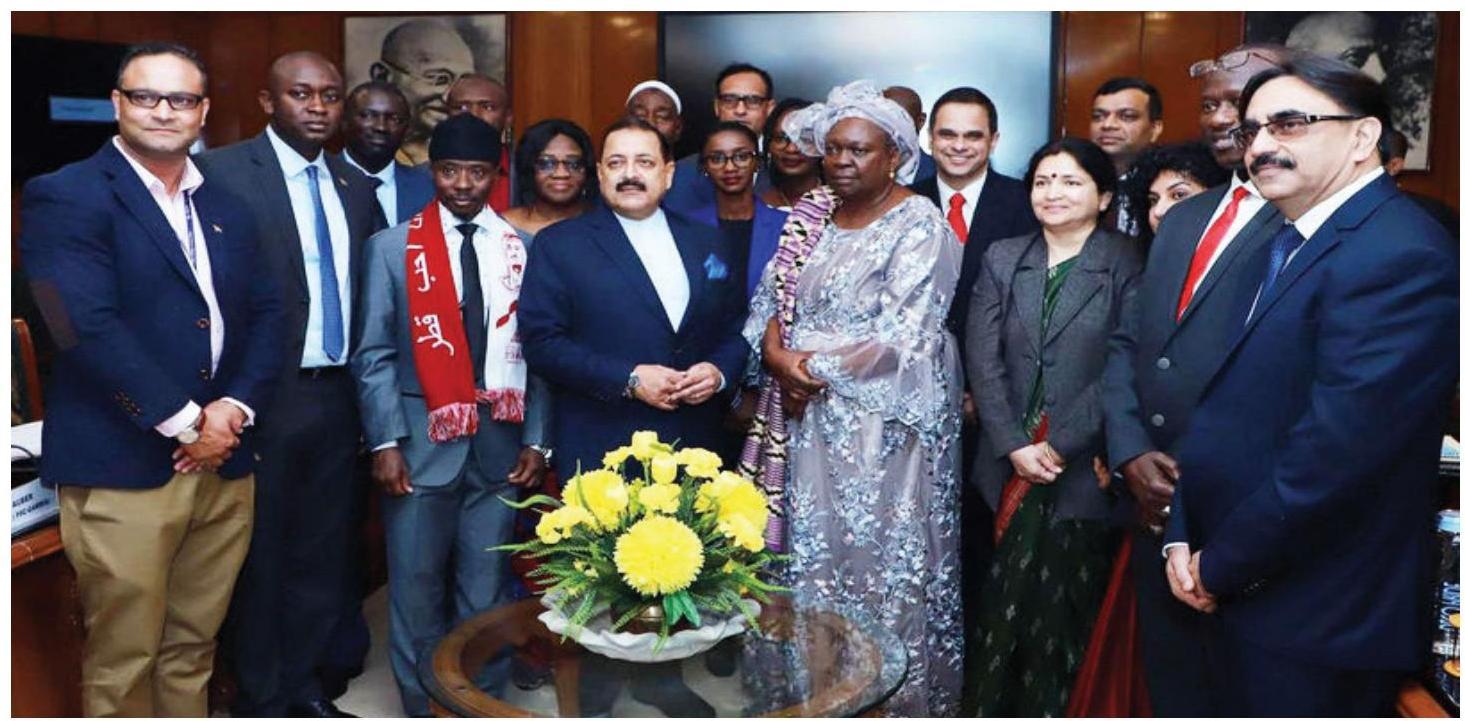
Hon’ble MoS(PP) with Gambian and Indian Delegation in New Delhi
Another Capacity Building Training Programme for 15 Permanent Secretaries and Secretary Generals of Maldives was also organised from 6-13 December 2019 in New Delhi. The training
programme focused on topics such as Public Policy & Governance, E-governance, and Public Grievance Redressal etc.
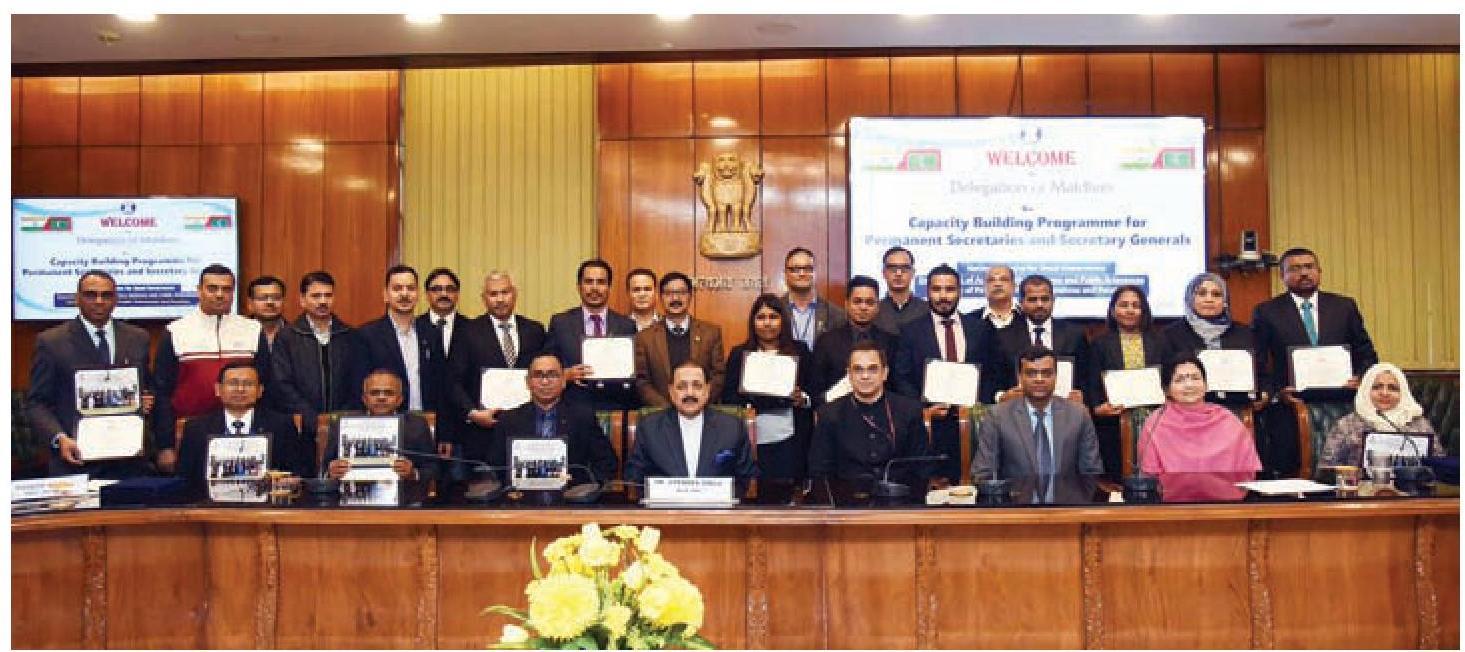
MoS(PP) with Indian and Maldivian delegation at the Valedictory Session of the Capacity Building Program held on $13^{\text {th }}$ December 2019 in New Delhi
CHAPTER
DOCUMENTATION AND DISSEMINATION DIVISION
25.1 The Documentation and Dissemination Division of the Department primarily carries out the activities of documentation and dissemination of good governance practices of Central and State Governments and Union Territory Administration with a view to facilitate sharing of experience with one another and replication elsewhere.
25.2 It provides financial assistance to State Governments/ UT Administrations/Central Training Institutes (CTIs) for professional documentation and dissemination of ‘Good Governance Practices’ with a view to share experiences and replicate elsewhere. So far eighty-two projects have been sanctioned. Financial assistance up to ₹ 3.00 lakh is provided for professional documentation. The report is required to be in e-Book, along with a short documentary film.
25.3 Organization of Regional Conferences:
Regional Conferences are organized on specific themes in association with various State Governments with a view to bring National and State level organizations along with other stakeholders to share experiences in the formulation and implementation of good governance practices.
25.3.1 This year, first Regional Conference on the theme: “Replication of Good Governance Practices in UT’s J&K and Ladakh” in collaboration with the Government of Jammu \& Kashmir was held on November 15-16, 2019 at Jammu. During the Valedictory session held in Jammu, the Conference had unanimously adopted the ‘Sushasan Sankalp’ after intensive deliberations during the sessions held over two days.
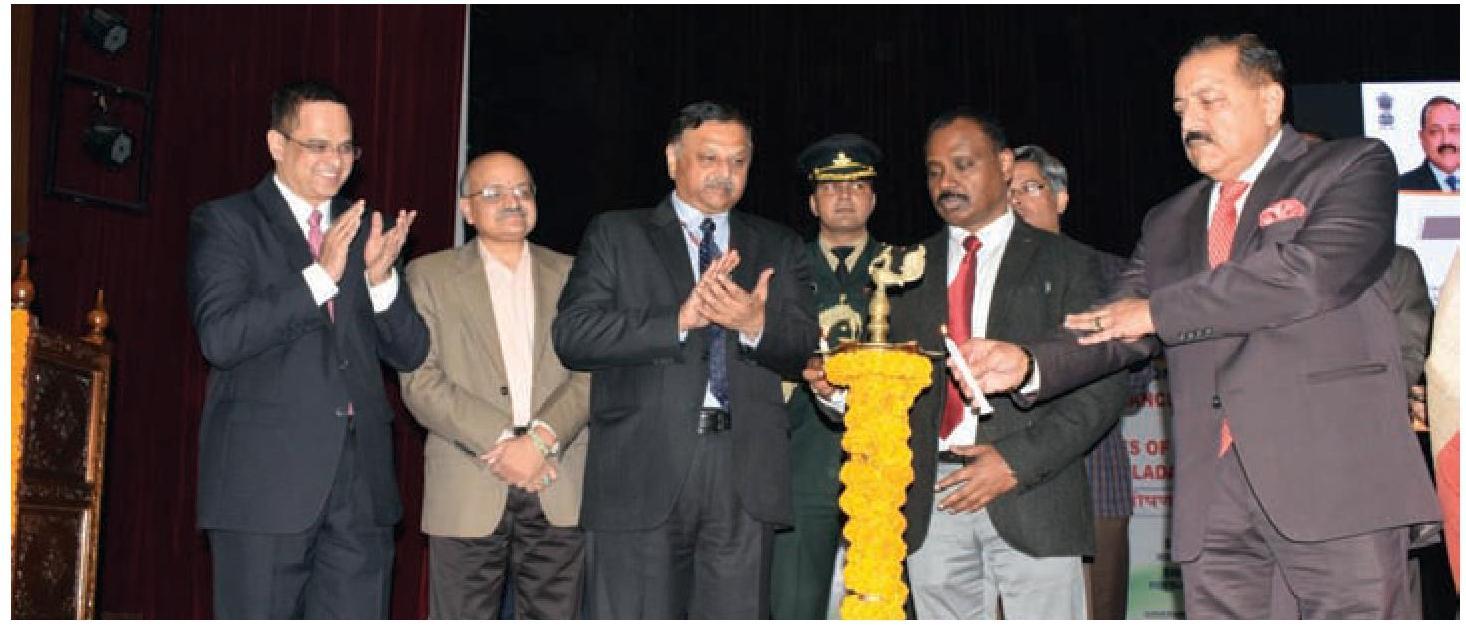
Inauguration of the two-day Regional Conference on ‘Replication of Good Governance Practices in UTs of Jammu \& Kashmir and Ladakh’ by the Union Minister of State (Independent Charge) Ministry of Development of North Eastern Region, MoS PMO, Personnel, Public Grievances and Pensions, Atomic Energy and Space, Dr Jitendra Singh at Jammu
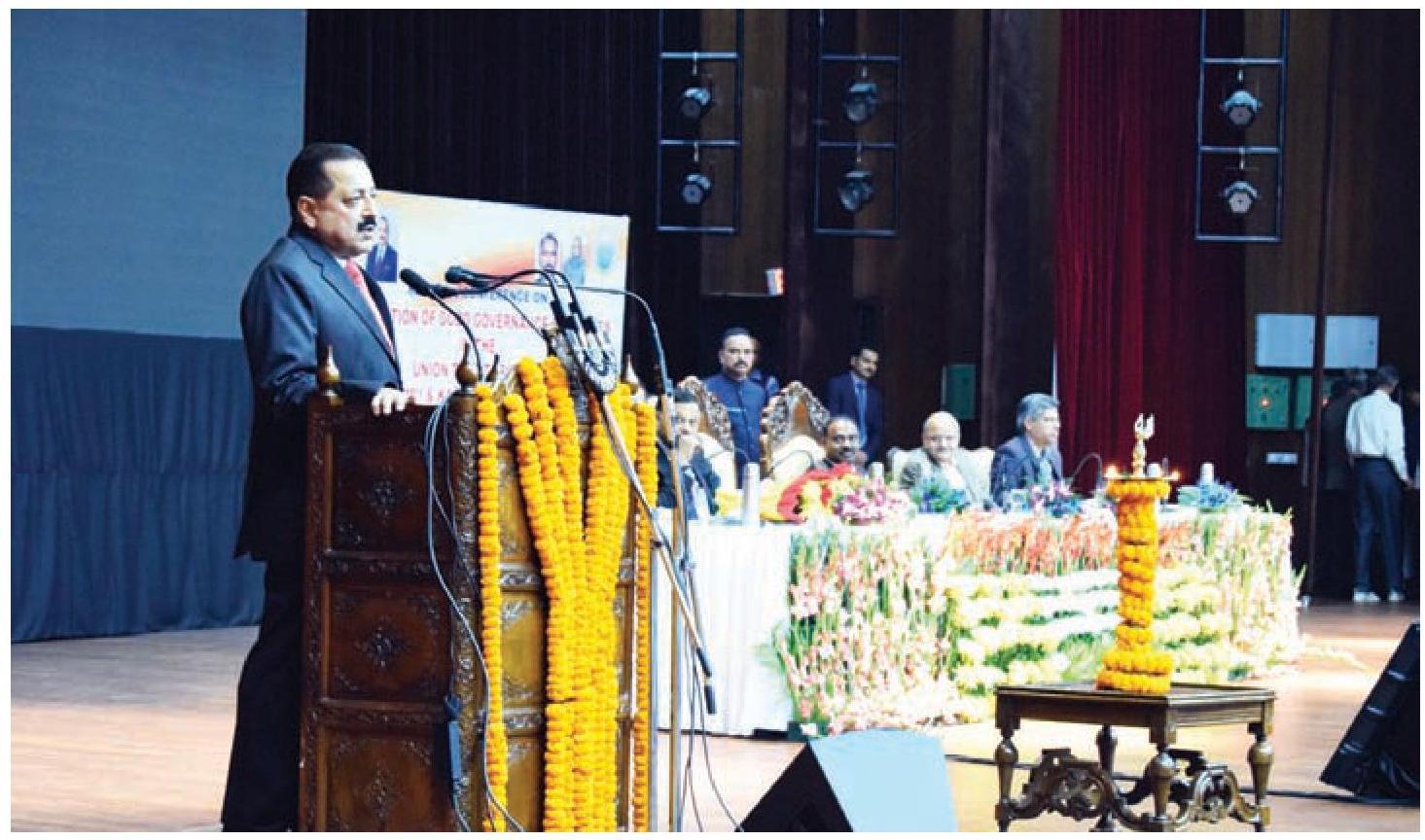
Union Minister of State (Independent Charge) Ministry of Development of North Eastern Region, MoS PMO, Personnel, Public Grievances and Pensions, Atomic Energy and Space, Dr Jitendra Singh addressing the participants during the First Regional Conference at Jammu
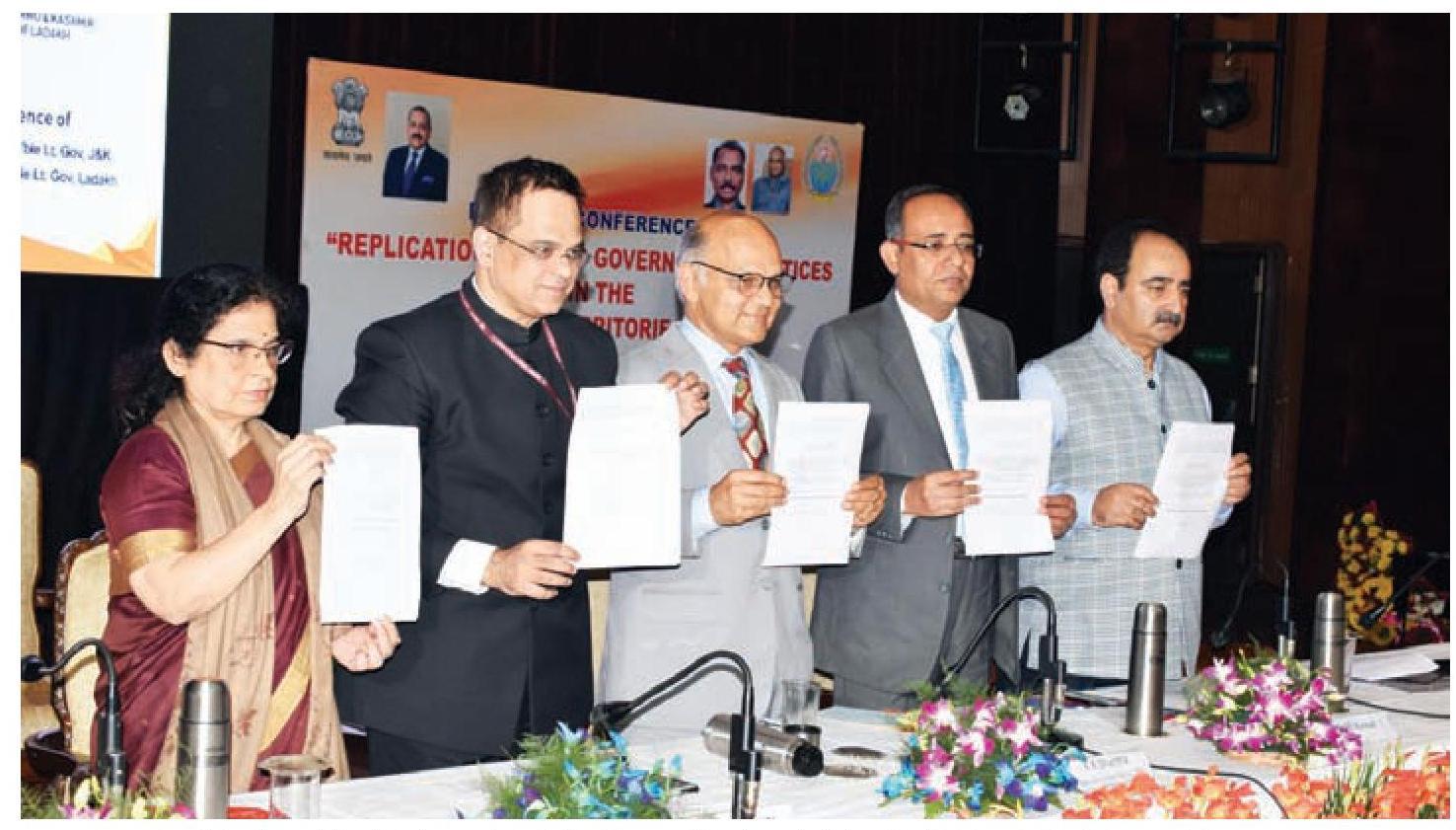
Adoption of the ‘Sushasan Sankalp: Jammu Ghoshana’ during the Regional Conference at Jammu
25.3.2 Second Regional Conference on the theme ‘Ek Bharat Shreshta Bharat’ with focus on Jal Shakti and Disaster Management was also held at Jammu on November 30-December 1, 2019 in
collaboration with Governments of Tamil Nadu and Union Territory of Jammu & Kashmir. During the Valedictory session, the ‘Sahyog Sankalp’ resolution was adopted by the Conference unanimously.
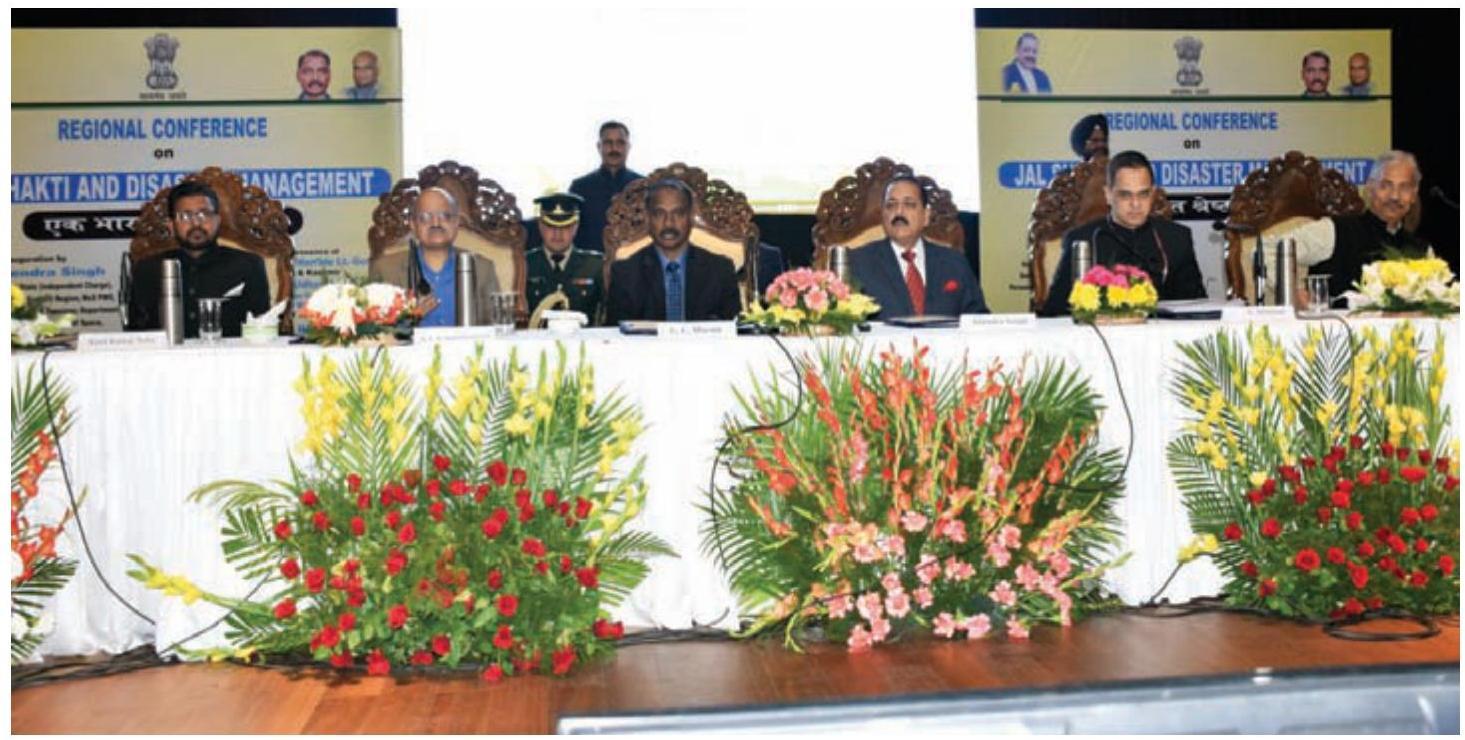
Dignitaries at the time of Regional Conference on Jal Shakti and Disaster Management at Jammu
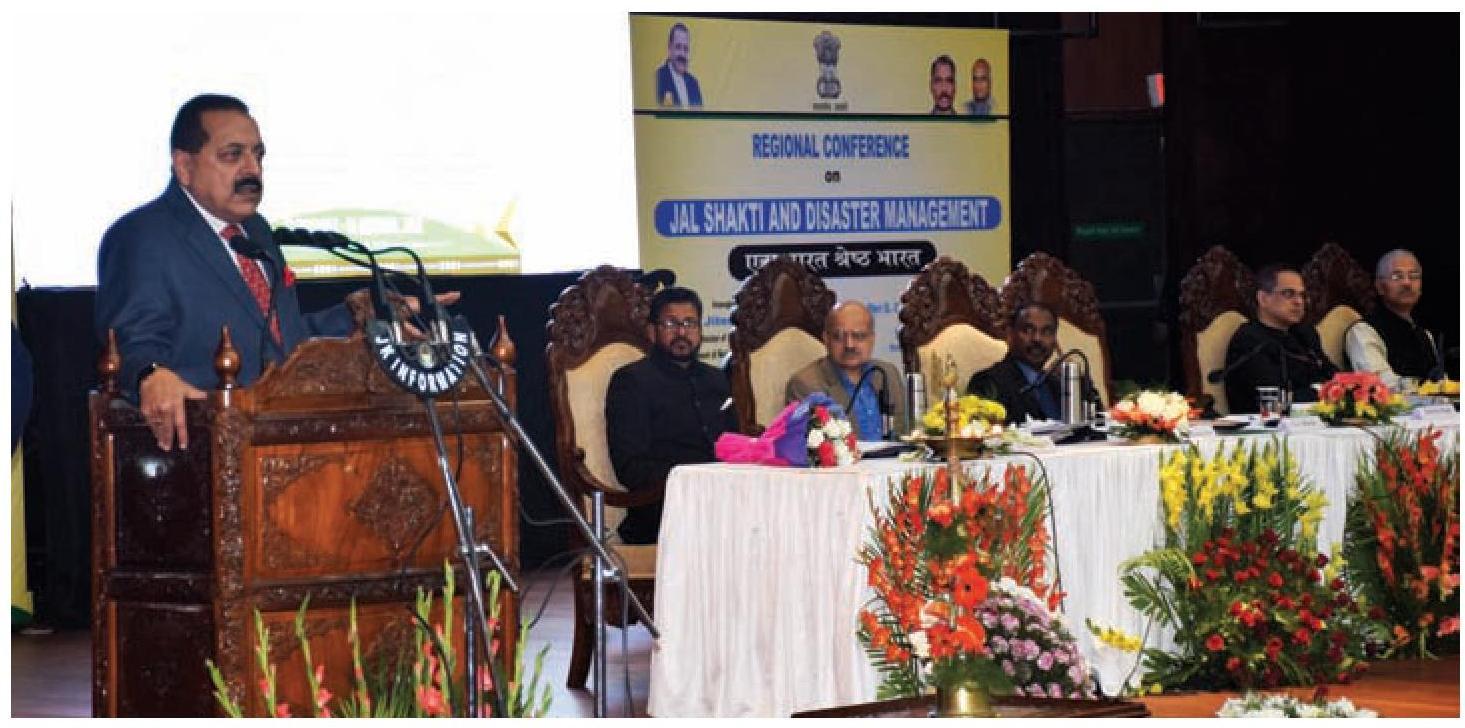
Union Minister of State (Independent Charge) Ministry of Development of North Eastern Region, MoS PMO, Personnel, Public Grievances and Pensions, Atomic Energy and Space, Dr Jitendra Singh addressing the participants during the Second Regional Conference at Jammu
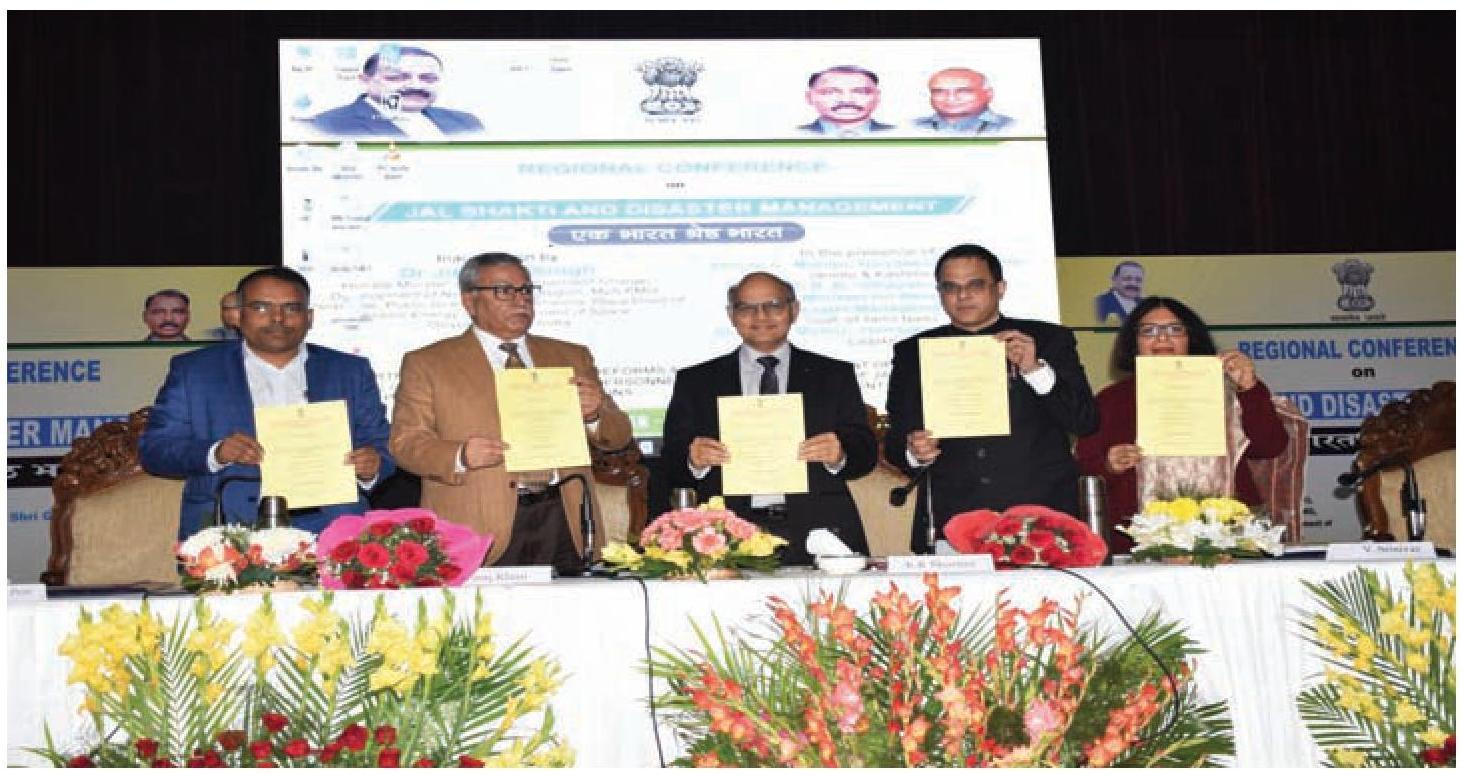
Adoption of the ‘Sahyog Sankalp’ during the Regional Conference at Jammu
25.3.3 Third Regional Conference on the theme ‘Improving Public Services Delivery – Role of Governments” was held at Nagpur in collaboration with the Government of Maharashtra on 21-22 December 2019. During the Valedictory session,
the Conference had unanimously adopted the ‘Nagpur Resolution- A Holistic Approach for Empowering Citizens’ after intensive deliberations during the sessions held over two days.
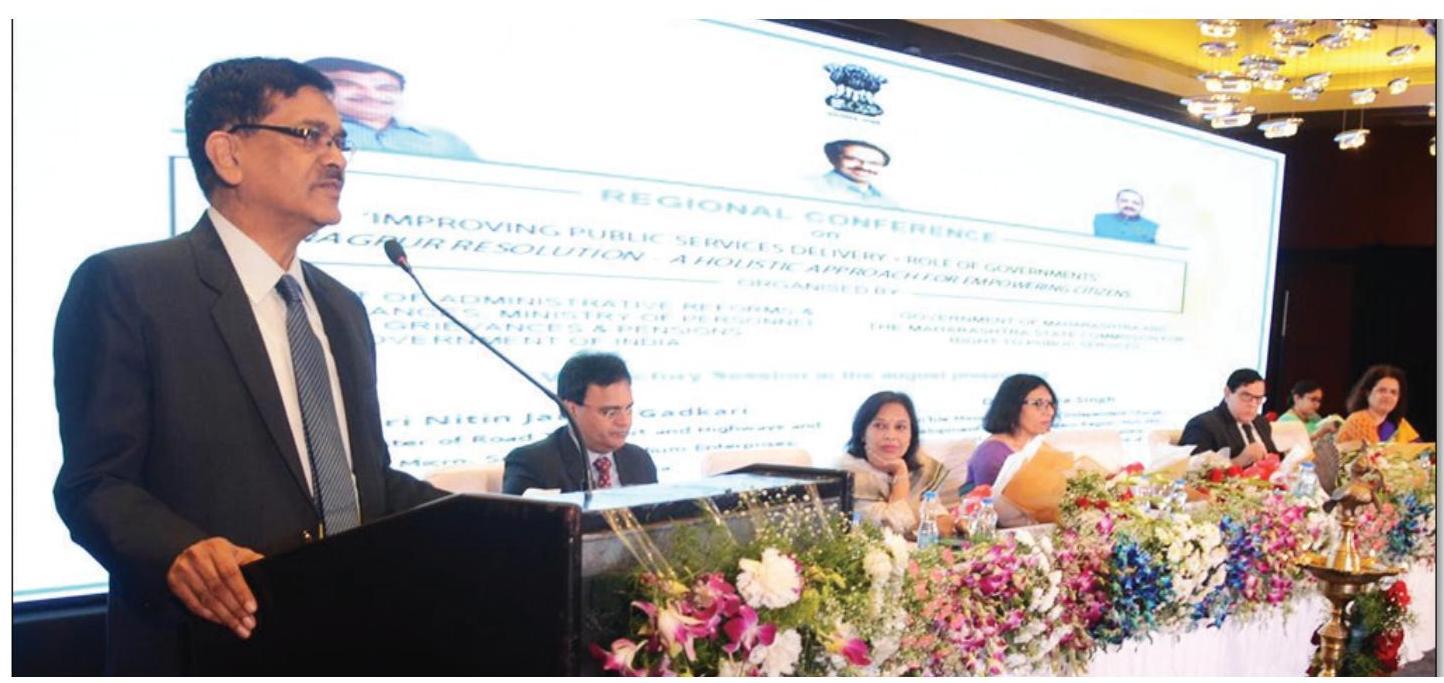
Shri Sanjay Kothari, Secretary to the President of India addressing the Inaugural Session of 2-day Regional Conference at Nagpur
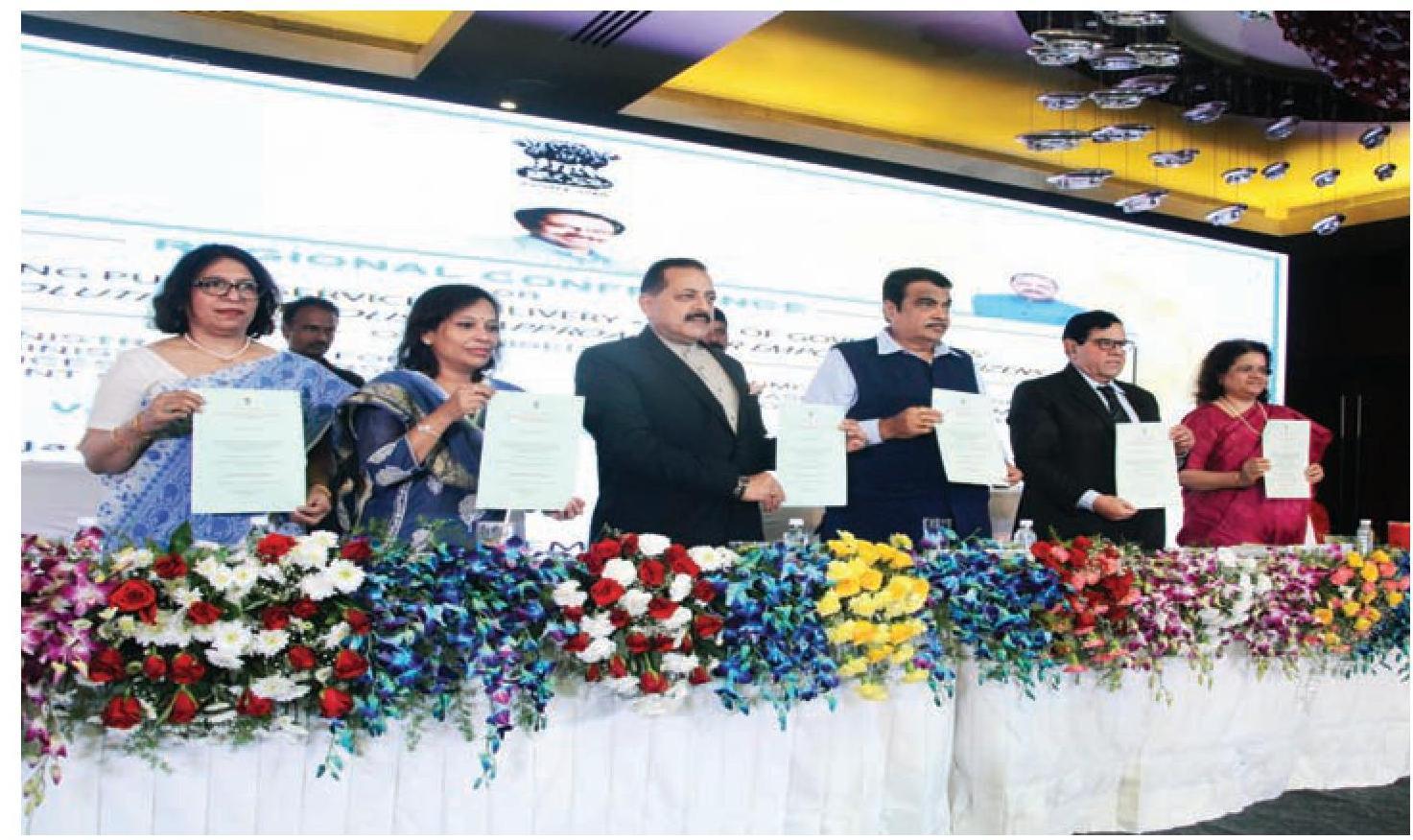
Adoption of Nagpur Resolution during Valedictory Session of Regional Conference at Nagpur
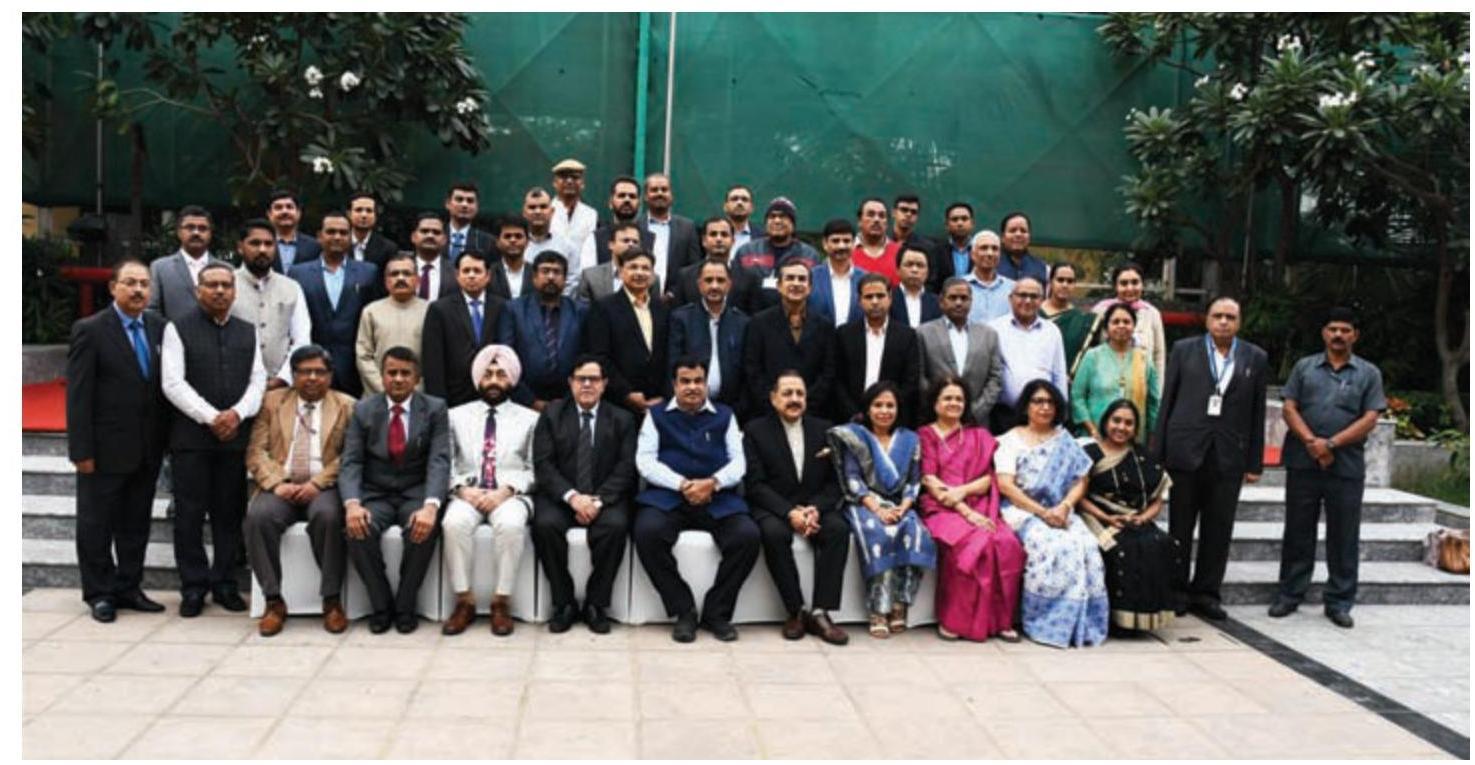
Union Minister for Road Transport & Highways and Minister for Micro, Small \& Medium Enterprises, Shri Nitin Jairam Gadkari and Union Minister of State (Independent Charge) Ministry of Development of North Eastern Region, MoS PMO, Personnel, Public Grievances and Pensions, Atomic Energy and Space, Dr Jitendra Singh with the participants in the Regional Conference at Nagpur
25.4 Publication of Books
This Division publishes books containing articles on select award-winning good governance initiatives. These articles are on the initiatives which were either shortlisted or have been conferred Prime Minister’s Award or National e-Governance Awards. The Division has already published a series of books on the subject.
25.5 Exhibition on the occasion of Civil Services Day
An exhibition on Success stories of identified priority programmes (and shortlisted Innovations by districts and Central, State organisations is organized by the Department during the observance of Civil Services Day every year. Creative works of Civil Servants are also showcased in the Exhibition. This included books, music, paintings etc.
25.6 Production of Documentary Films on Best Practices
The Department is engaged in producing documentary films on best practices across the country. These films are immensely useful for the administrators as they facilitate dissemination of success stories and their replication. Eighty-Five
such documentary films have been produced so far. The films are available on the Department’s website, as well as social media platforms such as Twitter and Facebook.
25.7 Publication of ‘Minimum Government – Maximum Governance’ – A biannual e-Magazine
25.7.1 The Department of Administrative Reforms and Public Grievances brings out its e-Magazine titled ‘Minimum Government Maximum Governance’ (MGMG) as an e-Book in its endeavours to document and disseminate successful good governance practices. In the e-Magazine, write-ups based on the shortlisted initiatives of PM Awards and National e-Governance Awards instituted by DARPG have been compiled. It is published on the website of the Department in e-Book form biannually.
25.7.2 The July-December 2019 issue of e-Magazine was published as a Special issue, based on Successful Innovations in Governance in the Union Territories of Jammu & Kashmir and Ladakh comprising of 11 innovations and it was released by the Hon’ble MoS(PP) during the Regional Conference at Jammu on November 30, 2019.
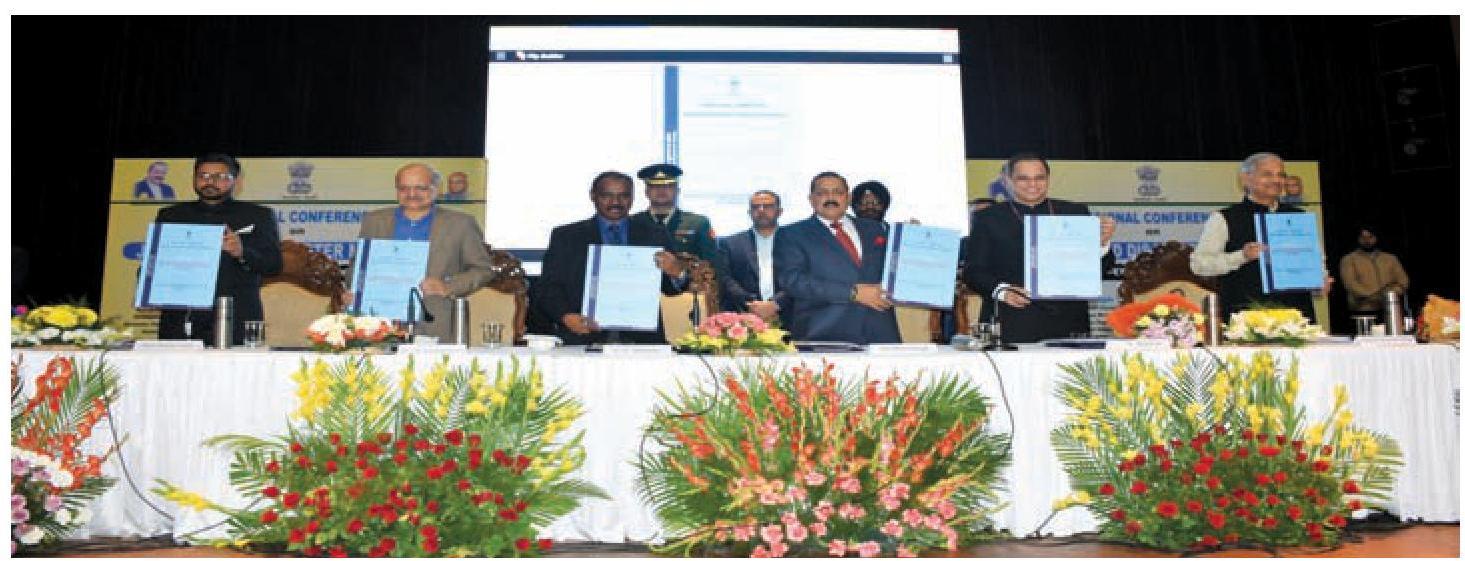
Dr Jitendra Singh, Hon’ble Minister of State (I/C), Ministry of DONER, MoS (PMO), Ministry of Personnel, Public Grievances and Pensions, Department of Atomic Energy \& Space releasing the Special issue of the DARPG e-Magazine, Minimum Government – Maximum Governance, July- December 2019 at Jammu.
CHAPTER
26
HINDI SECTION
26.1 Hindi Section of the Department of Administrative Reforms and Public Grievance is committed to complying with various guidelines issued by the Department of Official Language to promote the usage of Hindi language in the office.
26.2 The main function of the Section is to render Hindi translation of the works relating to the implementation of the official language Policy. These mainly pertain to collating of quarterly reports from various sections of the Department consolidating and furnishing to the D/o Official Language; translation and typing of Parliamentary related work Cabinet/CoS Notes etc. In addition, all the officers/sections are made aware of the guidelines issued from time to time by the D/o Official Language relating to the promotion of usage of Hindi and ensure their compliance in the Department as and when required.
26.3 Hindi Pakhwara was organized during September 13-27, 2019 in the Department. During this Pakhwara/period, various competitions on Essay writing, Noting drafting, Hindi Dictation and General Knowledge etc. were conducted for which the winners were awarded cash prizes.
26.4 The Department has attended meetings organised by Department of Official Language, Ministry of Home Affairs on various topics regarding the implementation of Official Language policy for Ministries/Departments.
26.5 The website of the Department of Administrative Reforms and Public Grievances has been updated and made bilingual.
CHAPTER
DEPARTMENT OF PENSION AND PENSIONERS’ WELFARE
27.0 The Department of Pension & Pensioners’ Welfare was set up in 1985 as part of the Ministry of Personnel, Public Grievances and Pensions to formulate policy and coordination of matters relating to retirement benefits of Central Government employees. Being the nodal Department for pension and pension-related matters, the Department receives a large number of references from Ministries/Departments/PSUs, etc. The Department also renders advice on the interpretation of Pension Rules and considers cases referred to it by Ministries/Departments for relaxation of the provisions of Pension Rules. In 2007, the Department initiated a web-based scheme – Pensioners’ Portal- which has now been expanded to run all pension welfare activities of Central Government Pensioners.
Vision
Active and dignified life for Pensioners
Mission
- Formulation of Pension Policy.
- Timely and Smooth payment of pension and other retirement benefits for Central Government Employees.
- Simplification of rules/guidelines and procedure and their dissemination.
- Facilitating prompt redressal of the pensionrelated grievances.
- Promoting the welfare of pensioners.
27.1 The Department administers the following rules:
i. CCS (Pension) Rules, 1972
ii. CCS (Commutation of Pension) Rules, 1981
iii. CCS (Extra-ordinary Pension) Rules, 1939
iv. GPF (CS) Rules, 1960.
v. CPF (India) Rules, 1962
vi. Payment of Arrears of Pension (Nomination) Rules, 1983
27.2 The approximate number of Central Government Pensioners as on 31/03/2019 is as follows:
| Category of Central Government Pensioners |
No. of Pensioners as on March 31, 2019 |
|---|---|
| Civil | $10,40,256$ |
| Defence | $32,35,730$ |
| Post | $3,28,818$ |
| Railway | $15,73,665$ |
| Telecom | $3,58,000$ |
| Total | $\mathbf{6 5 , 3 6 , 4 6 9}$ |
27.3 Pensioners’ Portal:
The scheme, ‘Pensioners Portal’ was started with an objective to serve as a one-stop information source for the pensioners of Government of India and also facilitate redressal of their grievances online. Over time, new activities were added under the ‘Pensioners Portal’ which now includes
CPENGRAM, Bhavishya, Anubhav and Sankalp etc. with an objective to create a single-window system for civil pensioners.
Pensioners’ Portal through its website provides pensioners with updated information on pension rules, personalized pension road map, online calculator for calculation of pension/family pension and redressal of Pensioners’ grievances through CPENGRAM. With effect from 01.01.2017, for ensuring transparency and accurate and timely settlement of pension dues it was made mandatory for all Ministries/ Departments to process pension cases on Bhavishya. Experiences of retirees while working in the government are being preserved in Anubhav which has become a treasure-house of information pertaining to various departments. Sankalp aims to prepare employees for postretirement life. 75.22 lakh hits were received on Pensioners Portal as on 13.12.2019.
BUDGET – In the year 2019-20, the Department has been allocated ₹ 1290.00 Lakhs to meet its expenses.
| Secretariat General Service | ₹ in lakhs |
|---|---|
| Salaries | 612.00 |
| Wages | 1.00 |
| Over Time Allowances | 1.00 |
| Medical Treatment | 5.00 |
| Domestic Travel Expenses | 12.00 |
| Foreign Travel Expenses | 16.00 |
| Office Expenses | 90.00 |
| Publication | 2.00 |
| Other Administrative Expenses | 18.00 |
| Minor Works | 30.00 |
| Professional Services | 03.00 |
| TOTAL | 790.00 |

27.4 Centralised Pension Grievance Registration and Monitoring System (CPENGRAMS):
Pensioners’ grievance redressal system has been expanded with the objective to provide easy access to pensioners in registering their grievances even on a phone call. An Integrated Grievance Cell & Call Centre was inaugurated on $20^{\text {th }}$ June 2019 for pensioners facilitating pensioners to register their grievance by calling on toll-free number 1800-111960. This centre also coordinates with different Ministries/Departments to resolve the problems of the elderly pensioners and keep the pensioners
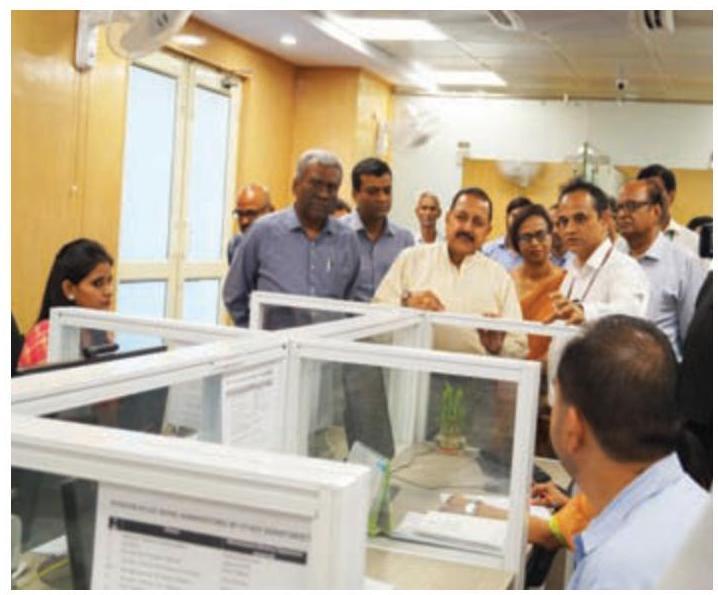
inform about the progress of their grievances.
The total number of grievance registered 28360 and 27253 grievances were disposed-off during 01.04.2019 to 30.11.2019 (90%) out of total registered grievances $70 \%$ received online, $12 \%$ through call and $17 \%$ by post. In $84.53 \%$ cases department close the grievances by taking positive action in 2019 -2020, in comparison to the year 2018 -2019 wherein positive response was $82.31 \%$.
The time limit to redress grievances is 60 days. During the period 01.04.2019 to 27.11.2019, $87 \%$ grievances were disposed of within 60 days and average disposal time was 30 days.
This department got conducted a Root Cause Analysis of pensioners’ grievances by an independent third party, keeping in focus the quality of disposal, which in some cases was
not satisfactory. The methodology adopted was a comprehensive review of focus Ministries and print out the root of the grievances.
As a result of this exercise, the various stakeholders of grievances were identified and action is taken to rectify the Root Causes of such grievances. This included review meetings with banks in such cases where delay took place in the initiation of pension/family pension, disruption in pension credit, discrepancy in the pension amount, not providing pension slips, delay in giving effect to change in the branch as desired by the pensioner. Banks have been advised to automate their system especially in providing pension slip every month with a break up through SMS, additional pension on attaining the age of 80 and above, restoration of commuted amount pension, confirmation of Digital Life Certificate to pensioners etc.
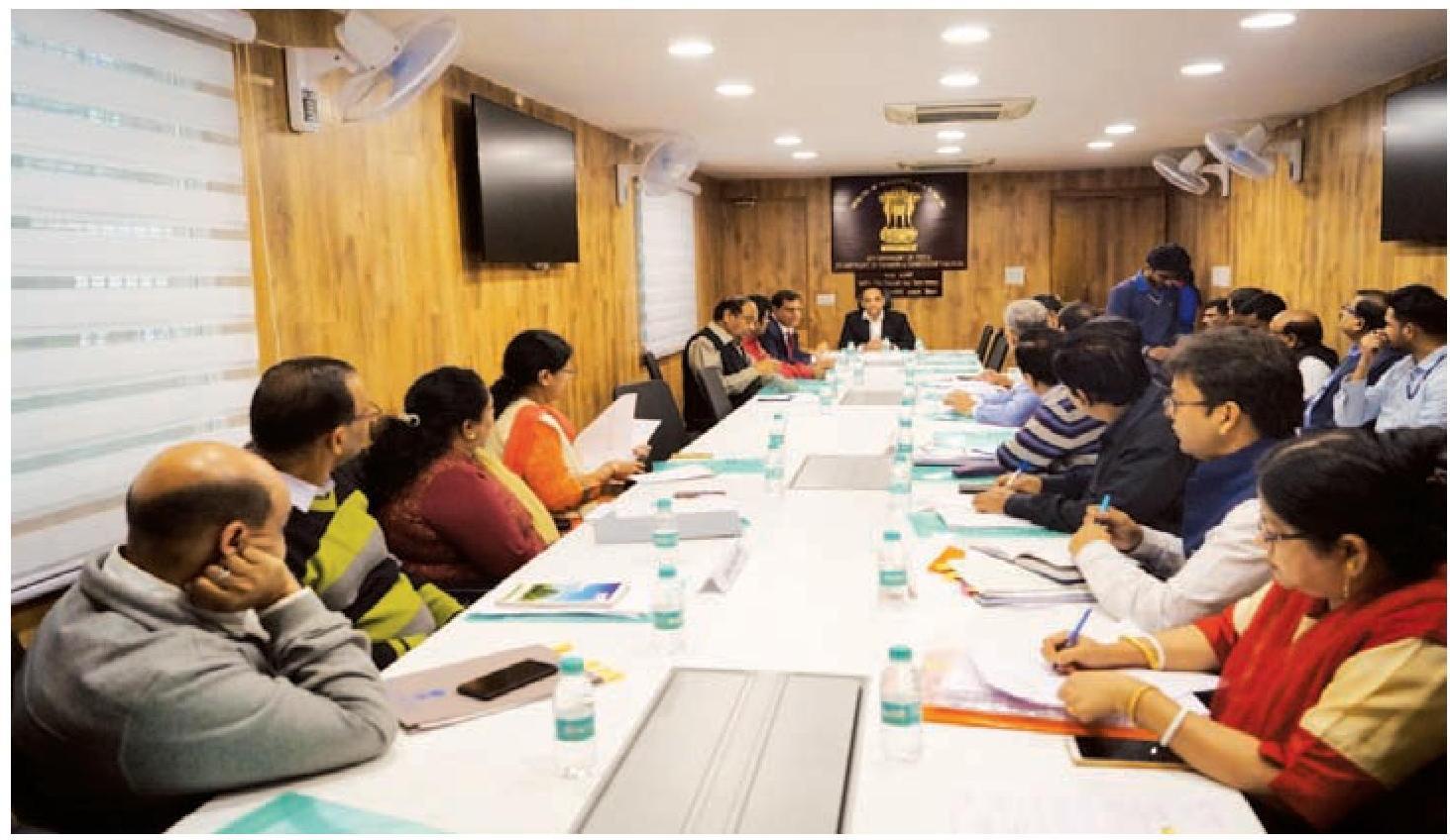
Adoption of Nagpur Resolution during Valedictory Session of Regional Conference at Nagpur
27.5 Pension Adalat:
This Department had started the unique experiment of holding Pension by inviting all the stake-holders of a particular grievance on a single table viz. the concerned Department, the PAO, the concerned Bank and representative of the Pensioner and resolves the case across the table. Accordingly, the first Pension Adalat of the Department was held on September 20, 2017. Out of 29 grievances raised in Adalat, 26 were resolved.
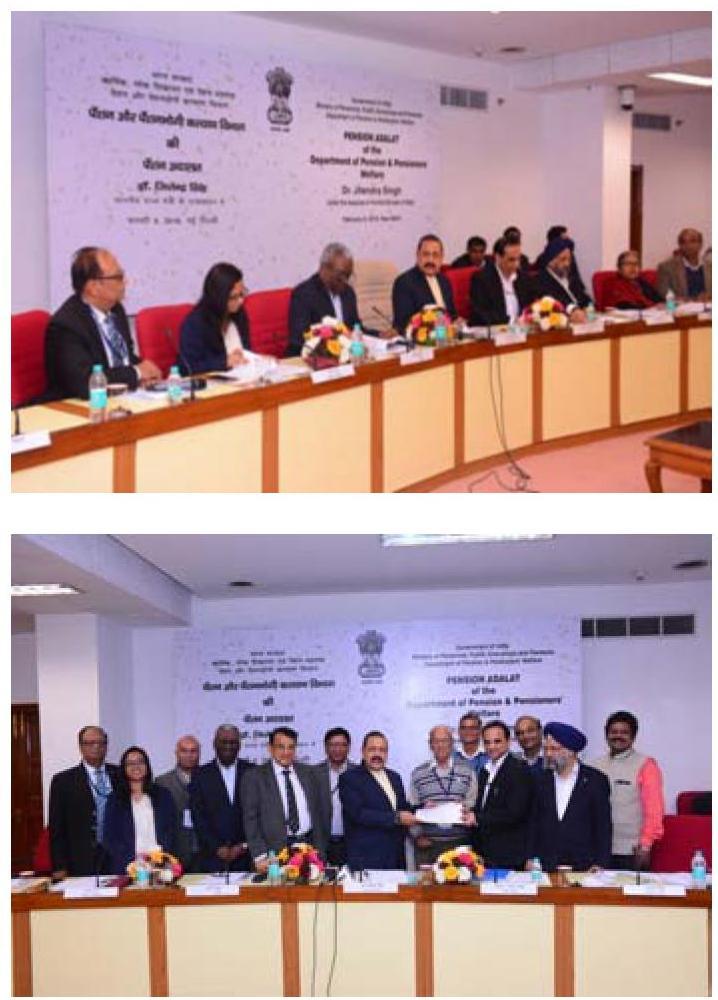
Encouraged by the response and speedy justice delivered, the Department organised the $2^{\text {nd }}$ Pension Adalat on February 9, 2018. Out of the 34 selected cases, 20 cases were resolved in the Adalat itself and 10 in subsequent months.
The Departmental Parliamentary Standing Committee for Ministry of Personnel, Public Grievances & Pensions in its $95^{\text {th }}$ Report appreciated the system of holding Pension Adalats and suggested that a day may be dedicated to the Pensioners, as part of good governance, and efforts be made to minimise their grievances. The Committee had suggested holding Pension Adalats, on a particular day, across Ministries, throughout the country, with this objective in view.
All India Pension Adalat – 2018: In its attempt to devote one day in the year to Pensioners, Department of Pension \& Pensioners’ Welfare conducted an All India Pension Adalat on September 18, 2018, which was inaugurated by the Hon’ble MoS (PP). These Adalats were conducted across Ministries/Departments throughout the country including all the Central Armed Police Forces (CAPFs) as well as non-Civil Ministries viz. Defence, Railways, Telecom and Posts. The Chief Secretaries of States were also asked to conduct Adalats for the All India Service Pensioners who fall within the jurisdiction of this Ministry. The model followed was to bring all the stake-holders viz. the Heads of the Department, the PAO office and the concerned Bank, on one table along with the pensioner or his representative and provide on-the-spot resolution. 12,849 cases were taken up for redressal in these Pension Adalat- 2018: 9,368 grievances were resolved on the same day and 1614 grievances of retired All India Service officers in the States on the same day.
On the same day, the Department of Pension \& Pensioners’ Welfare also organised $3^{\text {rd }}$ pension Adalat and took up 32 grievances of various Ministries where the pensioners have expressed his/her dissatisfaction over the disposal by the
concerned authorities. Out of these, 22 cases were settled on-the-spot in the Adalat. Suitable instructions/directions were given in the remaining
cases to the concerned Departments/PAO/CPAO/ Banks to resolve the grievances within a given time frame.
All India Pension Adalat – 2019
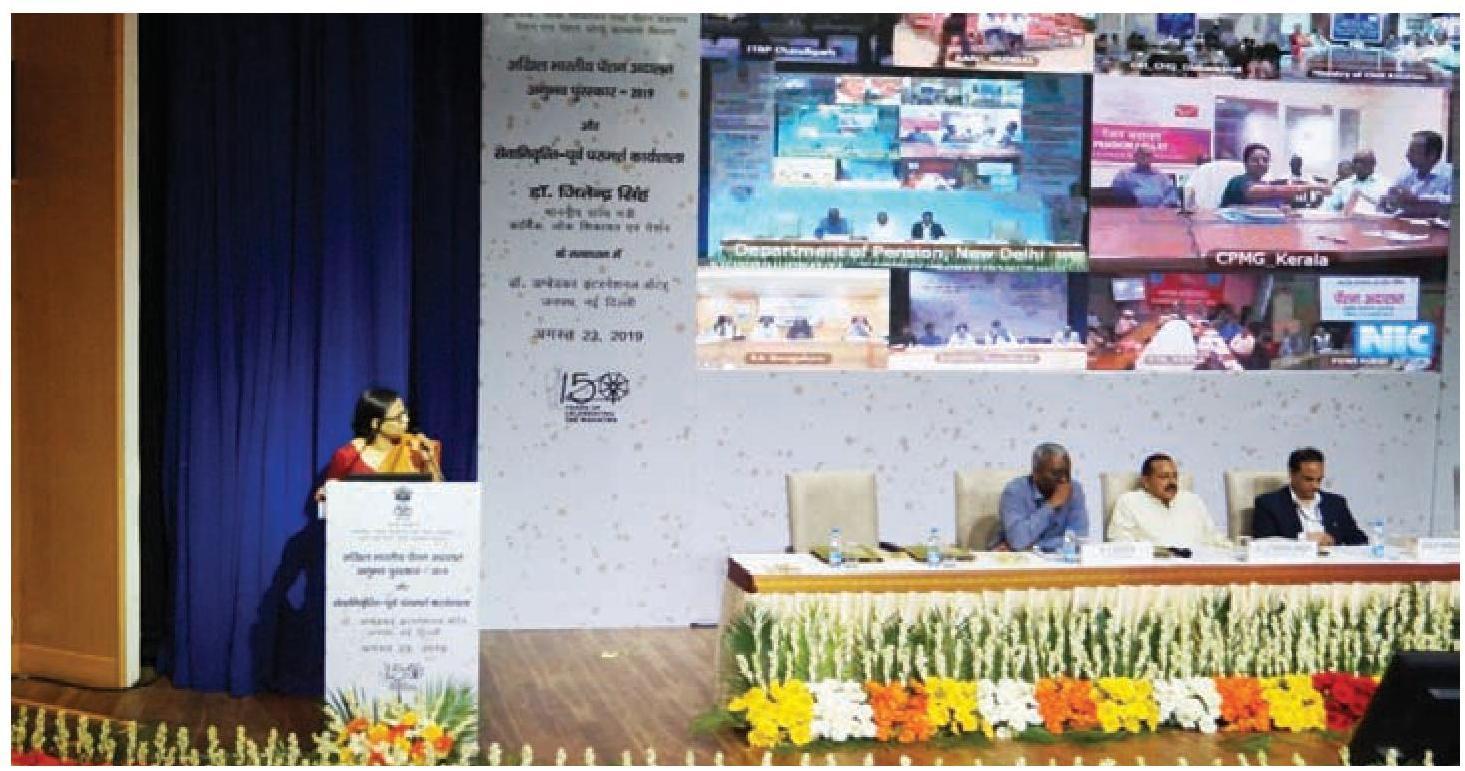
In August $23^{\text {rd }} 2019$ another All India Pension Adalat was organized by various Ministries and Departments all over the country. Hon’ble MoS (PP) Dr Jitendra Singh interacted with the nodal officers and pensioners present at these Pension Adalats through live video conferencing. More than 50 centres were connected through live video conferencing with the event being organized in Delhi. 4000 pending grievances relating to Central Government Ministries/Departments/Organisations have been resolved in one single day.
In continuation to hold pension Adalat as a nodal Ministry, Department of Pension & Pensioners’ Welfare also organised $4^{\text {th }}$ pension Adalat in series and took up 42 grievances for consideration. Out
of these, 29 cases were settled on-the-spot in the Adalat.
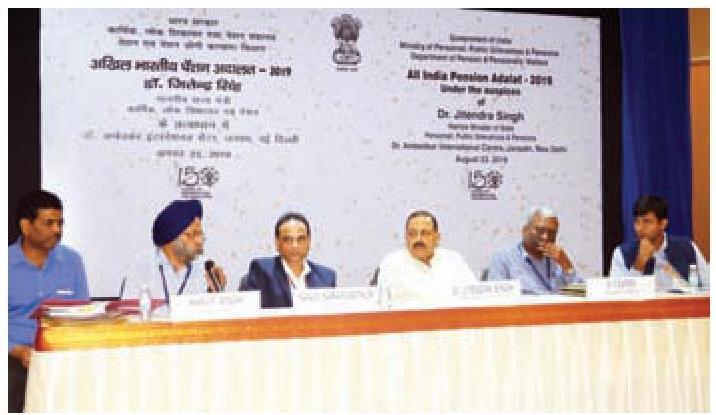
27.6 BHAVISHYA – Online Pension Sanction and Payment Tracking System:
To streamline the process of pension sanction,
DOPPW introduced a unique innovative centralized online pension processing software called ‘Bhavishya’ for all central government Civil Ministries/Departments. The ‘Bhavishya’ software was indigenously made by the Department of Pensions and was meant to be a common platform for processing of pension cases on this platform by all civil Ministries and Departments of Government of India. This software brought on a common platform all the stakeholders who were till date decentralized on to a single platform. Bhavishya has laid down the foundation of e-PPO with the integration of the PFMS system of Controller General of Account and PARAS system of Central
Pension Account Office. The system laid down a common methodology incorporating all the rules and regulations of CCS Pension Rules, 1972 and automatic calculation of pension. This system does automatic pension processing of dues and therefore eliminates manual intervention ensuring transparency in the system. The system on its keeps throwing up alerts to the pensioner as well as to the stakeholder for meting out the deadlines prescribed for various stages. As on date 797 offices are moving pension papers electronically from retiree to Head of Office, Pay and account office and to CPAO.
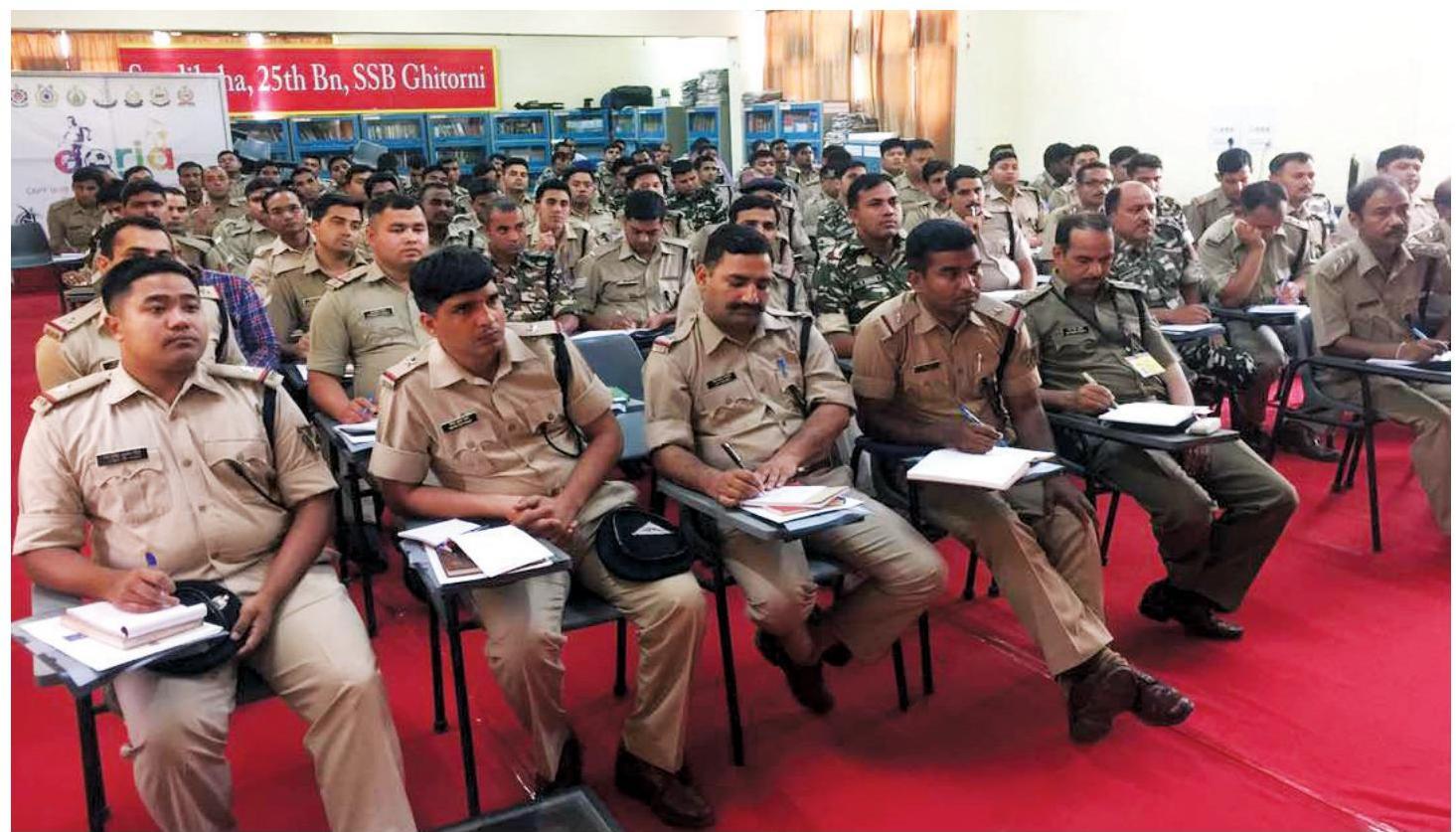
Till date, 7071 DDOs are on the board of Bhavishya processing pension cases of 36847 retiring/retired employees/family pensioners. A series of training sessions were organized for DDOs/ HOOs so that they may smoothly process the pension cases through. In the year 2019, 778 officials were
imparted training on the use of Bhavisya. Further, this application has so for cumulatively processed and issued PPOs in respect of 76648 employees till 13.12.2019. All the Central Armed Police Forces (CAPFs) i.e. BSF, CRPF, CISF, Assam Rifles, ITBP and SSB are on-board and processing their
pension cases through Bhavishya. Bhavishya has also been made operational for processing the Family pension/Invalid pension/ Extra Ordinary pension/Extra-Ordinary Family Pension cases for the employees covered under the National Pension System (NPS).
After covering Ministries/Departments, Bhavishya has been expanded to cover employees working under UTs and Delhi Police Administration. Accordingly, Hands-on training to 120 dealing officials of UT of Delhi and Delhi Police Administration has been completed by July 2019 while the same for UTs i.e. Daman & Diu, Dadar \& Nagar Haveli and Lakshadweep are under process.
Towards ensuring pensioners’ welfare for all central government pensioners, DoPPW has taken an initiative to coordinate for implementation of replication of Bhavishya type software and issuance of e-PPO in non-civil Ministries such as Railway, Defence, Post \& Telecom.
Missing of PPO or its Non-availability after few years of retirement is a very common complaint of pensioners and it is a very tedious process for pensioners or his / her family members to get the second copy of PPO from office. Toward ease of living for pensioners, DoPPW is inter-linking Bhavishya with Digi locker so that pensioners at any point of time can get the original record PPO in his hand without even visiting his office
27.7 Creating awareness on pensioners’ entitlements and Rules:
As recommended by the Parliamentary Committee of the Ministry of Personnel, Public Grievances and Pensions in its $95^{\text {th }}$ report, the Department
this year made more efforts to reach out to the pensioners, especially family pensioners, to inform them about government schemes meant for them including changes brought about in their entitlements.
Electronic, print and social media have a vital role in creating awareness of pensioners who are residing in various parts of the country. This department, therefore, planned and executed an awareness campaign by utilizing all of the above as well as holding awareness programs/ workshops in different parts of the country. As against a budget provision in FY2019-20 under the head Advertisement and Publicity of ₹ 2.29 crores, an amount of ₹ 1.99 crores was incurred by 30.11.2019.
An informative booklet Know Your Retirement Benefit was published for employees so that they get information about their various retirement benefits including medical facility under CGHS and further take the step to sanction of all their dues. All orders issued in 2019 -2020 are complied through compendium so that officials dealing with pension matters and Pensioners’ Associations may use it as a ready reckoner
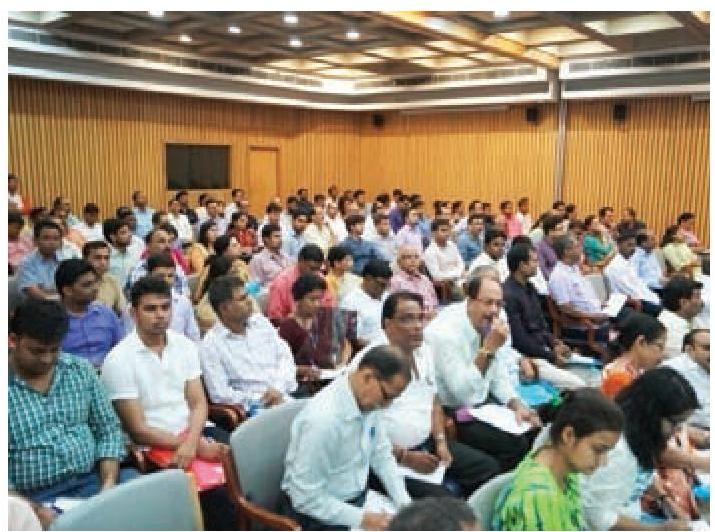
27.8 ANUBHAV:
On the directions of the Hon’ble Prime Minister of India, Department of Pension & Pensioners’ Welfare had launched an online platform entitled ‘ANUBHAV’ for sharing experiences of retiring government employees while working with the Government. It is envisaged that over some time, this will create a wealth of institutional memory with replicable ideas and suggestions. This will prove an invaluable tool for helping in future governancerelated issues since a treasure trove of wealth shall be left behind by the retiring generations of government employees and officers.
Further, this department organised analysis of the Anubhav portal through an independent third party with the objective to improve the working of the portal and concretizing the system of shortlisting
best write-ups for Anubhav Awards. It may be recalled that Anubhav Awards were instituted to encourage government servants to leave behind their experiences. As a result of the same, a proper system for evaluation of write-ups was put in place with the participation of departments other than DoPPW in the evaluation committee. Different areas of working were also short-listed for the awards so that all areas of government working get by and large covered and to give maximum participation of all departments with respect to their work.
During the Fourth Anubhav Award Ceremony, seven Awards were given by the Hon’ble Minister of State (PP) on August 23, 2019, to selected write-ups published from April 1, 2018, to March 31, 2019, on Anubhav Portal.
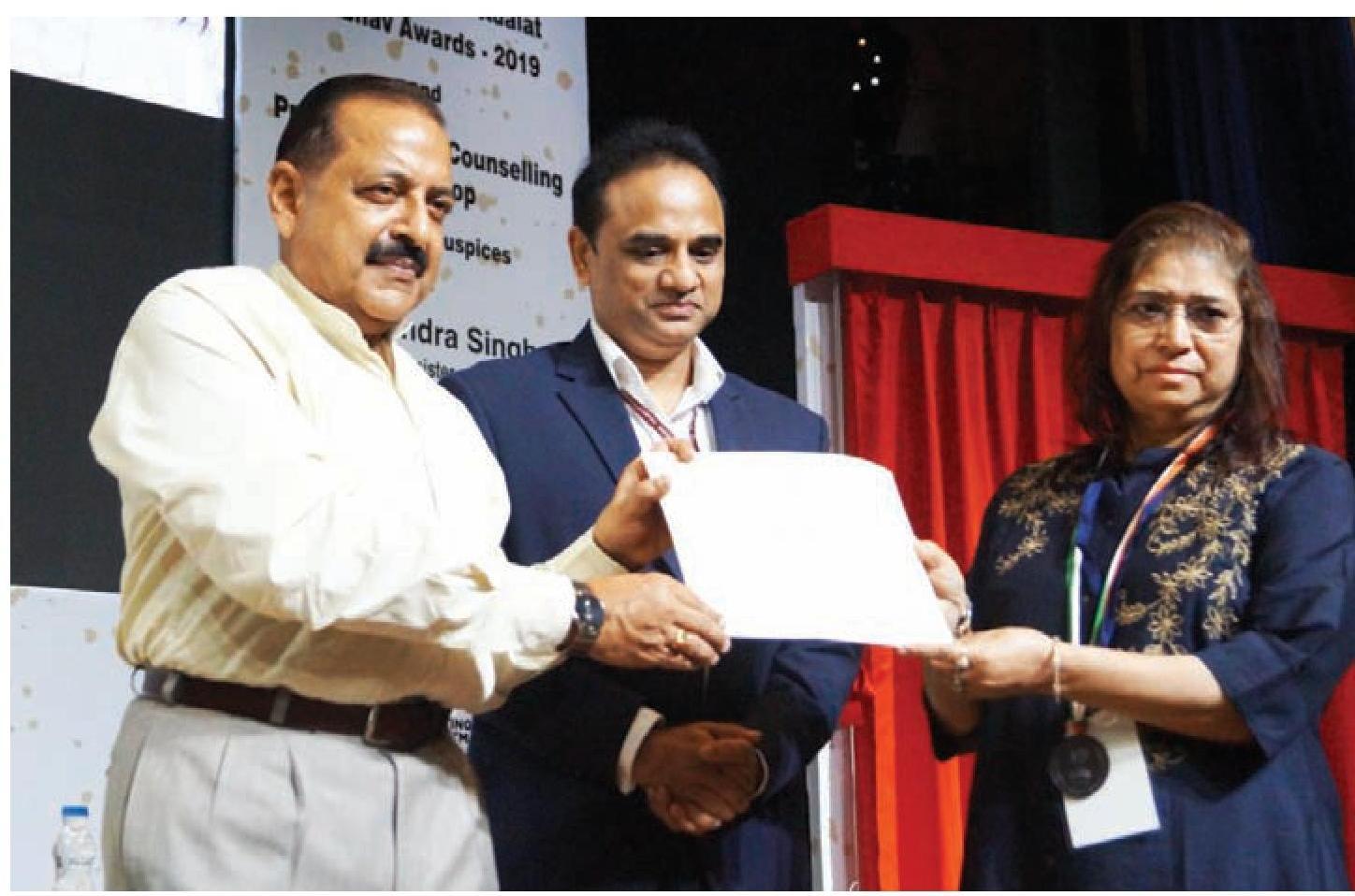
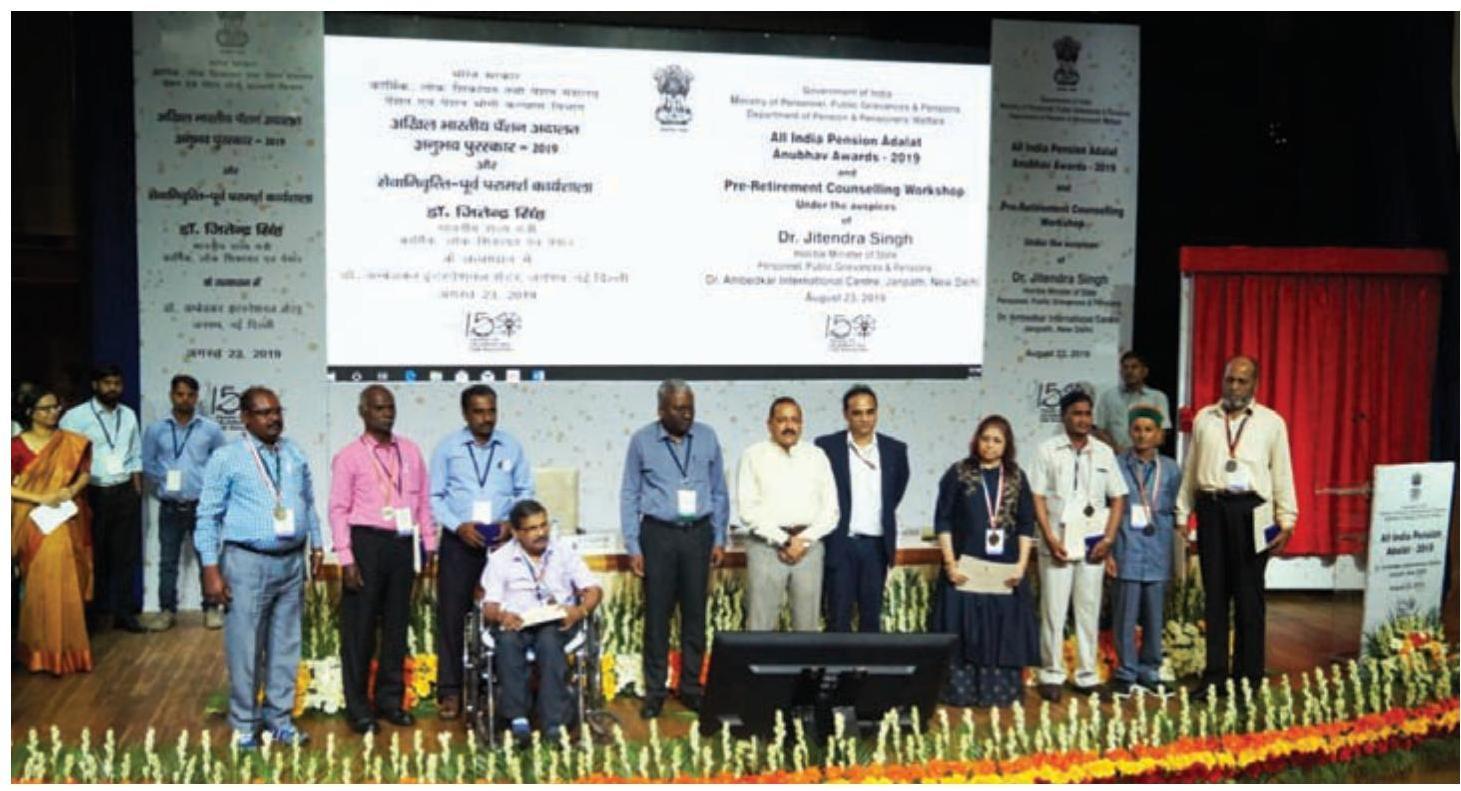
Fourth Anubhav Awards distribution on August 23, 2019
91 organizations have registered on Anubhav Portal of this Department, 6207 write-ups have been published and 2937 write-ups which have been uploaded are waiting to be published as on 12.12.2019.
27.9 SANKALP:
India has a fast-ageing population. Average life expectancy has risen to 69 years India and pensioners have on an average 10 years of postretirement life. Their withdrawal from the work sphere has important implications for them and in most cases lead to their confinement within their private sphere. In short, at retirement, social vulnerability increases and physical health goes down due to an inactive life. Ironically, at the time of retirement, the Pensioner is at the height of experience in the area in which he has devoted his entire career.
Keeping these factors in view, the Department initiated the scheme entitled ‘Sankalp’ which aims
to prepare retiring/retired Government servants for a fulfilling post-retirement life. Under Sankalp, pre-Retirement Counseling Workshops are being organized for retirees. These counselling sessions provide a detailed overview of entitlements of the pensioner and other benefits, CGHS facilities, investment plans, income tax incentives to senior citizens and voluntary engagement after retirement. In this year 1160 retirees participated in pre-retirement counselling held at Delhi, Kolkata, Lucknow and Ghaziabad.
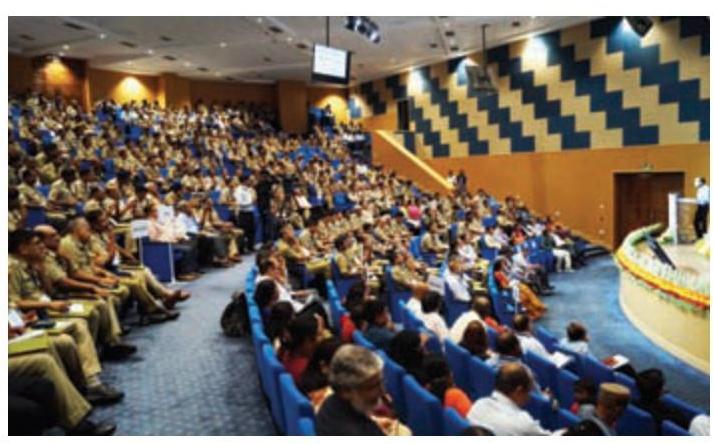
‘Training of Trainers’ workshop has also been initiated to strengthen in-house capabilities of Government Ministries/Departments for conducting their Pre-retirement counselling for their retiring employees. The Department has conducted 15 ‘Training of Trainers’ workshops till
date creating a pool of around 760 trainers. As the desire to remain active and socially connected attracts retired volunteers to service, D/o Pension & PW took up following activities this year where pensioners have offered their services voluntarily.
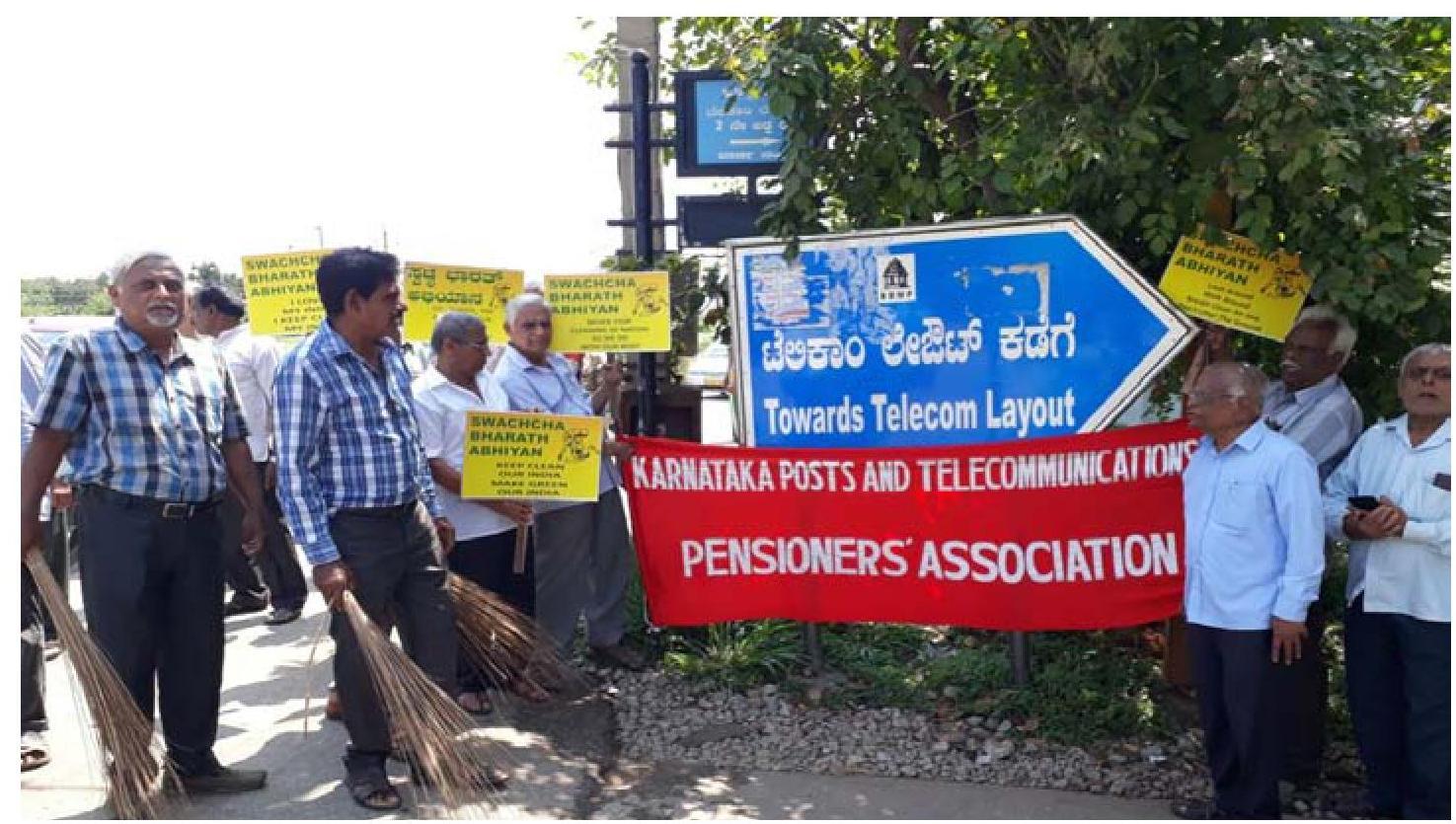
Observation of SWACHH BHARAT ABHIYAN by Karnataka Posts and Telecommunications Pensioners Association
- Pensioners’ Associations took up cleanliness drives in schools, residential colonies, streets, as well as in Parks. They also conducted awareness drives on waste collections amongst children, shop-keepers and households.
- Pensioners’ Associations were also roped in Digital Life Certificate (DLC) at Home activities under which they took the DLC of aged/sick/ above 80 years pensioners from their home/ hospitals etc.
27.10 JEEVAN PRAMAAN:
Every year in the month of November a pensioner is required to produce life certificate for further continuation of his pension. Pensioners can submit life certificate by physically presenting themselves before pension disbursing authority i.e banks or can send a certificate issued by a gazetted officer or the other designated authorities. The system lacks transparency as pensioners often make a complaint of not taking their life certificate in record although they visited the banks or send the certificate by post. In November 2014 an Aadhar
based scheme for online submission of digital life certificate Jeevan Pramaan was launched by the Hon’ble Prime Minister with the object to ensure transparency in the system and facilitate pensioners to submit life certificate at their comfort. In view of infirmity or other ailing elements due to old age, this department has been promoting Digital Life Certificate i.e. Jeevan Pramaan among Central Government Retirees. A documentary explaining the process of submitting DLC was made and awareness campaign through print & electronic was taken up to reach pensioners scattered across the country.
A Pilot Programme DLC from home campaign was started in 2018 by associating Pensioners’ group to reach out to aged (above 80 years) and infirm pensioners who are unable to visit bank branches. Around 2500 DLC’s were successfully
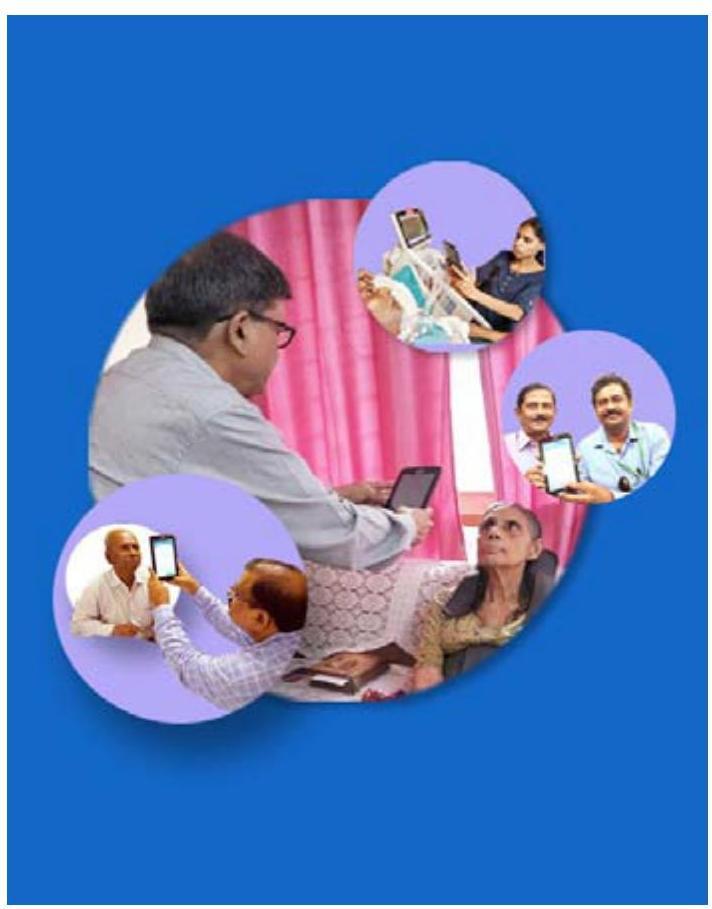
created by pensioners Associations in 7 cities. In October-November 2019, this project was expanded to cover 24 cities i.e. Hyderabad, Ranchi, Bhuvneshwar, Jaipur, Thrissur, Kolkata, Cuttack, Chennai, Guwahati, Madurai, Balasore, Jalandhar, Ahmedabad, Prayagraj, Pune, Dehradun, Mumbai, Bengaluru, Vadodara, Trivandrum, Mysore, Chandigarh, Noida, Delhi. Till 30.11.2019, around 4100 DLCs have been collected from such pensioners by the above Pensioners Associations.
Further to provide relief to 80 yrs and above aged pensioners for queuing up, one-month additional time window has been given to them for submitting life certificate vide OM dated 18.7.2019. Now they can give their Life Certificate from October, 1 onwards every year instead of $1^{\text {st }}$ November which would be valid till $30^{\text {th }}$ November of the subsequent year.
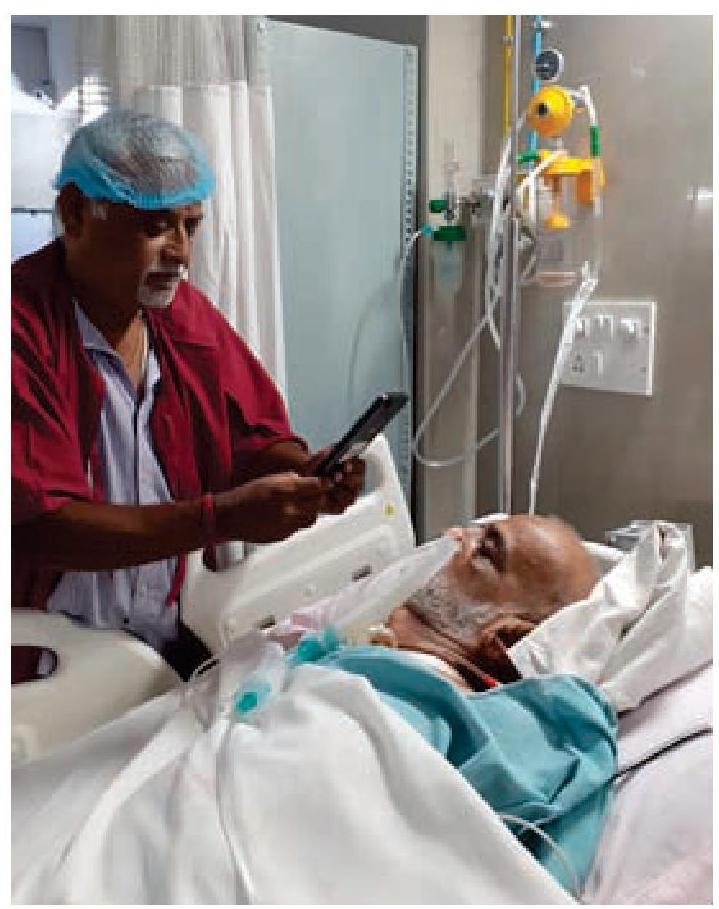
Pensioners’ Association facilitating DLC of Aged/Sick/above 80 years pensioners from their home and Hospitals.
Other efforts made by the Department towards this endeavour include: –
(i) Meetings with Banks and requesting them to instruct their branches that any pensioner going to submit Life Certificate to any bank branch should not be returned without submission of life certificate. It was stressed that the entire procedure should be automated i.e. downloading Digital Life Certificate (DLC) generated by Jeevan Pramaan Server and matching the details with their database and sending SMS to pensioner regarding matching/mismatching of the data for uninterrupted payment of pension. Banks were also requested to cooperate with Pensioners Associations during the Pilot Programme in those places where the Pilot Programme is to be conducted.
(ii) A meeting was conducted by Secretary (P&PW) I/c, on 26.11.2019 with Secretary (Posts) to explore the feasibility of collecting DLCs from the home of old pensioners
through the agency of Postmen. Substantial progress in this initiative was made as a result and the Department of Posts has inprinciple agreed to the proposal. The fine point’s w.r.t. implementing the initiative will be worked out by the two Departments.
27.11 Standing Committee of Voluntary Agencies (SCOVA):
A Standing Committee of Voluntary Agencies (SCOVA) has been set up under the Chairmanship of MOS (PP) with a view to provide feedback on the implementation of policies/programmes of this Department besides mobilizing voluntary effort to supplement the Government action. The SCOVA consists of a Standing Group (5 members) and a Rotating Group (10 members). SCOVA was reconstituted in January 2018. The last SCOVA meeting was held under the Chairmanship of Dr Jitendra Singh, Hon’ble Minister of State (PP) on September 5, 2019, in New Delhi, which was attended by representatives of various Pensioners Associations and the Ministries/Department.
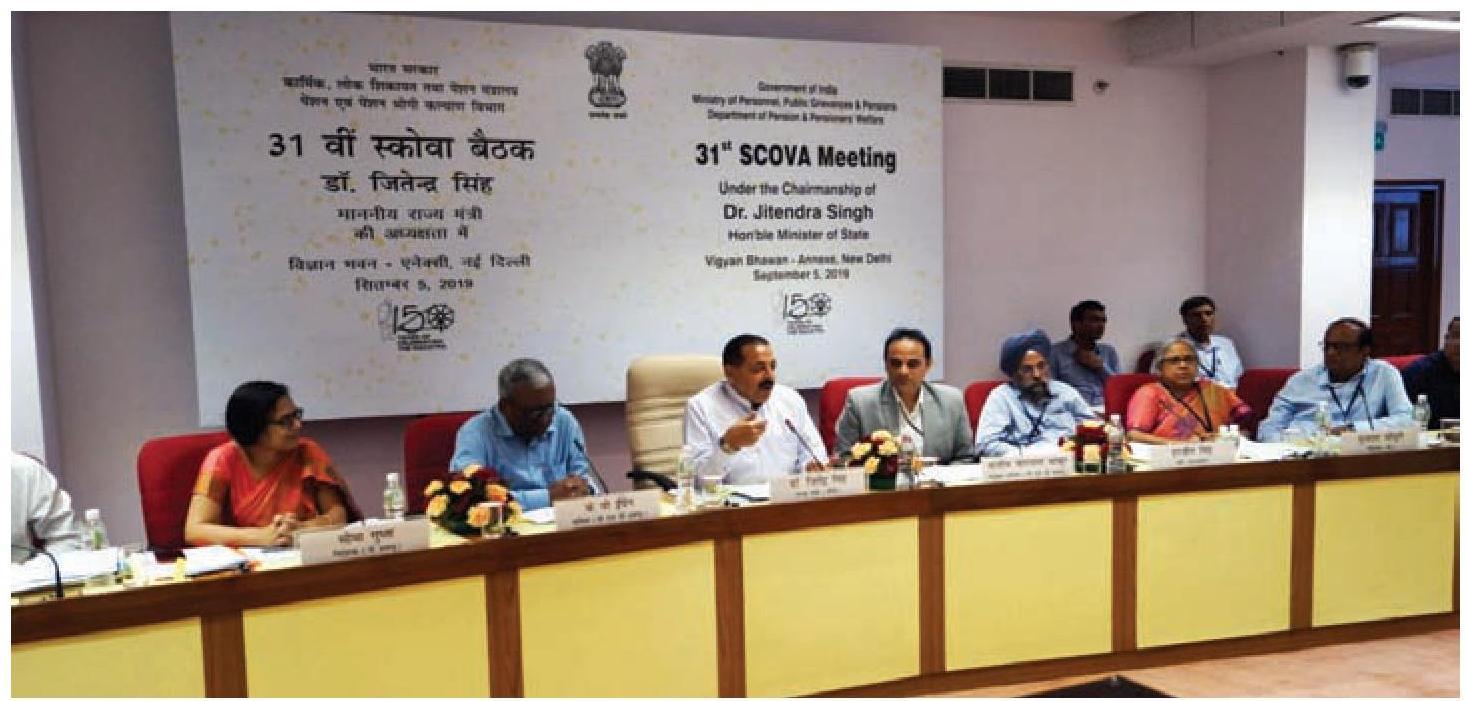
27.12 Dearness Relief to Pensioners/ Family Pensioners:
Revised rates of Dearness Relief (DR) to Central Government Pensioners/ Family pensioners on implementation of the decision taken on the recommendation of $7^{\text {th }} \mathrm{CPC}$ are admissible at the following rates:-
| Date from which payable |
Rate of Dearness Relief per month |
|---|---|
| From 01.01 .2019 |
$12 %$ of Basic Pension/Family Pension |
| From 01.07 .2019 |
$17 \%$ of Basic Pension/Family Pension |
For the convenience of all Ministries/Departments and Banks/Treasuries/Post Offices, orders are hosted on the website of this Department. This facilitates faster payment of enhanced DR by Pension Disbursing Authorities.
The process has been streamlined to ensure that enhanced DR orders are issued with a minimum time lag with reference to the orders for enhancement of DA.
27.13 Important Policy decision(s)
- A Committee under the Chairmanship of Secretary, Department of Pension and Pensioners Welfare was constituted by the Department of Financial Services to suggest measures for streamlining the implementation of National Pension Scheme. The Committee submitted its report on 28.2.2018. Based on the recommendations of the Committee, the Government has taken the following decisions: –
- Enhancement of the mandatory contribution by the Central Government for its employees covered under NPS Tier-I from the existing 10\% to 14\%.
- Providing freedom of choice for selection of Pension Funds and pattern of investment to Central Government employees.
- Payment of compensation for nondeposit or delayed deposit of NPS contributions during 2004-2012.
- Tax exemption limit for lump sum withdrawal on exit has been enhanced to $60 \%$. With this, the entire withdrawal will now be exempt from income tax.
- Rule 54(3) of Family Pension Rules, 1964 amended vide extra-ordinary gazette notification dated 20.09.2019 with an objective to provide enhanced family pension to the dependant of a deceased government employee who dies before completing 7 years of service. Earlier, for Families of Government servant dying in harness for reasons other than attributable to government duty, the admissible Family Pension was 30\% of last pay drawn, if the official had not put in at least 7 years of service. For the Families of those Government servants who had put in at least 7 years or more of service, the admissible Family Pension was at an enhanced rate of $50 \%$ of the last pay drawn. This distinction of the No. of years of service was removed with effect from $1^{\text {st }}$ October 2019 and now enhanced Family Pension would also be admissible to the Families of all Government
servants in the unfortunate event of their death even before their completing 7 years of service.
3. An OM dated 24/1/2019 was issued allowing two-family pension under CCS(EOP)Rules, if a re-employed civil or military pensioner dies while in service during the re-employment period due to an injury or disability attributable to Govt. service, the family is entitled to two family pension including one EOP family pension, for the death attributable to Govt. service.
27.14 Miscellaneous Activities:
I. Implementation of e-Office – D/o Pension & PW receives many references on pension rules from different Ministries/Departments as well as individual grievances from pensioners. Earlier retrieving gap previously lodged grievance was a tedious issue since thousands of postal dak is received every week. Therefore, it was decided to implement e-office completely and make DoPPW a paperless office. As on date, all receipts and file movement takes place through e -office and for accomplishing this task an appreciation certificate was awarded to DoPPW by Hon’ble MoS(PP).
II. Implementation of Employee Information System – The Department implemented the EIS module for generating the salary of employees. All information regarding joining of an individual to working in different pay scales was made online available to DDO as well as to working employee. Employees can generate salary slip on any month through this system.
III. International Yoga Day – The Department of Pensions \& Pensioners’ Welfare organised a Yoga event on $21^{\text {st }}$ June 2019 for pensioners as well as employees of the Department at Civil Services Officers Institute. The event was graced by the Hon’ble MOS(PP), Dr Jitendra Singh
IV. Swachhta Action Plan – The efforts of DoPPW has been appreciated by the Department of Drinking Water and Sanitation as it has utilised $75 %$ of budget prescribed for the purpose by November 2019 with proper planning of creating/renovating infrastructure \& involving employees as well pensioners Associations in Swacch Bharat campaign and creating.
ANNEXURES
.
Annexure – I
Department of Personnel and Training
Incumbency Position of Group ‘A’ Officers in D/o Personnel and Training as on 31.03.2020.
| Post | Name of Incumbent |
|---|---|
| Secretary (Personnel) | Dr C. Chandramouli |
| Additional Secretary | 1. Shri Pradip Kumar Tripathi |
| 2. Shri Lok Ranjan | |
| 3. Shri Srinivas Ramaswamy Katikithala | |
| 4. Ms Sujata Chaturvedi | |
| Joint Secretary | 1. Ms Rashmi Chowdhary |
| 2. Ms R. Jaya | |
| 3. Smt G. Jayanthi | |
| 4. Shri Satyajit Mishra | |
| Director | 1. Shri Ashish Madhaorao More |
| 2. Shri J. Srinivasan | |
| 3. Shri Kabindra Joshi | |
| 4. Ms Rajul Bhatt | |
| 5. Ms Sagarika Patnaik | |
| 6. Shri Shri Prakash Dubey | |
| 7. Ms Varsha Sinha | |
| Principal Staff Officer | 1. Shri Neeraj Sagar |
| Joint Director (OL) | 1. Smt Taruna Jangpangi |
| Deputy Secretary | 1. Shri A.K.Saha |
| 2. Shri Arvind Kumar | |
| 3. Shri Ashok Kumar Jain | |
| 4. Ms Ashwini Dattatraya Thakre | |
| 5. Shri A.N.Narayanan | |
| 6. Shri Anindya Bhattacharya | |
| 7. Shri Anurag Sharma | |
| 8. Shri Girish Chandra | |
| 9. Shri Harmit Singh Pahuja |
| Post | Name of Incumbent |
|---|---|
| 10. Shri I.P. Nagpal | |
| 11. Shri Juglal Singh | |
| 12. Ms Khushboo Goel Chowdhary | |
| 13. Shri Moloy Sanyal | |
| 14. Shri Murali Bhavaraju | |
| 15. Shri Naeem Ahmad Siddiqui | |
| 16. Shri R. Gayathri | |
| 17. Shri S. G. Mulchandaney | |
| 18. Shri Shivendra Chaturvedi | |
| 19. Ms Smita Sarangi | |
| 20. Shri S.P. Pant | |
| 21. Shri Syed Imran Ahmed | |
| 22. Shri U.S. Chattopadhyay | |
| 23. Shri Umesh Kumar Bhatia | |
| 24. Ms Vanita Sood | |
| Senior Principal Private Secretary | 1. Shri Harish Kumar Chawla |
| 2. Shri P. Suresh | |
| 3. Shri Ramesh Chand | |
| 4. Shri Satish Kumar Thakur | |
| Principal Private Secretary | 1. Shri Ajay Kumar |
| 2. Shri Amit Munjal | |
| 3. Shri Anil Kumar Akhria | |
| 4. Shri Anil Kumar Verma | |
| 5. Shri Arvind Bhardwaj | |
| 6. Shri Deepak Chandra Upreti | |
| 7. Shri Girish Kumar Ahuja | |
| 8. Shri Jaipal Singh | |
| 9. Shri Jay Prakash Singh | |
| 10. Shri Kailash Chandra | |
| 11. Shri Kamal Verma | |
| 12. Shri Lalit Kumar |
| Post | Name of Incumbent |
|---|---|
| 13. Shri Laxmi Narain | |
| 14. Shri M.S. Rawat | |
| 15. Shri Munesh Chand | |
| 16. Shri Premakumaren V.K. | |
| 17. Shri Rajesh Kumar | |
| 18. Shri R.K. Malhotra | |
| 19. Shri R. Ravichadran | |
| 20. Shri Sarada Behera | |
| 21. Shri Sunil Kumar | |
| 22. Shri Sowmia Swaminathan | |
| 23. Shri Yati Raj Sehgal | |
| 24. Shri Zahid Hussain | |
| Under Secretary | 1. Shri Ajay Kumar Singh |
| 2. Shri Ajit Kumar | |
| 3. Shri Amit Srivastava | |
| 4. Shri Amit Srivastava | |
| 5. Smt Anita Bilung | |
| 6. Shri Arvind Thakur | |
| 7. Shri Avinash Chandra | |
| 8. Shri Biswajit Banerjee | |
| 9. Shri Chhattra Mani | |
| 10. Shri Dasari Ramesh Babu | |
| 11. Shri Debabrata Das | |
| 12. Shri Dinesh | |
| 13. Shri George Deepak Toppo | |
| 14. Shri Jai Narain | |
| 15. Ms Jayashree Chellamani | |
| 16. Ms Jyotsna Gupta | |
| 17. Shri Kamlesh Kumar | |
| 18. Dr Kartik Haeadekatti | |
| 19. Shri K. Prakasham |
| Post | Name of Incumbent |
|---|---|
| 20. Shri K.C. Raju | |
| 21. Shri K. Srinivasan | |
| 22. Shri Kulbhushan Malhotra | |
| 23. Shri Kundan Nath | |
| 24. Shri Mahesh Chandra | |
| 25. Ms Manjula Juneja | |
| 26. Ms Manmeet Kaur | |
| 27. Shri Manoj Gupta | |
| 28. Shri Mritunjay Singh | |
| 29. Shri Mukesh Kumar | |
| 30. Shri P. Bairagi Sahu | |
| 31. Shri Pankaj Gangwar | |
| 32. Shri P.K. Jaiswal | |
| 33. Shri Pradeep. A | |
| 34. Shri Pradeep Kumar | |
| 35. Shri Praveen Pal Singh | |
| 36. Ms Preeti Khanna | |
| 37. Shri Raj Kishan Vatsa | |
| 38. Shri Rajbir Singh | |
| 39. Shri Rajesh Sharma | |
| 40. Shri Rajeev Bahree | |
| 41. Shri Rajeev Lochan | |
| 42. Shri Rakesh Kumar | |
| 43. Shri Rakesh Kumar Gupta | |
| 44. Shri Rakesh Kumar Sinha | |
| 45. Shri Randhir Kumar | |
| 46. Shri Rishi Pal | |
| 47. Shri R.P. Tewari | |
| 48. Shri R. Venkatesan | |
| 49. Ms S. T. Selvi Singh | |
| 50. Shri Sandeep Kumar Sinha |
| Post | Name of Incumbent |
|---|---|
| 51. Shri Sandeep Kumar Singh | |
| 52. Shri Sandeep Saxena | |
| 53. Shri Sanjay Kumar | |
| 54. Shri Sanjay Kumar | |
| 55. Shri Sanjay Kumar Chaurasia | |
| 56. Shri Sanjay Kumar Das Gupta | |
| 57. Shri Santosh Kumar Verma | |
| 58. Shri Satish Kumar | |
| 59. Shri S.P.R.Tripathi | |
| 60. Shri Subandhu Basu | |
| 61. Shri Sunil Kumar Mandi | |
| 62. Shri Sushil Kumar Mishra | |
| 63. Shri Sukdeo Sah | |
| 64. Shri Surya Narayan Jha | |
| 65. Shri Udai Bhan Singh | |
| 66. Shri Vasanthi V. Babu |
Incumbency Position of Group ‘A’ Officers in Public Enterprises Selection Board as on 31.03.2020
| Chairman (PESB) | Shri K. D. Tripathi |
|---|---|
| Member (PESB) | 1. Shri M.K. Gupta 2. Rear Admiral Shekhar Mital |
| Secretary(PESB) | 1. Ms Kimbuong Kipgen |
| Director | 1. Shri Kailash Dan Ratnoo Kumar |
| Deputy Secretary | 1. Shri Girish Chandra |
| Senior Principal Private Secretary | 1. Shri Rajender Singh |
| 2. Shri Virender Aggarwal | |
| 1. Shri Girish Kumar Ahuja | |
| Principal Private Secretary | 2. Shri Raman Kumar |
| 3. Shri Rajneesh Jain | |
| Under Secretary | 1. Shri Ajit Kumar |
DISPOSED DP CASES-2019-20
| S.No. | Case | File No. | Received Date |
Present Status |
|---|---|---|---|---|
| 1. | Disciplinary Proceedings against the Board level Officers of the PSUs in the matter of irregularities in the export of nonbasmati rice to few African countries — Disagreement between the CVC and the Department of Commerce | 119/5/2014-AVD-III 119/5/2014-AVD-III (Vol.II) | 07.03.2018 | The matter was disposed of w.r.t. Shri S.S. Barman in view of Court Judgment dated 23.04.2019. |
| 2. | Disciplinary Proceedings against the Board level Officers of the PSUs in the matter of irregularities in the export of nonbasmati rice to few African countries — Disagreement between the CVC and the Department of Commerce | 119/5/2014-AVD-III 119/5/2014-AVD-III (Vol.II) | 07.03.2018 | Disposed of on 16.01.2020 by agreeing with the recommendation of DA to impose the penalty of deduction of $5 %$ of gratuity on Shri H.S. Mann. |
DISPOSED SOP CASES-2019
| S.No. | Case | File No. | Received Date |
Present Status |
|---|---|---|---|---|
| 1. | Disagreement between DA and CVC regarding SOP against Shri Ashwani Madan, AGM, Corporation Bank | 118/3/2019-AVD-III | 07.08.2019 | Disposed of on 25.10.2019 by agreeing with the recommendation of CVC to accord Sanction for Prosecution against Shri Ashwani Madan. |
| 2. | Disagreement between DA and CVC regarding SOP against Shri Sandeep Silas and Sh. M.S Chalia. | 119/7/2018-AVD-III | 09.10.2019 | Disposed of on 16.12.2019 by agreeing with the recommendation of Disciplinary Authority (Ministry of Railways) to accord Sanction for Prosecution against Shri Sandeep Silas and Shri M.S. Chalia. |
Annexure – III
ORGANIZATION CHART OF DEPARTMENT OF ADMINISTRATIVE REFORMS AND PUBLIC GRIEVANCES
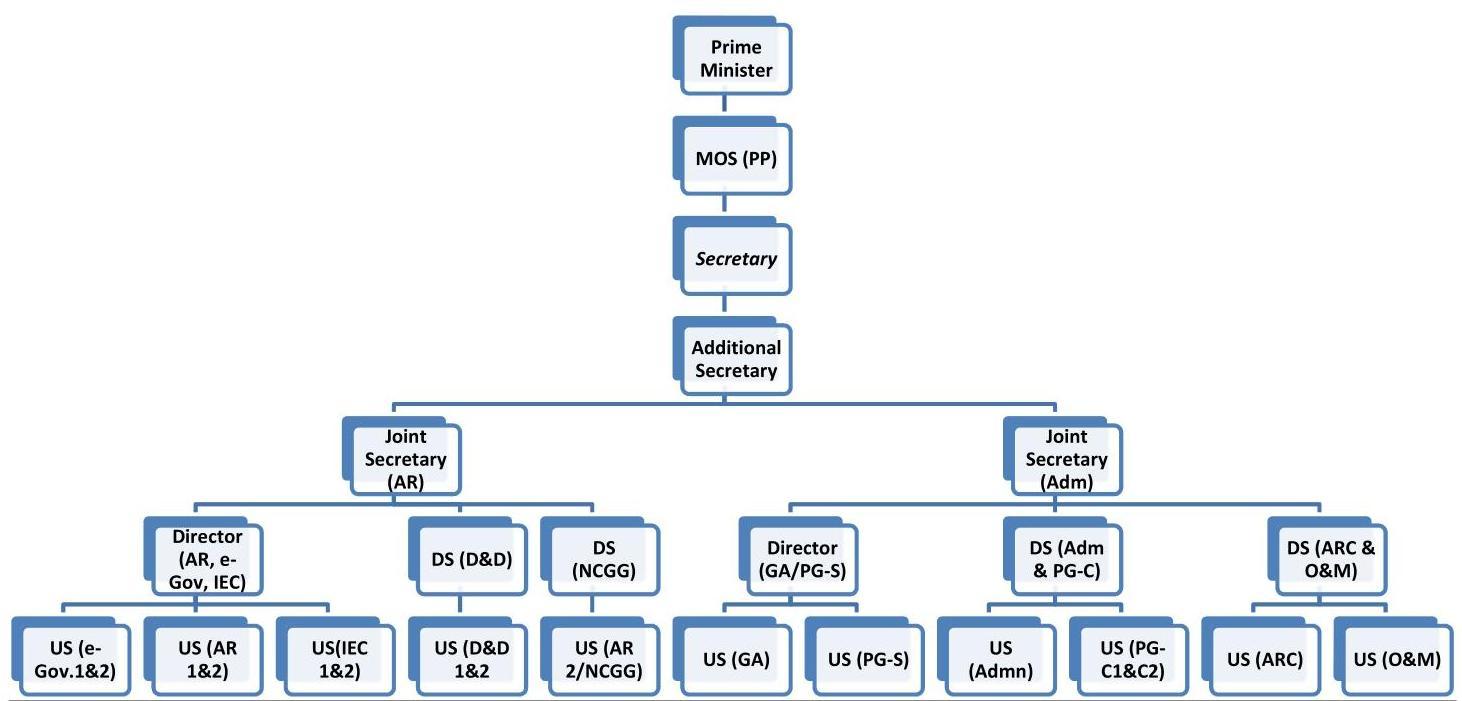
Annexure – IV
Department of Administrative Reforms and Public Grievances
Incumbency Position of Under Secretary and above level Officers in D/o AR&PG as on 31.03.2020
| Post | Name of Incumbent |
|---|---|
| Secretary | Dr Kshatrapati Shivaji |
| Additional Secretary | Shri V. Srinivas |
| Joint Secretary | 1. Ms Jaya Dubey 2. Shri NBS Rajput |
| Director | 1. Shri Narendra Kumar Meena 2. Shri Satish Kerba Jadhav |
| Deputy Secretary | 1. Smt Renu Arora 2. Shri Sandeep Mohan Prasad 3. Smt Prisca Mathew 4. Shri Ajit Kumar Sah 5. Shri Sandesh Saxena |
| Sr. PPS | Shri M P Varadharajan |
| Under Secretary | 1. Shri Dhananjay Kumar 2. Shri Balbir Singh 3. Shri Dharam Pal Arora 4. Shri Jitendra Sihwag 5. Smt Sunila Bagga 6. Smt Sarita Taneja 7. Shri Tirth Ram 8. Shri Sanjeev Shrivastava 9. Shri Khamchin Naulak 10. Shri Gya Prasad 11. Smt Vibhuti Panjiyar 12. Shri Kumar Sanjeet 13. Shri Kamal Kumar Thakur 14. Shri Rakesh Chandra 15. Shri Sunil Kumar Singh |
| PPS | 1. Shri Satish Kumar 2. Shri Sudhir |
Annexure – V
Department of Administrative Reforms and Public Grievances
Prevention of sexual harassment of women at workplace
An Internal Complaint Committee has been constituted in the Department of Administrative Reforms and Public Grievances for prevention of sexual harassment of women at workplace comprising of following members:
(i) Ms Jaya Dubey, Joint Secretary
- Chairperson
(ii) Shri Ajit Kumar Sah, Deputy Secretary - Member
(iii) Ms Vibhuti Panjiyar, Under Secretary - Member
(iv) Dr Sonajharia Minz, representative sponsored by YWCA - Member
Women employees are being made aware of the existence of said Committee from time to time through circulars, display on notice boards and interactions. No complaint of sexual harassment from any of the women employees has been received during the year.
Annexure – VI
Department of Administrative Reforms and Public Grievances
Welfare of SC, ST, OBC and Person with Disability (PWD)
As on 31.03.2020, the incumbency position of SC, ST, OBC and Persons with Disability (PWD) in the Group A, B and C category of officials of Department of Administrative Reforms and Public Grievances is as under:
| Category | Total | SC | ST | OBC | PWD |
|---|---|---|---|---|---|
| Group-A | 29 | 4 | 3 | 4 | – |
| Group-B | 35 | 5 | 2 | 5 | $1(\mathrm{OH})$ $1(\mathrm{HH})$ |
| Group-C | 14 | 5 | – | 2 | $1(\mathrm{OH})$ |
| 78 | 14 | 5 | 11 | 3 |
The Department has appointed a Nodal Officer to look into the complaints/ representations, if any, received from SC, ST and OBC officials and as also to watch their welfare. As per instructions of DoPT, the Department is submitting an annual report regarding SC, ST, OBC and PWD incumbents online through the URL “rrcps.nic.in”. No complaint from SC, ST, OBC and PWD officials is received during the year.
Annexure – VII
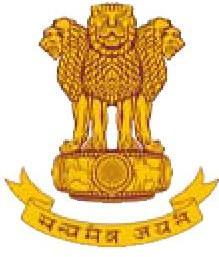
$22^{\text {nd }}$ National e-Governance Conference, 2019 Jointly organised by
Department of
Administrative Reforms
& Public Grievances (DARPG),
Ministry of Personnel, Public
Grievances \& Pensions,
Government of India
Government of
Meghalaya
Ministry of Electronics and Information Technology (MeitY),
Government of India
SHILLONG DECLARATION
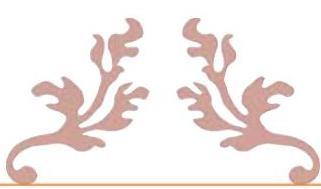
Digital India: Success to Excellence
8-9 August 2019 Shillong, Meghalaya
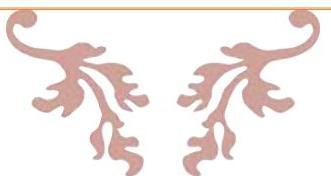
Shillong Declaration
The Department of Administrative Reforms & Public Grievances (DAPRG), Ministry of Personnel, Public Grievances \& Pensions and Ministry of Electronics \& Information Technology (MeitY), Government of India in collaboration with the Government of Meghalaya organized the $22^{\text {nd }}$ National Conference on e-Governance at Shillong during 8-9 August 2019.
The Conference has unanimously adopted the Shillong declaration outlined below after intensive deliberations during the sessions held over two days.
The Conference Resolved that Government of India and State Governments shall collaborate to:
- Improve the citizen’s experience with Government services by promoting the timely implementation of India Enterprise Architecture (IndEA) and implementing a single sign-on for interoperability and integration among e-Government applications throughout the country
- Consolidate the plethora of successful State level e-Governance projects and domain-based projects with a focus to replicate them as a common application software with configurable features
- Ensure improvement in ease of living and ease of doing business by making a big shift in the role of government from Service Provider to Service Enabler, thus moving from development of applications to making available public digital platforms where multiple competitive applications can be developed
- Take steps to further improve connectivity in North Eastern States by addressing the issues and challenges of telecommunications connectivity at the grassroots level and formulate and implement a comprehensive telecom development plan
- Promote the use of e-Office and move towards less paper State Secretariats in the North-Eastern States and the District level offices
- Improve the quality of delivery of e-Services in the North East to fulfil the vision of improved citizen experience
- Develop India as a global cloud hub and facilitate the development of Government applications and databases on Cloud by default
- Adopt emerging technologies for finding e-Governance solutions
- Promote the Digital India Projects with a focus on Smart Cities and Smart Villages with focus on Startups and Smart Entrepreneurship
Annexure – VIII
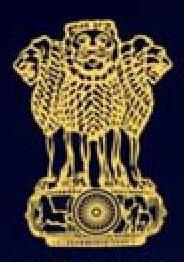
$23^{\text {rd }}$ National e-Governance Conference, 2020
Jointly organised by
Department of Administrative Reforms & Public Grievances (DARPG), Ministry of Personnel, Public Grievances \& Pensions, Government of India
Government of Maharashtra
Ministry of Electronics and Information Technology (MeitY), Government of India
MUMBAI
DECLARATION
– INDIA 2021: DIGITAL TRANSFORMATION
$7^{\text {th }}-8^{\text {th }}$ February, 2020
Mumbai, Maharashtra
Mumbai Declaration
The Department of Administrative Reforms & Public Grievances (DARPG), Ministry of Personnel, Public Grievances \& Pensions and Ministry of Electronics \& Information Technology (MeitY), Government of India in collaboration with the Government of Maharashtra organized the $23^{\text {rd }}$ National Conference on e-Governance on $7^{\text {th }}$ and $8^{\text {th }}$ February 2020 at Mumbai, Maharashtra. The theme of the Conference was “India 2020: Digital Transformation.”
The Mumbai Declaration seeks to take forward the roadmap for e-Governance outlined in the Shillong Declaration adopted during the $22^{\text {nd }}$ National Conference on e-Governance (NCeG) held in August 2019.
Mumbai Declaration seeks to achieve the following objectives:
- Encourage to improve the delivery of public services by promoting the use of digital platforms. The priority sectors identified for Public Digital Platforms are Health, Agriculture, Education and Land. Further, propagate successful e-Governance solutions that use emerging technologies like Blockchain, Quantum Computing, Artificial Intelligence, Machine Learning, Analytics, Deep Learning and Internet of Things.
- Support Departments to benchmark the maturity level of e-Governance projects in States and Union Territories create healthy competition and ultimately, improve India’s rank in the United Nation’s E-Governance Development Index. Encourage States to adopt the recommendations made in National e-Governance Service Delivery Assessment (NeSDA) 2019 and to improve the quality of delivery of services through the annual publication of NeSDA report. Consolidate and connect a plethora of successful State level e-Governance initiatives for service delivery through case studies and knowledge dissemination.
- Support for building trust on digital services by strengthening transparency, security, privacy, protection of personal data and assuring time-bound grievance redressal.
- Facilitate participatory governance and personalized service delivery to common citizens in rural areas by leveraging MyGov, Digital Village and API Based Architecture.
- Support to institutionalize the use of e-Office within Central/State ministries attached offices and departments and move towards paperless governance through Digital Secretariat.
- Promote to develop India into a global cloud hub and facilitate the development of Government applications and databases on cloud and digital public infrastructure.
- Incentivize excellence in e-Governance by recognition of best practices/talents through award/ honour and by constant improvements in the scheme for National e-Governance Awards.
- Encourage to advance skill development and capacity building in e-Governance through skill enhancement training programs for Government officials.
- Foster reforms in the field of public procurementsystem to make it more efficient and transparent by infusing contemporary agile practices, leveraging model RFP and by standardizing the process of execution of contracts with private players.
- Facilitate the adoption of Digital Diplomacy to share the best practices on successful Digital India Products and replicate them in friendly countries.
The Mumbai Declaration is unanimously adopted in the Valedictory Session of the $23^{\text {rd }} \mathrm{NCeG}$ on February 8, 2020, at National Sports Club of India, Mumbai.
Annexure – IX
Department of Pension and Pensioner’s Welfare
ORGANISATIONAL CHART
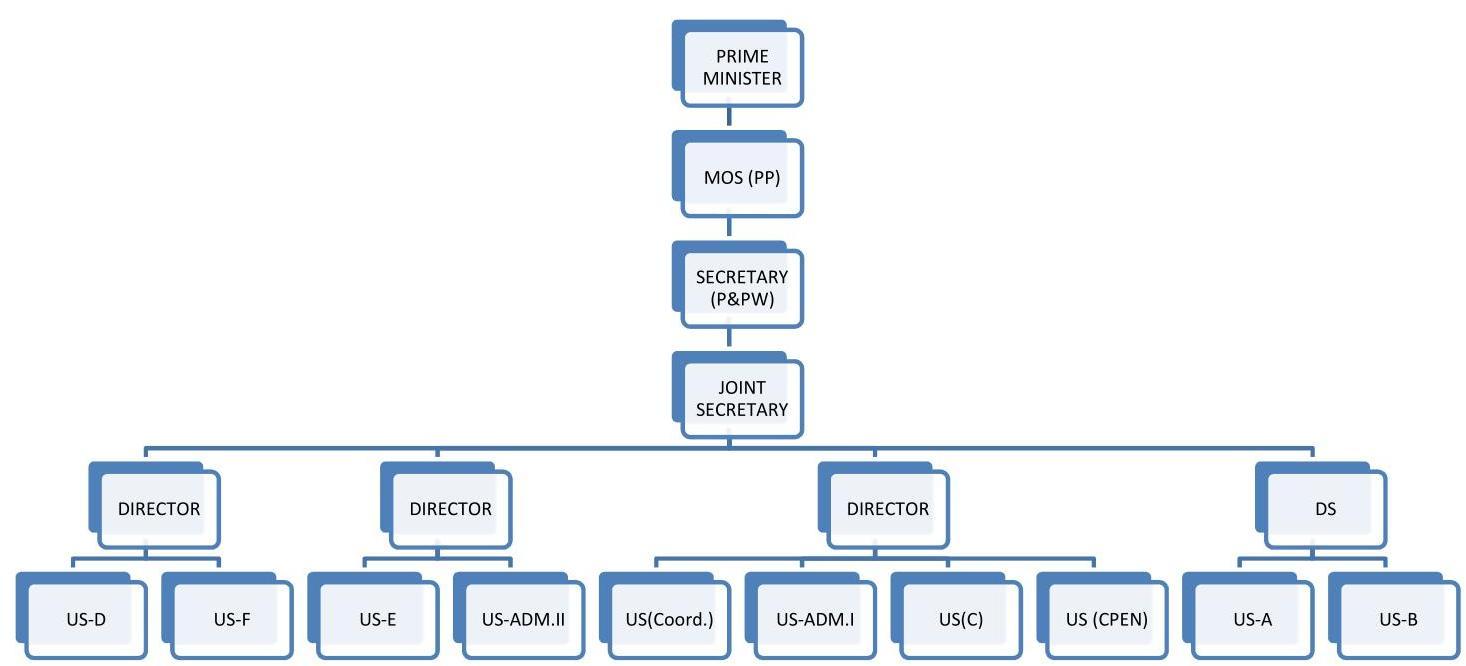
Annexure – X
Incumbency position of Officers in
D/o Pension & Pensioners Welfare as on 31/03/2020
| Post | Name of the incumbent |
|---|---|
| Secretary | Shri Kshatrapati Shivaji |
| Joint Secretary | Shri Sanjiv Narain Mathur |
| Director | Ms Seema Gupta |
| Deputy Secretary | Shri Ruchir Mittal |
| Under Secretary | Shri Sanjoy Shankar Shri Ramesh Chandra Sethi Shri Charanjit Taneja Shri Manoj Kumar Shri S. Chakrabarti Shri Ashok Kumar Singh Shri Rajendra Kumar Dutta Shri Subhash Chander Shri T. C. Varghese Shri Rajesh Kumar |
| Assistant Director (OL) | Ms Manju Gupta |
| Section Officers | Shri D. P. Singh Shri Hemant Shri Deepak Gupta |
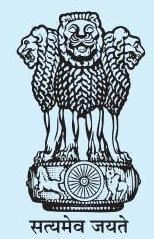
MINISTRY OF PERSONNEL, PUBLIC GRIEVANCES AND PENSIONS
GOVERNMENT OF INDIA
-
- The strength of Deputy Secretary/Director is operated on a combined basis with inter se flexibility. CSS officers empanelled as Joint Secretaries under Central Staffing Scheme are also given in situ promotion as Joint Secretary in SAG grade at their current places of posting till they are placed under the Central Staffing Scheme, with such in-situ promotions restricted to 40 in number. In the combined strength the ceiling for Director Grade is 220. Any unfilled post at Dir/ JS (in-situ) is operated at the level of DS.